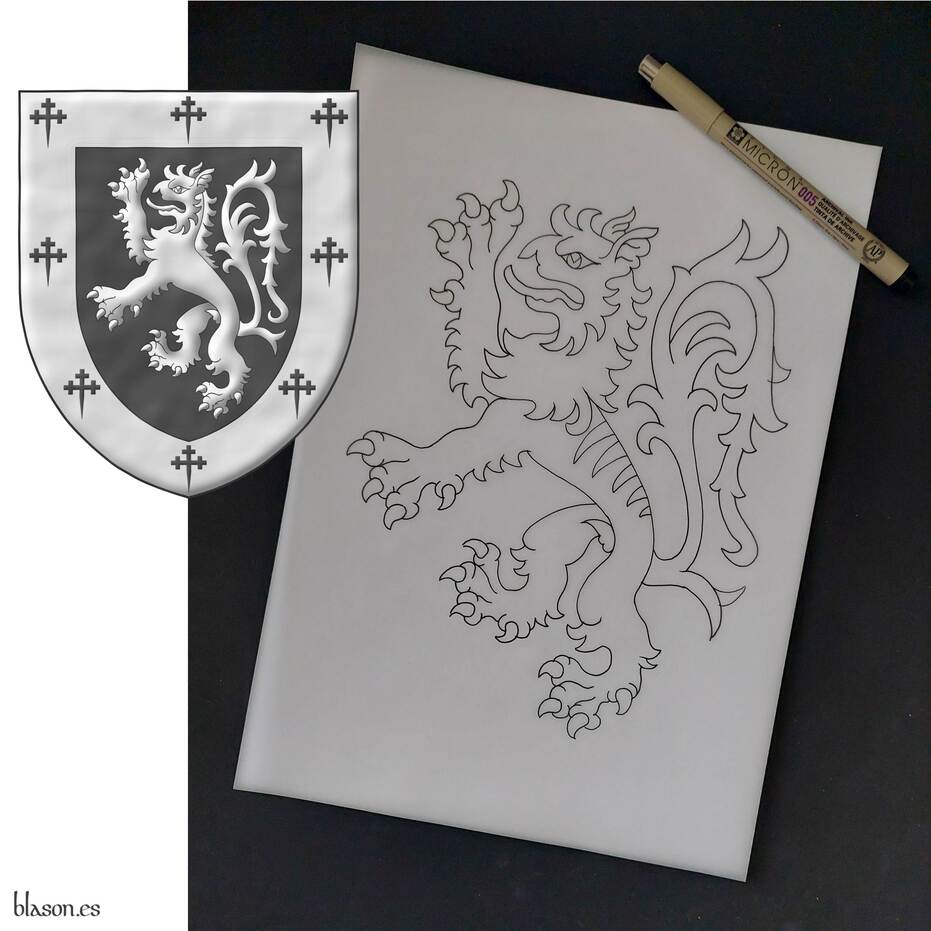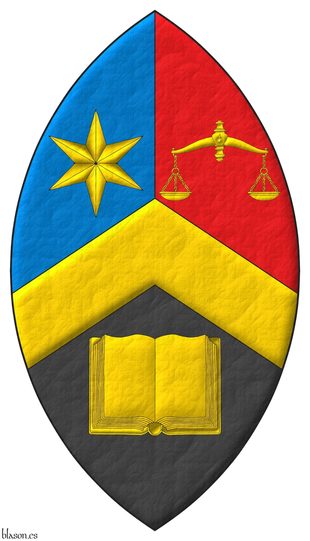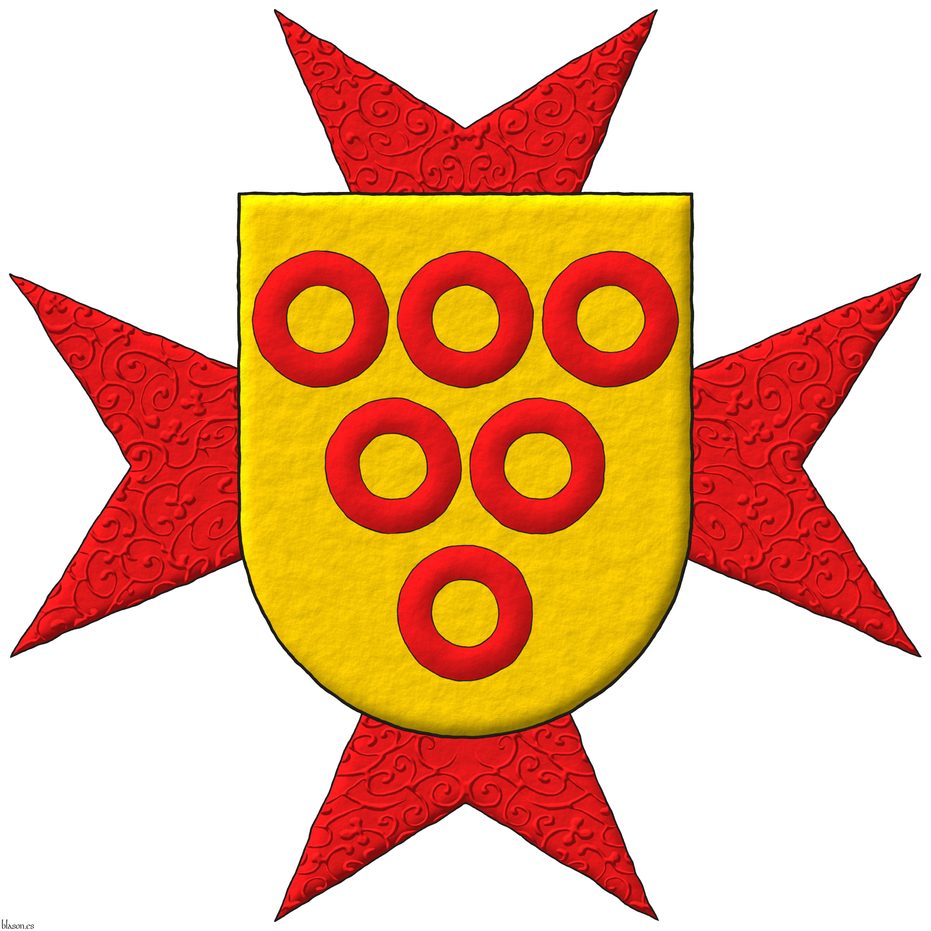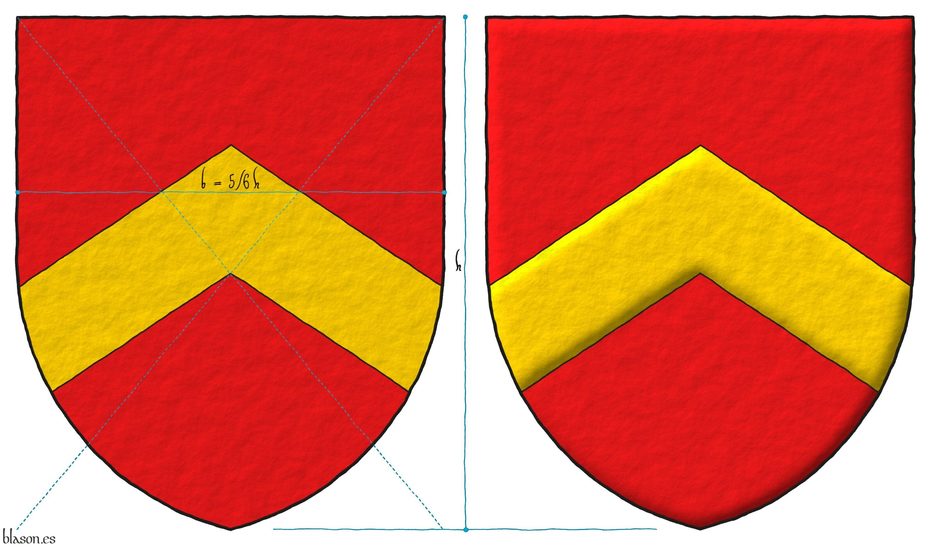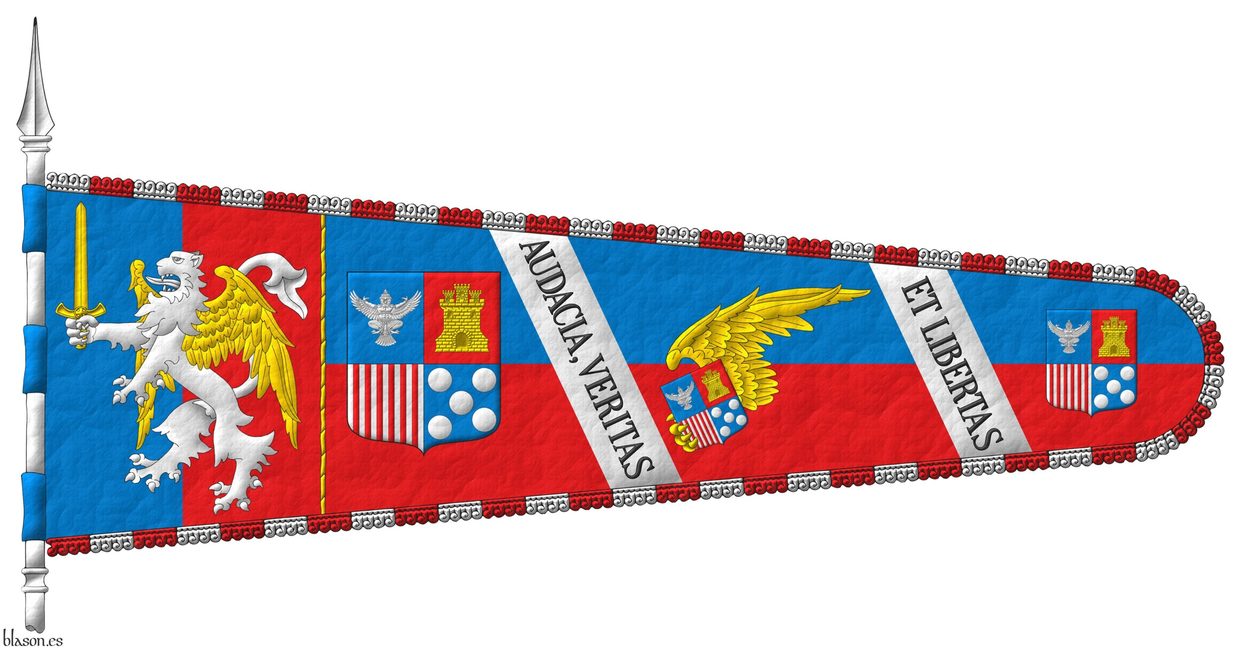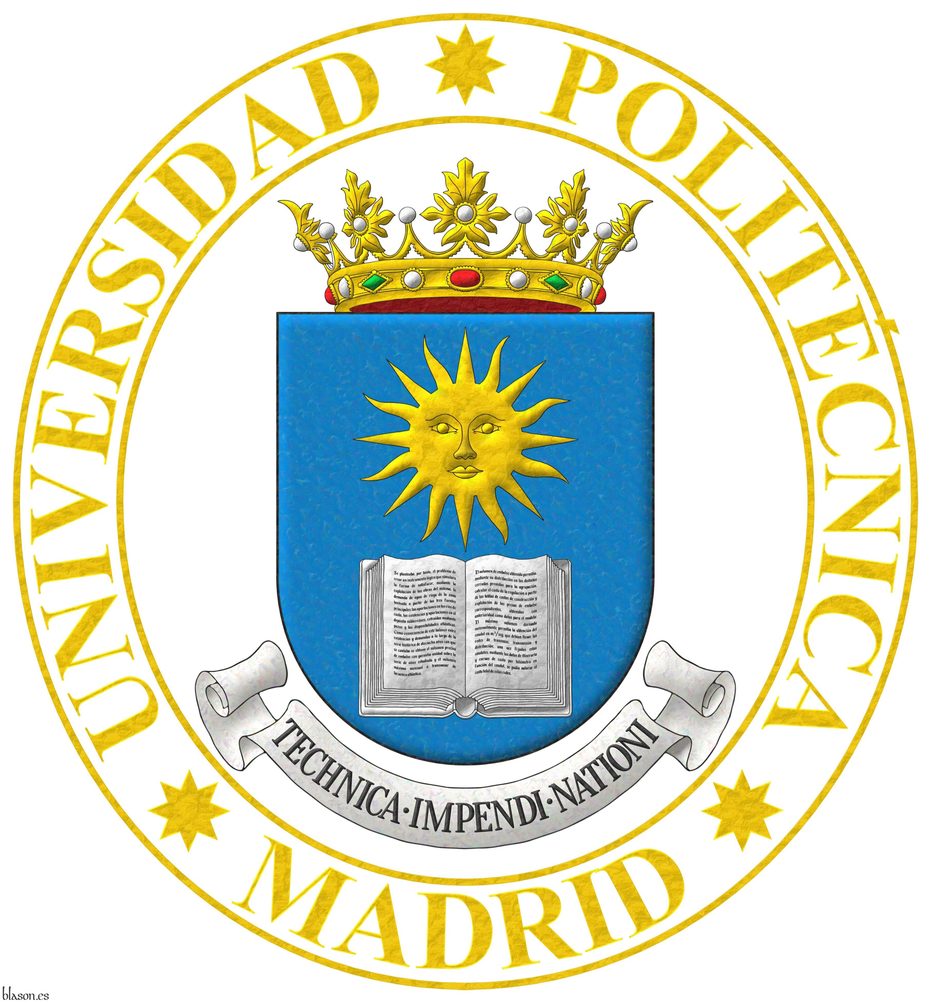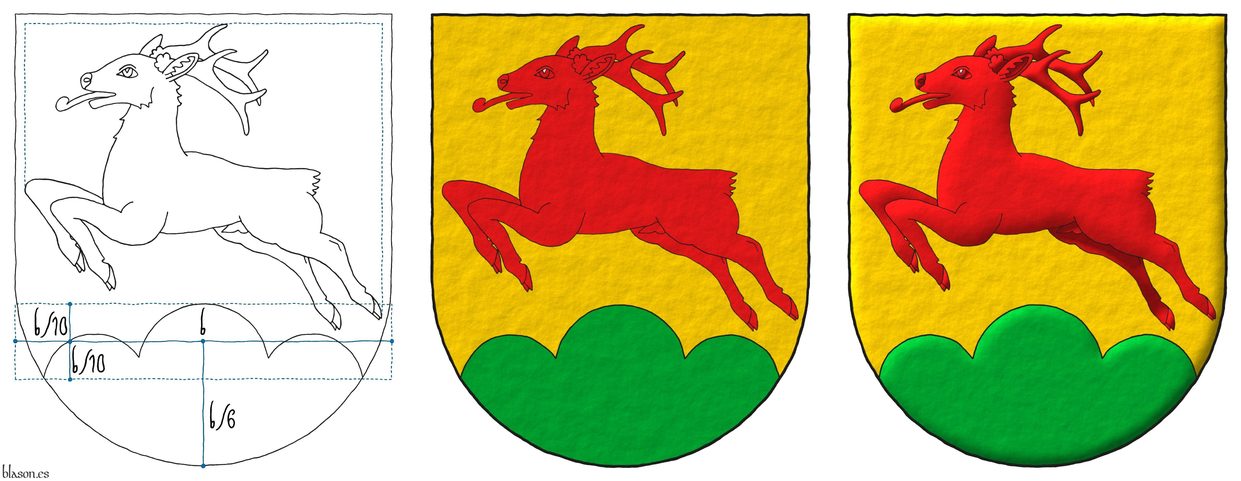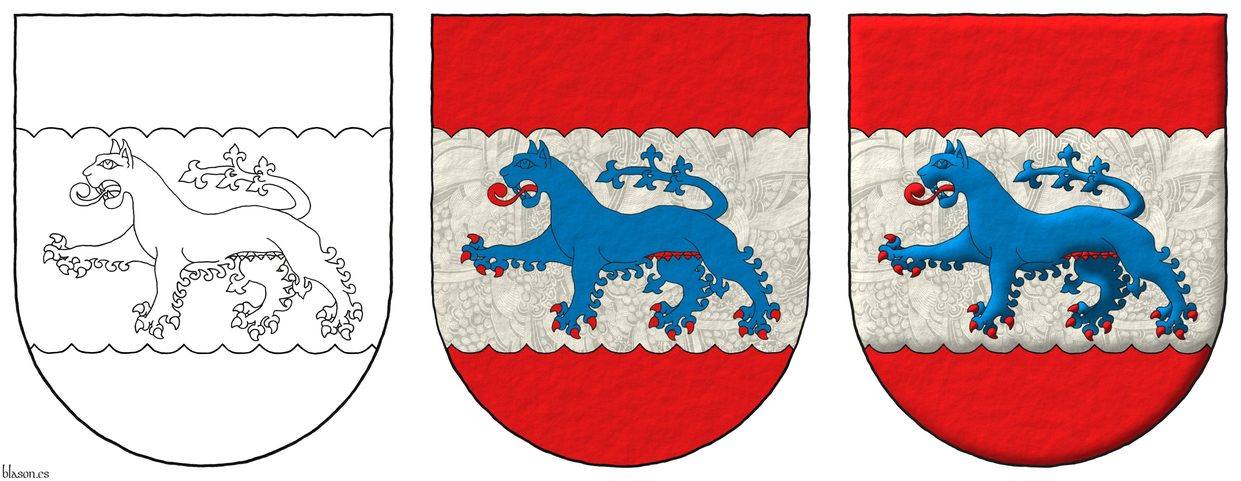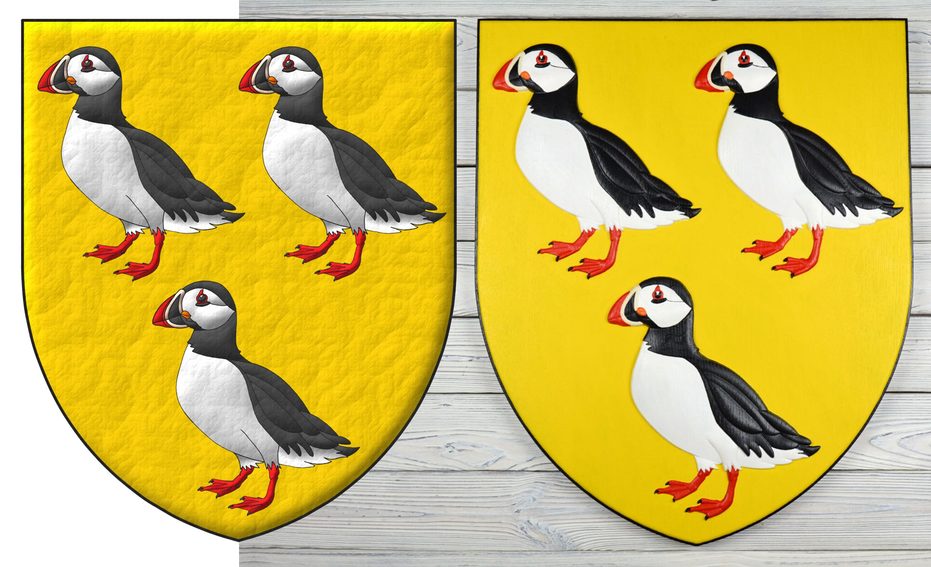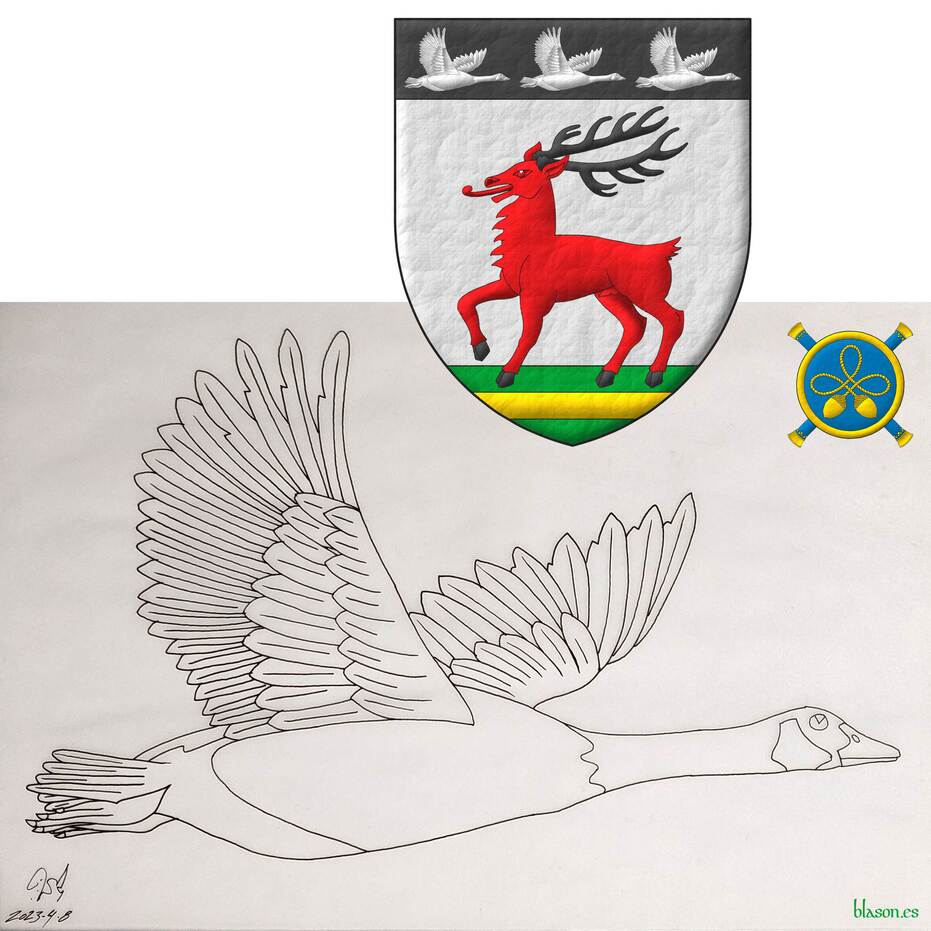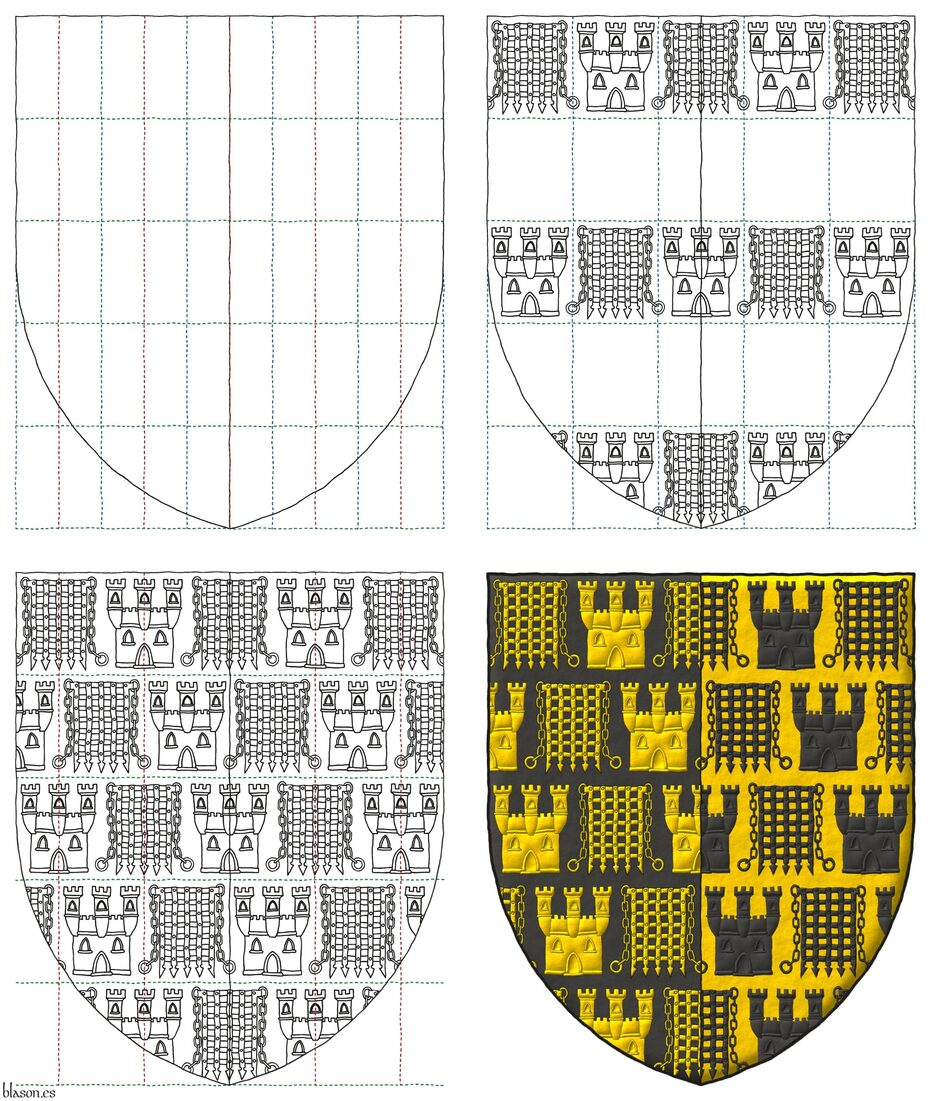Existing blazons interpreted by me


Ackerson - Akers, lineage
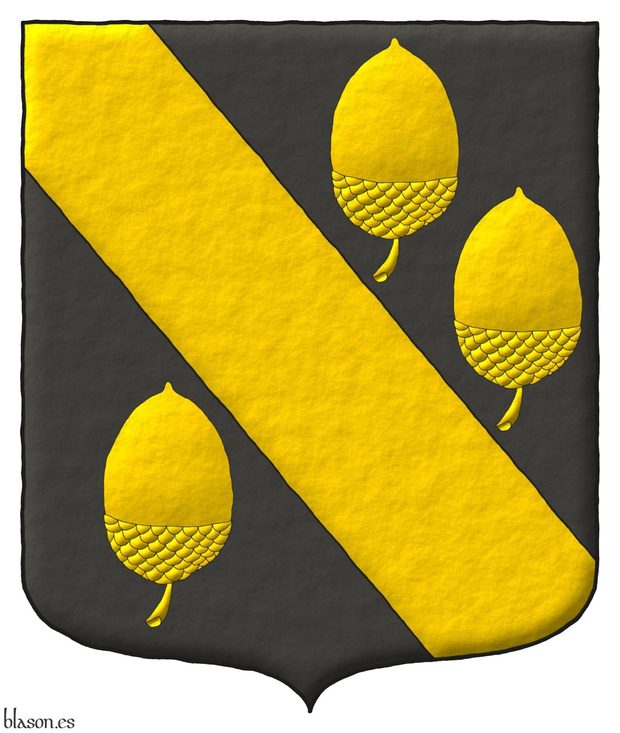
Ackerson and Akers lineages.
Sable, a Bend between three Acorns Or.
Illuminated and freehand finishing.
The coat of arms of Ackerson and Akers lineages emblazoned by me and extracted from [Burke, B.; 1989].
Unless the blazon specifies another layout, when a bend is between three charges, this charges are ordered, two in the chief and one in the base, as the three acorns do in this case.
[Rietstap, J. B.; 1861] escribe el blasón de «Ackers ou Akers» como «de sable, à une bande d'or, acc. de trois glands du mesme».
Blazon keywords: Sable, Bend, Between, Three, Acorn, Or and Ordered.
Style keywords: Freehand, Outlined in sable and Illuminated.
Classification: Interpreted.


Ackhurst, lineage
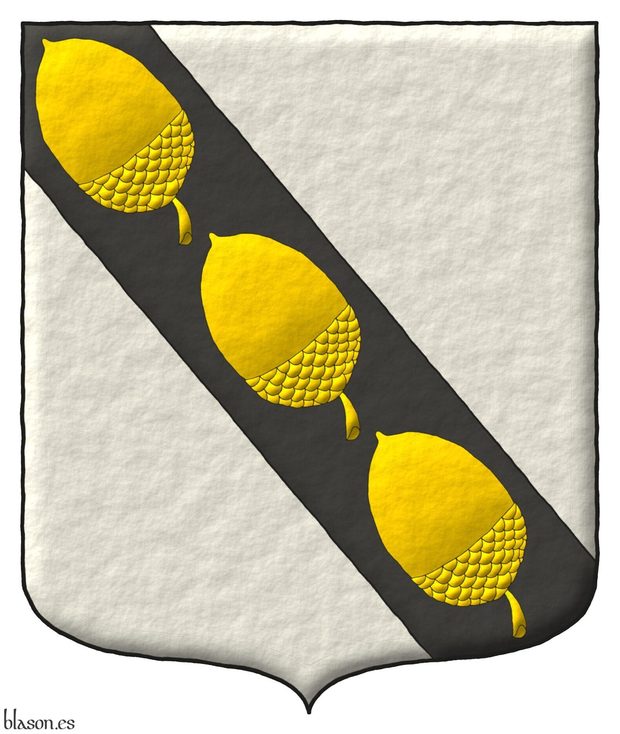
Ackhurst lineage.
Argent, on a Bend Sable three Acorns Or.
Illuminated and freehand finishing.
The coat of arms of Ackhurst lineage emblazoned by me and extracted from [Burke, B.; 1989].
Unless the blazon specifies another direction, the charges in a bend follow the direction of their bend, as the acorns do in this case.
Blazon keywords: Argent, Bend, Sable, Three, Acorn, Or and Bendwise.
Style keywords: Freehand, Outlined in sable and Illuminated.
Classification: Interpreted.


Adam de Cretingges
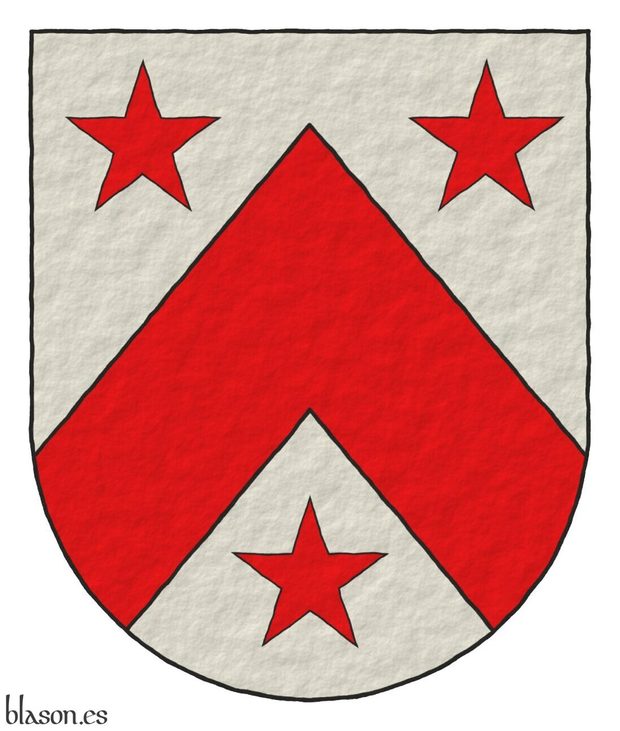
Adam de Creeting ~ Adam de Cretingges.
Argent, a chevron Gules, between three mullets Gules.
Escudo de plata, un cabrio de gules, acompañado de tres estrellas de cinco puntas de gules.
Included in [Vincent, MS; 1285; number 623] also known as [St. George's Roll; 1285; number 623].
The coat of arms of Adan de Creeting is the inverse of the coat of arms of Howel Ap Rhys.
Blazon keywords: Without divisions, Argent, One, Chevron, Gules, Between, Three and Mullet.
Style keywords: Semi-circular, Plain tincture and Outlined in sable.
Classification: Interpreted and Personal.
Bearer: Adan de Creeting.


Adrian V

186th Pope of the Church, only 40 days in 1276. «Hadrianus V», born Ottobuono de Fieschi, was born in Genoa.
Bendy of six Azure and Argent.
Escudo bandado de seis piezas de azur y plata.
Papal coat of arms interpreted by me with: a shield with a rounded arch top; the field in plain tincture of Argent; the bands illuminated in Azure and outlined in Sable; and the whole in an elevated line style.
The blazon in French is «Bandé d'azur et d'argent de six pièces».
The banding is defined in [Avilés, J.; 1725a; page 40] and [Avilés, J.; 1780a; page 45] as the shields and also, the chiefs, fesses, pales, and figures, such as animals, etc., that are «covered and filled with bands in equal number, with as many of metal as of color».
Blazon keywords: Without divisions, Bendy, Six, Azure and Argent.
Style keywords: Semi-circular, Illuminated, Outlined in sable and Freehand.
Classification: Interpreted, Religious and Papal States.
Bearer: Adrian V.


Ajay Gopal Valecha, structured and parallel blazons
Coat of arms of Ajay Gopal Valecha granted by the College of Arms, and emblazoned by me, with the blazon written in English and Castilian in a structured way to observe the parallelism between both forms.
| Quarterly Or and Argent, overall a peacock in his splendour proper. | Escudo cuartelado de oro y plata, sobre el todo un pavo real ruante al natural. |
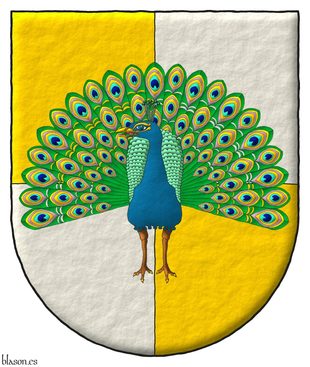 |
Blazon keywords: Argent, Or, One, Quarterly, Overall, Peacock, In his splendour and Proper.
Style keywords: Outlined in sable, Illuminated, Semi-circular and Freehand.
Classification: Personal, Interpreted, Structured and parallel blazons, Boa and Coat of arms.
Bearer: Valecha, Ajay Gopal.


Alarcon of Cantabria, lineage

Gules, a cross flory voided Or; within a bordure Gules with eight saltires couped Or.
Escudo de gules, una cruz hueca flordelisada de oro; bordura de gules, ocho sotueres de oro.
Coat of arms painted by me, highlighted with lights and shadows, outlined in Sable, with a semi-circular external shape and with a freehand finishing.
Ancient arms of Alarcon of Cantabria emblazoned by me.
Blazon keywords: Argent, Sable, Or, Gules, Three, Cross, Flory, Voided, Bordure, Saltire and Couped.
Style keywords: Outlined in sable, Illuminated, Semi-circular and Freehand.
Classification: Personal, Interpreted, Boa and Coat of arms.
Bearer: Alarcon of Cantabria, lineage.


Albero, lineage of Aragon

Blazon of the Albero lineage of Aragon.
Vair ancient.
Escudo de veros antiguos.
Illuminated and with a glass finish.
It can be consulted in [Cadenas y Vicent, V. de; 1987; page 62].
[Friar, S.; 1987; pages 157-158] says of the veros: «originates from the fur of a species of squirrel... which was popular in the Middle Ages as a lining for the garments of those not entitled to wear ermine. The animal was blue-grey on the back and white underneath. By sewing a number of these pelts together, with white and blue-grey alternating,... one which easily translated into the stylized armorial form of Vair and its variants».
Blazon keywords: Vair ancient.
Style keywords: Freehand, Outlined in sable, Illuminated and Semi-circular.
Classification: Interpreted, Lineage and Coat of arms.


Albrecht Dürer

Gules, on a trimount issuant from the base Or, a port Gules, with canopy roof, jambs, enarched lintel, and two open leaves, upon a three-step stairway Oro.
Escudo de gules, un monte de tres peñas moviente de la punta sumado de una puerta con tejadillo, jambas, dintel arqueado, dos hojas abiertas sostenida de una escalinata de tres peldaños todo de oro, aclarada de gules.
Coat of arms painted by me, illuminated with lights and shadows, outlined in Sable, with an ogee external shape and with a freehand finish.
Coat of arms of Albrecht Dürer, 1471-1528, emblazoned by me based on the woodcut titled «Coat of Arms of Albrecht Dürer» made by Albrecht Dürer himself in 1523 on a sheet measuring 35.1 × 26.1 cm belonging to The Elisha Whittelsey Collection, The Elisha Whittelsey Fund, 1952, held at the Metropolitan Museum of New York, and on the work titled «Marriage Coat of Arms of the Families Duerer and Holper. Verso of the Albrecht Dürer the Elder portrait», dated 1490; Albrecht Dürer the Elder, 1427–1502, was his father.
Design rationale
The Dürer family coat of arms is an example of canting arms. Their family origin traces back to Ajtós, Hungary, a name which means «door» or «doorman» in Hungarian. Upon settling in Nuremberg, the family Germanized their surname to «Türer», derived from «Tür», meaning «door», and later to Dürer. This is the reason of the main charge of these arms.
Blazon keywords: Gules, One, Two, Three, On, Trimount, Issuant from base, Port, Canopy roof, Arched, Enarched, Upon, Step, Stairway and Port and windows.
Style keywords: Outlined in sable, Illuminated, Ogee and Freehand.
Classification: Personal, Lineage, Interpreted, Boa and Coat of arms.
Bearer: Albrecht Dürer.


Aldam, lineage of England
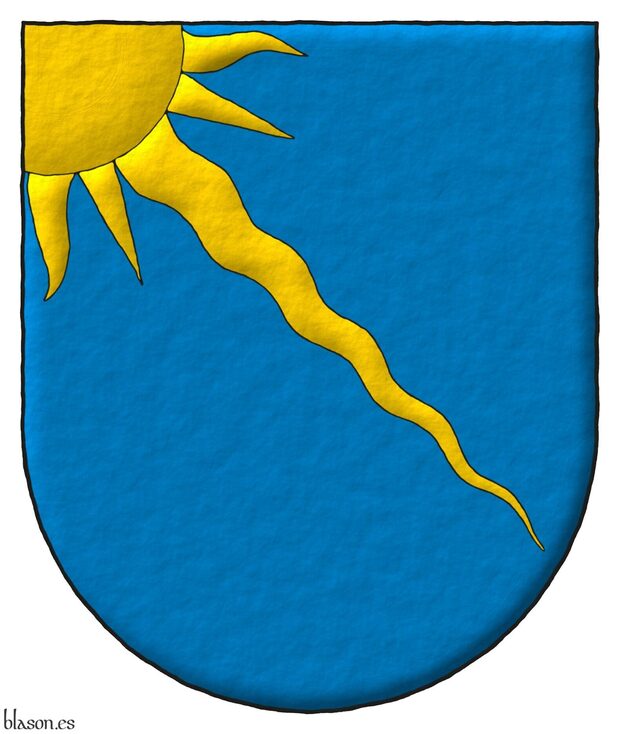
Blazon of the Aldam lineage of England.
Azure, a ray of the sun bendwise, issuant from the dexter chief Or.
Escudo de azur, un rayo de sol puesto en banda, naciente de la diestra del jefe de oro.
Illuminated with lights and shadows and with a freehand finish.
Described in [Burke, B.; 1989; page 9, column 1, entry 11].
Blazon keywords: Without divisions, Azure, One, Ray of the sun, Bendwise, Nascent, Dexter, Chief and Or.
Style keywords: Freehand, Outlined in sable, Illuminated and Semi-circular.
Classification: Interpreted, Lineage and Kingdom of England.


Alfonso IX of Leon, open royal crown
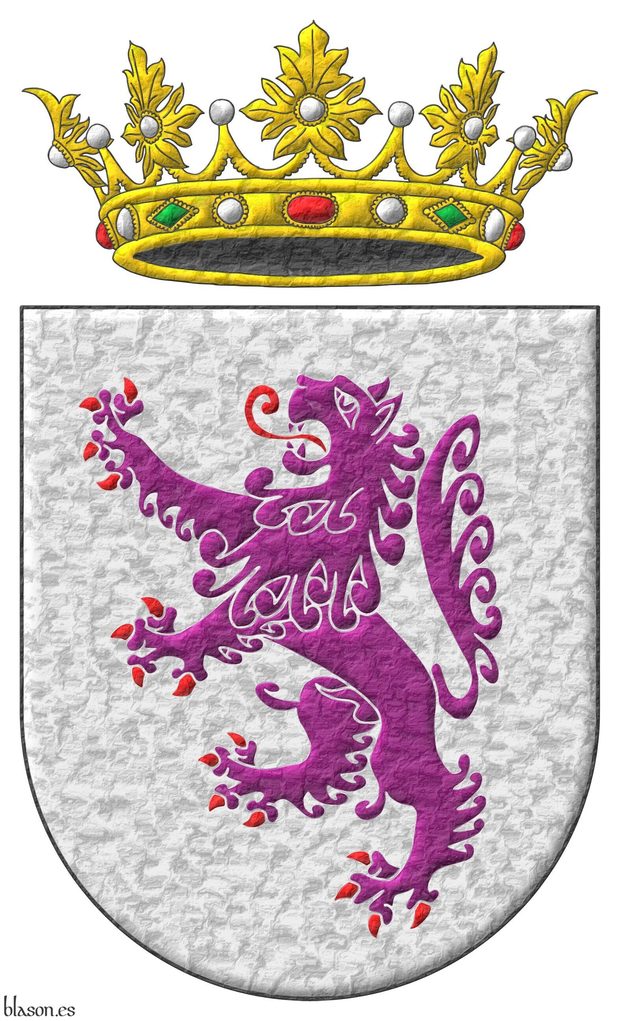
King of León from January 21, 1188, until his death on September 24, 1230.
Argent, a lion rampant Purpure, armed and langued Gules. Crest: An open royal crown Or.
Escudo de plata, un león rampante de púrpura, armado y lampasado de gules. Timbrado de una corona real abierta.
Arms of the King interpreted as follows: the escutcheon is finished in a semi-circular arch; both the field, the lion, and the crown of the crest have been illuminated; and the ensemble has a hammered metal finish.
Purple lion of the Kingdom of León
In the following image, I show a miniature from the Tumbo A of the Cathedral of Santiago de Compostela, from the 13th century, with the heading reading «Inclitus:Adeffonsus:Rex:Legionensium:et Gallecie:», combined with my interpretation of his coat of arms. The lion of the Kingdom of León can be found depicted in both purple and gules, but images like this confirm that it is purple, and I particularly favor the purple, as it makes it historically unique.
Blazon keywords: Without divisions, Argent, Purpure, Gules, One, Lion, Rampant, Armed, Langued, Crest, Open royal crown and Crown.
Style keywords: Semi-circular, Illuminated and Metal beaten.
Classification: Interpreted, Personal, Coat of arms and Kingdom of León.
Bearer: Alfonso IX of Leon.


Alfonso Sánchez de Perella, collage
Azure, a cross flory voided Argent; a bordure Gules charged with sixteen saltires couped Or.
Coat of arms emblazoned by me, highlighted with lights and shadows, contoured in Sable, with a semi-circular external shape and with a texturized finishing.
Alfonso Sánchez de Perella, first mayor of Burgos emblazoned by me. He appears as the [Cofradía de Santiago; Century XIV; 4th knight, 1st of the page 21 V], from this 14th century Book of the Brotherhood of Knights of Santiago de la Fuente. This was a brotherhood founded by the Burgos citizens at the time of King Alfonso XI of Castilla, 1311-1350. In the book, there are 14 saltires instead of 16, as it appears that one is missing on the sinister side of the base, and there are 4 in the chief instead of 5.
Blazon keywords: Azure, Argent, Gules, Or, One, Sixteen, Cross, Flory, Voided, Bordure, Saltire and Couped.
Style keywords: Outlined in sable, Illuminated and Semi-circular.
Classification: Personal, Interpreted, Boa and Coat of arms.
Bearer: Sánchez de Perella, Alfonso.


Alfonso VIII of Castile
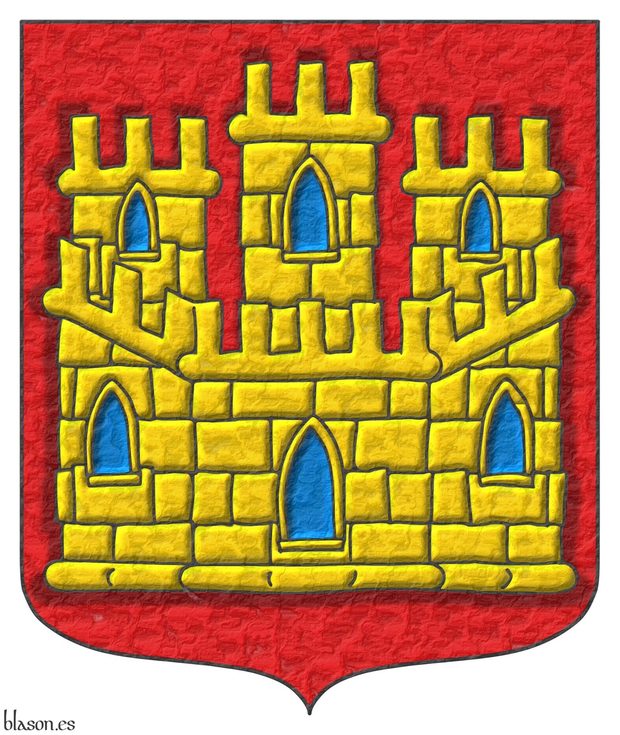
Born on November 11, 1155, in Soria and died on October 6, 1214, in Gutierre-Muñoz, Avila.
Gules, a castle triple towered Or, port and windows Azure, masoned Sable.
Escudo de gules, un castillo de oro, aclarado de azur, mazonado de sable.
Existing arms interpreted by me as follows: the shield’s shape is pointed and rounded; the field has been enameled Gules; the castle is outlined, illuminated, and shaded; the whole composition features a heavily hammered metal finish.
This ancient coat of arms of Castile can be consulted, among other sources, in [Argote de Molina, G.; 1588; chapter XLII].
Blazon keywords: Without divisions, Gules, Or, Azure, Sable, One, Castle, Port and windows and Masoned.
Style keywords: Ogee, Illuminated, Shaded, Outlined in sable and Hard metal.
Classification: Interpreted, Personal, Coat of arms and Kingdom of Castile.
Bearer: Alfonso VIII of Castile.


Almeria, city of
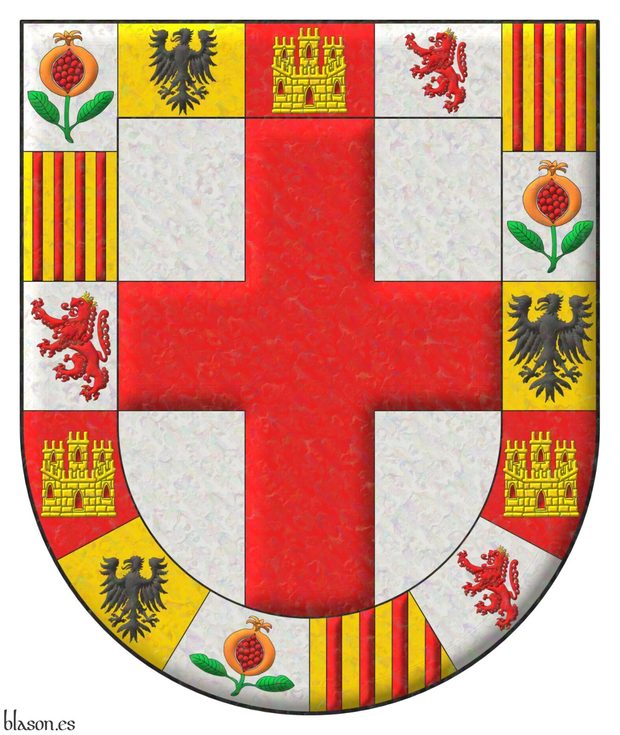
Argent, a cross Gules; a bordure compony of fifteen sections: 1, 6, and 11 Argent, a pomegranate seeded, slipped and leaved proper; 2, 7, and 12 Or, an eagle displayed Sable; 3, 8, and 13 Gules, a castle triple-towered Or, port and windows Gules, masoned Sable; 4, 9, and 14 Argent, a lion rampant Gules, crowned Or; 5, 10, and 15 Or, four pallets Gules.
Escudo de plata, una cruz de gules; una bordura componada de quince compones: 1o, 6o y 11o de plata, una granada al natural, tajada de gules, tallada y hojada de sinople; 2o, 7o y 12o de oro, un águila de sable; 3o, 8o y 13o de gules, un castillo de oro, aclarado de gules, mazonado de sable; 4o, 9o y 14o de plata, un león rampante de gules, coronado de oro; 5o, 10o y 15o de oro, cuatro palos de gules.
Coat of arms depicted by me, illuminated with lights and shadows, contoured in Sable, with a semi-circular outer contour and with a iridescent finishing.
Coat of arms of the city of Almeria, Andalusia, emblazoned by me. In 1147, during the Reconquista, the city of Almería was captured by the forces of King Alfonso VII of León, known as «the Emperor», as part of a broader crusading effort declared by Pope Eugene III. The conquest came in response to the Almohad invasion of 1146, which had begun with a landing in Algeciras and quickly seized key territories in the south of the Iberian Peninsula. In reaction, Alfonso VII negotiated an alliance with the Almoravid leader Ibn Ganiya to organize a resistance. He met with Ramon Berenguer IV, Count of Barcelona, and García Ramírez of Navarre, and together they planned the assault on Almería, which at the time was under Almoravid control. Crucial to the success of the operation was the support of the powerful Genoese navy, as well as French crusaders who had responded to the papal call. Subsequently, in recognition of Genoa’s decisive role in the campaign, Almería adopted as the central element of its coat of arms the Genoese emblem: «Argent, a cross Gules».
Blazon keywords: Argent, Gules, Or, Sable, Vert, One, Four, Fifteen, Cross, Bordure, Compony, Pomegranate, Slipped, Leaved, Proper, Eagle, Castle, Triple-towered, Port and windows, Masoned, Lion, Rampant, Crowned and Pallet.
Style keywords: Outlined in sable, Illuminated, Semi-circular and Iridescent.
Classification: Civic, Interpreted, Boa and Coat of arms.
Bearer: Almeria, city of.


Almorrabides of Navarre
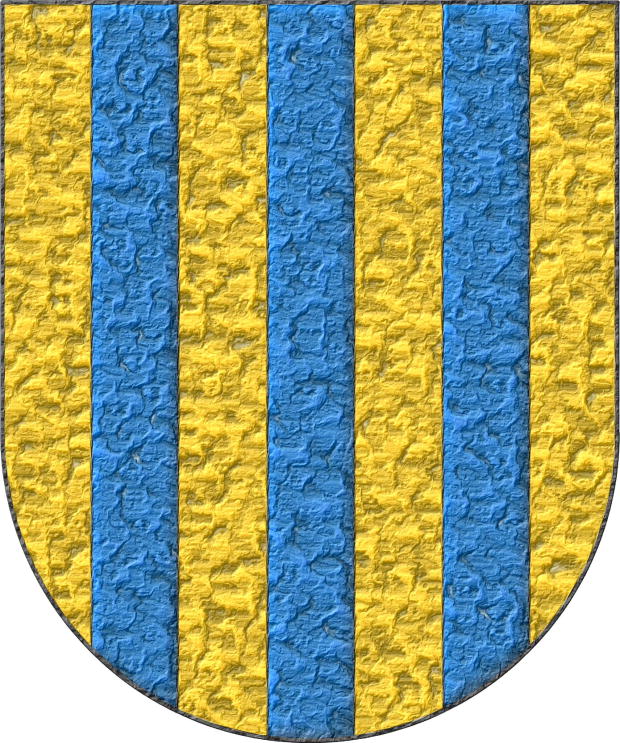
Of the twelve lineages of Noblemen, it is the first, and they bear as arms, on a golden field, three pales Azure.
Or, three Pallets Azure.
Escudo de oro, tres palos de azur.
Coat of arms interpreted with: a semicircular (round) base; the field in flat Or; the pales outlined in Sable and illuminated in Azure enamel; and finished in highly-hammered metal.
Based on the first coat of arms of the «ricoshombres» of Navarre in [Bosque, J. del; 1540; folio 1 of the numbering of 1613] and the text is from the transcription made in [Martinena Ruiz, J. J.; 1982; pages 122 and 123].
Under the title «Los Almorauides» it can also be consulted in [Vega, P. J. de; 1702; folio 1 of the manuscript].
Blazon keywords: Without divisions, Or, Three, Pale and Azure.
Style keywords: Semi-circular, Illuminated, Outlined in sable and Hard metal.
Classification: Interpreted, Personal and Kingdom of Navarre.
Bearer: Almorrabides of Navarre.

Alphonse X of Castile
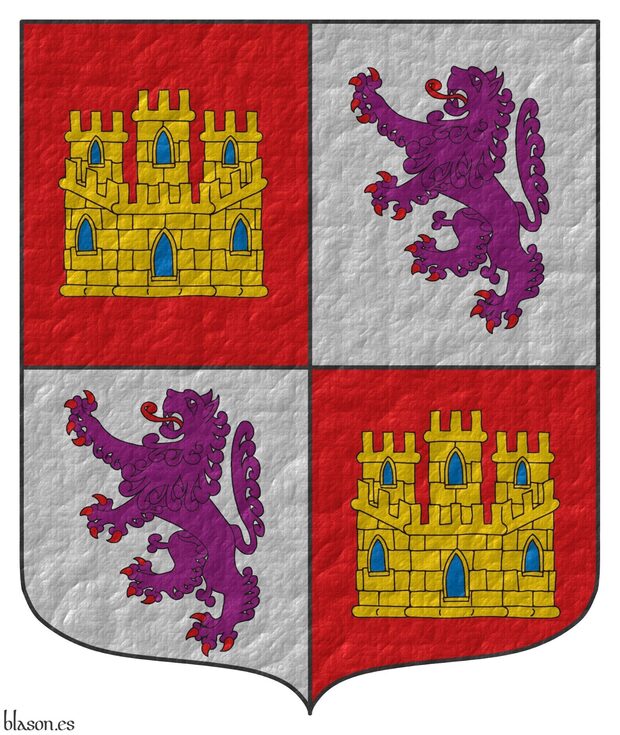
Known as the Wise, King of Castile and Leon from 1252 to 1284.
Escudo cuartelado: 1o y 4o de gules, un castillo de oro, aclarado de azur, mazonado de sable; 2o y 3o de plata, un león rampante de púrpura, armado y lampasado de gules.
Quarterly: 1 and 4 Gules, a castle triple towered Or, port and windows Azure, masoned Sable; 2 and 3 Argent, a lion rampant Purpure, armed and langued Gules.
Armories of the Wise King of Castile interpreted by me with the following characteristics: the external shape of the coat of arms ends in an ogee arch; the field, the 2 castles, and the 2 lions are outlined and enameled in flat colors; and the texture seems fabric.
This coat of arms, but with a pointed external shape, can be seen in the 2nd part of the so-called armorial [Wijnbergen; 1265; cuat of arms number 1,289], with the title «Le roy Despaingne», which in this context is understood to refer to Castilla y León.
The 2nd part of this armorial was made between 1270 and 1285 and, being Alphonse X king of Castile and Leon from 1252 to 1284, it is to Him that the title «Le roy Despaingne» seems to refer.
Blazon keywords: Quarterly, Gules, Or, Azure, Sable, One, Castle, Port and windows, Masoned, Argent, Purpure, Lion, Rampant, Armed and Langued.
Style keywords: Ogee, Plain tincture, Outlined in sable and Fabric.
Classification: Interpreted, Personal, Coat of arms and Kingdom of Castile and Leon.
Bearer: Alphonse X of Castile.


Alton Thompson, schema 2x3
Argent, a double tressure flory Sanguine, overall a raven (Corvus corax) volant saltirewise proper.
These are the arms of Alton Thompson of the family Josserand de Bourgogne emblazoned by me in 6 steps: 1, 2) structure and delineation of the double tressure, 3, 4) structure and delineation of the Corvus corax trian volant, 5) plain tincture, and 6) lights and shadows.
Blazon keywords: Argent, Gules, Sable, One, Double tressure, Flory, Overall, Raven, Volant, Saltirewise and Proper.
Style keywords: Ratio, Outlined, Outlined in sable, Plain tincture, Illuminated and Pointed.
Classification: Personal, Interpreted, Schema, Boa and Coat of arms.
Bearer: Thompson, Alton.


Álvaro de Zúñiga y Guzmán

Lord of Zúñiga and Mendavia and of Béjar and Bañares and of Gibraleón, 1st Duke of Arévalo, 1st Duke of Plasencia, 1st Count of Bañares, 1st Duke of Béjar, 2nd Count of Plasencia, and Grandee of Castile.
Argent, a bend Sable; overall a chain orlewise Or.
Escudo de plata, una banda de sable; brochante sobre el todo una cadena puesta en orla de oro.
Personal coat of arms interpreted by me as follows: the shield has a semicircular (round) base; both the field and the bend have been illuminated in flat tinctures Argent and Sable; the links of the chain are enameled and illuminated in Or; and the whole is made of beaten metal.
In [Argote de Molina, G.; 1588; page 94 according to the numbering of the book, or page 93 according to the numbering accompanying the illustrations] this coat of arms appears under the title «Zúñigas» with the overlying chain formed only by 8 long links.
In [Anonymous; 1800a; page 46] the blazon of «the Zúñigas» is described, where in this book, curiously, the letter Z is ordered after C and before D.
Blazon keywords: Without divisions, Argent, Sable, Or, One, Bend, Chain, Orlewise and Overall.
Style keywords: Semi-circular, Illuminated and Metal beaten.
Classification: Interpreted, Personal and Coat of arms.
Bearer: Zúñiga y Guzmán, Álvaro de.


Amancier, lineage of Genevois
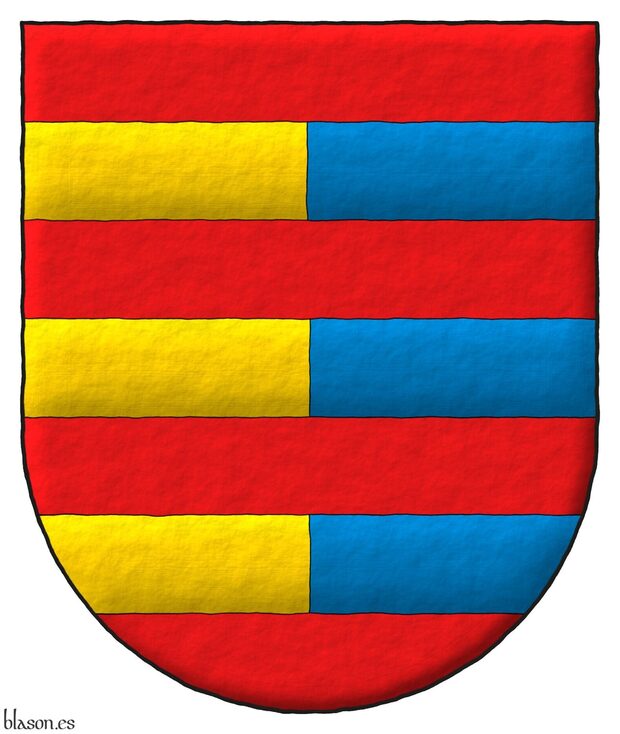
Blazon of the Amancier lineage of Genevois, Haute-Savoie, France.
Gules, three bars per pale Or and Azure.
Illuminated and a freehand finishing.
Its French blazon «de gueules, à trois fasces parties d'or et d'azur» can be found at [Rietstap, J. B.; 1861; page 40].
Any fess party per pale of metal and color or color and metal will always have a metal on metal or color on color conflict whether the field of the coat of arms is color or metal. There isn't conflict if the field of the coat of arms is also party per pale with metal under the color of the fess and with color under the metal of the fess or if the field is fur.
Blazon keywords: Without divisions, Gules, Three, Fess, Party per pale, Or and Azure.
Style keywords: Freehand, Outlined in sable, Illuminated and Semi-circular.
Classification: Interpreted, Lineage and Kingdom of France.


Amitay Edward von Stiebel, plain tincture
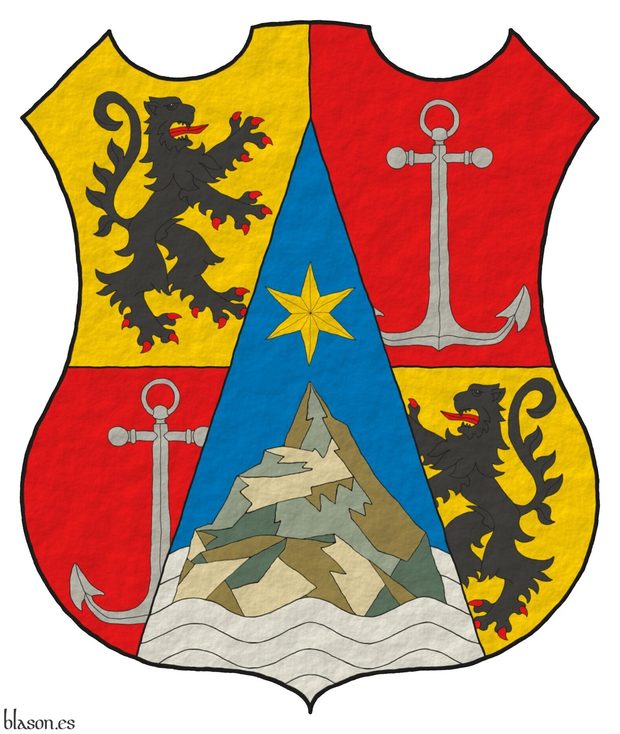
Quarterly: 1 Or, a lion rampant, facing sinister Sable, armed and langued Gules; 2 and 3 Gules, an anchor proper; 4 Or, a lion rampant Sable, armed and langued Gules; overall, a pile issuant from base Azure charged with a mount proper issuant from water issuant from base Argent, in chief, a mullet of six points Or.
Arms emblazoned by me, in flat tinctures, contoured in Sable, and with a texturized finishing.
Coat of arms of Amitay Edward von Stiebel emblazoned by me.
Blazon keywords: Or, Sable, Gules, Azure, Argent, One, Six, Quarterly, Lion, Rampant, Facing sinister, Armed, Langued, Anchor, Proper, Overall, Pile issuant from base, Charged, Mount, Issuant, Water, Issuant from base, In chief and Mullet.
Style keywords: Outlined in sable, Plain tincture and Bull's hide.
Classification: Personal, Interpreted, Boa and Coat of arms.
Bearer: Stiebel, Amitay Edward von.


Anderson of Erbury

Argent, a chevron between three crosses flory Sable.
Escudo de plata, un cabrio acompañado de tres cruces flordelisadas todo de sable.
Illuminated with lights and shadows and with a freehand finish.
The coat of arms of Anderson of Erbury emblazoned by me in 4 ways: 1) tricking using abbreviations, 2) hatching using lines, 3) plain tinctures, and 4) lights and shados. It is a preliminary artwork for the arms of Nick Allen Rica II.
Blazon keywords: Without divisions, Argent, One, Chevron, Between, Three, Cross flory, Cross couped and Sable.
Style keywords: Freehand, Outlined in sable, Illuminated, Pointed, Tricking, Hatching and Plain tincture.
Classification: Interpreted, Kingdom of Scotland and Schema.
Bearer: Anderson of Erbury.


André, lineage of France
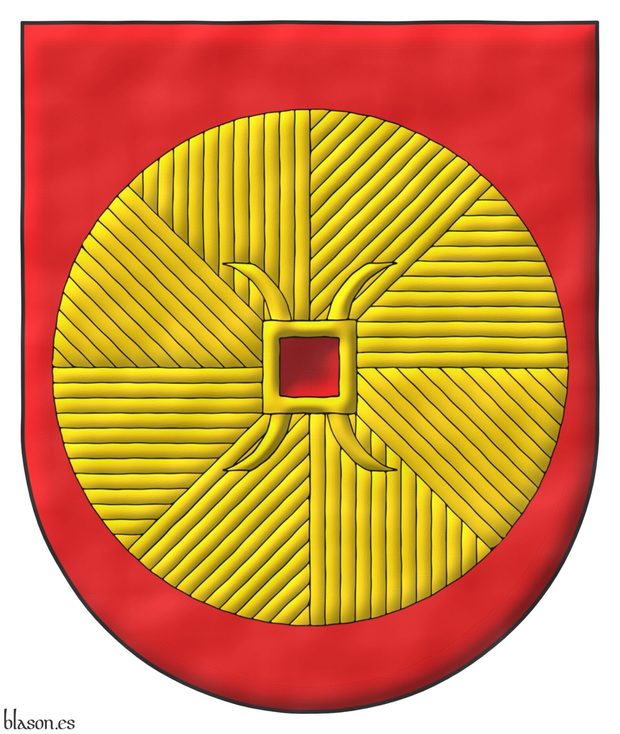
Blazon of the André lineage of France.
Gules, a millstone Or.
Escudo de gules, una piedra de molino de oro.
Illuminated and a watercolor finishing with shadow in the hole.
For its better identification, I have painted the millstone with the ring that fixes it to its axis. This ring is called a millrind, it is made of iron, and usually has 4 arms to better fix the millstone. Millrinds may appear on coats of arms independently of millstones. Another heraldic element related to the previous ones is the millwheel, which is a toothed gear that is part of the mill mechanism but should not be confused with the millstone that grinds the grain.
Blazon keywords: Without divisions, Gules, One, Millstone and Or.
Style keywords: Watercolor, Outlined in sable, Illuminated and Semi-circular.
Classification: Interpreted, Lineage and Kingdom of France.


Andrew Ronald McMillan Bell of Auchinreoch with supporters
Gules, a cross Argent charged with four ermine spots in cross Sable, in the dexter of the chief a lion’s head erased Or. Crest: Upon a helm befitting his degree issuant from a crown of Baron above the shield, with a chapeau Gules turned up ermine, a demi-lion, double queued Or, grasping in its dexter paw a pennon Gules, bearing a canton Azure, charged with a saltire Argent. Mantling: Gules doubled Argent. War cry above the crest: «ΑΛΑΛΑ ΑΛΑΛΑ». Motto: «Mieux vaut s’user que rouiller». Supporters: Two knights in three-quarter armour affronty proper, each holding with his outer hand a spear Argent bearing a banner, the dexter Sable, a panther rampant guardant Argent, incensed Or, collared, pendent therefrom a bell Azure, the sinister a banner barry of six Or and Azure, a canton Ermine.
Arms emblazoned by me, illuminated with lights and shadows, contoured in Sable, with a pointed outer contour and with a freehand finish.
G0116, Chief Herald of Arms of Malta's grant for the arms of Andrew Ronald McMillan Bell of Auchinreoch, United Kingdom. These arms have been emblazoned by me for such grant.
Blazon keywords: Gules, Argent, Sable, Or, Azure, One, Four, Six, Cross, Charged, Ermine, In cross, Dexter, Chief, Lion, Head, Erased, Crest, Upon (wreath), Helm, Issuant, Crown of Baron, Crown, Above the shield, Chapeau, Demi, Double queued, Grasping, Canton, Saltire, War cry, Above the crest, Motto, Supporter (human form), Supporter, Knight, Affronty, Proper, Spear, Panther, Rampant, Guardant, Enflamed, Collar, Suspended, Bell and Barry.
Style keywords: Outlined in sable, Illuminated, Pointed and Freehand.
Classification: Personal, Interpreted, Boa, Coat of arms, Pennon, Flag and Banner of arms.
Bearer: McMillan Bell of Auchinreoch, Andrew Ronald.


Aragon
Or, four pallets Gules.
Escudo de oro, cuatro palos de gules.
Recreated coat of arms of Aragón in the following manner: the escutcheon shape is pointed and rounded; the field is rendered in flat Or; the pallets are illuminated; and the whole has a parchment-like finish.
This rendition of the coat of arms is based on [Portolés, J.; Molino, M. del; 1590].
Blazon keywords: Without divisions, Or, Four, Pale and Gules.
Style keywords: Ogee, Illuminated and Parchment.
Classification: Interpreted, Civic, Coat of arms and Kingdom of Aragon.
Bearer: Aragon.


Araneta, lineage

Azure, a lion rampant Argent, in chief a mullet of four points Or; a bordure Gules charged with eight saltires couped Or.
Escudo de azur, un león rampante de plata, surmontado de un lucero de oro; una bordura de gules cargada de ocho sotueres de oro.
Coat of arms emblazoned by me, highlighted with lights and shadows, contoured in Sable, with a semi-circular outer contour and with a freehand finishing.
These are the ancient arms of the lineage Araneta emblazoned by me. They are from the Basque Country and there is a branch in the Philippines. This star is known as mullet of four points.
Blazon keywords: Azure, Argent, Or, Gules, One, Eight, Lion, Rampant, Mullet of four points, Bordure, Saltire and Couped.
Style keywords: Outlined in sable, Illuminated, Semi-circular and Freehand.
Classification: Personal, Lineage, Interpreted, Boa and Coat of arms.
Bearer: Araneta, lineage.


Aras Quirce, Manuel Maria
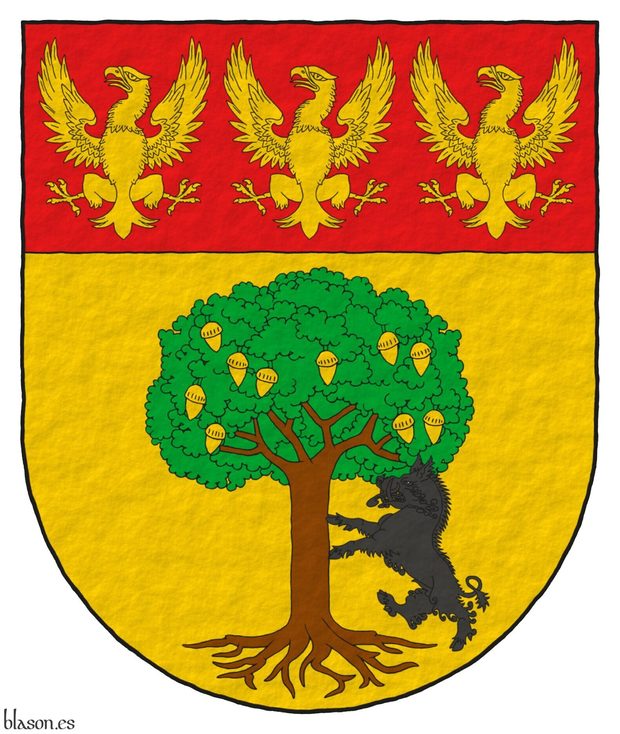
Or, an oak tree proper, fructed Or, with a boar supporting it Sable; on a chief Gules, three eagles displayed Or.
Escudo de oro, un roble al natural, frutado de oro, con un jabalí empinado de sable; en un jefe de gules, tres águilas de oro.
Escudo interpretado por mí, en tinturas planas, delineado de sable, con un contorno exterior medio punto y con un terminado texturizado.
Coat of arms of Manuel Maria Aras Quirce designed by Juan Lanzagorta Vallin and emblazoned by me.
Credits: Juan Lanzagorta Vallin is the designer of the coat of arms.
Blazon keywords: Or, One, Oak, Tree, Proper, Fructed, Boar, Supporting, Sable, Chief, Gules, Three and Eagle.
Style keywords: Outlined in sable, Plain tincture and Semi-circular.
Classification: Personal, Interpreted and Coat of arms.
Bearer: Aras Quirce, Manuel Maria.


Argote de Molina, Gonzalo
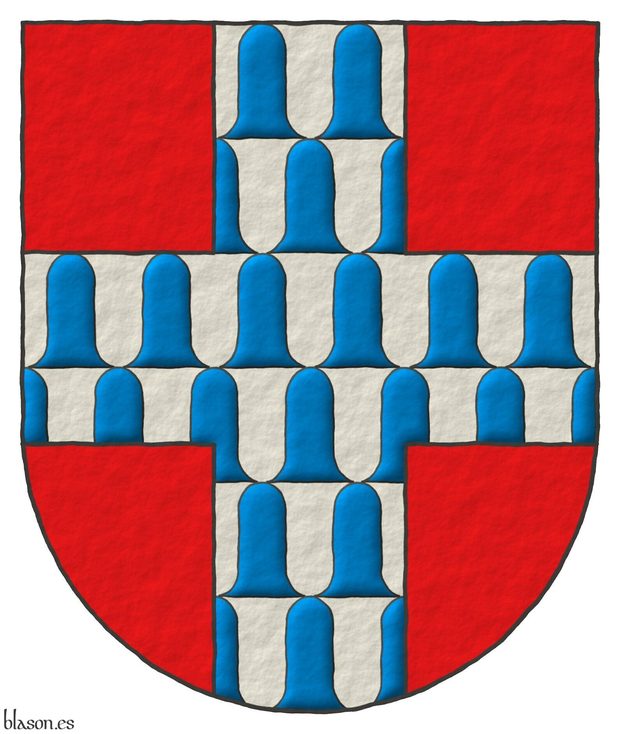
Gules, a cross vair ancient.
Escudo de gules, una cruz de veros antiguos.
Coat of arms that I have interpreted as follows: the shield has a semicircular (round) base; the field is in flat tincture of Gules; the ancient vair, rounded or of the old form, which are always Argent and Azure, are illuminated and outlined in Sable; and the whole of the hereditary coat of arms has a raised-stroke drawing.
Este escudo puede encontrarse en el libro del propio [Argote de Molina, G.; 1588; páginas 14 y 168], en la página 14 en grande, con cimera y rodeado de otros escudos de menor tamaño y en la página 168 de menor tamaño, con yelmo y lambrequines. En ambos casos el trazado de los veros es antiguo, redondeados, y en estas interpretaciones así los he reflejado.
Blazon keywords: Without divisions, Gules, Argent, Azure, Cross and Vair ancient.
Style keywords: Freehand, Illuminated and Outlined in sable.
Classification: Interpreted, Personal, Coat of arms and Heraldry and heralds.
Bearer: Argote de Molina, Gonzalo.


Argudo of Guipuzcoa, lineage
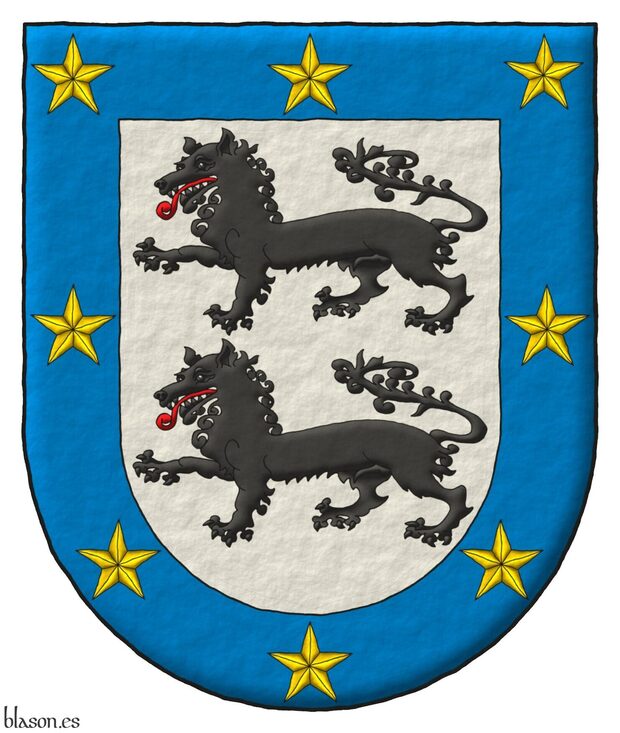
Argent, two wolves passant, in pale Sable, langued Gules; a bordure Azure charged with eight mullets Or.
Escudo de plata, dos lobos pasantes, en palo de sable, lampasados de gules; una bordura de azur cargada de ocho estrellas de oro.
Arms depicted by me, illuminated with lights and shadows, outlined in Sable, with a semi-circular outer contour and with a freehand finishing.
Ancient arms of the lineage Argudo of Guipuzcoa emblazoned by me. The lineage Ochoa of Vergara has a blazon equivalent to this one. Alternative blazon: «Argent, two wolves passant, in pale Sable, langued Gules; on a bordure Azure, eight mullets Or».
Blazon keywords: Argent, Sable, Gules, Azure, Or, One, Eight, Wolf, Passant, In pale, Bordure and Mullet.
Style keywords: Outlined in sable, Illuminated, Semi-circular and Freehand.
Classification: Personal, Lineage, Interpreted, Boa and Coat of arms.
Bearer: Argudo of Guipuzcoa, lineage.


Arms of Johann Anton Freiherr von Quast without mantle
Gules, a saltire Or charged with a fillet saltire Sable between in chief three escallops reversed Or; in dexter, a dexter arm embowed, vambraced Argent, holding an anchor Or; in sinister a two masted warship, with cannons ports and sails hoisted Or, two flags Gules, Argent and Azure flying to dexter, one in the main mast and one in the stern, on the hull the inscription «La Liberta» Sable; in base a crowned double-headed eagle displayed Or, holding two tassels, one in each beak, and two mullets of six points pierced, one in each talon Argent. Crest: A helm befitting his degree, bearing an Adelskrone held in its place by two men Sable, vested with feather skirts Gules, each standing on the shield, and holding in his outer hand a diagonally placed tournament spears, headed Argent, and issuant from the Adelskrone, between two elephants' trunks, the one at dexter Or, the one at sinister Gules, two ostrich feathers in saltire, the one bendwise Argent, and the one bend sinisterwise Sable.
Coat of arms emblazoned by me, illuminated with lights and shadows, contoured in Sable, with an ogee outer contour and with a watercolor finish.
This is the coat of arms of Johann Anton Freiherr von Quast that was painted in the Freiherren diploma that was issued in 1790. This coat of arms has been emblazoned by me because the family needed a modern version that can be used digitally. More information about the family can be found on the website juchtervanbergenquast.wordpress.com.
Blazon keywords: Gules, Or, Argent, Azure, One, Three, Two, Saltire, Fillet saltire, Between, In chief, Escallop, Reversed, In dexter, Dexter, Arm, Embowed, Vambraced, Grasping, Anchor, Ship, Cannon port, Sail, Inscribed, In base, Crowned, Double-headed, Eagle, Tassel, Beak, Mullet of six points pierced, Talon, Crest, Helm, Mantle, Lined, Crown, Male figure, Vested, Feather, Skirt, Upon, Hand, Spear, Issuant, Trunk (elephant), Ostrich feather, In saltire, Bendwise and Bend sinisterwise.
Style keywords: Outlined in sable, Illuminated, Ogee and Watercolor.
Classification: Personal, Interpreted, Boa, Coat of arms and Flag.
Bearer: Quast, Johann Anton Freiherr von.


Arrano Beltza
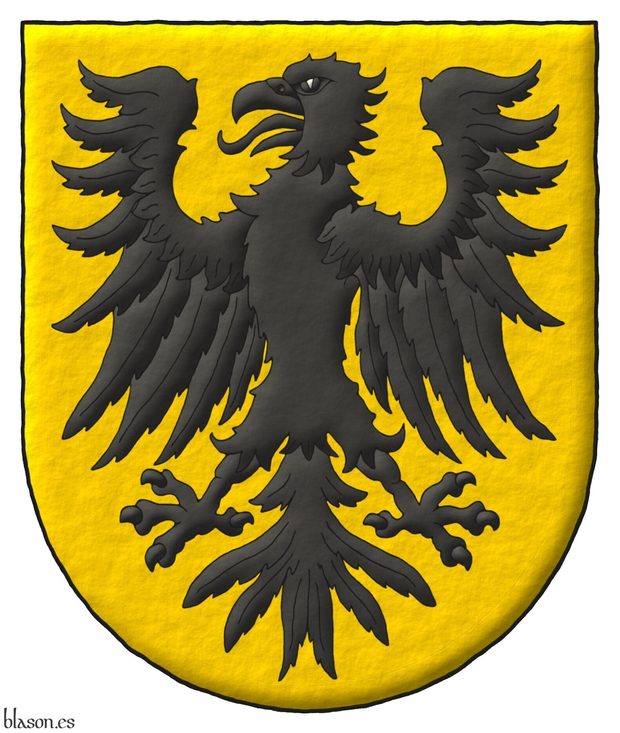
Or, a eagle displayed Sable.
Escudo de oro, un águila de sable.
Arms painted by me, illuminated with lights and shadows, contoured in Sable, and with a freehand finish.
Coat of arms of the Arrano Beltza, the black eagle in Basque, emblazoned by me.
Blazon keywords: Or, Sable, One, Eagle and Displayed.
Style keywords: Outlined in sable, Illuminated and Freehand.
Classification: Civic, Interpreted, Boa and Coat of arms.
Bearer: Arrano Beltza.


Artillery Combat School of the Swedish Army
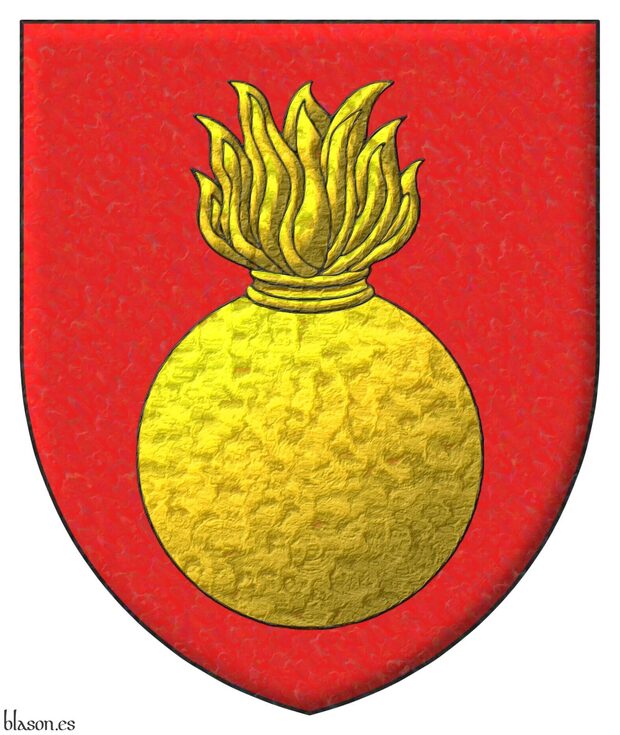
Kingdom of Sweden.
Gules, a grenade Or.
Escudo de gules, una bomba de oro.
Illuminated with lights and shadows and with a iridescent and metallic finish.
Blazon keywords: Without divisions, Gules, One, Grenade and Or.
Style keywords: Metal beaten, Iridescent (nacar), Outlined in sable, Illuminated and Pointed.
Classification: Interpreted, Military and Kingdom of Sweden.
Bearer: Artillery Combat School of the Swedish Army.


Arturo Taborda, collage
Azure, issuant from base a frog's head and from flanks its forelegs in chevron Or, in chief a mullet of seven points Argent. Crest: Upon a helm with a wreath Or and Azure, a demi-frog erect Or, grasping with its forelegs an apple and a closed book Azure. Mantling: Azure doubled Or.
Coat of arms of Arturo Taborda, Venezuela. The image combines a photograph of a drawing of a demi-frog erect, grasping with its forelegs an apple and a closed book, along with his coat of arms, both painted by me.
Blazon keywords: Azure, Or, Argent, One, Seven, Issuant from base, Frog, Head, Flank, Foreleg, In chevron, In chief, Mullet, Crest and mantling, Crest, Upon (wreath), Helm, Wreath, Demi, Erect, Grasping, Apple, Closed book, Book, Mantling and Doubled.
Style keywords: Outlined in sable, Illuminated and Ogee.
Classification: Personal, Interpreted, Boa, Collage and Photographic.
Bearer: Taborda, Arturo.


Asuncion and de la Asuncion, lineages
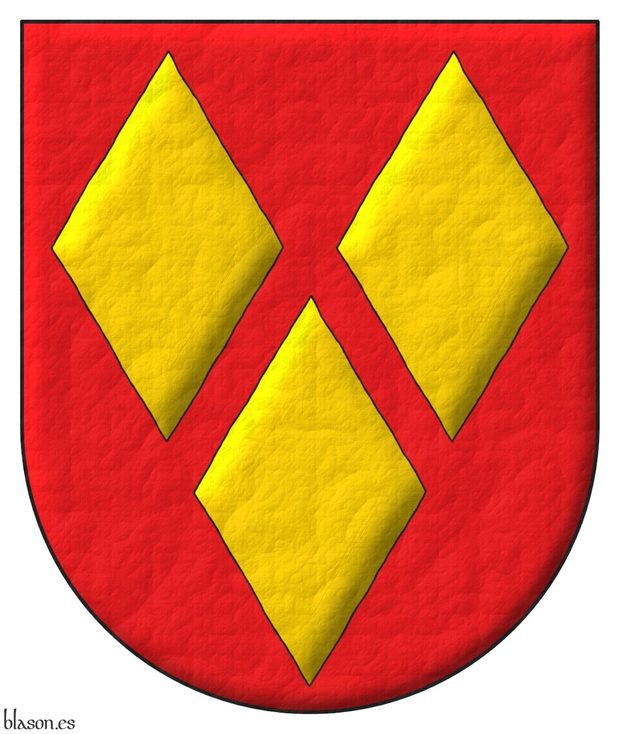
Gules, three lozenges Or.
Escudo de gules, tres losanjes de oro.
Arms painted by me, highlighted with lights and shadows, outlined in Sable, with a semi-circular external shape and with a leather finish.
Coat of arms of the lineages Asuncion and de la Asuncion emblazoned by me.
Blazon keywords: Gules, Or, Three and Lozenge.
Style keywords: Outlined in sable, Illuminated, Semi-circular and Leather.
Classification: Personal, Interpreted, Boa and Coat of arms.
Bearer: Asuncion and de la Asuncion, lineages.


Austin Charles Berry
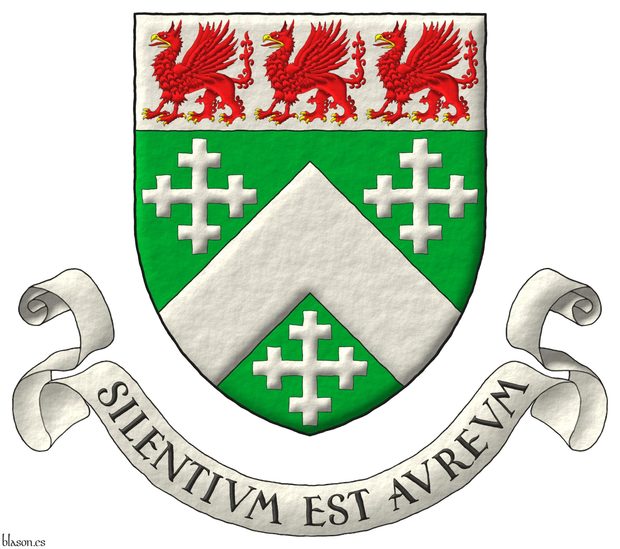
Vert, a chevron, between three cross-crosslets; on a chief Argent, three griffins statant Gules, beaked and armed Or. Motto: «Silentium est aureum».
Escudo de sinople, un cabrio, acompañado de tres cruces recrucetadas; un jefe todo de plata, tres grifos parados de gules, picados y armados de oro. Lema: «Silentium est aureum».
Blazon keywords: Vert, One, Chevron, Between, Three, Cross-crosslet, Cross couped, Chief, Argent, Griffin, Statant, Gules, Beaked, Armed, Or and Motto.
Style keywords: Pointed, Outlined in sable, Illuminated and Freehand.
Classification: Personal, Interpreted, Coat of arms and Latin language.
Bearer: Berry, Austin Charles.


Avelar, lineage of Portugal
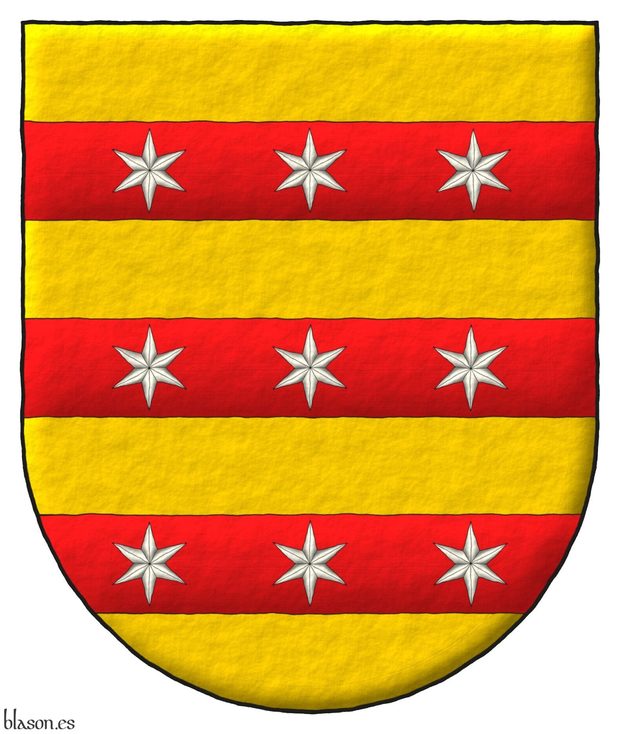
Blazon of the Avelar lineage of Portugal.
Or, three bars Gules charged each one with three mullets of six points Argent.
Illuminated and a freehand finishing.
It can be found at [Cró, J. do; 1509; page 127].
Blazon keywords: Without divisions, Or, Three, Fess, Gules, Charged, Mullet and Argent.
Style keywords: Freehand, Outlined in sable, Illuminated and Semi-circular.
Classification: Interpreted, Lineage and Kingdom of Portugal.


Aybar of Navarre
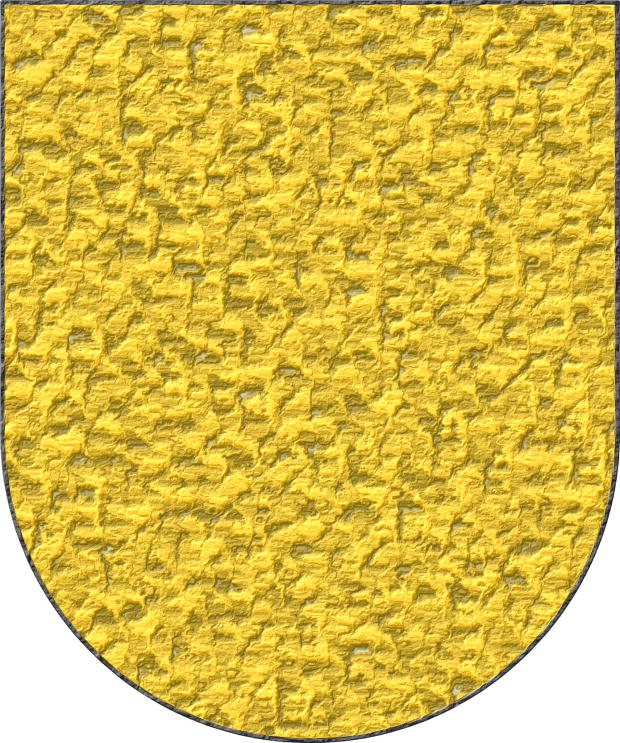
Of the twelve lineages of Noblemen, they are the third great and ancient barony, where the first King of Aragon had his mother; they make a shield of Or without any mixture of colour or device, but a field of gold as painted in this shield.
Or.
Escudo de oro.
A coat of arms that leaves little room for interpretation, which I have recreated with: a semicircular (round) base; the field in flat Or; and finished in highly-hammered metal.
Based on the third coat of arms of the «ricoshombres» of Navarre from [Bosque, J. del; 1540; folio 1 of the numbering of 1613] and the text is from the transcription made in [Martinena Ruiz, J. J.; 1982; pages 122 and 123].
Under the title «Surname of Aybar» it can also be consulted in [Vega, P. J. de; 1702; folio 3 of the manuscript].
Blazon keywords: Without divisions and Or.
Style keywords: Semi-circular, Illuminated, Outlined in sable and Hard metal.
Classification: Interpreted, Personal and Kingdom of Navarre.
Bearer: Aybar of Navarre.


Badge of Brady Brim-DeForest
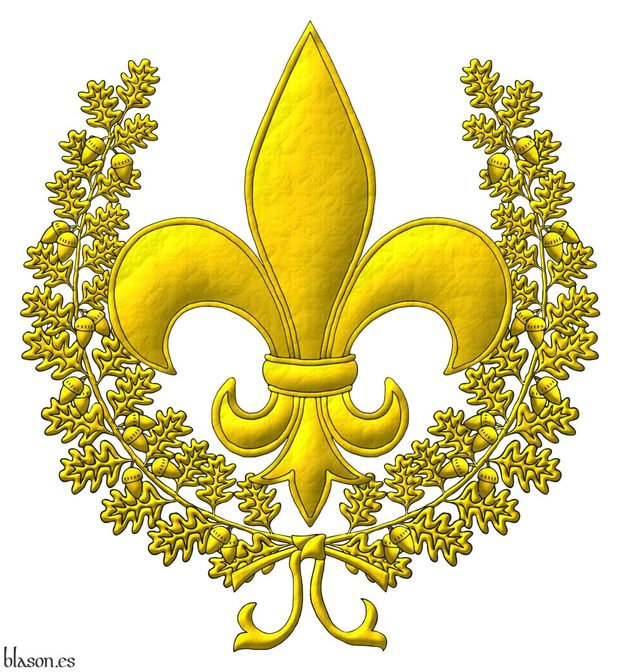
Heraldic device painted by me, illuminated with lights and shadows, outlined in Sable, and with a leather finish.
The heraldic badge of Brady Brim-DeForest emblazoned by me.
Blazon keywords: Or, Two, One, Fleur de lis, Oak, Tree and Branch.
Style keywords: Outlined in sable, Illuminated and Leather.
Classification: Personal, Interpreted, Boa and Badge.
Bearer: Brim-DeForest, Brady.


Badge Rick Kasparek
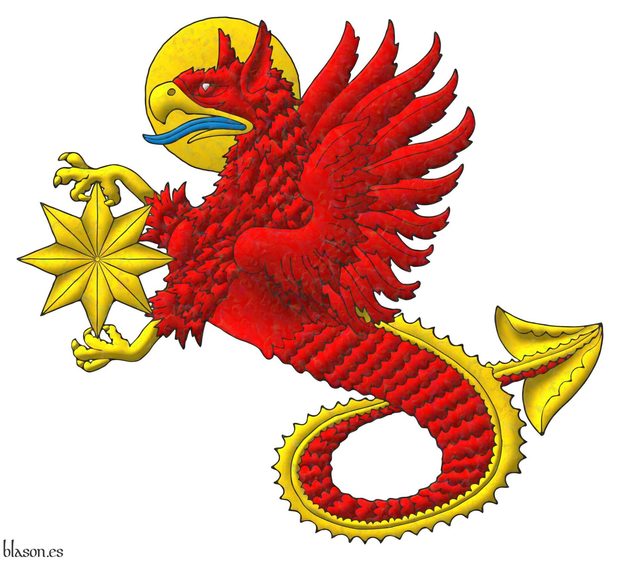
A sea-griffin erect Sanguine, membered, beaked, nimbed, dorsal and tail fins Or, langued Azure, grasping in its talons a mullet of eight points Or.
Heraldic device painted by me, highlighted with lights and shadows, contoured in Sable, and with a iridescent finishing.
Heraldic badge of Rick Kasparek emblazoned by me.
Blazon keywords: Sanguine, Or, Azure, One, Eight, Sea-griffin, Erect, Membered, Beaked, Nimbed, Dorsal fin, Tail fin, Langued, Grasping, Talon and Mullet.
Style keywords: Outlined in sable, Illuminated and Iridescent.
Classification: Personal, Interpreted, Boa and Badge.
Bearer: Kasparek, Rick.


Bailleul, commune of

Gules, a cross vair.
Escudo de gules, una cruz de veros.
Coat of arms interpreted with: a semicircular (round) base; the field in flat tincture of Gules; the vair illuminated and outlined in Sable; and the whole with a roughened finish.
The commune of Bailleul is located in the district of Dunkirk, in the Nord department, in the Nord–Pas-de-Calais region of France.
The coat of arms of Bailleul, called «Belle» in Flemish, is similar to that of the heraldist Gonzalo Argote de Molina, differing in that the commune’s arms bear vair, while the heraldist’s arms bear rounded vair in the ancient style.
Blazon keywords: Without divisions, Gules, Argent, Azure, Cross and Vair.
Style keywords: Semi-circular, Illuminated, Outlined in sable and Rough.
Classification: Interpreted, Civic, Coat of arms and Kingdom of France.
Bearer: Bailleul, commune of.


Balaguer, municipality of

Quarterly per saltire: 1 and 4 Or, four pallets Gules; 2 and 3 chequey Or and Sable.
Escudo cuartelado en sotuer: 1o y 4o de oro, cuatro palos de gules; 2o y 3o ajedrezado de oro y sable.
Arms interpreted with: a lozenge-shaped shield; all tinctures in flat Or, Gules, and Sable; and a heavily beaten metal finish.
Balaguer is the capital of the comarca of La Noguera in the province of Lleida. It was the capital of the county of Urgell under Ponce I of Urgell.
The quartering per saltire, which could also be called quartered in cross, is defined in English as «per saltire», [The Heraldry Society; 2013; page 8].
Blazon keywords: Quarterly per saltire, Pale, Chequey, Or, Gules and Sable.
Style keywords: Tiled, Plain tincture and Hard metal.
Classification: Interpreted, Civic, Coat of arms and Kingdom of Aragon.
Bearer: Balaguer, municipality of.


Bartholomew de Yattendon
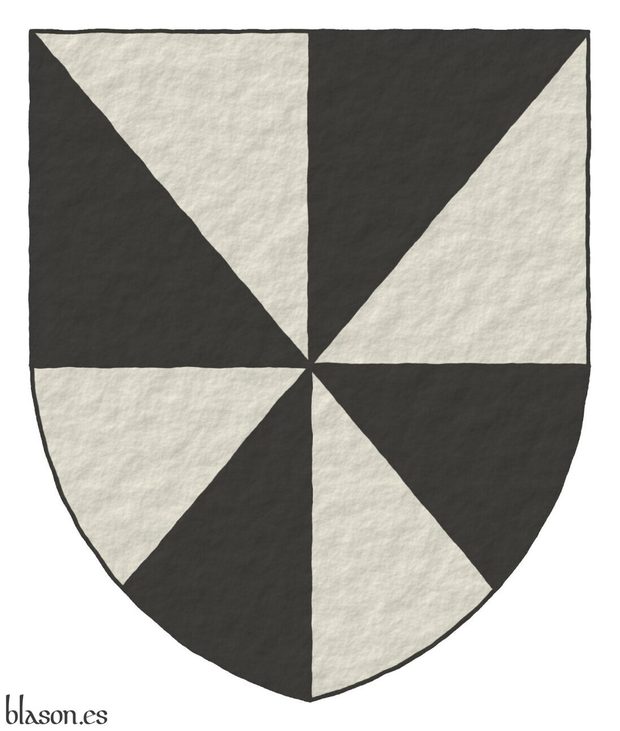
Bartholomew de Yattendon ~ Bartholomeu de Loctringdene.
Gyronny Argent and Sable.
Jironado de plata y sable.
Included in [Vincent, MS; 1285; number 88] also known as [St. George's Roll; 1285; number 88].
Blazon keywords: Gyronny, Argent and Sable.
Style keywords: Pointed, Plain tincture, Outlined in sable and Freehand.
Classification: Interpreted and Personal.
Bearer: Bartolomé de Yattendon.


Baudry in France
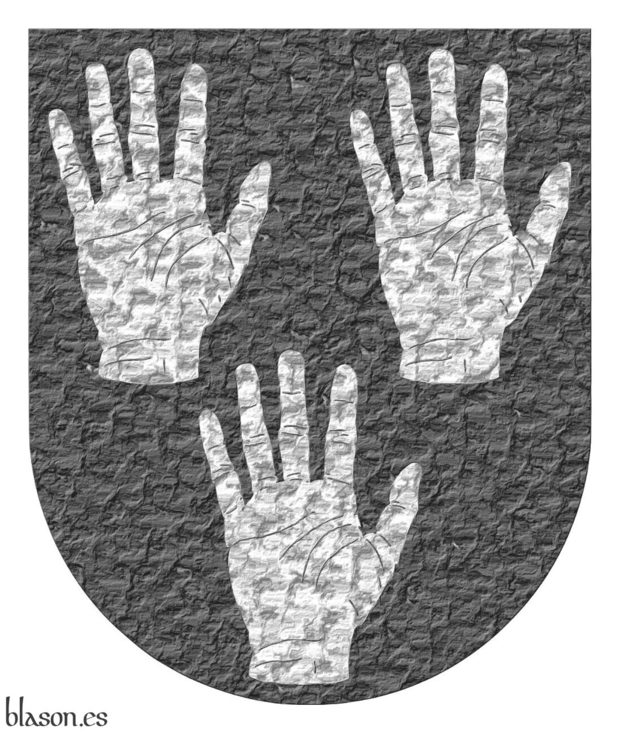
Sable, three dexter hands turned up, and appaumée Argent.
Escudo de sable, tres manos diestras levantadas y apalpadas de plata.
Coat of arms interpreted based on blazon and explanations of [Avilés, J.; 1725a; pages 34 y 35 y sheet 2 figure 38].
Blazon keywords: Without divisions, Sable, Three, Hand, Dexter, Argent, Turned up, Appaumée and Ordered.
Style keywords: Semi-circular, Plain tincture, Outlined in the field tincture and Soft metal.
Classification: Interpreted, Personal and Kingdom of France.
Bearer: Baudry en Francia.


Baz Manning, plain tincture
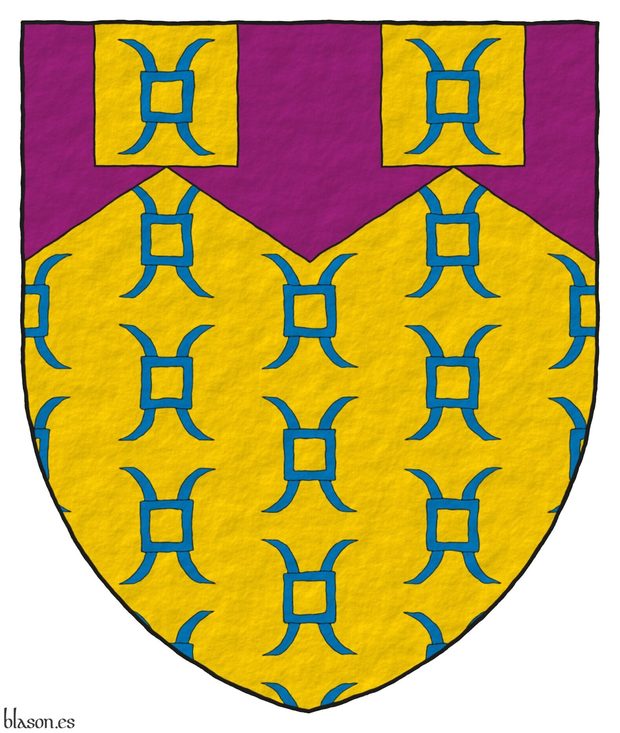
Or semé of millrinds Azure, a chief dancetty of two full points upwards Purpure pierced twice of the field billetwise throughout.
Arms emblazoned by me, in flat tinctures, outlined in Sable, with a pointed external shape and with a texturized finishing.
The coat of arms of Baz Manning, John Basil Edward, emblazoned by me. When it is «voided»~«hueco» the hole matches the shape of the piece or figure, and when it is «pierced»~«perforado» the hole has a different shape, usually circular, but in this case, it is rectangular, like a billet. In both cases, the field, in this case, semé, is visible through the hole, so it would not be necessary to specify this unless the hole is of another tincture, in which case it must be specified. When it is also «throughout»~«moviente» that means that the hole touches the borders, generally all, in this case only the upper and lower border.
Blazon keywords: Or, Azure, Purpure, One, Two, Three, Semé, Millrind, Chief, Dancetty, Pierced, Billet and Throughout (chief base).
Style keywords: Outlined in sable, Plain tincture and Pointed.
Classification: Personal, Interpreted, Boa and Coat of arms.
Bearer: Manning, Baz.


Baztanes of Navarre

Of the twelve lineages of Noblemen, it is the fourth, and they bear as arms a chessboard, that is, a field chequy Argent and Sable, which is black, in the same form and design as this shield is now painted.
Chequey Argent and Sable.
Escudo ajedrezado de plata y sable.
Coat of arms recreated with: a semicircular (round) base; the field in flat Argent; the chequy or checky pattern illuminated in Sable; and finished in highly-hammered metal.
Coat of arms based on the fourth of the Navarrese «ricoshombres» from [Bosque, J. del; 1540; folio 1 of the numbering of 1613], but, unlike the original, adjusting the height of each square to its width so that they are perfect squares, since in Juan del Bosque’s version—actually in its copy, because the original was stolen—they appear somewhat narrow and elongated. The text heading this article is taken from the transcription made by [Martinena Ruiz, J. J.; 1982; pages 122 and 123].
Under the title «Surname of Baztan» it can also be consulted in [Vega, P. J. de; 1702; folio 4 of the manuscript], although in this case the numbering is not clearly legible; it is the folio following 3, preceding the one also numbered 4 but marked with a letter B, which in turn is followed by folio 6, the number 5 being missing — though not folio 5, which would be 4B.
Baztanes and the Valley of Baztan are mentioned in [Garaycoa Raffo, L.; 2011; pages 8, 29, 30, 33, 37, and 38].
The geometric construction of this coat of arms can be found in [Messía de la Cerda y Pita, L.; 1990; page 108].
Blazon keywords: Without divisions, Or, Chequey and Sable.
Style keywords: Semi-circular, Illuminated and Hard metal.
Classification: Interpreted, Personal and Kingdom of Navarre.
Bearer: Baztanes of Navarre.


Beatrice of Swabia

Or, an eagle displayed Sable.
Escudo de oro, un águila de sable.
Coat of arms painted by me, highlighted with lights and shadows, outlined in Sable, with an ogee external shape and with a freehand finishing.
Coat of arms of the Queen Beatrice of Swabia, 1205–1235, baptized as Elisabeth, wife of King Ferdinand III of Castile, 1199–1252. The eagle Sable on an Or field is a distinctive symbol of the Holy Roman Empire. This coat of arms has been emblazoned by me.
Blazon keywords: Or, Sable, One and Eagle.
Style keywords: Outlined in sable, Illuminated, Ogee and Freehand.
Classification: Personal, Interpreted, Boa and Coat of arms.
Bearer: Beatrice of Swabia.


Bedgood, Alvin J.
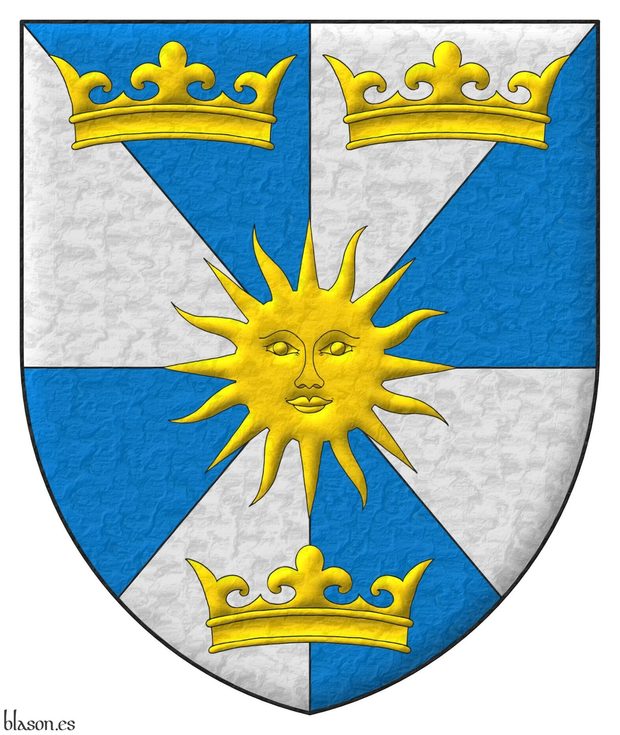
Gyronny Azure and Argent, a Sun in splendour between three Ancient coronets Or.
Illuminated and metal finishing.
Blazon keywords: Gyronny, Azure, Argent, Sun in splendour, Between, Three, Ancient coronet, Crown and Or.
Style keywords: Metal beaten, Outlined in sable and Illuminated.
Classification: Personal, Interpreted and Coat of arms.
Bearer: Bedgood, Alvin J..


Bella, Giovanni de

Gules, a fess between, in chief a Maltese cross between two mullets of eight points Argent, in base three bendlets Or.
Coat of arms emblazoned by me with a pointed shape, illuminated, and with a watercolor finishing.
G0053, Chief Herald of Malta's grant of Giovanni de Bella's arms, whose coat of arms has been emblazoned by me.
Blazon keywords: Gules, One, Fess, Between, In chief, Eight-pointed cross, Cross couped, Two, Mullet, Eight, Argent, In base, Three, Bendlet and Or.
Style keywords: Outlined in sable, Illuminated, Watercolor and Pointed.
Classification: Personal, Interpreted and Coat of arms.
Bearer: Bella, Giovanni de.


Benedict XII
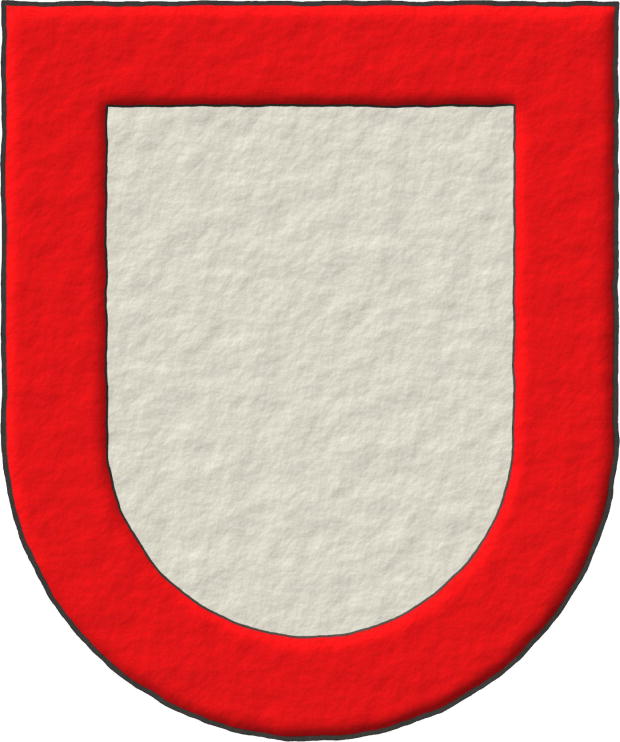
197th Pope of the Church, from 1334 to 1342. «Benedictus XII», born Jacques Fournier, was born in Saverdun, in the south of Occitania.
Argent, a bordure Gules.
Escudo de plata, una bordura de gules.
Papal coat of arms interpreted with: a round-topped shield; the field in plain Argent; the bordure outlined in Sable and illuminated in Gules; and the whole design in raised outline.
Blazon keywords: Without divisions, Argent, One, Bordure and Gules.
Style keywords: Semi-circular, Illuminated, Outlined in sable and Freehand.
Classification: Interpreted, Religious and Papal States.
Bearer: Benedict XII.


Benedict XIV
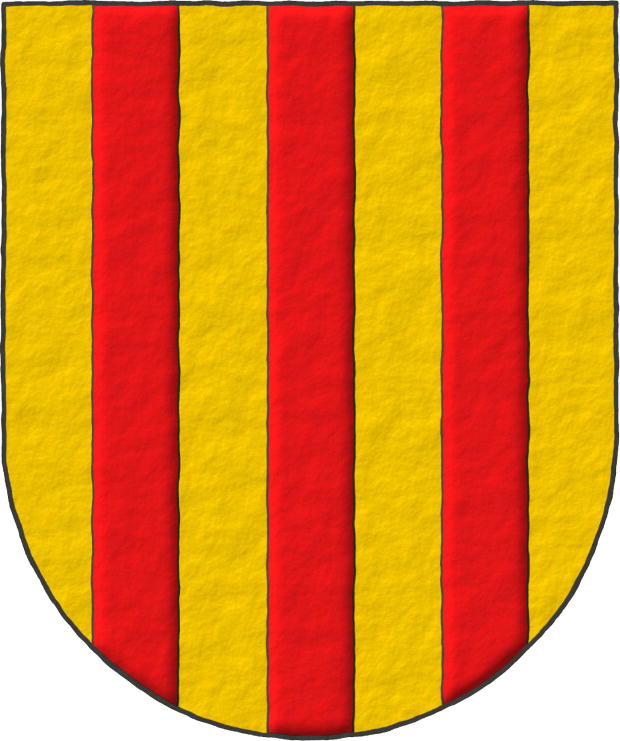
247th Pope of the Church, from 1740 to 1758. «Benedictus XIV», named Prospero Lorenzo Lambertini, born in Bologna.
Or, three pallets Gules.
Escudo de oro, tres palos de gules.
Papal coat of arms interpreted with: a rounded mouth; the field in flat tincture of Or; the pales outlined in Sable and illuminated in Gules enamel; and the whole with a raised stroke finish.
Blazon keywords: Without divisions, Or, Three, Pale and Gules.
Style keywords: Semi-circular, Illuminated, Outlined in sable and Freehand.
Classification: Interpreted, Religious and Papal States.
Bearer: Benedict XIV.


Berenguela of Castile

Born in 1179 in Segovia and died on November 8, 1246 in the Monastery of Las Huelgas in Burgos.
Gules, a castle triple towered Or, port and windows Azure, masoned Sable.
Escudo de gules, un castillo de oro, aclarado de azur, mazonado de sable.
Arms of the Queen of Castile, as interpreted by me: the shape of the shield is rounded; the field and the castle have been enamelled and illuminated; and the whole composition features a watercolor finish.
Blazon keywords: Without divisions, Gules, Or, Azure, Sable, One, Castle, Port and windows and Masoned.
Style keywords: Semi-circular, Illuminated, Outlined in sable and Watercolor.
Classification: Interpreted, Personal, Coat of arms and Kingdom of Castile.
Bearer: Berenguela of Castile.


Bergamo, plain tincture
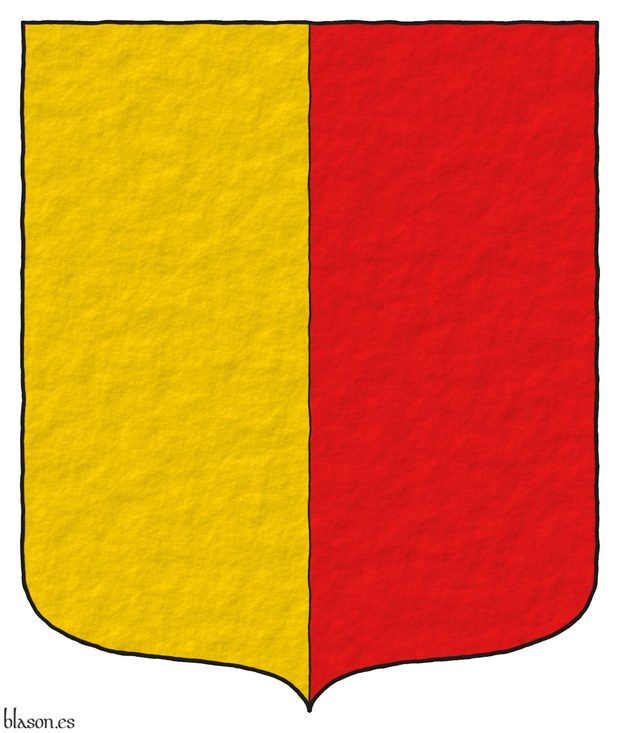
Party per pale Or and Gules.
Arms painted by me, in plain tinctures, outlined in Sable, with an ogee external shape and with a texturized finish.
The coat of arms of the city of Bergamo, Lombardy, emblazoned by me.
Blazon keywords: Or, Gules and Party per pale.
Style keywords: Outlined in sable, Plain tincture and Ogee.
Classification: Civic, Interpreted, Boa and Coat of arms.
Bearer: Bergamo.


Berlin
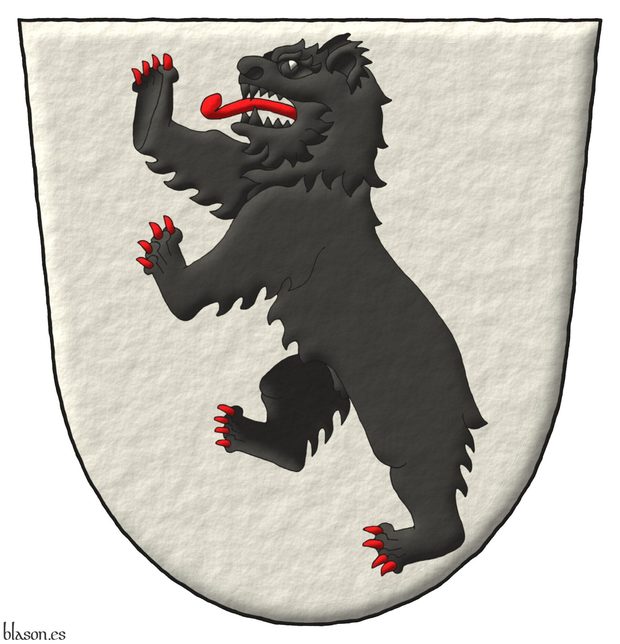
Argent, a bear rampant Sable, langued and armed Gules.
Escudo de plata, un oso rampante de sable, lampasado y armado de Gules.
Arms interpreted by me, illuminated with lights and shadows, contoured in Sable, with a rounded trapezoidal outer contour and with a freehand finishing.
The coat of arms of the city of Berlin emblazoned by me.
Blazon keywords: Argent, Sable, Gules, One, Bear, Rampant, Langued and Armed.
Style keywords: Outlined in sable, Illuminated, Rounded trapezoid and Freehand.
Classification: Civic, Interpreted, Boa and Coat of arms.
Bearer: Berlin.


Bernard de Tremelay tricking, hatching and plain tincture
Or, a chief Gules.
Blazon keywords: Or, Chief and Gules.
Style keywords: Outlined in sable, Semi-circular, Tricking, Hatching and Plain tincture.
Classification: Religious, Military, Knights Templar, Interpreted, Coat of arms and Schema.
Bearer: Tremelay, Bernard de.


Berry of Molland
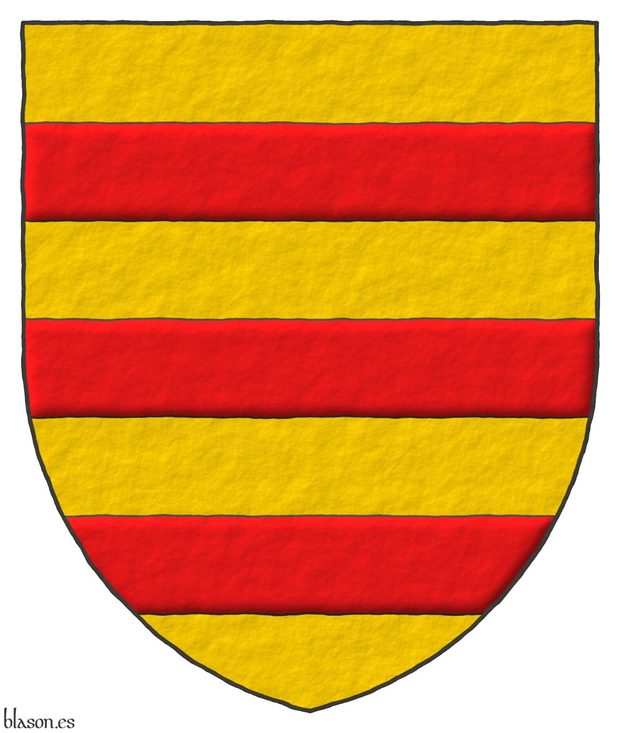
Berry of Molland, Devonshire.
Or, three fesses Gules.
Escudo de oro, tres fajas de gules.
It is possible that an English-speaking herald would have blazoned it as «Or, three bars Gules.» using the term «bars» instead of «fesses», just as in Castilian one sometimes uses the term «barras» instead of «palos», perhaps because these terms were not completely settled from the outset.
Blazon keywords: Without divisions, Or, Fess and Gules.
Style keywords: Pointed, Illuminated, Outlined in sable and Freehand.
Classification: Interpreted and Personal.
Bearer: Berry of Molland.
Blazon equivalent to: Clement V.


Bertrand de Blanchefort two-step scheme
Barry of four per pale counterchanged Or and Gules.
Blazon keywords: Barry per pale counterchanged, Four, Or and Gules.
Style keywords: Outlined in sable, Semi-circular, Ratio and Plain tincture.
Classification: Religious, Military, Knights Templar, Interpreted, Coat of arms and Schema.
Bearer: Blanchefort, Bertrand de.


Bosnia and Herzegovina

From 1992 to 1998
Azure, a bendlet Argent between six fleurs de lis Or.
Illuminated with lights and shadows and with a metallic and iridescent finish.
Coat of arms of Stephen Tvrtko I (circa 1338-1391) of the House of Kotromanic and 1st King of Bosnia and it was also the coat of arms of Bosnia and Herzegovina from 1992 to 1998.
The bendlet is a diminished piece. It is called bendlet («cotiza» in Castilian, «cotice» , and «cotissa» in Italian «cotice» in French, and «cotissa» in Italian) a diminished bend, narrower, reduced to 1/2 (as in this case) or to 1/3 of the width of a normal bend. Remember that the width of the bend is usually 1/3 of the width of the coat of arms, therefore the width of the bendlet is between 1/3 * 1/2 = 1/6 and 1/3 * 1/3 = 1/9 of the width of the coat of arm.
Stephen Tvrtko I of Bosnia, from the House of Kotromanic, was a vassal of Louis I of Hungary. Louis I or Louis of Anjou, known as «the Great», from the Royal House of Anjou-Sicily, of the Capetian Dynasty, hence his coat of arms's 2nd quarter is seeded with fleur de lis, a feature also present in his father Charles I's arms, known as Charles Robert or Caroberto of Anjou. The Kotromanic family had in their coat of arms fleur de lis Or on a Azure field as a symbol of subordination to the Hungarian royal family.
Blazon keywords: Azure, One, Bendlet, Argent, Six, Fleur de lis and Or.
Style keywords: Metal beaten, Iridescent, Outlined in sable, Illuminated and Pointed.
Classification: Civic, Interpreted and Coat of arms.
Bearer: Bosnia and Herzegovina.


Boteler of Warrington
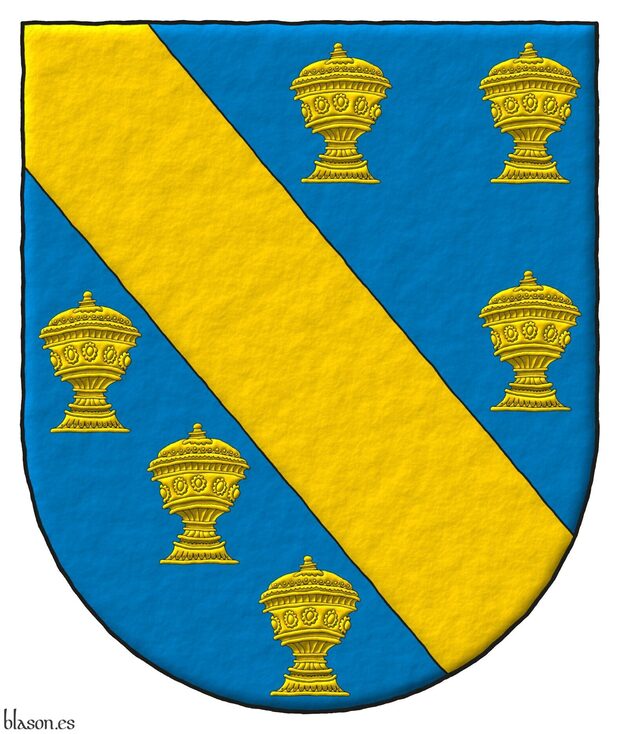
Azure, a bend between six covered cups Or.
Escudo de azur, una banda acompañada de seis copas todo de oro.
Illuminated with lights and shadows and with a freehand finish.
Around 1155, Beatrix de Villers married Richard le Boteler Pincerna, who became the 4th Baron of Warrington. The heir of Beatrix and Richard took the surname «le Boteler» and ruled the Warrington region, bearing arms Azure, a bend between six covered cups Or.
In Castilian, a «copa» has a lid and is referred to as a «covered cup» in English. When it doesn't have a lid, it's called a «cup» in English and a «cáliz» or «copón» in Castilian, the latter being a less preferred term for me. In English, the term «chalice» is also used, especially if it's adorned with gemstones, although that's more of an artistic license.
Naipes Heraclio Fournier is a renowned Spanish playing card manufacturer based in Villareal de Álava. The countless hours I have spent holding its cards in my hands are incalculable, whether playing with friends, opponents, or performing magic tricks. Its influence on my heraldic artwork is significant. For instance, in this covered cup.
The following image shows my covered cup and my two interpretations of his arms: 1) the most commonly viewed, and 2) my alternative layout.
Blazon keywords: Without divisions, Azure, One, Bend, Between, Six, Covered cup and Or.
Style keywords: Freehand, Outlined in sable, Illuminated and Semi-circular.
Classification: Interpreted and Kingdom of England.
Bearer: Boteler of Warrington.


Bourgeois, lineage of Burgundy
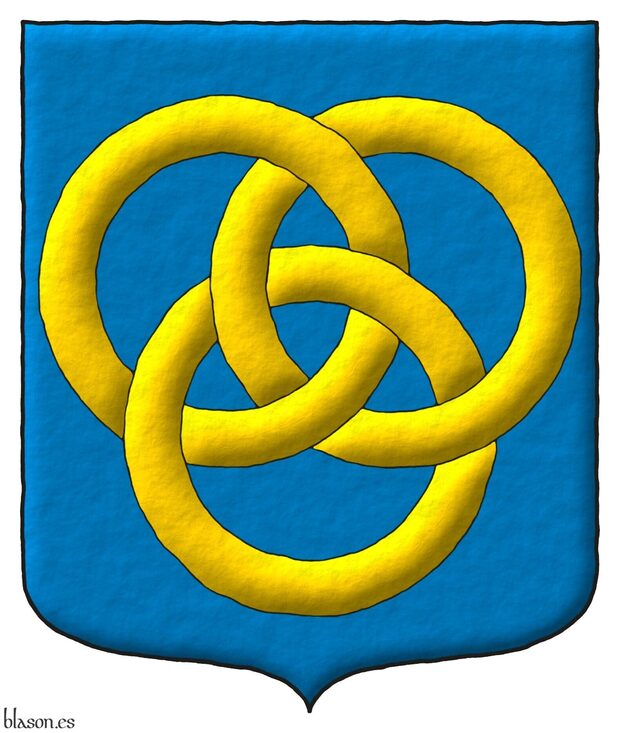
Azure, three annulets interlaced Or.
Illuminated, with a watercolor finishing and with a pointed shape.
You can found it at [Avilés, J.; 1725a; page 76 and illustration 177]], and at [Avilés, J.; 1780a; page 85 and illustration 177]].
Blazon keywords: Without divisions, Azure, Three, Annulet, Interlaced and Or.
Style keywords: Watercolor, Outlined in sable, Illuminated and Pointed.
Classification: Interpreted, Lineage, Kingdom of France and Coat of arms.


Bourgeois, lineage of Burgundy, France

Azure, three annulets interlaced Or.
Escudo de azur, tres anilletes entrelazados de oro.
Coat of arms emblazoned by me with plain color Azure and metal Or and with a shape ended with an ogee arch.
Blazon keywords: Without divisions, Azure, Three, Annulet, Interlaced and Or.
Style keywords: Watercolor, Outlined in sable, Illuminated and Ogee.
Classification: Interpreted, Lineage, Kingdom of France and Coat of arms.


Boyd of Scotland, lineage

Azure, a fess chequey Gules and Argent.
Escudo de azur, una faja ajedrezada de gules y plata.
Coat of arms interpreted by me, highlighted with lights and shadows, contoured in Sable, with a semi-circular external shape and with a freehand finishing.
Coat of arms of the lineage Boyd of Scotland. I have emblazoned it with a fess chequy of 3 rows, symmetric and with 9 columns of squares, provided that its height is 1/3 of the width of the coat of arms.
Blazon keywords: Azure, Gules, Argent, One, Three, Nine, Fess and Chequey.
Style keywords: Outlined in sable, Illuminated, Semi-circular and Freehand.
Classification: Personal, Lineage, Interpreted, Boa and Coat of arms.
Bearer: Boyd of Scotland, lineage.


BPAC I
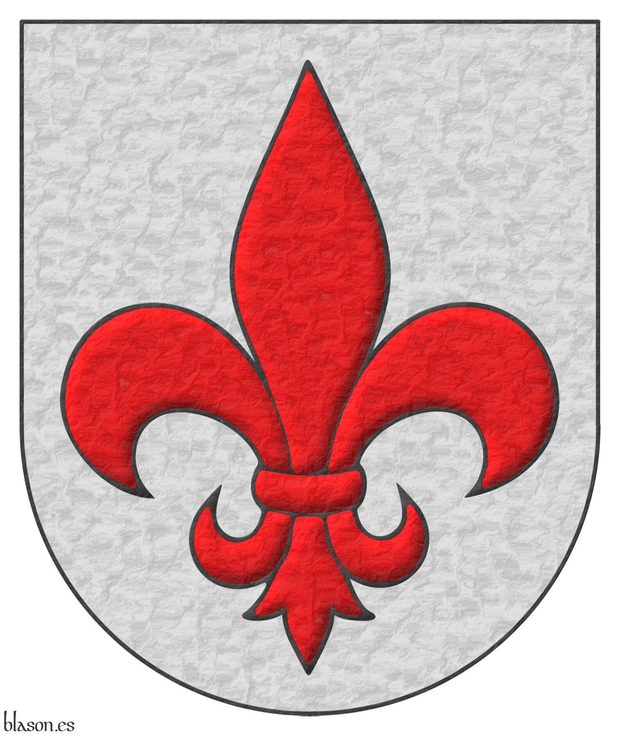
Flag «Roger de Flor», Paratroopers I, assigned to the «Almogávares» VI Paratrooper Brigade of the Spanish Army.
Argent, a fleur de lis Gules.
Escudo de plata, una flor de lis de gules.
Coat of arms interpreted with: a semicircular (round) base; a fleur de lis outlined in Sable and illuminated in Gules; and an overall lightly-hammered metal finish.
Blazon keywords: Without divisions, Argent, Gules and Fleur de lis.
Style keywords: Semi-circular, Illuminated, Outlined in sable and Soft metal.
Classification: Interpreted, Military, Army and Navy and Coat of arms.
Bearer: BPAC I.


BPAC II

«Roger de Lauria»,' 2nd Paratrooper Battalion, part of the «Almogávares» VI Parachute Brigade of the Spanish Army.
Argent, three bendlets sinister Azure.
Escudo de plata, tres barras de azur.
For this interpretation, I have used: an exterior shape ending in a semicircular arch; my usual angle of 50.2o = arctan(6/5), as tangent = opposite side / adjacent side; a division similar to that used by the Spanish Army for this coat of arms, which relies on dividing the height of the shield into 4 segments; and for the whole, a finish of lightly hammered metal
Blazon keywords: Without divisions, Argent, Azure and Bend sinister.
Style keywords: Semi-circular, Illuminated, Outlined in sable and Soft metal.
Classification: Interpreted, Military and Army and Navy.
Bearer: BPAC II.


British Monarchy
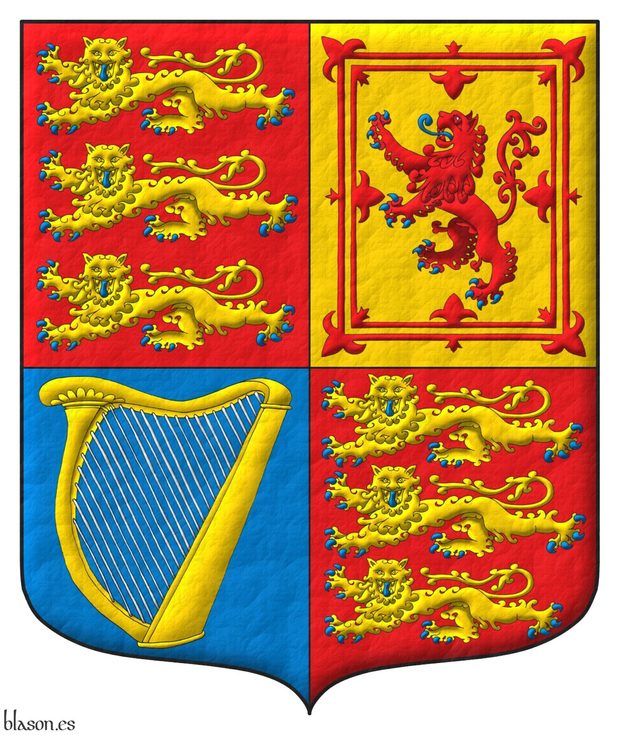
Quarterly: 1 and 4 Gules, three lions passant, guardant, in pale Or, armed and langued Azure; 2 Or, a lion rampant Gules, armed and langued Azure, within a double tressure flory counterflory Gules; 3 Azure, a harp Or, stringed Argent.
Escudo cuartelado: 1o y 4o de gules, tres leopardos en palo de oro, lampasados y armados de azur; 2o de oro, un león de gules, armado y lampasado de azur, encerrado en un trechor doble flordelisado y contraflordelisado de gules; 3o de azur, un arpa de oro cordada de plata.
Arms depicted by me, highlighted with lights and shadows, outlined in Sable, with an ogee external shape and with a leather finish.
These are arms of the British Monarchy emblazoned by me.
Blazon keywords: Gules, Or, Azure, One, Three, Quarterly, Leopard, Pale, Armed, Langued, Lion, Rampant, Double tressure, Flory, Counterflory, Harp and Stringed.
Style keywords: Outlined in sable, Illuminated, Ogee and Leather.
Classification: Civic, Interpreted, Boa and Coat of arms.
Bearer: British Monarchy.


![Ver [Brutus of Britain] en criterios utilizados. Unicornio saltante sobre la divisa, criterio.](../css/Unicornio.Criterio.png)
Brutus of Britain
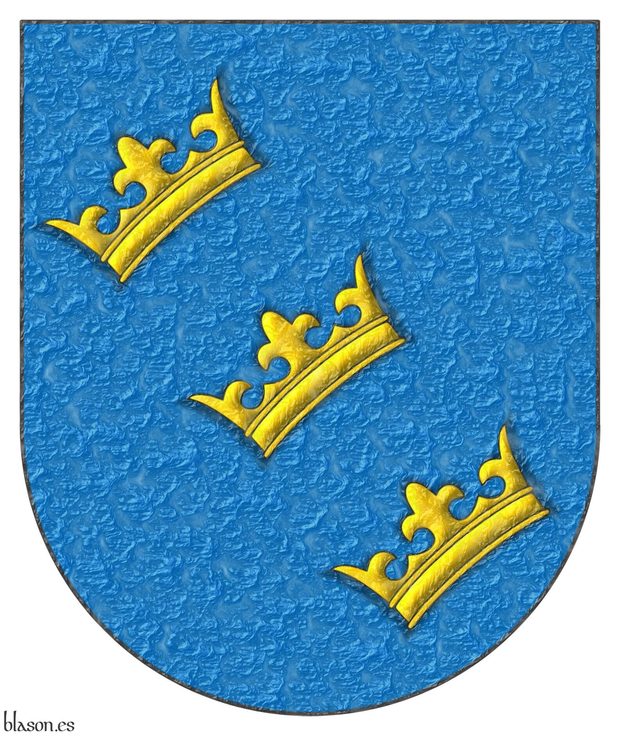
Azure, three crowns in bend, bendwise Or.
Escudo de azur, tres coronas en banda, puestas en banda de oro.
Coat of arms interpreted by me as described below: the field is enameled in plain Azure ink; the three crowns are outlined in Sable, illuminated in Or and shaded; and the imaginary shield has a crystalline finish.
Brutus of Britain, also known as Brutus of Troy, is a mythical character to whom, starting from the 9th century, is attributed the foundation of Britain and even the city of London, which is why this coat of arms is classified as imaginary, because both its holder and, therefore, its coat of arms are imaginary.
The interpretation of this coat of arms was made based on the banner that appears in [Edward IV of England; 1461; row 13, 1st column].
This coat of arms has served as the basis for the realization of the inescutcheon of the banner with the inescutcheon of Edward IV.
Blazon keywords: Without divisions.
Style keywords: Semi-circular, Illuminated, Shaded, Outlined in sable and Crystalline.
Classification: Interpreted, Imaginary, Coat of arms, Kingdom of England and Criterion.
Imaginary bearer: Brutus of Britain.


Bunyoro-Kitara
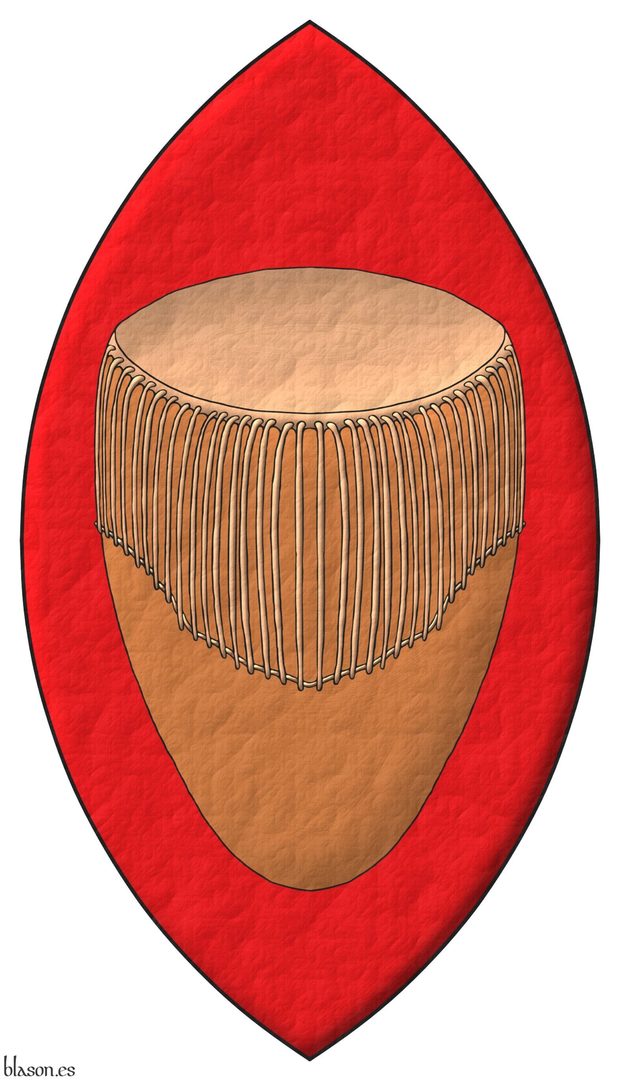
Gules, a Royal drum of Bunyoro-Kitara proper.
Escudo de gules, un tambor real de Bunyoro-Kitara al natural.
Coat of arms emblazoned by me with a visica piscis shape, illuminated, and with a leather finishing.
Bunyoro Kitara is a Bantu kingdom located in Western Uganda. Its history begun in the 13th century. This kindowm is ruled by the King called Omukama of Bunyoro-Kitara. Now it is a subnational monarchy.
Blazon keywords: Without divisions, Gules, One, Drum, Royal and Proper.
Style keywords: Vesica piscis, Outlined in sable, Illuminated and Leather.
Classification: Civic, Interpreted and Coat of arms.
Bearer: Bunyoro-Kitara.


Burr, lineage
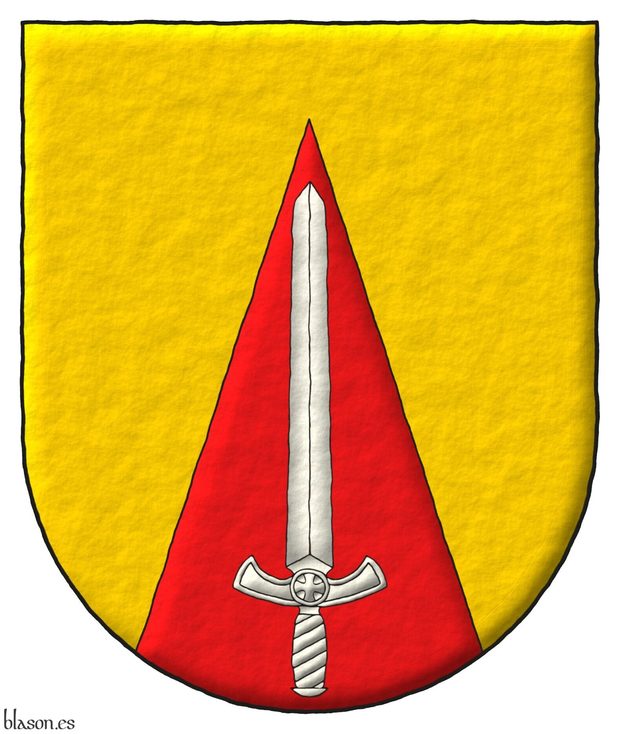
Or, on a pile issuant from the base Gules a sword point upwards Argent.
Escudo de oro, una pira de gules cargada de una espada alzada de plata.
Arms emblazoned by me, highlighted with lights and shadows, outlined in Sable, with a semi-circular outer contour and with a freehand finishing.
Coat of arms of the lineage Burr emblazoned by me based on the description by [Cadenas y Vicent, V. de; 1987; page 388].
Blazon keywords: Or, Gules, Argent, One, Pile issuant from base, Charged, Sword and Point upwards.
Style keywords: Outlined in sable, Illuminated, Semi-circular and Freehand.
Classification: Personal, Lineage, Interpreted, Boa and Coat of arms.
Bearer: Burr, lineage.


Carmen Giaimo di Prizzi, crown of baroness and motto
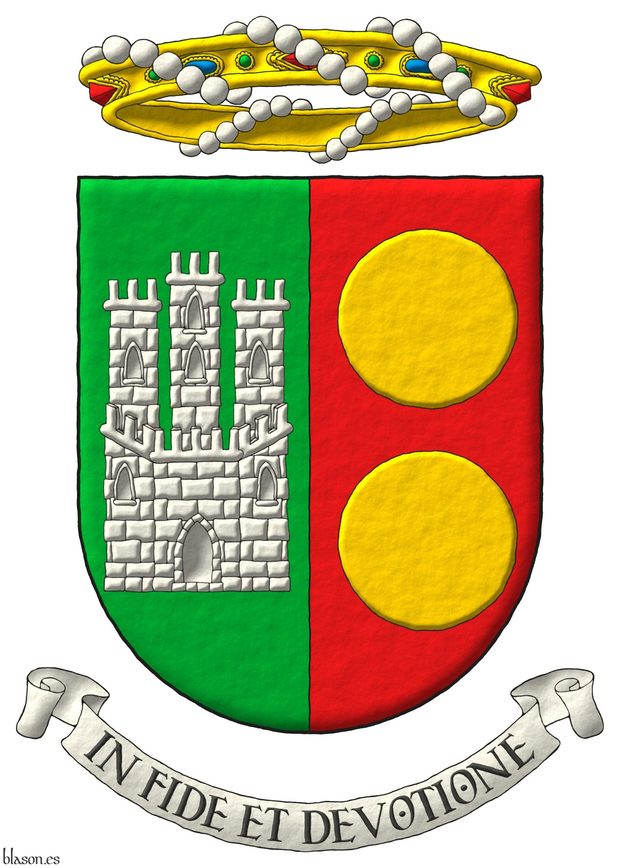
Party per pale: 1 Vert, a Castle triple-towered Argent; 2 Gules, two bezants in pale Or. For crest a crown of baroness. Lema: «In Fide et Devotione».
I have interpreted this coat of arms with a semi-circular shape; metals or, argent, colors vert and gules; outlined with sable; and a freehand finish.
Blazon keywords: Party per pale, Vert, One, Castle, Argent, Gules, Two, Bezant and plate, Bezant, In pale, Crown and Motto.
Style keywords: Semi-circular, Freehand and Outlined in sable.
Classification: Interpreted, Personal and Coat of arms.
Bearer: Giaimo di Prizzi, Carmen.


Castile and León, framed
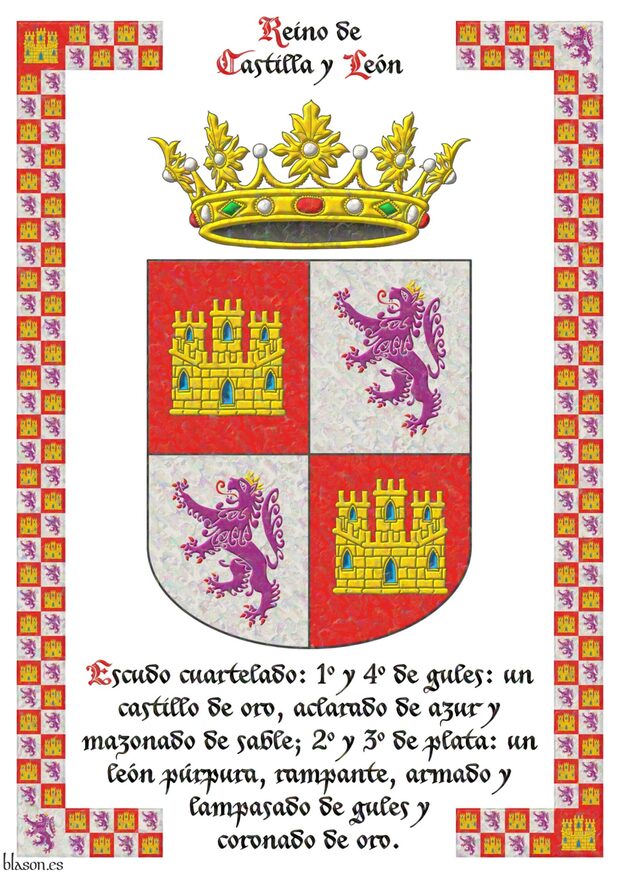
Quarterly: 1 and 4 Gules, a castle triple towered Or, port and windows Azure, masoned Sable; 2 and 3 Argent, a lion rampant Purpure, armed and langued Gules, crowned Or. Crest: An open royal crown Or.
Escudo cuartelado: 1o y 4o de gules, un castillo de oro, aclarado de azur, mazonado de sable; 2o y 3o de plata, un león rampante de púrpura, armado y lampasado de gules, coronado de oro. Timbrado de una corona real abierta.
Arms of the Kingdom of Castile and León created by me as follows: the shield of arms has a rounded (semicircular) base; the quarters are illuminated in flat tinctures Argent and Gules; the castles, lions and crown are illuminated; the lion and its crown are outlined in the colour of the field; the open royal crown; the royal Castilian castle is masoned, that is, outlined in Sable; the whole has an iridescent finish; and the owner, the shield and its blazon are framed within a border representing the arms of the Kingdom, this frame resulting from the combination of 76 small castles and 2 large ones at the corners with 76 small crowned lions and 2 large lions at the other corners;
In the armorial [Urfé; 15th century; page VIII of the index and page 140 of the contents], reference is made to and the arms of Castile and its kings are blazoned in French, describing its castle and its purple lion crowned Or and rampant.
Blazon keywords: Quarterly, Gules, Or, Azure, Sable, One, Castle, Port and windows, Masoned, Argent, Purpure, Lion, Rampant, Armed, Langued, Crowned, Crest, Open royal crown and Crown.
Style keywords: Rounded, Illuminated and Iridescent.
Classification: Interpreted, Civic, Frame, Kingdom of Castile and Leon and Canting.
Bearer: Castile and León.


Cavalry Regiment Alcantara, Laureate of Saint Ferdinand
Grand Laureate Cross of Saint Ferdinand.
Argent, a cross of Alcantara. Crest: A closed royal crown Or, with eight arches, visible five. Behind the shield the Laureate Grand Cross of Saint Ferdinand. Motto: «Hoec nubila tollunt obstantia sicut sol».
Escudo de plata, una cruz de Alcántara. Timbrado de una corona real cerrada. Acolada detrás del escudo la gran cruz laureada de San Fernando. Lema: «Hoec nubila tollunt obstantia sicut sol».
Coat of arms interpreted in the following manner: the shape of the shield is of a semicircular arch; the field is illuminated in metal Argent; the cross of Alcantara, the 4 swords and the 2 laurel branches are outlined in Sable and illuminated in Vert and Gules; the royal crown is closed, outlined in Sable and illuminated with the metal Or, Argent for the pearls, Azure and Or for the orb, Gules and Vert for the gems, Gules for the inner cloth, and Sable for the visible hollow at its base; and the whole has a iridescent finish.
Rif War, July 23, 1921, banks of the Igan River, North Africa
The Alcantara Regiment executed nine successive cavalry charges to protect the infantry's retreat, nine charges until they broke the enemy lines, outnumbering them. The last charge was on foot because all their horses were dead or exhausted. These heroic riders of Alcantara had fulfilled their duty of protecting the wounded infantry in their retreat to El Batel, but the price was appalling: of 691 riders, only 67 survived, and three months were necessary to recover hundreds of corpses.
For this reason, in 2012, the Alcántara Regiment was collectively awarded the Grand Laureate Cross of Saint Ferdinand.
Two lances behind the shield
Since 1987, the coat of arms of the cavalry regiments of the Spanish Army must carry two crossed lances accolade behind the shield. And indeed, this coat of arms of the Alcántara Cavalry Regiment has two lances behind the shield, but in my artistic heraldic interpretation, I did not paint them to avoid detracting from the prominence of the Laureate Cross.
Blazon keywords: Without divisions, Argent, Cross of Alcantara, Cross couped, Cross, Crest, Closed royal crown, Crown, Behind the shield, Four, Sword, Crosswise, Gules, Two, Branch, Laurel, Vert and Motto.
Style keywords: Semi-circular, Illuminated, Outlined in sable and Iridescent.
Classification: Interpreted, Military, Army and Navy and Coat of arms.
Bearer: Alcantara, Cavalry Regiment.


Cavalry Regiment Montesa, royal crown
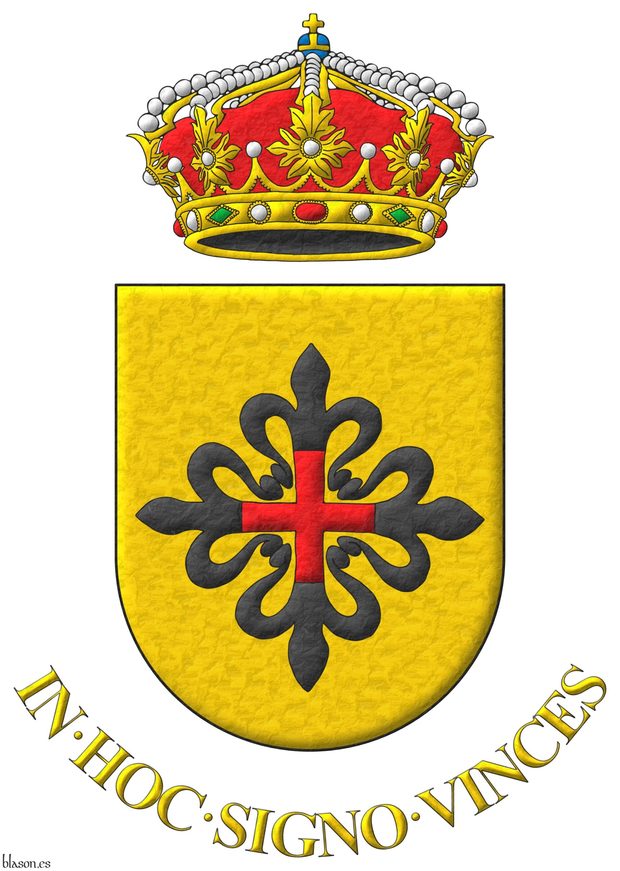
In this sign, you shall conquer.
Argent, a cross of Montesa. Crest: A closed royal crown Or, with eight arches, visible five. Motto: «In hoc signo vinces».
Escudo de oro, una cruz de Montesa. Timbrado de una corona real cerrada. Lema: «In hoc signo vinces».
Coat of arms interpreted as follows: the shape of the shield is a semi-circular arch; the field has been illuminated in metal Or; the cross of Montesa is outlined in Sable and illuminated in Sable and Gules; the royal crown is closed, outlined in Sable and illuminated the metal in Or, the pearls in Argent, the orb in Azure and Or, the gemstones in Gules and Vert, the inner cloth in Gules, and the visible hollow at its base in Sable; and the whole has a slightly beaten metal finish.
Regimental Motto
The Latin motto «In hoc signo vinces» is translated as «In this sign, you shall conquer».
Globus cruciger ~ Orb
It is called orb ~ «globus cruciger», the first in Spanish and the second in Latin, referring to the part of the royal crown, a jewel, or a jewel itself that recreates the shape of the globe topped with a cross.
Blazon keywords: Without divisions, Or, Cross of Montesa, Cross couped, Cross, Crest, Closed royal crown, Crown and Motto.
Style keywords: Semi-circular, Illuminated, Outlined in sable and Soft metal.
Classification: Interpreted, Military, Army and Navy and Coat of arms.
Bearer: Montesa, Cavalry Regiment.


Ceballos of Cantabria, lineage

Argent, three bars Sable; within a bordure countercompony Or and Gules. 2 versions for the same blazon.
Escudo de plata, tres fajas de sable; bordura ajedrezada de oro y gules. 2 versiones para el mismo blasón.
Arms depicted by me, illuminated with lights and shadows, contoured in Sable, with a semi-circular external shape and with a freehand finishing.
Ancient arms of the lineage Ceballos of Cantabria emblazoned by me.
Blazon keywords: Argent, Sable, Or, Gules, Three, Bar, Bordure and Chequey.
Style keywords: Outlined in sable, Illuminated, Semi-circular and Freehand.
Classification: Personal, Interpreted, Boa and Coat of arms.
Bearer: Ceballos of Cantabria, lineage.


Central Military Region
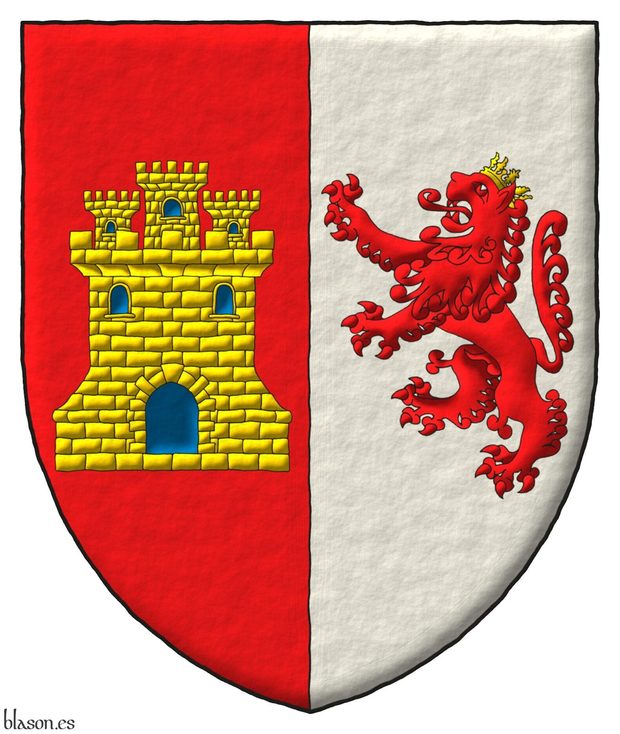
Party per pale: 1 Gules, a castle triple-towered Or, port and windows Azure, and masoned Sable; 2 Argent, a lion rampant Gules, crowned Or.
Coat of arms (1984-1997 and 1997-2002) of the former Central Military Region, where I serve. I interpreted now this coat of arms with a pointed shape. This kind of shape for this coat of arms are not usual.
Blazon keywords: Party per pale, Gules, One, Castle, Or, Port and windows, Azure, Masoned, Sable, Argent, Lion, Rampant and Crowned.
Style keywords: Pointed, Illuminated, Outlined in sable and Metal beaten.
Classification: Interpreted, Military, Army and Navy, Coat of arms and Kingdom of Castile and Leon.
Bearer: Central Military Region.


Cerda, Carlos de la
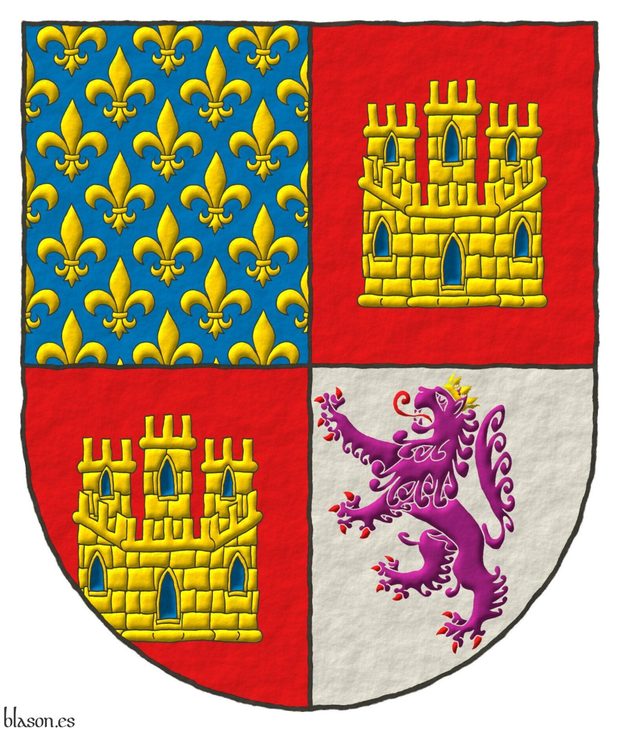
Known in England and France as Charles of Spain ~ Charles d'Espagne.
Quarterly: 1 Azure semé of fleurs de lis Or; 2 and 3 Gules, a castle triple towered Or, the port and windows Azure, masoned Sable; 4 Argent, a lion rampant Purpure, armed and langued Gules, crowned Or.
Coat of arms of Charles de la Cerda (1326-1354), this coat of arms also could be blazoned as «Quarterly: 1, Francia; 2 and 3, Castile; 4, Leon.».
Blazon keywords: Quarterly, Azure, Semé, Fleur de lis, Or, Gules, Castle, Port and windows, Masoned, Sable, Argent, Lion, Purpure, Rampant, Armed, Langued, Crown and Crowned.
Style keywords: Semi-circular, Illuminated, Outlined in sable and Freehand.
Classification: Interpreted, Personal, Army and Navy and Kingdom of France.
Bearer: Cerda, Carlos de la.


Chad Michael Krouse, collage
Coat of arms painted by me, highlighted with lights and shadows, outlined in Sable, with an ogee outer contour and with a texturized finish.
Dr. Chad M. Krouse in his outstanding blog has graciously spotlighted my contributions to the heraldic arts. He beautifully captures the essence of my work and the methodology behind it. I invite you to read the full article at walsinghamwanderings.blogspot.com/2023/09/heraldic-artist-spotlight-dr-antonio.html and also in his blog walsinghamwanderings.blogspot.com you can see my heraldic artwork at the header of walsinghamwanderings.blogspot.com/2023/09/the-man-and-his-arms-origin-story.html. The image shown is a collage composed of elements from his website.
Blazon keywords: Gules, Argent, Azure, Two, One, Party per chevron, Barry, Wavy, In chief, Dogwood flower, Flower, Proper, In base, Cross of Saint Chad, Cross couped, Crest, Head, Erased, Grasping, Beak, Mantling and Motto.
Style keywords: Outlined in sable, Illuminated and Ogee.
Classification: Personal, Interpreted, Boa and Coat of arms.
Bearer: Krouse, Chad Michael.


Charles Dunne, Chas
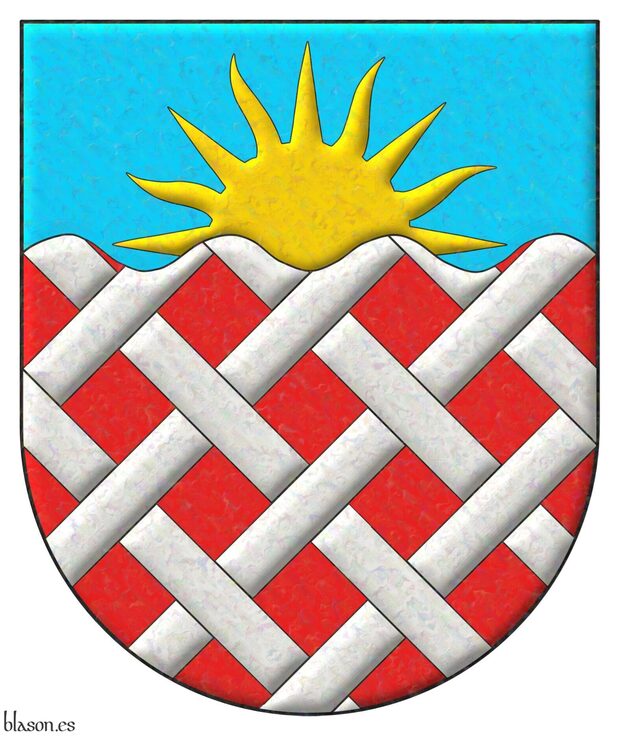
Motto: Stand and Be Counted
Gules fretty Argent; on a chief wavy Bleu celeste, a rising sun Or.
Escudo de gules fretado de plata; en un jefe ondado de celeste, un sol saliente de oro.
Coat of arms interpreted and emblazoned by me with with a semi-circular ended shape, illuminated, and with a iridescent finishing.
The sun used to be emblazoned with a human face, with its eyes, mouth, and nose, but in all the interpretations that I know of this blazon, the sun appears without a human face.
Schema for the fretty
Blazon keywords: Without divisions, Gules, Fretty, Argent, One, Chief, Wavy, Bleu celeste, Sun, Issuant and Or.
Style keywords: Iridescent, Outlined in sable, Illuminated and Semi-circular.
Classification: Interpreted.
Bearer: Charles Dunne, Chas.


Charles V of France
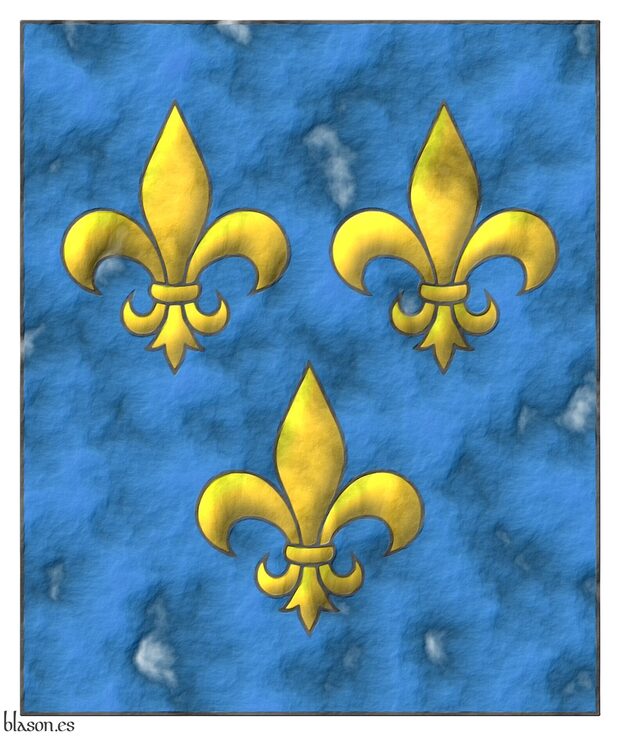
Banner Azure, three fleurs de lis Or.
Pendón de azur, tres flores de lis de oro.
Banner interpreted as follows: rectangular in shape with a 5x6 proportion; the field enamelled in flat Azure; the three fleurs-de-lis illuminated in Or and outlined in Sable; and the whole piece finished with an aged parchment effect.
Starting in 1376, the field sown with fleurs-de-lis was replaced by only three fleurs-de-lis. This change took place during the reign of Charles V of France (1338–1380, King of France from 1364 to 1380).
Edward III Plantagenet (1312–1377, King of England from 1327 to 1377) had incorporated the semé of fleurs-de-lis into his arms as a sign of his claim to the French throne, and Henry IV of England (1367–1413, King of England from 1399 to 1413) again changed the semé into three fleurs-de-lis in his own arms.
These three fleurs-de-lis remained in the royal arms of England until George II (1683–1760, King from 1727 to 1760).
They remained in the royal arms of the French kings until their prohibition during the so-called «Hundred Days», that is, from March 20, 1815, the date of Napoleon’s return to Paris from his exile in Elba, until June 28, 1815, the date of the Second Restoration of Louis XVIII as King of France, when they were reinstated. Finally, after the Revolution of 1830, Louis Philippe I of Orléans decreed their abolition by Order of February 10, 1831.
This banner is a recreation of the one appearing in the armorial [Edward IV of England; 1461; row 23, column 2], although in that armorial the banner seems to be associated with Louis IX of France, perhaps because of the prestige of the saintly King of France, whose arms bore a semé of fleurs-de-lis rather than three.
Blazon keywords: Without divisions, Azure, Or, Three, Fleur de lis and Ordered.
Style keywords: Rectangular, Illuminated, Outlined in sable and Old parchment.
Classification: Interpreted, Personal, Flag, Banner of arms, Kingdom of France and House of Valois.
Bearer: Charles V of France.


Charles VII of France
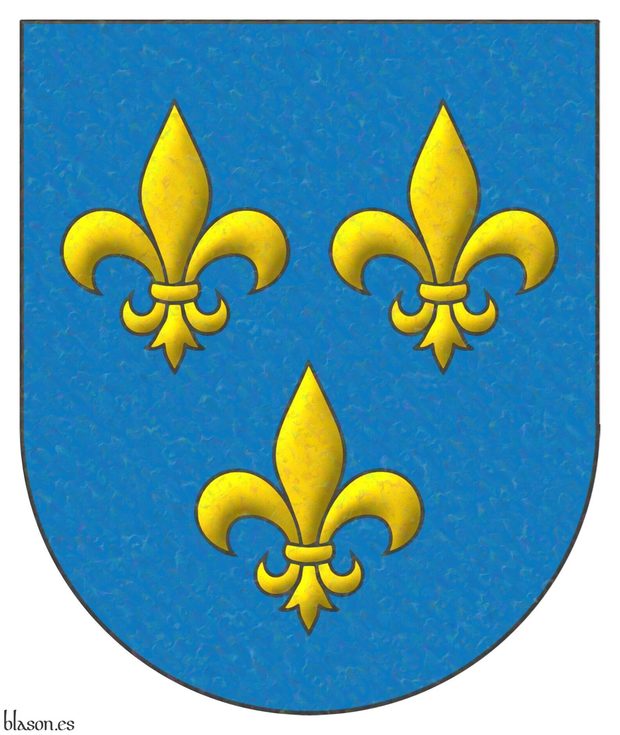
King of France from 1429 to 1461.
Azure, three fleurs de lis Or.
Escudo de azur, tres flores de lis de oro.
Coat of arms interpreted with: a semicircular (round) base; the field enamelled in flat Azure; the fleurs-de-lis illuminated in Or and outlined in Sable; and finished with a mother-of-pearl effect.
This coat of arms is based on the one appearing in the armorial [Ingeram, H.; 1459; page 34, 1st shield], under the inscription «küng von franckrich» (franckrich ~ Frankreich ~ France).
Blazon keywords: Without divisions, Azure, Or, Three, Fleur de lis and Ordered.
Style keywords: Semi-circular, Illuminated, Outlined in sable and Iridescent.
Classification: Interpreted, Personal, Coat of arms, Kingdom of France and House of Valois.
Bearer: Charles VII of France.


City of Haguenau, Alsace
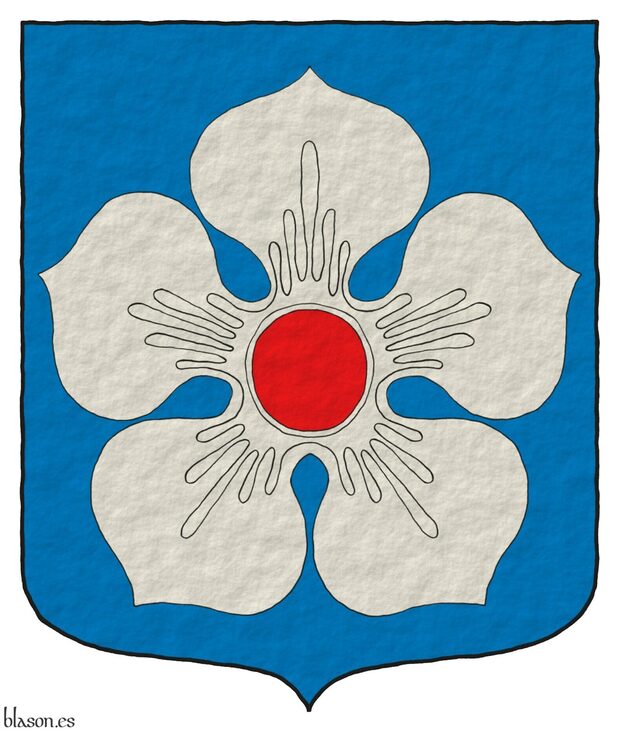
Azure, a cinquefoil Argent, seeded Gules.
Escudo de azur, un quinquefolio de plata, botonado de gules.
Coat of arms emblazoned by me with plain color Azure and metal Or and with a shape ended with an ogee arch.
Blazon keywords: Without divisions, Azure, One, Cinquefoil, Argent, Seeded and Gules.
Style keywords: Outlined in sable, Illuminated and Ogee.
Classification: Interpreted, Lineage, Kingdom of France, Civic and Coat of arms.
Bearer: Haguenau.


Ciudad de Ceuta
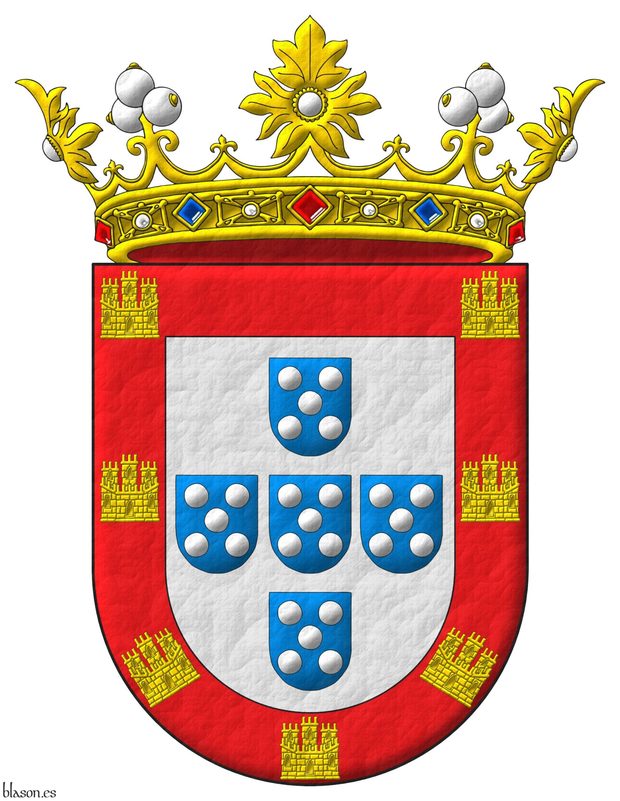
City of Ceuta, Spain, Africa, with a crown of Marquis
Argent, five escutcheons in cross Azure, each charged with five plates in saltire Argent; a bordure Gules, charged with seven castles triple-towered Or, 2, 2, 2, and 1. Crest: A crown of Marquis.
Escudo de plata, cinco escudetes en cruz de azur, cada uno cargado de cinco bezantes en sotuer de plata; una bordura de gules, cargada de siete castillos de oro, dos en jefe, una en cada flanco y tres en punta. Timbrado de una corona de marqués
Illuminated and a leather finishing.
Coat of arms of Ceuta from the coat of arms of Portugal
The Portuguese conquered Ceuta in the year 1415. This event represents an important step in the development of the Portuguese Empire in Africa. Then Ceuta received its arms from those of Portugal but with the castles in another order. In the image, the 1st coat of arms of Portugal, and the 2nd coat of arms of Ceuta.
Blazon keywords: Without divisions, Argent, Five, Escutcheon, In cross, Azure, Charged, Bezant and plate, Plate, In saltire, Bordure, Gules, Seven, Castle, Or, Two, In chief, One, In each flank, Three, In base, Crown of Marquis and Crown.
Style keywords: Leather, Outlined in sable, Illuminated and Semi-circular.
Classification: Civic, Interpreted and Kingdom of Spain.
Bearer: Ceuta.


Clement V
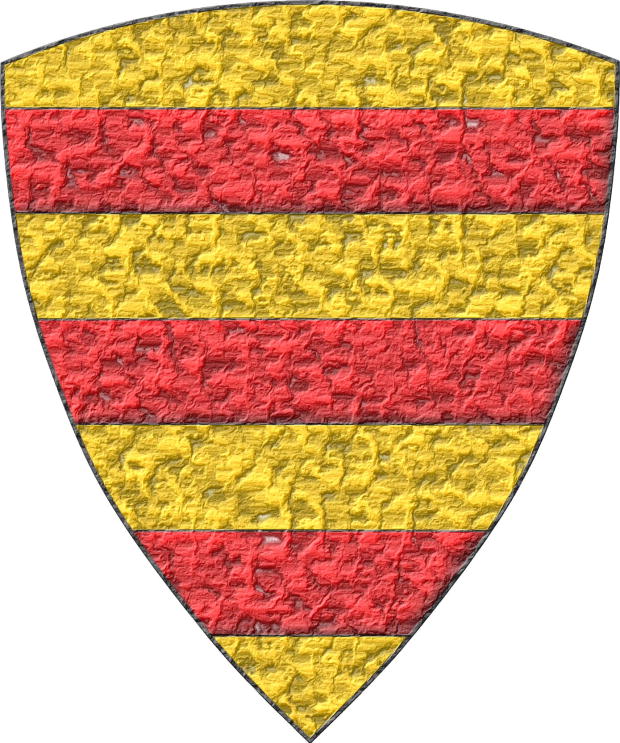
195th Pope of the Church, from 1305 to 1314. «Clemens V», born Bertrand de Got, born in Villandraut, in the southwest of France, was the first pope to reside in Avignon in a stable manner.
Or, three fesses Gules.
Escudo de oro, tres fajas de gules.
Papal coat of arms interpreted with: a rounded triangular top; the field in plain Or enamel; the bars illuminated in Gules and outlined in Sable; and with a heavily hammered metal finish.
Blazon keywords: Without divisions, Or, Three, Fess and Gules.
Style keywords: Triangular curved, Illuminated, Outlined in sable and Hard metal.
Classification: Interpreted, Religious and Papal States.
Bearer: Clement V.
Blazon equivalent to: Fernández de Córdoba y Carrillo, Diego.


Clement XII
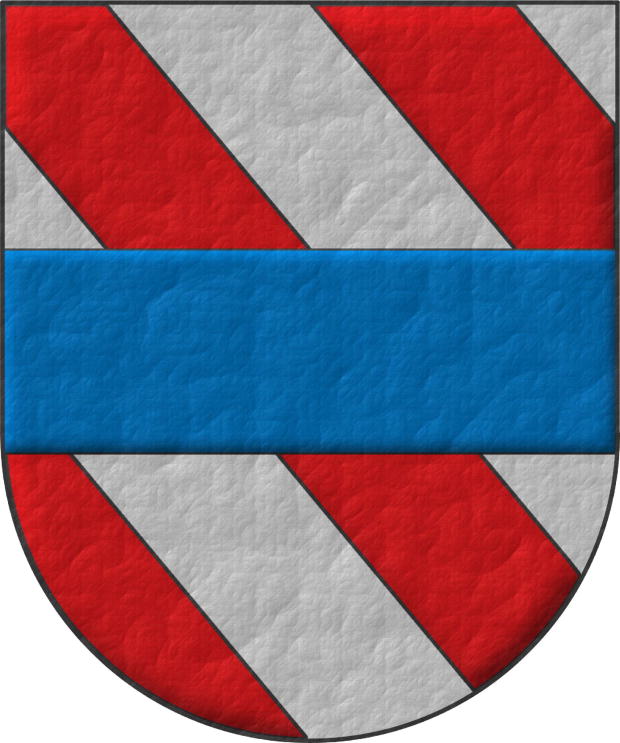
246th Pope of the Church, from 1730 to 1740. «Clemens XII», named Lorenzo Corsini, born in Florence and rests in St. John Lateran.
Bendy of six Gules and Argent; over all a fess Azure.
Escudo bandado de seis piezas de gules y plata; brochante sobre el todo una faja de azur.
Papal coat of arms interpreted with: a rounded mouth; the field in flat tincture of Argent; the fess and the bands outlined in Sable and illuminated in Gules and Azure; and the whole with a textured finish.
All are ordinaries, including the three bands and the fess, and since the blazon specifies that the fess is overall on the bands, therefore, it is not the Gules bands that are overall on the Azure fess, and they should be painted underneath.
Blazon keywords: Without divisions, Bendy, Six, Gules, Argent, Surmounted, Overall (deprecated), One, Fess and Azure.
Style keywords: Semi-circular, Illuminated, Outlined in sable and Freehand.
Classification: Interpreted, Religious and Papal States.
Bearer: Clement XII.


Clermont, Robert of

Grandson of Blanche of Castile, 6th son of Saint Louis IX, founder of the House of Bourbon, husband of Beatrice of Burgundy, Lady of Bourbon.
Azure semé of fleurs de lis Or, a bend Gules.
Escudo de Azur sembrado de flores de lis de oro, banda gules.
Coat of arms that I have interpreted with:: a semicircular (round) base; the field enamelled in flat Azure; the fleurs-de-lys illuminated in Or; the bend illuminated in Gules; the whole is outlined in Sable; and the freehand drawing.
Blazon keywords: Without divisions, Azure, Or, Semé, Fleur de lis, Bend and Gules.
Style keywords: Semi-circular, Illuminated, Outlined in sable and Freehand.
Classification: Interpreted, Personal, Coat of arms, Kingdom of France and House of Bourbon.
Bearer: Clermont, Robert of.


Coat of arms of David Ryan Shorey

Sable, a dolphin naiant Or; a chief embattled Vert, fimbriated Or.
Escudo de sable, un delfín nadante de oro; un jefe almenado de sinople y perfilado de oro.
Blazon keywords: Sable, Dolphin, Naiant, Or, Chief, Embattled, Vert and Fimbriated.
Style keywords: Ogee, Outlined in sable and Plain tincture.
Classification: Personal, Interpreted and Coat of arms.
Bearer: Shorey, David Ryan.


Coat of arms of Fabian Coulot
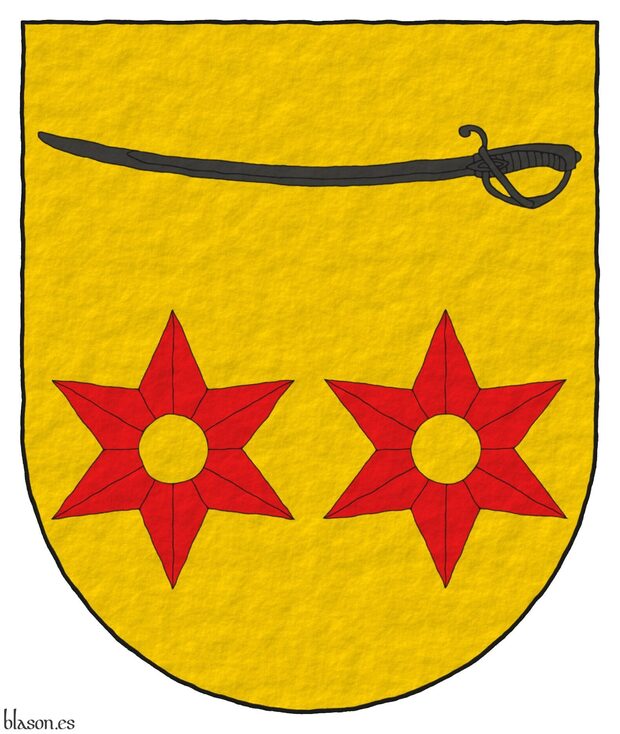
Or, two mullets of six points pierced in fess Gules; in chief a sabre fesswise Sable.
Escudo de oro, dos rosetas de espuela en faja de gules; en jefe, un sable puesto en faja de sable.
Blazon keywords: Or, Two, Mullet of six points pierced, In fess, Gules, In chief, One, Sabre, Sword, Fesswise and Sable.
Style keywords: Outlined in sable, Semi-circular and Plain tincture.
Classification: Personal, Interpreted and Coat of arms.
Bearer: Coulot, Fabian.


Coat of arms of Noelia Yñigo-Genio
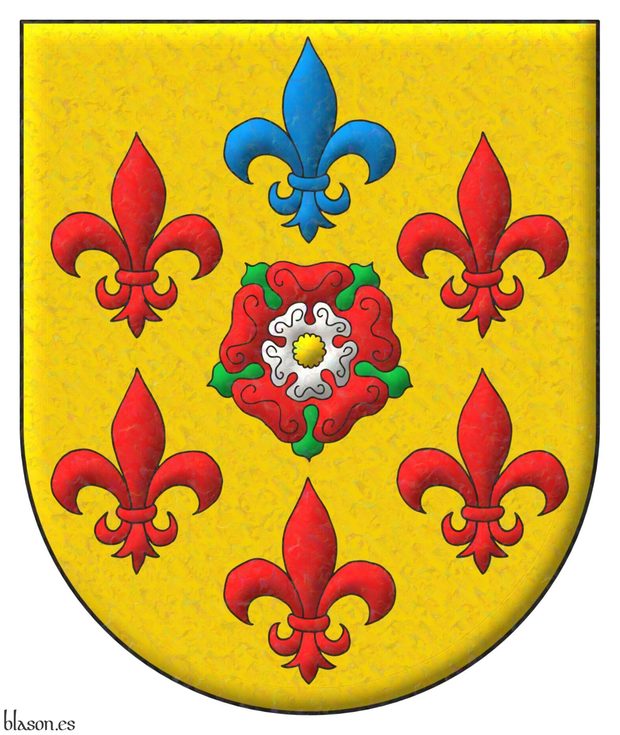
Or, a double rose Gules and Argent, barbed Vert, and seeded Or within six fleurs de lis in orle, five Gules and one in chief Azure.
Escudo de oro, una rosa doble de gules y plata, barbada de sinople y botonada de oro, rodeada de seis flores de lis en orla, cinco de gules y una de azur en jefe.
Credits:
- Rolando Yñigo-Genio is the designer of the coat of arms.
- Antonio Salmerón y Cabañas is the author of the heraldic art.
Blazon keywords: Or, Double rose, Gules, Argent, Barbed, Vert, Seeded, Six, Fleur de lis, Orle, Five, One, Azure and In chief.
Style keywords: Semi-circular, Iridescent, Outlined in sable and Illuminated.
Classification: Interpreted, Personal and Coat of arms.
Bearer: Yñigo-Genio, Noelia.

Colebrand, William de
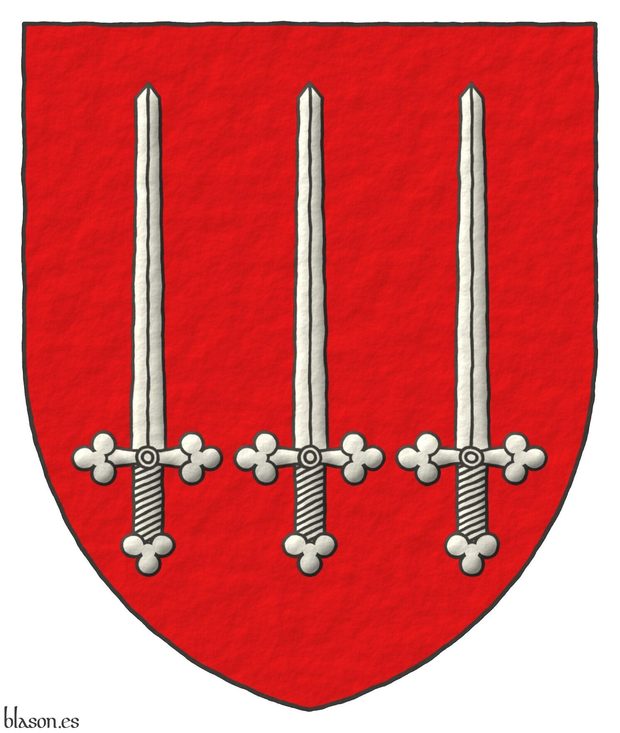
Willame de Colebraund ~ William de Colebrand.
Gules, three Swords Argent, erect, in fess.
Escudo de gules, tres espadas de plata, alzadas, en faja.
Interpreted coat of arms with a free hand finish.
Coat of arms included in [Marshal, L.; 1295; coat of arms number 461], also in [Brault, G. J.; 1997], and time ago in Brian Timms, but not now.
Blazon keywords: Without divisions, Gules, Three, Sword, Argent, Point upwards and In fess.
Style keywords: Pointed, Illuminated, Outlined in sable and Freehand.
Classification: Interpreted and Personal.
Bearer: Colebrand, William de.


Commoners' certification for Kathleen Kane
Argent, four leaves of silver-leaved whitebeam (Sorbus Aria Lutescens) in saltire, stems interlaced Vert, on a chief Gules, three crosses of Saint Brigid Argent. Motto: «Family is Everything» Sable, with initial letters Gules, over a scroll Argent.
Classification: Personal, Interpreted, Certification, Heraldic document and English language.
Bearer: Kane, Kathleen.


Commoners' certification Francisco Domingo Larrosa Gil
Gules, a rose between in chief a key wards to dexter facing downwards, in base a key wards to sinister facing downwards Argent
The Commoners' Certification of Arms for Francisco Domingo Larrosa Gil with his coat of arms emblazoned by me. Alternative blazon used in the certification: Gules, a rose between two keys fesswise Argent, that in chief with wards to dexter, that in base with wards to sinister.
Blazon keywords: Gules, Argent, One, Rose, Between, In chief, Key, Dexter, Point upwards, In base, Point downwards and Sinister.
Style keywords: Outlined in sable, Illuminated and Semi-circular.
Classification: Personal, Interpreted, Boa, Certification and Heraldic document.
Bearer: Larrosa Gil, Francisco Domingo.


Commoners' certification László Gábor
Per fess, the base per pale: 1 Or, an eagle displayed Sable; 2 Gules, a sun in splendour Or; 3 Or, an increscent Gules; all within a bordure Sable, charged with eight fleurs de lis Or. Motto: «Virtus Nobilitatis Fidelitas» Sable, with initial letters Gules over a scroll Argent.
The Commoners' Certification of Arms for Vitéz László Gábor from Hungary with his coat of arms designed by him and emblazoned by me.
Blazon keywords: Or, Sable, Gules, Argent, One, Eight, Party per fess, the base per pale, Eagle, Displayed, Sun in splendour, Increscent, Bordure, Fleur de lis, Motto and Scroll.
Style keywords: Outlined in sable, Illuminated and Pointed.
Classification: Personal, Interpreted, Boa, Certification and Heraldic document.
Bearer: László Gábor.


Correa, Lorena
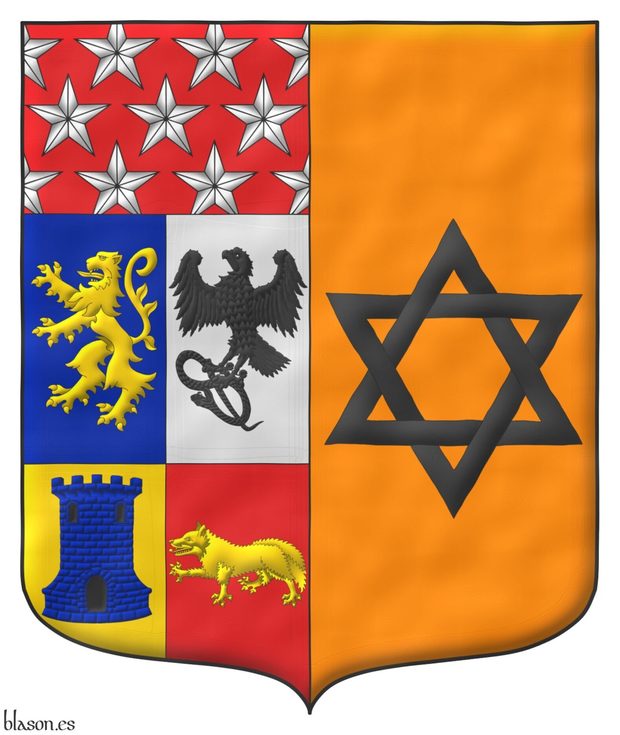
Party per pale: 1 quarterly: 1 Azure, a lion rampant Or, 2 Argent, a falcon rising, grasping in its paws a serpent Sable, 3 Or, a tower Azure, port, windows, and masoned Sable, 4 Gules, a fox passant Or, a chief Gules semé of mullets Argent; 2 Orange, a mullet of six points voided, interlaced Sable.
Escudo partido: 1o cuartelado: 1o de azur, un león rampante de oro, 2o de plata, un halcón azorado, teniendo en sus garras una sierpe ambos de sable, 3o de oro, una torre de azur, aclarada y mazonada de sable, 4o de gules, un zorro pasante de oro, un jefe de gules sembrado de estrellas de cinco puntas de plata; 2o de naranjado, una estrella de seis puntas, hueca y entrelazada de sable.
Coat of arms emblazoned by me with a shape ended with an ogee arch, illuminated, and its finishing is that seems watercolor.
Blazon keywords: Party per pale, Quarterly, Azure, One, Lion, Rampant, Or, Argent, Falcon, Rising, Grasping, Claw, Serpent, Sable, Tower, Port and windows, Masoned, Gules, Fox, Passant, Chief, Semé, Mullet, Five, Base (lower 1/3), Orange, Six, Voided and Interlaced.
Style keywords: Ogee, Outlined in sable, Illuminated and Watercolor.
Classification: Personal, Interpreted and Coat of arms.
Bearer: Correa, Lorena.


Crepsi

Party per pale: 1 Gules, in base a castle triple-towered Or, port and windows Azure, and masoned Sable; 2 Argent, in base a lion rampant Gules, crowned Or; overall a psi letter sable; a diminished bordure Or.
Escudo partido: 1o de gules, en punta un castillo de oro, aclarado de azur y mazonado de sable; 2o de plata, en punta un león rampante de gules, coronado de oro; brochante sobre la partición una letra psi de gules; una filiera de oro.
Coat of arms emblazoned by me, illuminated with lights and shadows, outlined in Sable, with a semi-circular outer contour and with a iridescent finishing.
Coat of arms of Crepsi, military psychology, former Central Military Region, Kingdom of Spain, where I was stationed during my military service. These arms were designed by my lieutenant colonel and friend Miguel Angel Nuñez Amador, and in this image, they have been emblazoned by me. The Crepsi was a pioneer in its functions: a) the identification of soldiers at psychological risk, among tens of thousands of soldiers, using advanced information systems, including Artificial Intelligence (an area where I contributed during my service in 1989), and b) the evaluation and individualized attention of soldiers at risk through mobile units. The Crepsi has provided trained personnel and methods that are being used for the psychological care of troops deployed to conflict zones and for the psychological care of civilians in massive humanitarian disasters such as terrorist attacks or plane crashes with hundreds of affected people.
Design rationale
The psi letter of psychology and the arms of the Central Military Region: Party per pale: 1 Gules, a castle triple-towered Or, port and windows Azure, and masoned Sable; 2 Argent, a lion rampant Gules, crowned Or. These two fields, in turn, Gules and Argent, charged with a castle triple-towered and a crowned lion, originate from the Kingdom of Castile and León. The diminished bordure is for difference.
Blazon keywords: Gules, Argent, Or, Azure, Sable, Party per pale, In base, Castle, Triple-towered, Port and windows, Masoned, Lion, Rampant, Crowned, Overall, Letter and Diminished bordure.
Style keywords: Outlined in sable, Illuminated, Semi-circular and Iridescent.
Classification: Military, Interpreted, Design rationale, Boa and Coat of arms.
Bearer: Crepsi.


Crest and mantling of Antonio Ruiz Porras
Quarterly: 1 Argent, a dolphin haurient Azure; 2 Azure, a sunflower Or; 3 Azure, on a closed book Or a diamond Azure; 4 Argent, a lark Azure. Crest: Upon a helm with a wreath Argent and Azure a quetzal perched in a tree branch proper, leaved Or. Mantling: Azure doubled Argent.
Coat of arms depicted by me, highlighted with lights and shadows, contoured in Sable, with a semi-circular outer contour and with a watercolor finish.
Blazon keywords: Argent, Azure, Or, One, Quarterly, Dolphin, Haurient, Sunflower, Closed book, Book, Charged, Diamond, Lark, Crest, Upon (wreath), Helm, Wreath, Quetzal, Perched, Tree, Branch, Proper, Leaved and Mantling.
Style keywords: Outlined in sable, Illuminated, Semi-circular and Watercolor.
Classification: Personal, Interpreted, Boa and Coat of arms.
Bearer: Ruiz Porras, Antonio.


Crest and mantling of Dario Postolovski
Azure, two quills in saltire Argent, in chief an ancient coronet Or. Crest: Upon a helm with a wreath Or and Azure, a demi-lynx regardant Or, caped Azure, maintaining in dexter a lantern Azure, enflamed proper. Mantling: Azure doubled Or.
Coat of arms emblazoned by me, illuminated with lights and shadows, outlined in Sable, with an ogee external shape and with a leather finish.
The coat of arms of Dario Postolovski, Macedonia, emblazoned by me. The blazon in French, translated by Michel Froger, is as follows: «D’azur à deux plumes d’argent posées en sautoir et surmontées d’une couronne antique d’or à 5 pointes. L’écu est timbré d’un casque d’argent taré de trois quart et de lambrequins d’or et d’azur. Le casque est sommé d’un tortil d’or et d’azur soutenant un lynx d’or issant et regardant, vêtu d’une cape d’azur et tenant une lanterne du même allumée au naturel».
Blazon keywords: Azure, Argent, Or, Two, One, Quill, In saltire, In chief, Ancient coronet, Crown, Crest, Upon (wreath), Helm, Wreath, Demi, Lynx, Regardant, Caped, Grasping, Dexter, Lantern, Enflamed, Proper and Mantling.
Style keywords: Outlined in sable, Illuminated, Ogee and Leather.
Classification: Personal, Interpreted, Boa and Coat of arms.
Bearer: Postolovski, Dario.


Crest and mantling of Isadora von Haimb
Argent, a rose Gules, barbed Vert; a bordure Azure. Crest: Dexter, upon a helm, issuant from an ancient coronet Or, a dove Argent, holding in its beak an olive branch Vert; and sinister, upon a helm, issuant from an ancient coronet Or, an arm proper, vambraced Argent, grasping a sabre Argent, between a pair of wings per fess alternately Azure and Argent. Mantling: Dexter Gules doubled Argent, sinister Azure doubled Argent.
Arms emblazoned by me, illuminated with lights and shadows, contoured in Sable, with a semi-circular outer contour and with a watercolor finish.
Blazon keywords: Argent, Gules, Vert, Azure, Sable, One, Two, Rose, Barbed, Bordure, Crest, Dexter, Helm, Issuant, Ancient coronet, Crown, Dove, Grasping, Beak, Olive tree, Tree, Branch, Sinister, Arm, Vambraced, Sabre, Sword, Between, Wing, Party per fess, Alternately, Mantling and Doubled.
Style keywords: Outlined in sable, Illuminated, Semi-circular and Watercolor.
Classification: Personal, Interpreted, Boa and Coat of arms.
Bearer: von Haimb, Isadora.


Crest and mantling of Jan Bobor
Gules, a beaver erect Or, armed and tailed Argent, bearing on his dexter shoulder a sword Argent, hilted Or; on a chief embattled of Renaissance crenellations Or three fleurs de lis Azure. Crest: Upon a helm with a wreath Or, Azure, and Gules a beaver issuant, crowned and winged Or, armed and tailed Argent, holding a pole Or flying a long swallow-tailed flag per fess Azure and Gules, overall a double cross patty fitchy Or. Mantling: On the dexter Azure doubled Or and on the sinister Gules doubled Or.
Arms interpreted by me, illuminated with lights and shadows, contoured in Sable, with an ogee external shape and with a watercolor finish.
Canting arms of Jan Bobor, Slovakia, emblazoned under his directions.
Blazon keywords: Gules, Or, Argent, Azure, One, Three, Beaver, Erect, Armed, Tailed, Grasping, Dexter, Shoulder, Sword, Hilted, Chief, Embattled, Fleur de lis, Crest, Helm, Wreath, Issuant, Crowned, Winged, Swallow-tail, Party per fess, Overall, Patriarchal cross, Cross couped, Patty, Fitchy, Mantling, Doubled and Sinister.
Style keywords: Outlined in sable, Illuminated, Ogee and Watercolor.
Classification: Personal, Interpreted, Boa, Coat of arms, Pennon and Flag.
Bearer: Bobor, Jan.


Crest and mantling of Lory Santiago-Vazquez
Party per fess wavy: 1 Azure, a dolphin naiant; 2 Argent, three escallops Azure. Crest: Upon a helm lined Azure with a wreath Argent and Azure, an owl Tenné, armed, beaked, membered, the eyes, and wearing a necklace with a pendant heart Or, grasping with its dexter foot a bluebonnet proper. Mantling Azure doubled Argent.
Coat of arms painted by me, highlighted with lights and shadows, contoured in Sable, with a semi-circular outer contour and with a leather finish.
Blazon keywords: Azure, Argent, One, Three, Or, Party per fess, Wavy, Dolphin, Naiant, Escallop, Crest, Upon (wreath), Helm, Lined, Wreath, Owl, Tenné, Armed, Beaked, Membered, The eyes, Collar, Heart, Grasping, Dexter, Talon, Bluebonnet, Flower, Proper, Mantling and Doubled.
Style keywords: Outlined in sable, Illuminated, Semi-circular and Leather.
Classification: Personal, Interpreted, Boa and Coat of arms.
Bearer: Santiago-Vazquez, Lory.


Crest and mantling of Marilena Marinanza
Gules, three bars wavy; in chief two mullets above a fess in base Or. Crest: Upon a helm, befitting her degree, with a wreath Or and Gules, a crown of Noble. Mantling: Gules doubled Or.
Arms interpreted by me, illuminated with lights and shadows, outlined in Sable, and with a watercolor finish.
Blazon keywords: Gules, Or, Three, Two, One, Bar, Wavy, In chief, Mullet, Above, Fess, In base, Crest, Upon (wreath), Helm, Wreath, Crown of Noble, Crown and Mantling.
Style keywords: Outlined in sable, Illuminated and Watercolor.
Classification: Personal, Interpreted, Boa and Coat of arms.
Bearer: Marinanza, Marilena.


Crest and mantling of Mark Antony Hatsis
Or, a peacock’s head erased Azure, beaked Argent, between in dexter an increscent Azure and in sinister a rose Azure, barbed and seeded Argent. Crest: Upon a helm with a wreath Or and Azure, a peacock in his splendour proper. Mantling: Azure doubled Or.
Coat of arms interpreted by me, illuminated with lights and shadows, contoured in Sable, with an ogee outer contour and with a leather finish.
Blazon keywords: Or, Azure, Argent, One, Peacock, Head, Erased, Beaked, Dexter, Increscent, Sinister, Rose, Barbed, Seeded, Crest and mantling, Crest, Upon (wreath), Helm, Wreath, In his splendour and Mantling.
Style keywords: Outlined in sable, Illuminated, Ogee and Leather.
Classification: Personal, Interpreted, Boa and Coat of arms.
Bearer: Hatsis, Mark Antony.


Crest and motto of Marie Unicorn Sparkles

Party per chevron Azure semé of unicorns passant, and Argent, a rainbow throughout proper. Crest: Upon a wreath Argent and Azure a demi-unicorn Azure, horned, crined and semé of mullets Or. Motto: «Live your Magic».
Credits: SkyL.designer and Antonio Salmerón y Cabañas is the author of the heraldic art.
Blazon keywords: Azure, Party per chevron, Argent, In chief, One, Semé, Unicorn, Passant, In base, Rainbow, Throughout, Proper, Wreath, Crest, Demi, Horned, Crined, Mullet, Or and Motto.
Style keywords: Outlined in sable, Pointed, Illuminated and Leather.
Classification: Personal, Interpreted, Coat of arms and English language.
Bearer: Sparkles, Marie Unicorn.


Crest and mottos of Guy Harold Power
Argent, two arrows points upwards in saltire Sable, barbed and feathered Gules, surmounted of a commando dagger point upwards in pale Gules, hilted and pommelled Sable; on a chief indented Sable, a label of three points Or. Crest: Upon a helm with a wreath Argent and Sable, a demi-man proper, wearing a beret Vert, grasping in his dexter hand a commando dagger point upwards Or, hilted and pommelled Sable. Mantling: Sable doubled Argent. Motto: «Liberare oppressos». Motto above the crest: «Follow me».
Blazon keywords: Argent, Two, Arrow, Point upwards, In saltire, Sable, Barbed, Feathered, Gules, Surmounted, One, Dagger, In pale, Hilted, Pommelled, Chief, Indented, Label of three points, Or, Crest and mantling, Helm, Mantling, Wreath, Crest, Male figure, Demi, Proper, Beret, Vert, Grasping, Hand, Dexter and Motto.
Style keywords: Pointed, Outlined in sable, Illuminated and Freehand.
Classification: Personal, Interpreted, Coat of arms, Latin language and English language.
Bearer: Power, Guy Harold.


Crest of Elijah Reyes
Azure, a bend sinister raguly between, in dexter chief, a Celtic cross, in sinister base, a sword point downwards Argent. Crest: Upon a helm affronty with a wreath Argent and Azure, a pair of Polish hussar wings, feathered alternately Azure and Argent. Mantling: Azure doubled Argent.
Blazon keywords: One, Bend sinister, Raguly, Between, Dexter, Chief, Celtic cross, Sinister, Base (lower 1/3), Sword, Point downwards, Argent, Crest and mantling, Helm, Mantling, Wreath, Crest, Polish winged hussar, Two wings in vol, Feathered and Alternately.
Style keywords: Outlined in sable, Semi-circular, Illuminated and Rough.
Classification: Personal, Interpreted and Coat of arms.
Bearer: Reyes, Elijah.


Crest of Herbert Leo Buffenbarger
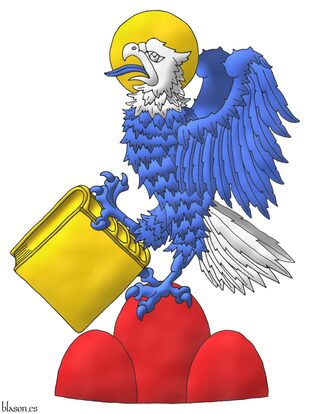
Upon a trimount Gules, an eagle wings addorsed and inverted Azure, the head and tail Argent, nimbed Or, grasping a closed book also Or.
Heraldic device emblazoned by me, illuminated with lights and shadows, outlined in Sable, and with a watercolor finish.
The crest of the coat of arms of Herbert Leo Buffenbarger, designed by his son John Alan Francis Buffenbarger, and emblazoned by me.
Blazon keywords: Crest, Argent, Azure, Gules, Or, One, Three, Upon, Trimount, Eagle, Wing, Addorsed, Head, Tail, Nimbed, Grasping, Closed book and Book.
Style keywords: Outlined in sable, Illuminated and Watercolor.
Classification: Personal, Interpreted and Boa.
Bearer: Buffenbarger, Herbert Leo.


Crest of Sean Shriner with wreath
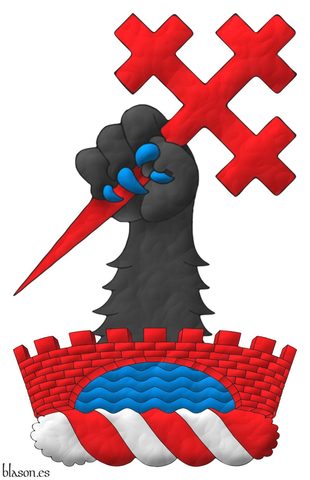
Upon a wreath Argent and Gules, issuant from a bridge, enarched, embattled Gules, masoned Sable above a river Azure, a bear’s forepaw Sable, armed Azure, grasping a cross crosslet fitchy bendwise sinister Gules.
Heraldic device painted by me, highlighted with lights and shadows, outlined in Sable, with a pointed external shape and with a leather finishing.
Blazon keywords: Crest, Argent, Gules, Sable, Azure, Upon (wreath), Wreath, Issuant, Enarched, Bridge, Embattled, Masoned, Above, River, Forepaw, Grasping, Cross fitchy, Cross couped and Bend sinisterwise.
Style keywords: Outlined in sable, Illuminated, Pointed and Leather.
Classification: Personal, Interpreted and Boa.
Bearer: Shriner, Sean.


Crest of the Lineage Rawson
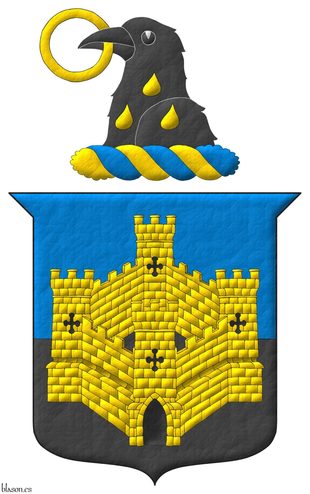
Party per fess Azure and Sable, overall a four-towered castle Or, port and windows Sable. Crest: Upon a wreath Or and Azure, a raven's head Sable, charged upon the neck with three gouttes, 1 and 2, and holding in its beak an annulet Or.
Arms interpreted by me, highlighted with lights and shadows, outlined in Sable, with an ogee triple-pointed outer contour and with a leather finish.
Blazon keywords: Azure, Sable, Or, One, Party per fess, Overall, Four-towered, Castle, Port and windows, Crest, Wreath, Raven, Head, Charged, Neck, Grasping, Beak and Annulet.
Style keywords: Outlined in sable, Illuminated, Ogee Triple-Pointed and Leather.
Classification: Personal, Lineage, Interpreted, Boa and Coat of arms.
Bearer: Rawson, Lineage.


Crest of Tim Wilkins
Party per bend sinister Or and Gules, a clenched gauntlet Sable. Crest: Upon a helm, with a wreath Or and Gules, a peacock in his splendour proper, on a coronet trefoiled Or. Mantling: Gules doubled Or.
Blazon keywords: Party per bend sinister, Or, Gules, Surmounted, Gauntlet, Sable, Palewise, Crest and mantling, Helm, Mantling, Wreath, Crest, Coronet trefoiled, Ancient coronet, Crown, Trefoiled, Peacock, In his splendour and Proper.
Style keywords: Pointed, Outlined in sable, Illuminated and Rough.
Classification: Personal, Interpreted and Coat of arms.
Bearer: Wilkins, Tim.


Crest of Yuri Alexander Altnau
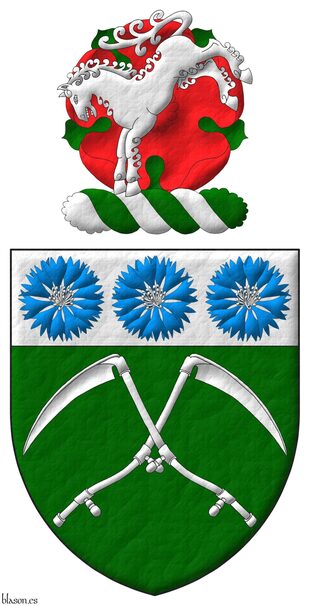
Vert, two scythes in saltire Argent; on a chief Argent, three cornflowers Azure, seeded Argent. Crest: Upon a wreath Argent and Vert, a horse kicking Argent in front of a rose Gules, barbed Vert.
Arms depicted by me, highlighted with lights and shadows, contoured in Sable, with a pointed external shape and with a leather finishing.
The coat of arms of Yuri Alexander Altnau designed by him and by Christopher Altnau, and emblazoned by me.
Blazon keywords: Vert, Argent, Azure, Gules, One, Three, Scythe, In saltire, Chief, Cornflower, Flower, Seeded, Crest, Upon (wreath), Wreath, Rose, Barbed, Debruised, Horse and Kicking.
Style keywords: Outlined in sable, Illuminated, Pointed and Leather.
Classification: Personal, Interpreted, Boa and Coat of arms.
Bearer: Altnau, Yuri Alexander.


Crown and motto of Yaroslav Pototsky
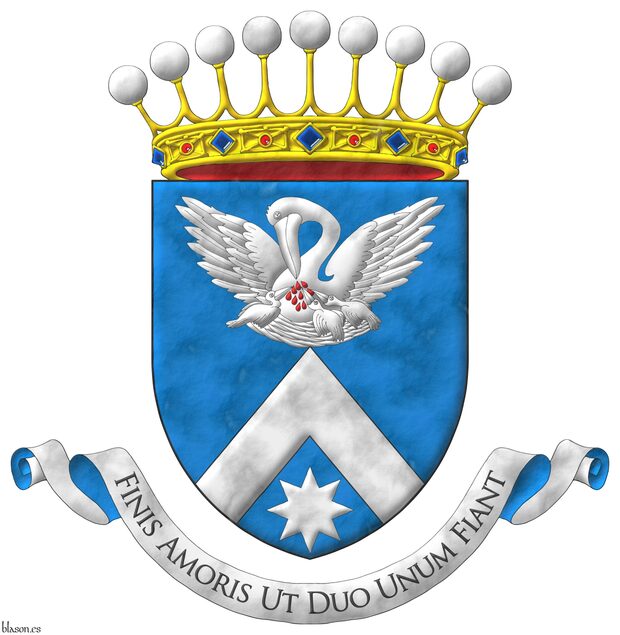
Azure, a chevron in base ensigned by a pelican in her piety Argent, vulned Gules, in base a mullet of eight points Argent. Crest: a crown of Count. Motto: «Finis amoris ut duo unum fiant» Sable over a scroll Argent doubled Azure.
Coat of arms interpreted by me, illuminated with lights and shadows, outlined in Sable, with a pointed outer contour and with a parchment finishing.
Blazon keywords: Azure, Argent, Gules, Sable, One, Chevron, In base, Pelican in her piety, Pelican, Vulned, Mullet, Crest, Crown of Count, Crown, Motto and Doubled.
Style keywords: Outlined in sable, Illuminated, Pointed and Parchment.
Classification: Personal, Interpreted, Boa and Coat of arms.
Bearer: Pototsky, Yaroslav.


Crown of Castilla-La Mancha

Party per pale: 1 Gules, a castle triple-towered Or, port and windows Azure, masoned Sable; 2 Argent. Crest: A closed royal crown Or.
Coat of arms emblazoned by me, highlighted with lights and shadows, contoured in Sable, with an ogee external shape and with a freehand finishing.
Design rationale
The coat of arms of Castilla-La Mancha was adopted in 1983, it is a recent design. This coat of arms is equal to the flag of Castilla-La Mancha officially approved in 1980 and designed by Ramón José Maldonado y Cocat. The 1st quarter represents Castilla and the 2nd quarter the great plane of La Mancha.
Blazon keywords: Gules, Argent, Or, Azure, Sable, One, Party per pale, Castle, Triple-towered, Port and windows, Masoned, Crest, Closed royal crown and Crown.
Style keywords: Outlined in sable, Illuminated, Ogee and Freehand.
Classification: Civic, Interpreted, Design rationale, Boa and Coat of arms.
Bearer: Castilla-La Mancha.


Crown of Gozo
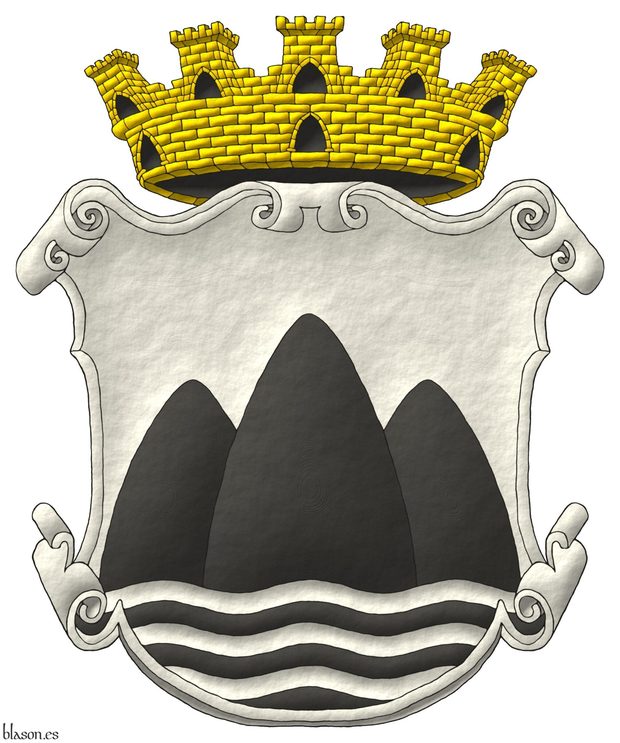
Argent, upon a base barry wavy of six Argent and Sable, a trimount Sable. Crest: A mural crown Or.
Arms emblazoned by me, highlighted with lights and shadows, contoured in Sable, and with a freehand finish.
Blazon keywords: Argent, Sable, One, Six, Upon, Base, Barry, Wavy, Trimount, Crest, Mural crown and Crown.
Style keywords: Outlined in sable, Illuminated, Bull's hide and Freehand.
Classification: Civic, Interpreted, Boa and Coat of arms.
Bearer: Gozo.


Crown of Graziano Alu

Party per pale: 1 Or, a Georgian dancer proper; 2 Gules, a church Or, ports and windows Azure. Crest: A crown of Baron.
Coat of arms emblazoned by me, highlighted with lights and shadows, outlined in Sable, with an ogee external shape and with a watercolor finishing.
Coat of arms of Graziano Alu designed by Angelo Musa and emblazoned by me. The blazon in Italian is «Arma: Partito: 1o d'oro, un ballerino georgiano al naturale; 2o di rosso, una chiesa d'oro, finestrata e portata d'azzurro. Cimiero: Una corona di barone».
Blazon keywords: Or, Gules, Azure, One, Party per fess, Male figure, Proper, Church, Port and windows, Crest, Crown of Baron and Crown.
Style keywords: Outlined in sable, Illuminated, Ogee and Watercolor.
Classification: Personal, Interpreted, Boa and Coat of arms.
Bearer: Alu, Graziano.


Crown of the Infanta Berenguela of Castile

Quarterly: 1 and 4 Gules, a castle triple-towered Or, port and windows Azure, and masoned Sable; 2 and 3 Argent, a lion rampant Purpure, armed and langued Gules; a bordure compony of sixteen sections: eight Gules, a castle triple-towered Or, port and windows Azure, and masoned Sable, eight Or, an eagle displayed Sable. Crest: An open royal crown.
Arms emblazoned by me, illuminated with lights and shadows, contoured in Sable, with an ogee external shape and with a metal beaten finish.
Coat of arms of the Infanta Berenguela of Castile, 1228–1279, 5th daughter of the King Ferdinand III of Castile, 1199-1252, and the Queen Beatrice of Swabia, 1205–1235. The coat of arms of Infanta Berenguela of Castile, besides being beautiful, has always seemed to me the epitome of the Castilian arms: quartered, bearing Leon and Castile, and surrounded by a bordure compony with castles. This coat of arms has been emblazoned by me.
Blazon keywords: Gules, Or, Azure, Sable, Argent, Purpure, One, Sixteen, Eight, Quarterly, Castle, Triple-towered, Port and windows, Masoned, Lion, Rampant, Armed, Langued, Bordure, Compony, Eagle, Crest, Open royal crown and Crown.
Style keywords: Outlined in sable, Illuminated, Ogee and Metal beaten.
Classification: Personal, Kingdom of Castile and Leon, Interpreted, Boa and Coat of arms.
Bearer: Berenguela of Castile, Infanta.


Crown of the Marquis Prato di Arnesano

Or, three pallets Vair. Crest: A crown of Marquis.
Coat of arms depicted by me, illuminated with lights and shadows, outlined in Sable, with an ogee external shape and with a freehand finishing.
The coat of arms of the Marquis Prato di Arnesano, requested by Andrea Tamburelli Lanzara and painted by me.
Blazon keywords: Or, Three, Pale, Vair, Crest, Crown of Marquis and Crown.
Style keywords: Outlined in sable, Illuminated, Ogee and Freehand.
Classification: Personal, Interpreted, Boa and Coat of arms.
Bearer: Prato di Arnesano, Marquis.


Csernely
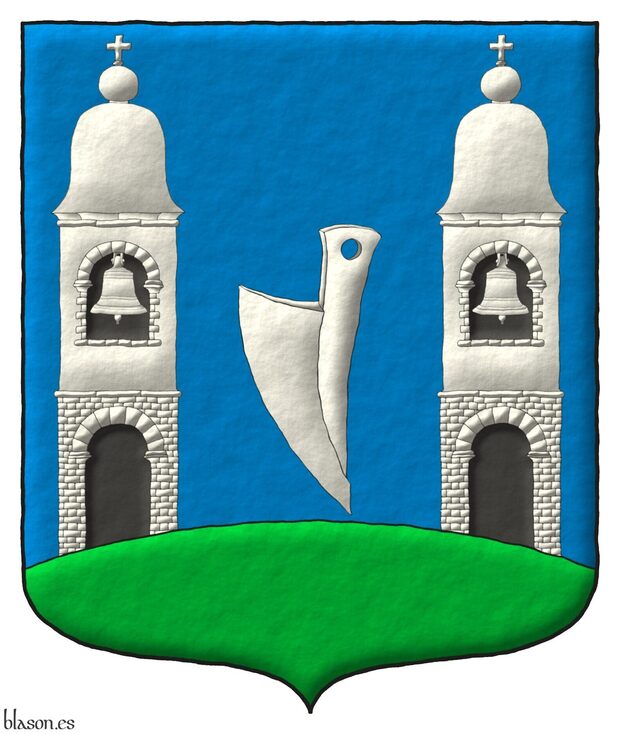
Azure, a plough share points downward Argent between, on a base enarched Vert, two bell towers Argent, port and window Sable.
Escudo de azur, una reja de arado bajada de plata acompañada de dos campanarios de plata, aclarados de sable, terrazados de sinople.
Coat of arms emblazoned by me with a shape endend with an ogee arch, illuminated, and with a freehand finishing.
Csernely is a village in Borsod-Abaúj-Zemplén county in Hungary.
The official description, not the blazon, is: «...in the blue field of a shield standing on its snout two silver-coloured church towers with onion-shaped cupolas and crosses on their peaks are rising on a green hill. Between them a silver ploughshare is floating with its point upside down...».
The official description use the word «hagymakupolás» in Hungarian. The official text is «Csernely címere: Csücsköstalpú pajzs kék mezejében zöld halmon két ezüst színu, hagymakupolás templomtorony emelkedik, ...», but the cupolas painted by them do not seem the classic «onion-shaped cupolas».
Notice the mount color Vert over a field color Azure, not uncommon in this heraldic tradition.
Blazon keywords: Azure, One, Plough share, Point downwards, Argent, Between, Two, Bell tower, Port and windows, Sable, Terrace in base and Vert.
Style keywords: Ogee, Outlined in sable, Freehand and Illuminated.
Classification: Civic, Interpreted and Coat of arms.
Bearer: Csernely.


Daubeny, Rauf

Ralph de Albini (XIII century) ~ Rauf de Albini.
Gules, a fess of five fusils Argent.
Escudo de gules, una faja de cinco fusos de plata.
Coat of arms interpreted with: the semicircular base shape; the field illuminated in Gules; the fusils illuminated in metal Argent, outlined in Sable; the fess of 5 fusils; and the whole with a raised-stroke effect.
Can be found blazoned in [Roll of Arms, B; 1254-1264; shield number 108], where it says: «Gules: 5 fusils en fess d'argent.».
Blazon keywords: Gules, Fusil, Argent and In fess.
Style keywords: Semi-circular, Illuminated, Outlined in sable and Freehand.
Classification: Interpreted and Personal.
Bearer: Daubeny, Rauf.


Design with a fess between 4 water-bougets
Design ideas
The heraldic art often involves resolving design challenges while maintaining both aesthetic balance and adherence to tradition. The coat of arms illustrated here draws inspiration from the Dethick-Dethicke family arms of Derbyshire, though it features distinct differences. This design explores the placement of water-bougets, a medieval water vessel, in a 2+2 arrangement, with a fess vair.
One key consideration when arranging charges in heraldry is proportionality. In this case, the fess occupies 1/3 of the coat of arms's width and is positioned 1/3 of the height from the chief, rather than at the exact center, allowing the charges to balance harmoniously. The shape of the shield itself also plays a role: rounded shields can accommodate a 2+2 arrangement more comfortably than shields with a pointed base, which are better suited to 2+1 arrangements, this is de case of Dethick's arms.
Another challenge in heraldic design is asymmetry. To address the natural curves of the shield, the water-bougets may vary slightly in size or placement. This intentional asymmetry can help create a visually appealing composition that respects both tradition and the unique constraints of each design, because, heraldry is not only about rules but also about creativity.
Gules, a fess vair between four water-bougets Or, two in chief and two in base.
Escudo de gules, una faja de veros acompañada de cuatro pares de odres de oro, dos en jefe y dos en punta.
Water-bouget
In German, they are called «Wasserschlauch» in English «water-bougets» or «oges», and in French «bouses» or «chantepleures».
There is no specific heraldic term for them in Castilian. Based on «chantepleures», one could use «cantimploras», which are metallic or at least rigid. On the other hand, «oges» could translate as «odres», as they are typically made of leather as in this case. Additionally, since «water-bouget» are designed as a pair to be carried by a donkey or other animal, I have decided to use «par de odres» to convey the idea of one on each side of the animal.
In English, when there is a single charge, that is, a pair of water vessels, it is written in singular as «water-bouget», as can be seen in [Fox-Davies, A. C.; 1909; figure 551]. [Friar, S.; 1987; page 68] defines «bouget» as «...a stylized representation of a yoke supporting two leather waterbags».
Blazon keywords: Gules, One, Fess, Vair, Between, Four, Water-bouget, Or, Two, In chief and In base.
Style keywords: Ratio, Outlined, Outlined in sable, Illuminated, Semi-circular and Freehand.
Classification: Interpreted, Schema and Coat of arms.


Diego Pantaleone Spanò
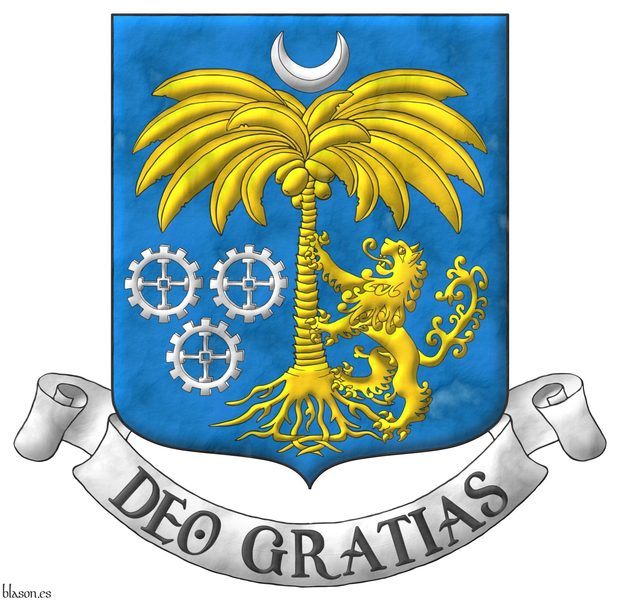
Azure, a palm tree eradicated, between in sinister a lion rampant supporting it Or, in dexter three millwheels, 2 and 1, and in chief a crescent Argent. Motto: «Deo gratias».
Escudo de azur, una palmera arrancada, acompañada a la siniestra de un león rampante empinado a ella ambos de oro, a la diestra de tres ruedas de molino, 2 y 1, y en jefe un creciente todo de plata. Lema: «Deo gratias».
Blazon keywords: Azure, One, Palm tree, Tree, Erased, Between, Sinister, Lion, Rampant, Supporting, Or, Dexter, Three, Millwheel, Ordered, In chief, Crescent, Argent and Motto.
Style keywords: Ogee, Outlined in sable, Illuminated and Parchment.
Classification: Personal, Interpreted, Coat of arms and Latin language.
Bearer: Spanò, Diego Pantaleone.


Donnie Thompson
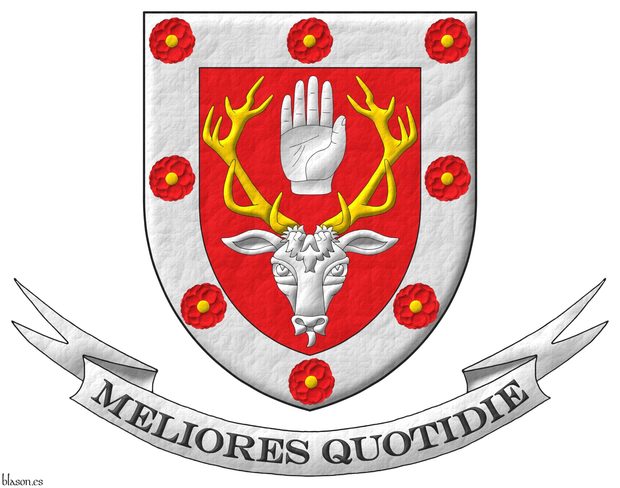
Gules, a stag's head caboshed Argent, attired Or, between its attires a dexter hand appaumée, couped at the wrist; on a bordure Argent eight camellias Gules, seeded Or. Motto: «Meliores Quotidie».
Escudo de gules, un rencuentro de ciervo de plata, ramado de oro, entre sus cuernas, una mano diestra apalmada y cortada por la muñeca; una bordura de plata cargada de ocho camelia de Gules, botonadas de oro. Lema: «Meliores Quotidie».
Arms interpreted by me, highlighted with lights and shadows, contoured in Sable, with a pointed external shape and with a leather finish.
Blazon keywords: Gules, Argent, Or, One, Eight, Stag, Head, Caboshed, Attired, Between, Dexter, Hand, Appaumée, Couped, Wrist, Bordure, Camellia, Seeded and Motto.
Style keywords: Outlined in sable, Illuminated, Pointed and Leather.
Classification: Personal, Interpreted, Boa and Coat of arms.
Bearer: Thompson, Donnie.


Dr. James Patrick Howard II, arms on tartan
Argent, a tetrahedron Azure, pierced by a sword bendwise, point downwards Or, garnished Azure.
Heraldic device depicted by me, illuminated with lights and shadows, contoured in Sable, with an ogee outer contour and with a freehand finish.
G0102, Chief Herald of Arms of Malta's grant for the coat of arms of Dr. James Patrick Howard II, USA. This coat of arms has been emblazoned by me over his personal tartan registered in the Scottish Register of Tartans.
Blazon keywords: Argent, Azure, Or, One, Tetrahedron, Geometric solid, Pierced, In bend, Sword, Point downwards and Garnished.
Style keywords: Outlined in sable, Illuminated, Ogee and Freehand.
Classification: Personal, Interpreted, Boa and Tartan.
Bearer: Howard II, Dr. James Patrick.


Dubai Office of the European Chamber of Digital Commerce
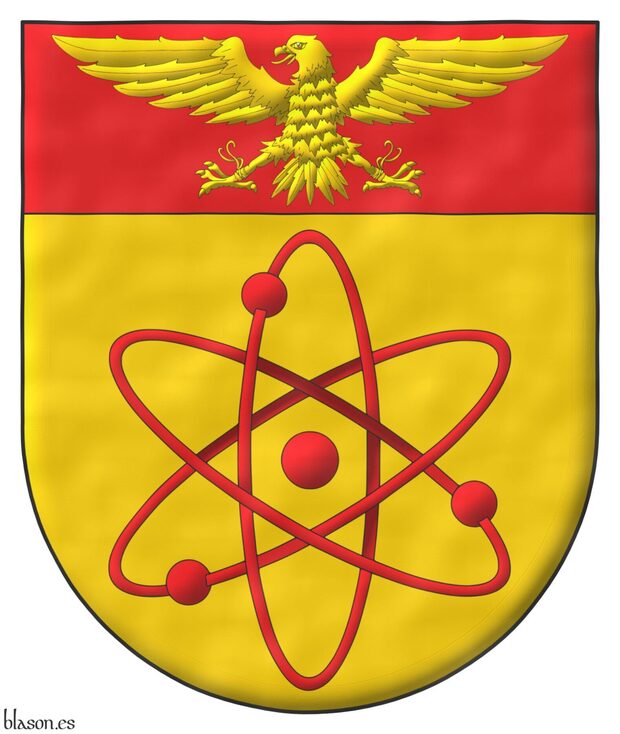
Or, an atom triple-orbited Gules; on a chief Gules, a falcon displayed and jessed Or
Illuminated and a watercolor finishing.
Jessed means with jesses, the thongs by which bells are fastened to the legs of a falcon.
The falcon use to be belled and jessed, with bells and leather strips on the legs. The attributes used to be citted in the blazon when its tincture is different that the main element to which it belongs. In this case, its leather strips are Or, the same tincture than the falcon Or, but I decided to blazoned it «a falcon displayed and jessed Or» to denote jessed but not belled.
Other falcons are also hooded.
Credits: Rudolf Juchter van Bergen Quast is the designer of the coat of arms.
Blazon keywords: Or, One, Atom, Three, Orbital, Gules, Chief, Falcon and Jessed.
Style keywords: Freehand, Outlined in sable, Illuminated and Semi-circular.
Classification: Interpreted, Emirate of Dubai and Coat of arms.
Bearer: Dubai Office of the European Chamber of Digital Commerce.


Duran, lineage of Andalucia, Extremadura, and Aragon
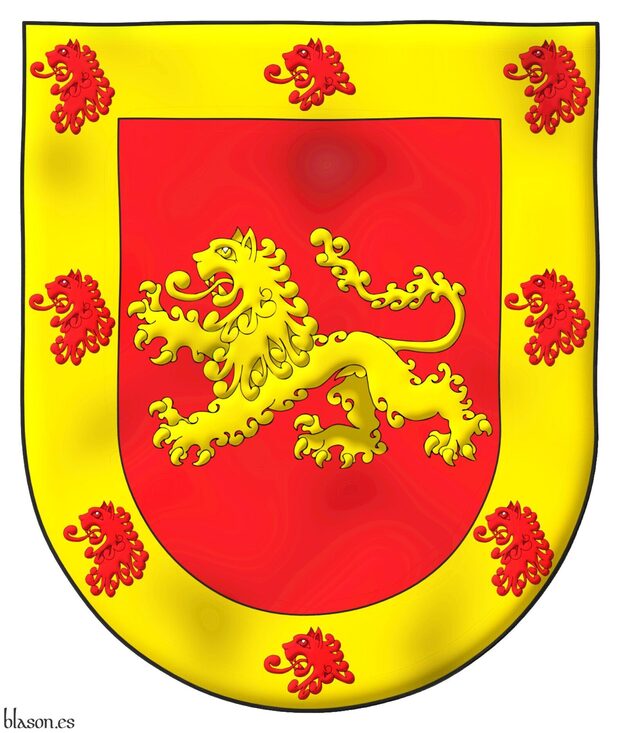
Blazon of the Duran lineage of Andalucia, Extremadura, and Aragon.
Gules, a lion passant Or; a bordure Or charged with eight lions’ heads erased Gules.
Escudo de gules, un león leopardado de oro; una bordura de oro, cargada de ocho cabezas de león arrancadas de gules.
Illuminated and with a glass finish.
Blazon keywords: Gules, Lion passant, Or, One, Bordure, Charged, Eight, Head and Erased.
Style keywords: Glass, Outlined in sable, Illuminated and Semi-circular.
Classification: Interpreted, Lineage and Coat of arms.


Edmund de Bassingburnn

Edmund de Bassingbourne ~ Edmund de Bassingburnn.
Gyronny Or and Azure.
Jironado de oro y azur.
Included in [Vincent, MS; 1285; number 82] also known as [St. George's Roll; 1285; number 82].
Blazon keywords: Gyronny, Eight, Or and Azure.
Style keywords: Pointed, Plain tincture and Outlined in sable.
Classification: Interpreted and Personal.
Bearer: Edmundo de Bassingbourne.


Edmund Plantagenet

The one with the Cross on his back ~ Crouchback (1245–1296)
Arms of England; overall, a label Azure of three points, each charged with three fleurs-de-lis Or in pale.
Arms interpreted as follows: the mouth of the shield is semicircular (round); the field enamelled in a flat tint of Gules; the label and figures illuminated in Or and Azure and outlined in Sable; and the whole finished with a watercolour effect.
He was the second son of King Henry III of England, and took part in the Ninth Crusade, hence the epithet «Cross on the back».
In 1253 he was appointed Earl of Chester, holding dominion, among others, over the county of Cheshire, but the following year Pope Innocent IV granted him the crown of Sicily, so he ceded his earldom to his elder brother Edward I of England, however, he never came to occupy the throne of Sicily.
The label is an honourable ordinary and also «a kind of mark of cadency, and the most noble of all those used to differentiate the Arms of the younger sons of a House» [Avilés, J.; 1725a; page 248] and it can likewise be used by the eldest son while his father's arms are still in use, ceasing to bear the label when he inherits his father’s coat. When both the eldest and the second son bear a label, the latter’s label then has more points or is charged with figures to distinguish it.
The label is constructed with «a fillet, which is one-ninth of the width of the chief, with three pendants in the form of carpentry wedges or ill-shaped triangles, joined to it without any line of separation, falling twice as far as the fillet is wide, two placed at the ends and one in the middle, its usual position being in the centre of the chief’s length, without reaching the edges of the shield» [Avilés, J.; 1725a; page 248].
Blazon keywords: Without divisions, Gules, Or, Azure, Three, Leopard, Armed, Langued, In pale, Surmounted, Overall (deprecated), Label, Suspended, Charged and Fleur de lis.
Style keywords: Semi-circular, Illuminated, Outlined in sable and Watercolor.
Classification: Interpreted, Personal, Coat of arms, House of Plantagenet and Kingdom of England.
Bearer: Edmund Plantagenet.


Edward II of England

First Prince of Wales from 1301 to 1307, King of England and Lord of Ireland from 1307 to 1327.
Gules, three lions, passant, guardant, in pale Or, armed and langued Azure.
Escudo de gules, tres leopardos en palo de oro, armados y lampasados de azur.
Coat of arms interpreted as follows: the mouth rounded; the field illuminated Gules; the figures illuminated in Or and Azure, outlined in Sable, and the third leopard slightly smaller; and the whole finished with a plastered effect.
Blazon keywords: Without divisions, Gules, Or, Azure, Three, Leopard, Armed, Langued and In pale.
Style keywords: Rounded, Illuminated, Outlined in sable and Gesso.
Classification: Interpreted, Personal, Coat of arms, House of Plantagenet and Kingdom of England.
Bearer: Edward II of England.


Edward IV of England
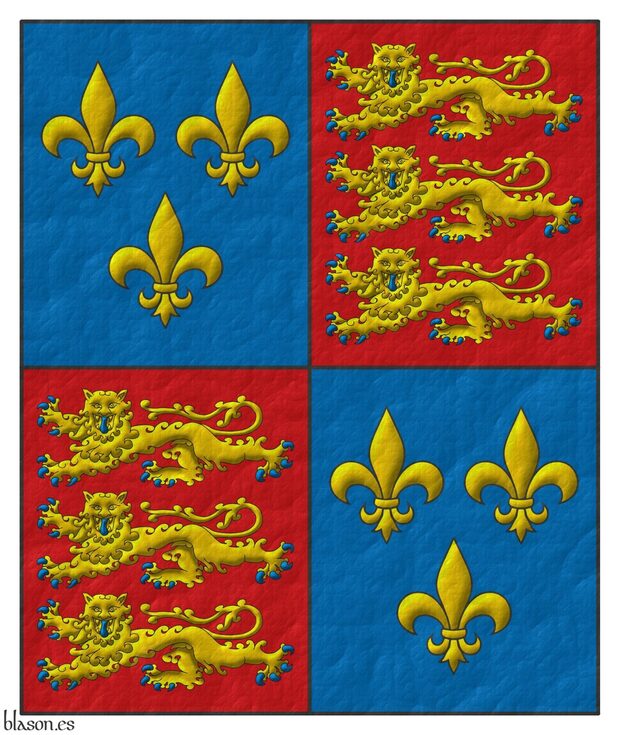
Banner Quarterly: 1 and 4 Azure, three fleurs de lis Or; 2 and 3 Gules, three lions, passant, guardant, in pale Or, armed and langued Azure.
Pendón cuartelado: 1o y 4o de azur, tres flores de lis de oro; 2o y 3o de gules, tres leopardos en palo de oro, armados y lampasados de azur.
Banner interpreted by me as follows: with the proportions of 5x6, like a shield; the field is coloured in flat tinctures Gules and Azure; the fleurs-de-lis and the leopards are outlined in Sable and illuminated in Or; and the banner’s finish resembles fabric.
Its design follows [Edward IV of England; 1461; row 27, 2nd column, final banner]:
- which represents what are considered «the royal arms of England»,
- which were also borne by Henry V of England,
- which Henry VI of England placed in the 2nd quarter of a per pale shield, where he set those of France in the 1st, and
- which were restored by Henry IV, as shown here.
Blazon keywords: Quarterly, Azure, Or, Three, Fleur de lis, Ordered, Gules, Leopard, Armed, Langued and In pale.
Style keywords: Rectangular, Illuminated, Outlined in sable and Fabric.
Classification: Interpreted, Personal, Flag, Banner of arms, Kingdom of England and House of York.
Bearer: Edward IV of England.


Edward Longshanks
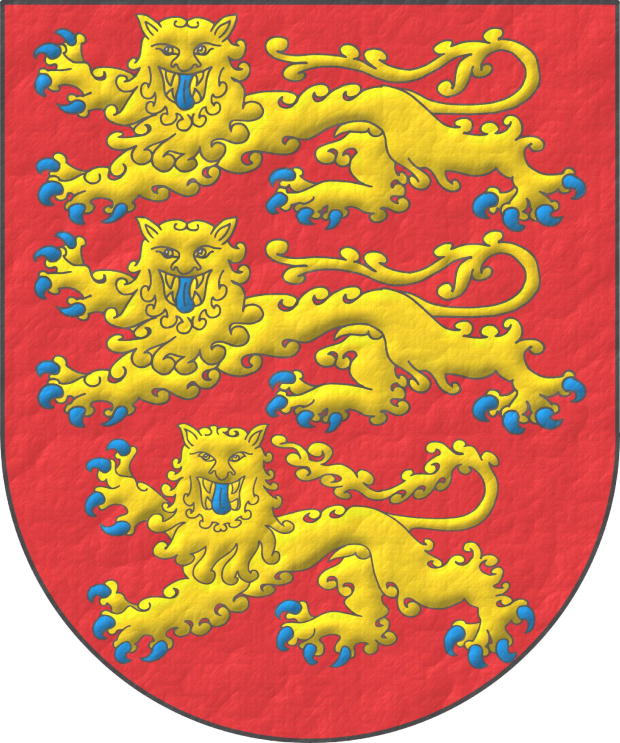
King of England and Lord of Ireland from 1272 to 1307.
Gules, three lions, passant, guardant, in pale Or, armed and langued Azure.
Escudo de gules, tres leopardos en palo de oro, armados y lampasados de azur.
Coat of arms interpreted with the following features: the mouth is semicircular (round); the field enamelled in a flat tint of Gules; the three leopards illuminated in the metal Or and the colour Azure, outlined in Sable, and the leopard closest to the base has a different shape and size; and the whole finished with a fabric-like texture.
Blazon keywords: Without divisions, Gules, Or, Azure, Three, Leopard, Armed, Langued and In pale.
Style keywords: Semi-circular, Illuminated, Outlined in sable and Fabric.
Classification: Interpreted, Personal, Coat of arms, House of Plantagenet and Kingdom of England.
Bearer: Edward I of England.


Edwin Gräupl
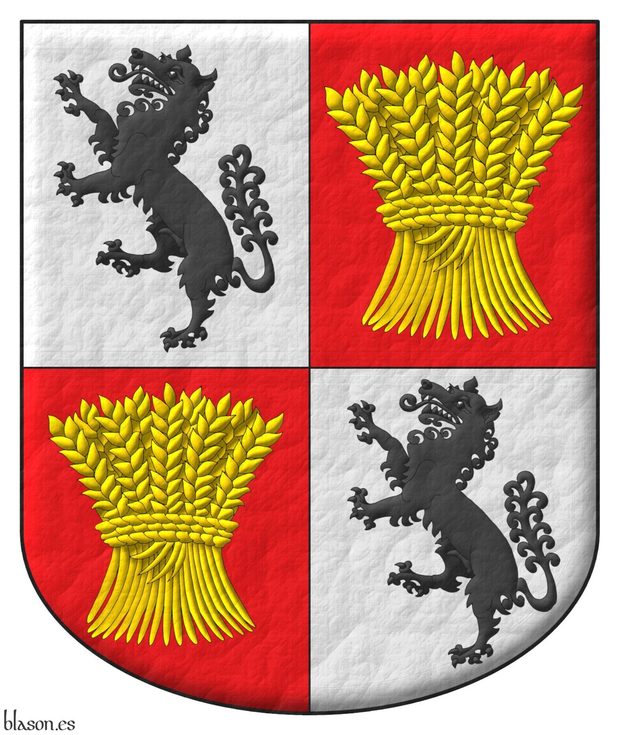
Quarterly: 1 and 4 Argent, a wolf rampant Sable; 2 and 3 Gules, a garb Or.
Coat of arms emblazoned by me with a shape ended with an rounded arch, illuminated, and its finishing is that seems leather.
Blazon keywords: Quarterly, Argent, One, Wolf, Rampant, Sable, Gules, Garb and Or.
Style keywords: Rounded, Outlined in sable, Illuminated and Leather.
Classification: Personal, Interpreted and Coat of arms.
Bearer: Gräupl, Edwin.


Egado, lineage
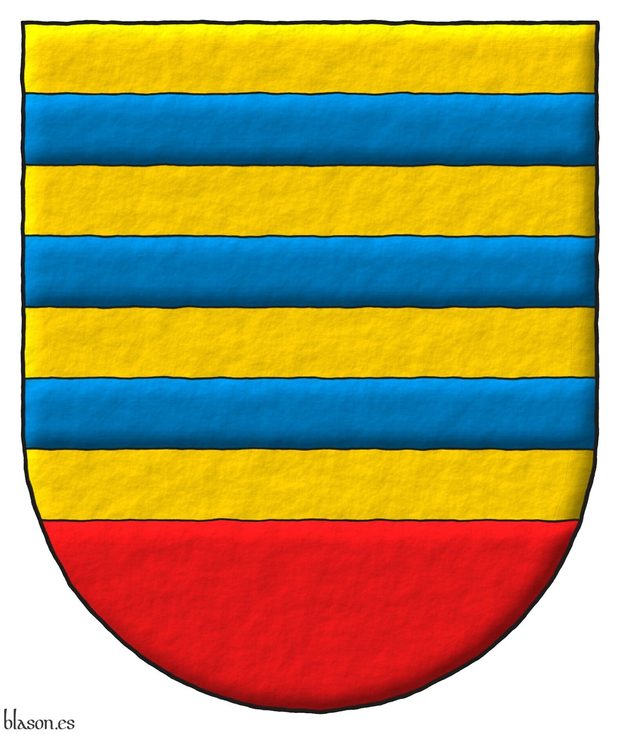
Or, three bars Azure; the base Gules.
Escudo de oro, tres burelas de azur; la punta de gules.
Arms painted by me, illuminated with lights and shadows, contoured in Sable, with a semi-circular outer contour and with a freehand finish.
Coat of arms of the lineage Egado emblazoned by me based on the description by [Cadenas y Vicent, V. de; 1987; page 635].
Blazon keywords: Or, Azure, Gules, Three, Bar and Base (lower 1/3).
Style keywords: Outlined in sable, Illuminated, Semi-circular and Freehand.
Classification: Personal, Lineage, Interpreted, Boa and Coat of arms.
Bearer: Egado, lineage.


Elizabeth II of the United Kingdom

Quarterly: 1 and 4 Gules, three lions passant, guardant, in pale Or, armed and langued Azure; 2 Or, a lion rampant Gules, armed and langued Azure, within a double tressure flory counterflory Gules; 3 Azure, a harp Or, stringed Argent.
Escudo cuartelado: 1o y 4o de gules, tres leopardos en palo de oro, lampasados y armados de azur; 2o de oro, un león de gules, armado y lampasado de azur, encerrado en un trechor doble flordelisado y contraflordelisado de gules; 3o de azur, un arpa de oro cordada de plata.
Arms painted by me, highlighted with lights and shadows, outlined in Sable, with an ogee outer contour and with a watercolor finishing.
Coat of arms of Her Majesty Queen Elizabeth II emblazoned by me.
Blazon keywords: Gules, Or, Azure, One, Three, Quarterly, Leopard, Pale, Armed, Langued, Lion, Rampant, Double tressure, Flory, Counterflory, Harp and Stringed.
Style keywords: Outlined in sable, Illuminated, Ogee and Watercolor.
Classification: Personal, Interpreted, Boa and Coat of arms.
Bearer: Elizabeth II of the United Kingdom.


England, Kingdom of
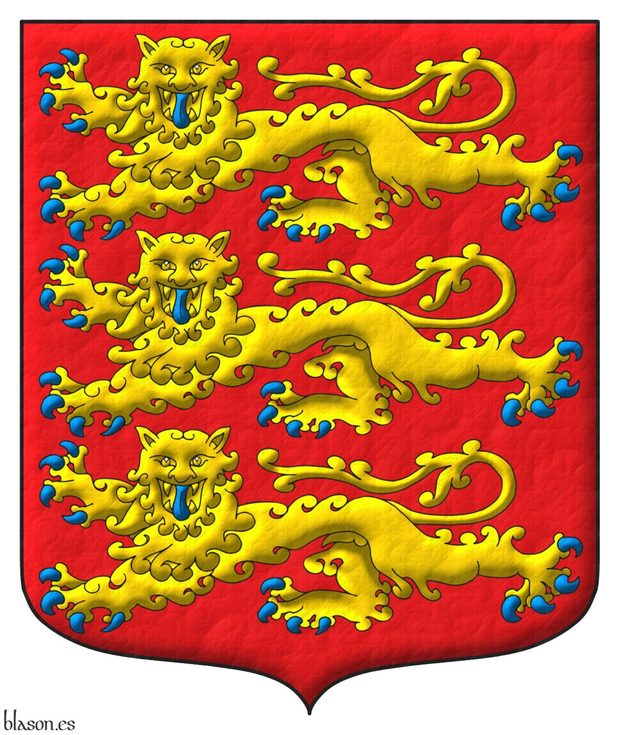
Gules, three lions passant, guardant, in pale Or, armed and langued Azure.
Escudo de gules, tres leopardos en palo de oro, armados y lampasados de azur.
Coat of arms interpreted by me, highlighted with lights and shadows, outlined in Sable, with an ogee external shape and with a leather finishing.
These are arms of the Kingdom of England emblazoned by me.
Blazon keywords: Gules, Or, Azure, Three, Leopard, Pale, Armed and Langued.
Style keywords: Outlined in sable, Illuminated, Ogee and Leather.
Classification: Civic, Interpreted, Boa and Coat of arms.
Bearer: England, Kingdom of.


Eóin S. Morgan, structured and parallel blazons
Coat of arms of Eóin S. Morgan, UE, emblazoned by me, with the blazon written in English and Castilian in a structured way to observe the parallelism between both forms. He is the youngest son of Commander Stephen T. Morgan.
Blazon keywords: Or, Sable, Gules, Azure, Argent, One, Three, Griffin, Segreant, Chief, Invected, Naval crown, Cadency and Crescent.
Style keywords: Outlined in sable, Illuminated and Freehand.
Classification: Personal, Interpreted, Structured and parallel blazons, Boa and Coat of arms.
Bearer: Morgan, Eóin S..


Ermengol IX of Urgell
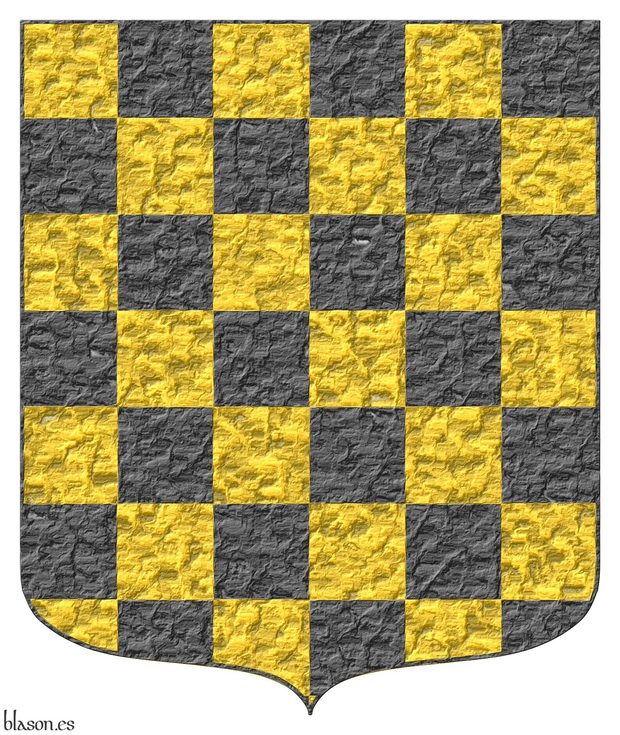
Count of Urgell, Viscount of Àger, deceased in 1243.
Chequey Or and Sable.
Escudo ajedrezado de oro y sable.
Arms interpreted with: a pointed and rounded shield shape; the chequey pattern enamelled in flat Or and Sable; and a heavily beaten metal finish.
Ermengol IX held the county for a very short time, as he died shortly after the death of his father Ponce I of Urgell, in that same year of 1243.
Blazon keywords: Chequey, Or and Sable.
Style keywords: Ogee, Plain tincture and Hard metal.
Classification: Interpreted, Personal, Coat of arms and Kingdom of Aragon.
Bearer: Ermengol IX of Urgell.


Espeja Avieda, Alejandra
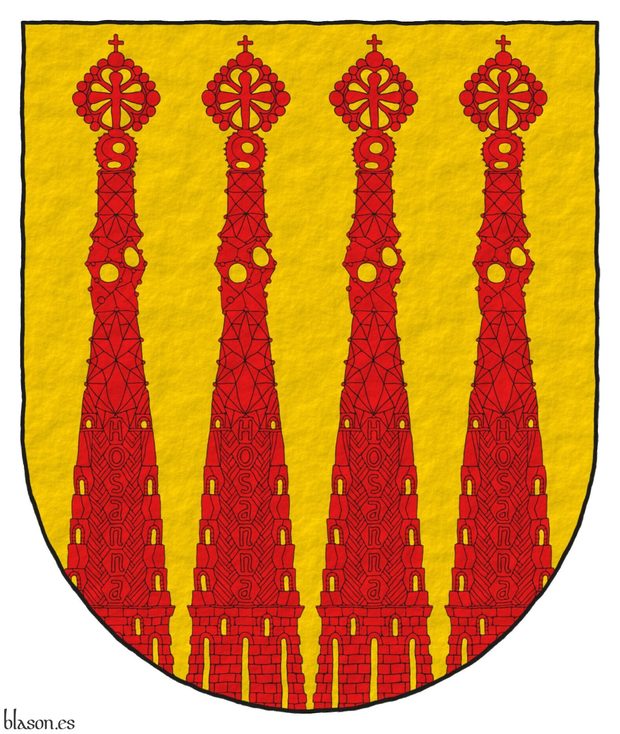
Or, four bell towers issuant from base Gules, windows Or.
Escudo de oro, cuatro campanarios movientes de la punta de gules, aclarados de oro.
Arms painted by me, in plain tinctures, outlined in Sable, with a semi-circular external shape and with a texturized finish.
Coat of arms of Alejandra Espeja Avieda designed by Juan Lanzagorta Vallín and emblazoned by me. Blazoning specific, real-world objects in coats of arms should be avoided. Therefore, in the blazon I describe «four bell towers». However, in this case, for artistic reasons, to echo the elongated form of the four pallets Gules, and due to the origin of the bearer, I depict four bell towers inspired by those on the Nativity Façade of Gaudí’s Sagrada Família in Barcelona. Additionally, I initially blazoned the arrangement of the 4 bell towers as «in fess» ~ «en faja», as, from a heraldic perspective, this term accurately describes their horizontal alignment next to each other across the field. However, I observed that this term, far from clarifying the design, caused confusion among some viewers. The naturally vertical shape of a bell tower, its default position, is «palewise» ~ «puesta en palo», so using «in fess» ~ «en faja» led many to assume that I intended to lay the bell towers on their sides. Although the original description was heraldically correct, I decided to remove the mention of «in fess» ~ «en faja» for being unnecessary and clearly counterproductive. As the towers are «issuant from base» ~ «movientes de la punta», their placement in a horizontal row is sufficiently implied, thus avoiding misunderstandings and maintaining the clarity of the blazon. It is important to remember that «in fess» ~ «en faja» refers to how multiple elements are aligned with each other (in a horizontal row), while «palewise» ~ «puesto en palo» describes the individual orientation of an element (in a vertical position).
Blazon keywords: Or, Gules, Four, Bell tower, Issuant from base and Port and windows.
Style keywords: Outlined in sable, Plain tincture and Semi-circular.
Classification: Personal, Interpreted, Boa and Coat of arms.
Bearer: Espeja Avieda, Alejandra.


Espinosa, Diego

Azure, two trunks of a tree raguly, couped at random, in saltire Argent; a bordure compony of sixteen sections, eight sable charged with a castle triple-towered Or, port, windows, and masoned Sable, and eight Argent
Escudo de azur, dos troncos ecotados, nudosos, en sotuer de plata; una bordura componada de dieciseis compones: ocho de sable cargados de un castillo de oro, aclarado y mazonado de sable, y ocho de plata
Illuminated and a leather finishing.
Blazon keywords: Without divisions, Azure, Two, Trunk, Raguly, In saltire, Argent, One, Bordure, Compony, Sixteen, Section, Eight, Sable, Charged, Castle, Or, Port and windows and Masoned.
Style keywords: Leather, Outlined in sable, Illuminated and Semi-circular.
Classification: Personal and Interpreted.
Bearer: Espinosa, Diego.


Eugene IV

Papa número 207 de la Iglesia, de 1431 a 1447. «Eugenius IV», de nombre Gabriele Condulmer, nació en Venecia.
Azure, a bend Argent.
Escudo de azur, una banda de plata.
Escudo papal que he interpretado con: la boca apuntada; el campo de tinta plana de azur; la banda iluminada de azur y delineada de sable; y el conjunto acuarelado.
Blazon keywords: Without divisions, Azure, One, Bend and Argent.
Style keywords: Pointed, Illuminated, Outlined in sable and Watercolor.
Classification: Interpreted, Religious and Papal States.
Bearer: Eugene IV.


Family of Paul and Kari Herndon, structured and parallel blazons
Canting arms of the family of Paul and Kari Herndon, based on the arms of their lineage, and emblazoned by me, with the blazon written in English and Castilian in a structured way to observe the parallelism between both forms.
| Argent, a heron volant Azure, beaked and membered between three escallops Sable. | Escudo de plata, una garza volante de azur, picada y membrada, acompañada de tres veneras todo de sable. |
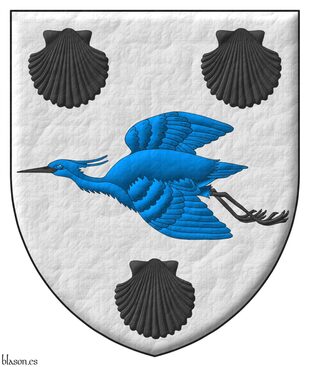 |
Blazon keywords: Argent, Azure, Sable, One, Three, Heron, Volant, Beaked, Membered, Between and Escallop.
Style keywords: Outlined in sable, Illuminated, Pointed and Leather.
Classification: Personal, Canting, Interpreted, Structured and parallel blazons, Boa and Coat of arms.
Bearer: Herndon, family of Paul and Kari.


Farnese, Alessandro
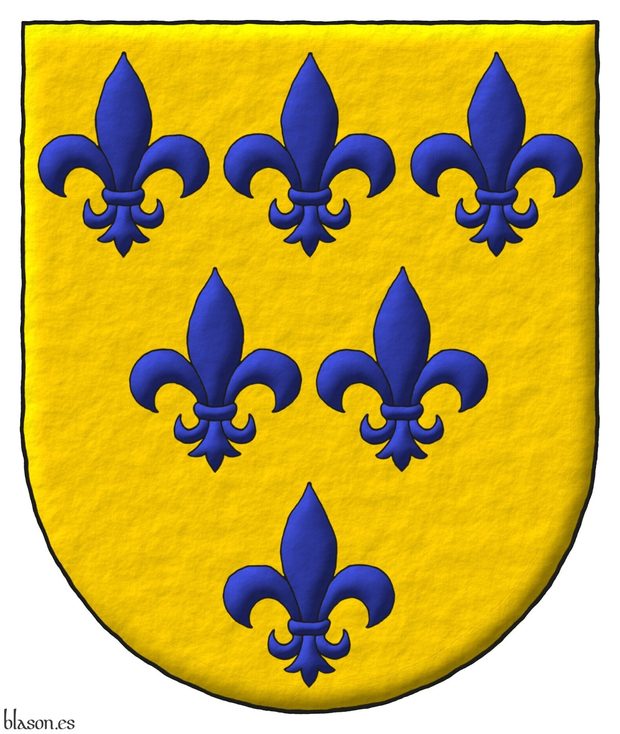
Or, six fleurs de lis Azure, 3, 2, and 1.
Escudo de oro, seis flores de lis de azur, 3, 2 y 1.
Coat of arms depicted by me, highlighted with lights and shadows, contoured in Sable, with a semi-circular outer contour and with a freehand finish.
Coat of arms of Alessandro Farnese, 1545–1592, emblazoned by me. In 1956, the fourth Tercio of the Spanish Legion was created and named Tercio Alessandro Farnese in his honor. The coat of arms of that Tercio features the arms of the Farnese in its central inescutcheon, although with its 6 fleurs de lis arranged in orle.
Blazon keywords: Or, Azure, Six and Fleur de lis.
Style keywords: Outlined in sable, Illuminated, Semi-circular and Freehand.
Classification: Personal, Interpreted, Boa and Coat of arms.
Bearer: Farnese, Alessandro.


Ferdinand II, imaginary coat of arms

Argent, a lion sejant erect Purpure.
Escudo de plata, un león sentado de púrpura.
Imaginary coat of arms of King Fernando II of León, which I have developed based on his seal and the arms of his successor, with: the shape of the coat of arms is semi-circular; the field enameled in flat argent; the lion enameled in purpure and illuminated; and the whole rendered with a watercolor finish.
For this imaginary coat of arms I have chosen a representation of the lion in a posture similar to that of the great seal appearing in [Fernando II de León; 1167], which is sejant ~ «sentado» in Castilian, although beginning to rise «sejant erect».
It should be noted that we are in a pre-heraldic period where the possible attitudes of the lion were not yet clearly defined, although several of them are already anticipated in the great seals of Fernando II, as can be seen, for example, passant in [Fernando II de León; 1181] and in other attitudes in the photographs of [Martín Fuertes, J. A.; 2002].
Blazon keywords: Without divisions, Argent, Lion, Purpure and Sejant.
Style keywords: Semi-circular, Illuminated, Outlined in the field tincture and Watercolor.
Classification: Interpreted, Imaginary, Coat of arms and Kingdom of León.
Imaginary bearer: Ferdinand II of Leon.


Ferdinand III of Castile
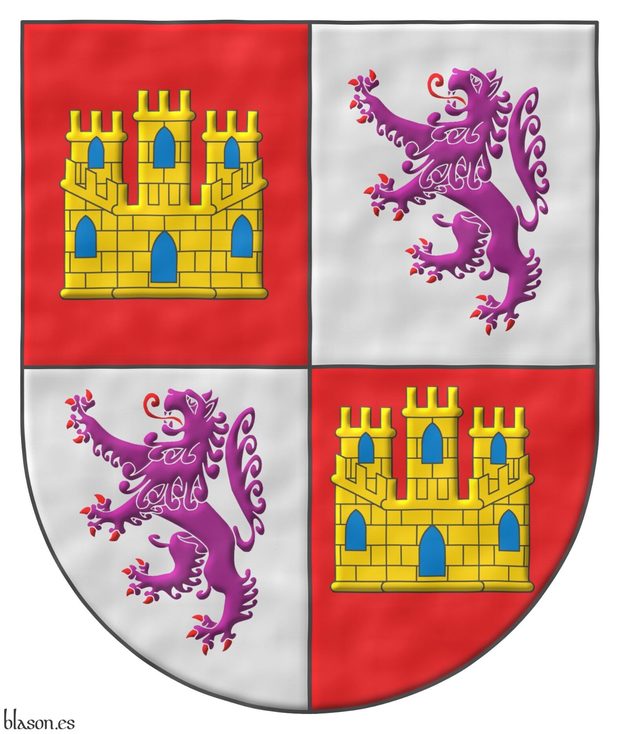
Son of Berenguela, Queen of Castile, and Alfonso IX, King of León.
Quarterly: 1 and 4 Gules, a castle triple towered Or, port and windows Azure, masoned Sable; 2 and 3 Argent, a lion rampant Purpure, armed and langued Gules.
Escudo cuartelado: 1o y 4o de gules, un castillo de oro, aclarado de azur, mazonado de sable; 2o y 3o de plata, un león rampante de púrpura, armado y lampasado de gules.
Arms of King Ferdinand III of Castile, as interpreted by me, with the following characteristics: the shield’s shape is rounded; the field, the two castles, and the two lions have been illuminated; and the whole composition features a watercolor finish.
It is with King Ferdinand III the Saint of Castile when «the emblematic system reaches its highest degree of perfection, acquiring two characteristics: realism, which becomes a hallmark of Spanish heraldry,... and the tendency to combine coats of arms» with the appearance of quarterly divisions replacing the cadency marks used in the rest of Europe [Valverde Ogallar, P. B.; 2001; page 100].
Shield in flat ink and illuminated metallic finish

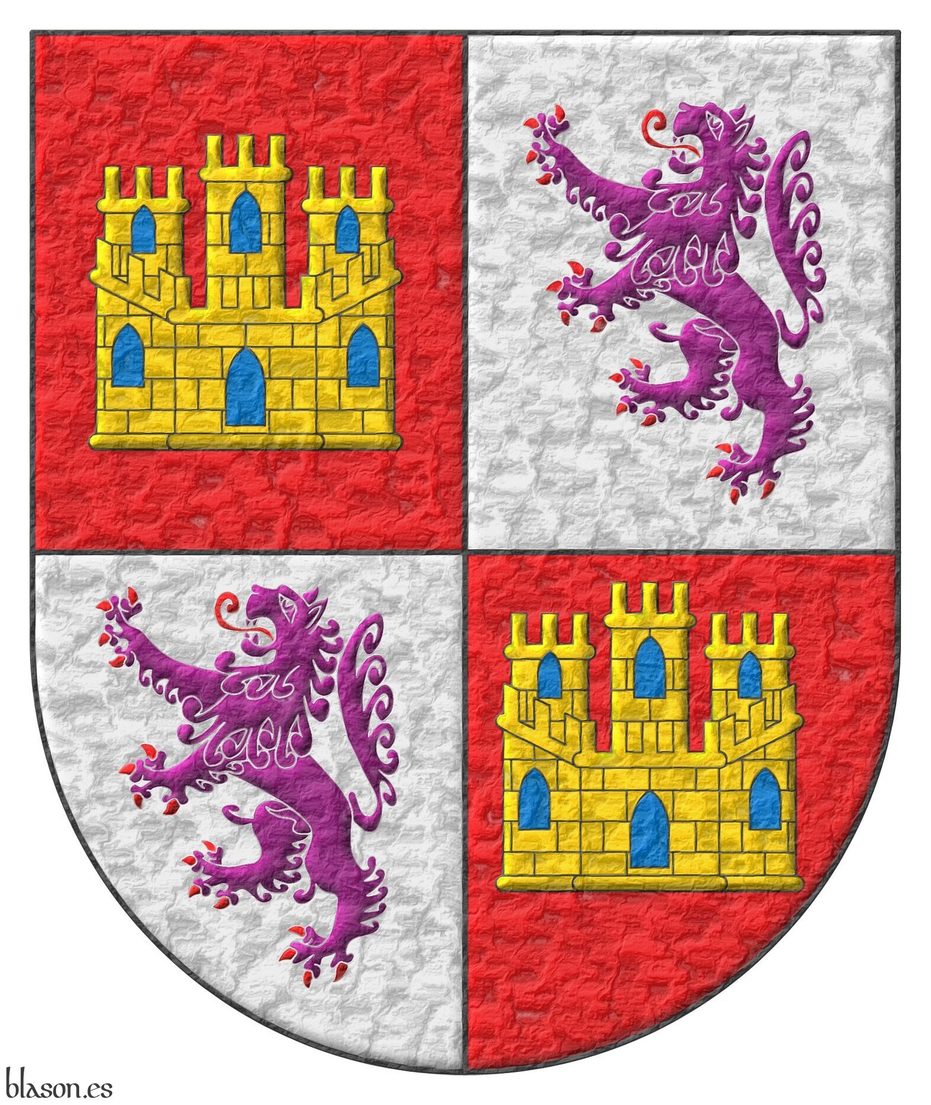
Design of a heraldic document
Blazon keywords: Quarterly, Gules, Or, Azure, Sable, One, Castle, Port and windows, Masoned, Argent, Purpure, Lion, Rampant, Armed and Langued.
Style keywords: Semi-circular, Illuminated and Watercolor.
Classification: Interpreted, Personal, Coat of arms and Kingdom of Castile and Leon.
Bearer: Ferdinand III of Castile.


Fernández Carrizo, Silvio

Quarterly: 1 Or, a lion rampant Gules; 2 Gules, a fleur de lis Or; 3 Gules, a sun of May Or; 4 Or, a cross of Bolnisi Gules.
Escudo cuartelado: 1o de oro, un león rampante de gules; 2o de gules, una flor de lis de oro; 3o de gules, un sol de mayo de oro; 4o de oro, una cruz de Bolnisi de gules.
Arms emblazoned by me, highlighted with lights and shadows, contoured in Sable, with a chasuble external shape and with a texturized finish.
Coat of arms of Silvio Fernández Carrizo emblazoned by me.
Blazon keywords: Or, Gules, One, Quarterly, Lion, Rampant, Fleur de lis, Sun of May, Cross of Bolnisi and Cross couped.
Style keywords: Outlined in sable, Illuminated and Chasuble.
Classification: Personal, Interpreted, Boa and Coat of arms.
Bearer: Fernández Carrizo, Silvio.


Fernández de Córdoba y Carrillo, Diego

Marshal of Castile, first Lord of Baena and plenipotentiary ambassador to the court of Portugal (1355–1435).
Or, three fesses Gules.
Escudo de oro, tres fajas de gules.
Coat of arms del que fue mariscal de Castilla interpreted as follows: the shield has a semicircular (round) base; the field is illuminated in flat metal Or; its three fesses illuminated in Gules y outlined in Sable; y el conjunto con un plastered finish.
He served under the kings John I of Castile, Henry III of Castile, and John II of Castile.
These three bars of the Fernández de Córdoba lineage are found, for example, in the first quarter of the coat of arms of Gonzalo Fernández de Córdoba y Enríquez de Aguilar, known as *El Gran Capitán*.
Blazon keywords: Without divisions, Or, Fess and Gules.
Style keywords: Illuminated, Outlined in sable, Semi-circular and Gesso.
Classification: Interpreted, Personal, Coat of arms and Kingdom of Castile and Leon.
Bearer: Fernández de Córdoba y Carrillo, Diego.
Blazon equivalent to: Berry of Molland.


Fernandez de Cordoba, Gonzalo
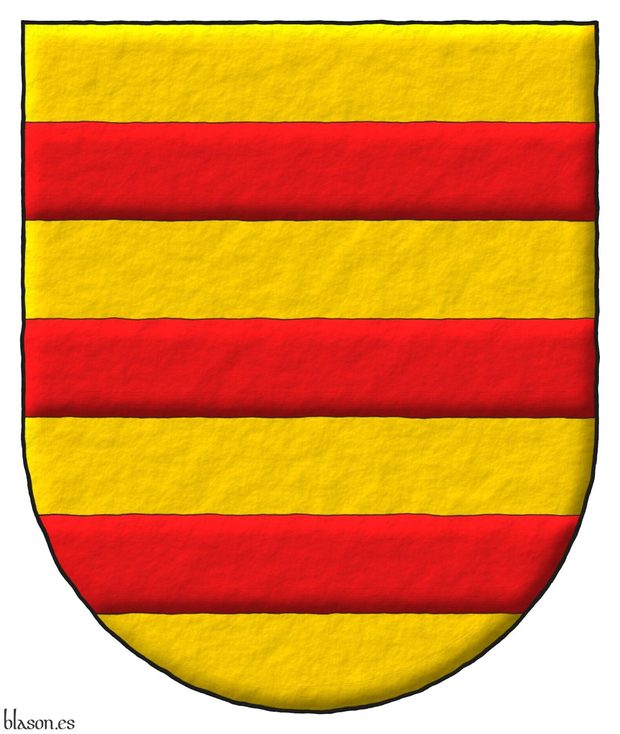
Or, three bars Gules.
De oro, tres fajas de gules.
Arms interpreted by me, highlighted with lights and shadows, contoured in Sable, with a semi-circular external shape and with a freehand finishing.
Coat of arms of Gonzalo Fernandez de Cordoba, 1453–1515, known as «The Great Captain», emblazoned by me. The Tercio Great Captain, 1st of the Spanish Legion, is named in honour of Gonzalo Fernandez de Cordoba, and the coat of arms of the unit bears a central inescutcheon with the arms of «The Great Captain».
Blazon keywords: Or, Gules, Three and Fess.
Style keywords: Outlined in sable, Illuminated, Semi-circular and Freehand.
Classification: Personal, Interpreted, Boa and Coat of arms.
Bearer: Fernandez de Cordoba, Gonzalo.


Flor, Roger de

Leader of the almogávares in the service of the Crown of Aragon, born in Brindisi, southeast Italy, in 1266, and assassinated in Adrianople, European Turkey, in 1305.
Argent, a fleur de lis Gules.
Escudo de plata, una flor de lis de gules.
Coat of arms interpreted with: the pointed and rounded form; the field in flat Argent; the fleur de lis illuminated in Gules and outlined in Sable; and an overall rough finish.
Blazon keywords: Without divisions, Argent, Gules and Fleur de lis.
Style keywords: Ogee, Illuminated, Outlined in sable and Rough.
Classification: Interpreted, Personal, Army and Navy and Coat of arms.
Bearer: Flor, Roger de.


Francis I of France
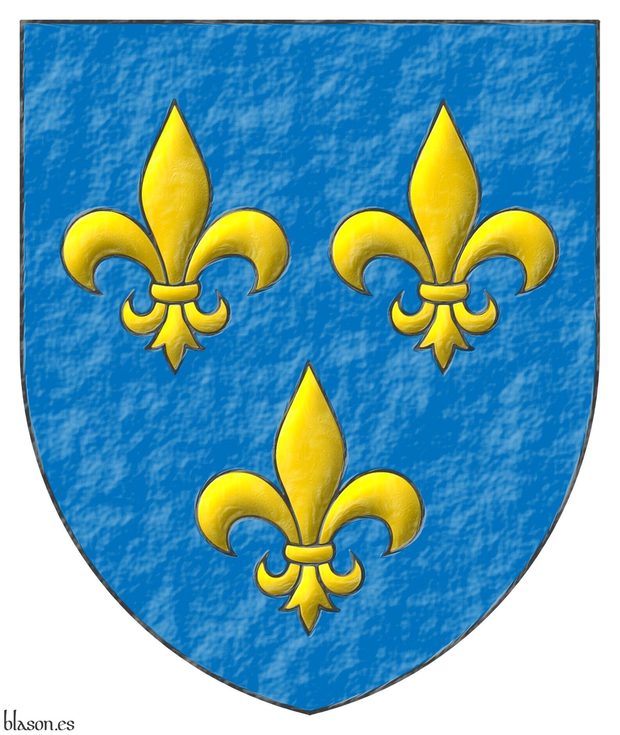
From the House of Valois-Angoulême and with the motto: Nutrisco et extinguo.
Azure, three fleurs de lis Or.
Escudo de azur, tres flores de lis de oro.
Coat of arms interpreted with: a pointed base; the field enamelled in flat Azure; the three fleurs-de-lis outlined in Sable and illuminated in Or; and finished with a plaster texture.
Blazon keywords: Without divisions, Azure, Or, Three, Fleur de lis and Ordered.
Style keywords: Pointed, Illuminated, Outlined in sable and Gesso.
Classification: Interpreted, Personal, Coat of arms, Kingdom of France and House of Valois.
Bearer: Francis I of France.


Francisca Aras Quirce
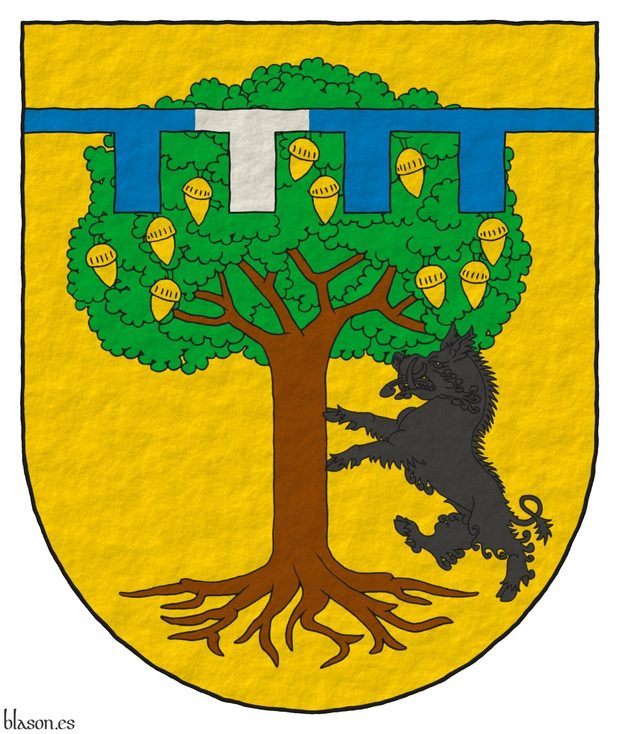
Or, an oak tree proper, fructed Or, with a boar supporting it Sable; the whole debruised by a label of four points Azure with the second point Argent.
Escudo de oro, un roble al natural, frutado de oro, con un jabalí empinado de sable; brisado de un lambel de cuatro pendientes de azur, el segundo pendiente de plata.
Coat of arms interpreted by me, in flat tinctures, outlined in Sable, with a semi-circular outer contour and with a texturized finish.
Coat of arms of Francisca Aras Quirce designed by Juan Lanzagorta Vallin and emblazoned by me.
Credits: Juan Lanzagorta Vallin is the designer of the coat of arms.
Blazon keywords: Or, One, Oak, Tree, Proper, Fructed, Boar, Supporting, Sable, Cadency, Label, Four, Azure and Argent.
Style keywords: Outlined in sable, Plain tincture and Semi-circular.
Classification: Personal, Interpreted and Coat of arms.
Bearer: Francisca Aras Quirce.


Francisco Jose Bermejo Fernandez-Briceño, collage
Party per fess: 1 Or, a tower Gules between in chief a crescent and a mullet of eight points Azure; 2 Azure, three demi-horses courant in bend sinister nascent from the ends of three bars wavy issuant from sinister Argent. Crest: A crown of the Soberana y Muy Noble Orden de la Granada.
Coat of arms interpreted by me, illuminated with lights and shadows, contoured in Sable, with a rounded external shape and with a texturized finishing.
Arms of Francisco Jose Bermejo Fernandez Briceño, designed by Ignacio Koblischek, emblazoned by Antonio Salmeron for the Soberana y Muy Noble Orden de la Granada, and carved by Juan Miguel Rocamora Narro.
Blazon keywords: Or, Azure, Gules, Argent, One, Three, Party per fess, Tower, Between, In chief, Crescent, Mullet, Demi, Horse, Courant, In bend sinister, Nascent, Bar, Wavy, Issuant, Sinister and Crown.
Style keywords: Outlined in sable, Illuminated and Rounded.
Classification: Personal, Interpreted, Boa, Coat of arms and Armorial stone.
Bearer: Bermejo Fernandez-Briceño, Francisco Jose.


Freitas, lineage of Portugal
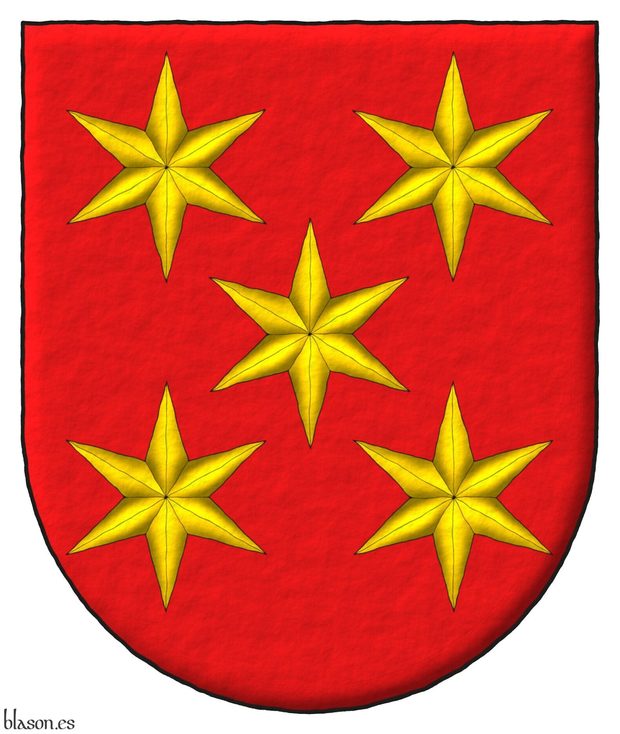
Blazon of the Freitas lineage of Portugal.
Gules, five mullets of six points Or.
Illuminated and a freehand finishing.
It can be found at [Cró, J. do; 1509; page 123].
Blazon keywords: Without divisions, Gules, Five, Mullet and Or.
Style keywords: Freehand, Outlined in sable, Illuminated and Semi-circular.
Classification: Interpreted, Lineage and Kingdom of Portugal.


Full achievement of Jay Geoffrey De Graaf
Party per fess, 1 Gules, a stag rampant, issuant from base proper, in the dexter chief a Maltese cross Argent; 2 Azure, a mullet of seven points Argent. Crest: Upon a helm befitting his degree issuant from a crown of Noble above the shield, with a wreath Argent and Gules, a demi-lion Gules, crowned Or, grasping in its paws a swallow-tailed pennon lozengy Gules and Argent, shafted Sable. Mantling: Gules doubled Argent. Motto: «Per Aquas Ad Futurum». Suspended from the shield, the cross of Knight of Magistral Grace of the Sovereign Military Order of Malta.
Coat of arms painted by me, highlighted with lights and shadows, contoured in Sable, with a pointed external shape and with a freehand finish.
G0131, augmentation of G0042, Chief Herald of Arms of Malta's grant for the arms of Jay Geoffrey De Graaf, Australia. The augmentation consists of the addition of a Maltese cross Argent in the dexter chief. These arms have been emblazoned by me for such grant.
Blazon keywords: Gules, Azure, Argent, Or, One, Party per fess, Stag, Rampant, Issuant from base, Proper, In the dexter chief, Eight-pointed cross, Cross couped, Mullet, Crest, Upon (wreath), Helm, Issuant, Crown of Noble, Crown, Above the shield, Wreath, Demi, Lion, Crowned, Grasping, Paw, Swallow-tail, Lozengy, Shafted, Mantling, Motto, Suspended from the shield and Decoration.
Style keywords: Outlined in sable, Illuminated, Pointed and Freehand.
Classification: Personal, Interpreted, Boa, Coat of arms, Pennon and Flag.
Bearer: Graaf, Jay Geoffrey De.


Full achievement of Jean-Yves de Sainte Croix de la Sabliere
Azure, a cross ermine fimbriated Or, between four fleurs de lis Argent, each enfiled in a crown Or. Crest: Upon a helm befitting his degree, issuant from a crown of Baron, with a wreath Or and Azure, a falcon displayed, belled Azure, crowned Or, holding in its dexter talon an hourglass Or and in its sinister talon a fleur de lis Argent. Mantling: Azure doubled Or. Motto: «Per Crucem Triumphans» Sable, over a scroll Argent, doubled Gules. Supporters: Two lions rampant Or, langued Gules.
Coat of arms depicted by me, illuminated with lights and shadows, contoured in Sable, with a pointed outer contour and with a freehand finish.
G0128, Chief Herald of Arms of Malta's grant for the arms of Jean-Yves, de Sainte Croix de la Sabliere, UK. These arms have been emblazoned by me for such grant.
Blazon keywords: Azure, Or, Argent, Gules, One, Four, Cross, Ermine, Fimbriated, Between, Fleur de lis, Enfiled, Crown, Crest, Upon (wreath), Helm, Issuant, Crown of Baron, Above the shield, Wreath, Falcon, Belled, Crowned, Dexter, Talon, Hourglass, Sinister, Mantling, Doubled, Motto, Scroll, Supporter (animal), Supporter, Lion, Rampant and Langued.
Style keywords: Outlined in sable, Illuminated, Pointed and Freehand.
Classification: Personal, Interpreted, Boa and Coat of arms.
Bearer: Sainte Croix de la Sabliere, Jean-Yves de.


Full achievement of Mario Antonio Guallini
Argent, the letters «GVA» conjoined Sable, a trimount in base Vert; on a chief Azure, three mullets of eight points Or, 1 and 2. Crest: Upon a helm befitting his degree, with a wreath Or and Azure, a crown of Noble. Mantling: Azure doubled Or. Motto: «Guallini».
Coat of arms emblazoned by me, highlighted with lights and shadows, outlined in Sable, with an ogee outer contour and with a freehand finishing.
R0067, Chief Herald of Malta's register of the arms of Mario Antonio Guallini. These arms have been emblazoned by me for such register.
Blazon keywords: Argent, Vert, Sable, Azure, Or, One, Three, Eight, Letter, Conjoined, Trimount, In base, Chief, Mullet, Disordered, Upon (wreath), Helm, Wreath, Crown of Noble, Crown, Mantling, Doubled and Motto.
Style keywords: Outlined in sable, Illuminated, Ogee and Freehand.
Classification: Personal, Interpreted, Boa and Coat of arms.
Bearer: Guallini, Mario Antonio.


Full achievement of Markus Hermann Frank
Party per fess dancetty of three points Gules and Argent, in chief a winnowing fan reversed Or between two fleams addorsed Argent. Crest: Upon a helm befitting his degree issuant from a crown of Baron above the shield, with a wreath Argent and Gules, two arms embowed proper, vested Sable, cuffed Or, holding aloft a winnowing fan reversed Or. Mantling: Gules doubled Argent. Motto: «Ora et Labora». Supporters: Two lions passant, tails addorsed Sable, armed and langued Gules.
Coat of arms depicted by me, illuminated with lights and shadows, outlined in Sable, with a semi-circular outer contour and with a freehand finish.
G0129, Chief Herald of Arms of Malta's grant for the arms of Markus Hermann Frank, USA. These arms have been emblazoned by me for such grant.
Blazon keywords: Gules, Argent, Or, Sable, One, Two, Three, Party per fess, Dancetty, In chief, Winnowing fan, Reversed, Between, Fleam, Addorsed, Crest, Upon (wreath), Helm, Issuant, Crown of Baron, Crown, Above the shield, Wreath, Arm, Embowed, Proper, Vested, Cuffed, Grasping, Mantling, Doubled, Motto, Supporter (animal), Supporter, Lion, Passant, Tail addorsed, Armed and Langued.
Style keywords: Outlined in sable, Illuminated, Semi-circular and Freehand.
Classification: Personal, Interpreted, Boa and Coat of arms.
Bearer: Frank, Markus Hermann.


Gangoiti, lineage
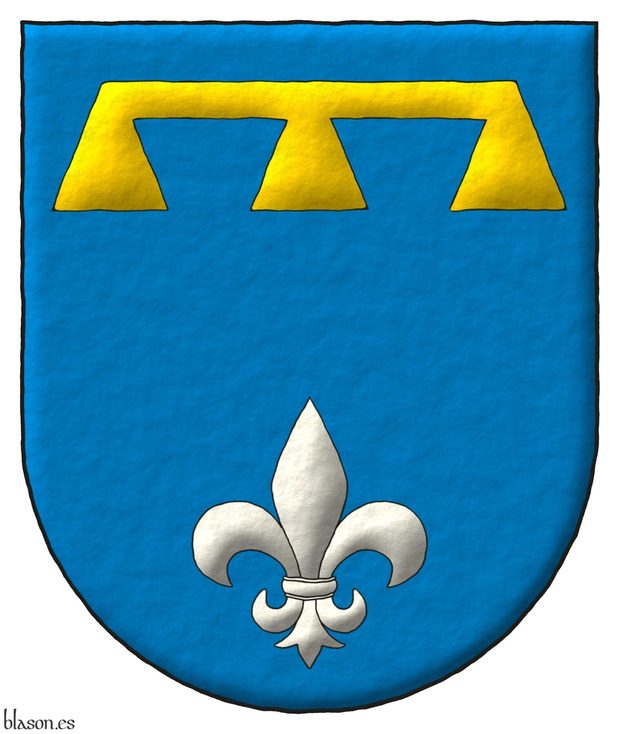
Azure, in chief a label Or, and in base a fleur de lis Argent.
Escudo de azur, en jefe un lambel de oro y en punta una flor de lis de plata.
Coat of arms painted by me, illuminated with lights and shadows, contoured in Sable, with a semi-circular outer contour and with a freehand finishing.
Coat of arms of the lineage Gangoiti emblazoned by me based on the description by [Cadenas y Vicent, V. de; 1987; page 770].
Blazon keywords: Azure, Or, Argent, One, In chief, Label, In base and Fleur de lis.
Style keywords: Outlined in sable, Illuminated, Semi-circular and Freehand.
Classification: Personal, Lineage, Interpreted, Boa and Coat of arms.
Bearer: Gangoiti, lineage.


Geoffrey Plantagenet
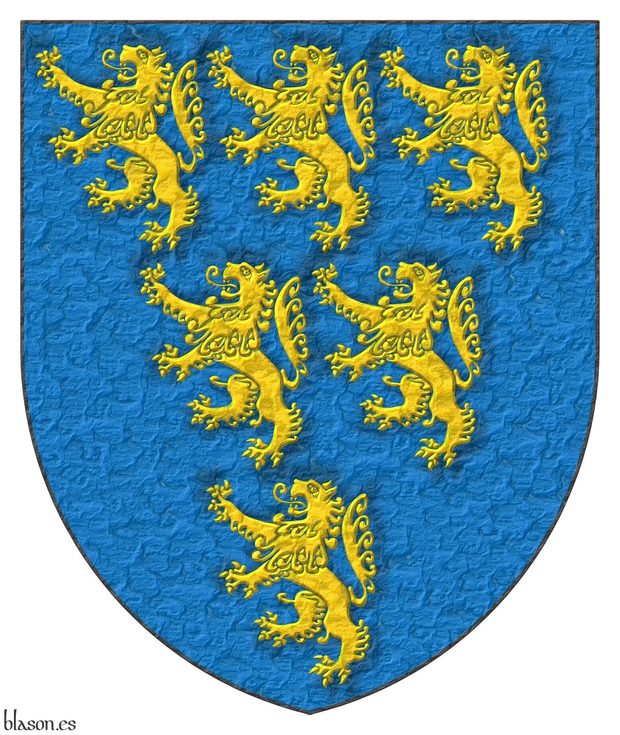
Azure, six lions rampant Or, 3, 2 and 1.
Escudo de azur, seis leones rampantes de oro, 3, 2 y 1.
Existing armories interpreted by me as follows: the shape of the shield is pointed; the field has been enameled in flat azure; the 6 lions are illuminated and cast shadows on the field; and the entire composition has a hammered metal finish.
The shield of Geoffrey V, Count of Anjou is considered the first documented coat of arms in history, dated to 1127, when Henry I of England gifted it to him on the occasion of his marriage to his daughter Matilda of England [The Heraldry Society; 2013].
There is no direct evidence that Henry I possessed a coat of arms, nor that it featured a rampant lion [Humphery-Smith, C.; 1983], but the gift of a shield with 6 lions to his future son-in-law could be an indication of such.
Geoffrey is buried in the Cathedral of Saint Julian in Le Mans, and his tomb is decorated with an enamel depicting him with his shield, where of his 6 lions: 4 are fully visible, and 2 are suggested by their claws.
However, it is possible that both the wedding gift narrative and the enamel on the tomb are from years after his death in 1151, so [Pastoureau, M.; Garvie, F.; 1997; page 18] asserts that «this account was written after Geoffrey's death... and his funerary enamel commissioned by his widow Matilda between 1155 and 1160... therefore it is possible that Geoffrey Plantagenet never had a coat of arms».
Blazon keywords: Without divisions, Azure, Six, Lion, Or, Rampant and Three, two and one.
Style keywords: Pointed, Illuminated, Shaded, Outlined in the field tincture and Metal beaten.
Classification: Interpreted, Personal, Coat of arms and House of Plantagenet.
Bearer: Godfrey V, Count of Anjou.


Georgia
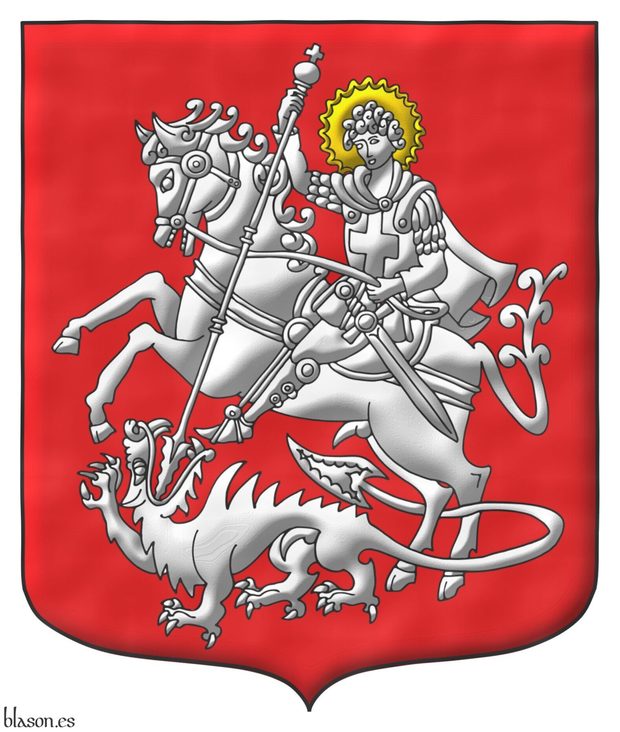
Gules, a Saint George nimbed Or, riding a Horse trampling upon a crawling Dragon, Argent.
Interpreted coat of arms: with a rounded and pointed shape; illuminated with metals or and argent and color gules; outlined with sable; and a Watercolor finish.
Blazon keywords: Without divisions, Gules, Saint George, Nimbed, Or, Horse, Dragon and Argent.
Style keywords: Ogee, Illuminated, Outlined in sable and Watercolor.
Classification: Coat of arms, Interpreted, Civic and State of Georgia.
Bearer: Georgia.


Germany, Federal Republic of

Or, a eagle displayed Sable, beaked, langued, armed and membered Gules.
Escudo de oro, un águila de sable, picada, lampasada, armada y membrada de gules.
Coat of arms painted by me, highlighted with lights and shadows, outlined in Sable, and with a freehand finish.
Coat of arms for the Federal Republic of Germany emblazoned by me.
Blazon keywords: Or, Sable, Gules, One, Eagle, Displayed, Beaked, Langued, Armed and Membered.
Style keywords: Outlined in sable, Illuminated and Freehand.
Classification: Civic, Interpreted, Boa and Coat of arms.
Bearer: Germany, Federal Republic of.


Giannelli and Mariana von Atzingen Gorga, Alessandro
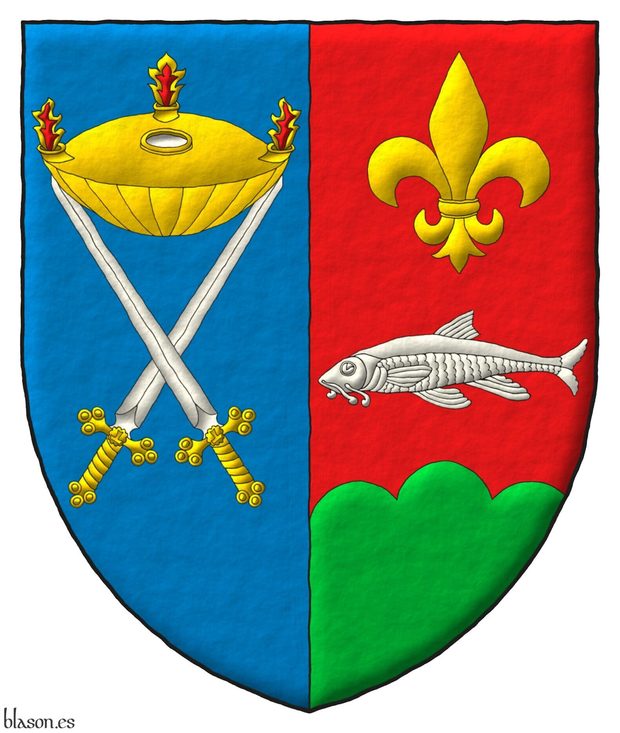
Party per pale: 1 Azure, on two swords in saltire Argent, hilted Or, an oil lamp (oleum lucerna) Or, its eyelet Argent, enflamed of three flames proper; 2 Gules, at the nombril, a barbel naiant Argent between in chief a fleur de lis Or, and in base a trimount Vert.
Escudo partido: 1o de azur, dos espadas en sotuer de plata, guarnecidas de oro sumadas de una lámpara de aceite (oleum lucerna) de oro, con su orificio de plata, encendida de tres llamas al natural; 2o de gules, en el ombligo, un barbo nadante de plata acompañado en jefe de una flor de lis de oro y en punta de un monte de tres peñas moviente de la punta de sinople.
Coat of arms painted by me, highlighted with lights and shadows, contoured in Sable, with a pointed outer contour and with a freehand finishing.
G0093, Chief Herald of Arms of Malta's grant for the coat of arms of Alessandro Giannelli and Mariana von Atzingen Gorga. This coat of arms has been emblazoned by me.
Blazon keywords: Azure, Argent, Or, Gules, Vert, Two, One, Party per pale, Sword, In saltire, Hilted, Oil lamp, Enflamed, Flame, Proper, At the nombril, Barbel, Naiant, Between, In chief, Fleur de lis, In base and Trimount.
Style keywords: Outlined in sable, Illuminated, Pointed and Freehand.
Classification: Personal, Interpreted, Boa and Coat of arms.
Bearer: Giannelli and Mariana von Atzingen Gorga, Alessandro.


Globe, Richard
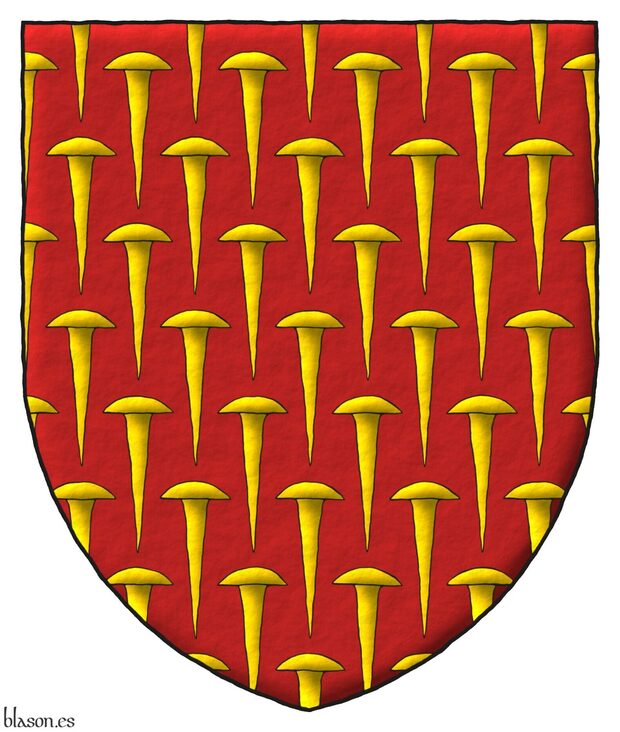
Sanguine semy of nails Or.
Escudo de sanguíneo sembrado de clavos de oro.
Coat of arms interpreted and emblazoned by me with a pointed shape, illuminated, and with a freehand finishing.
Blazon keywords: Without divisions, Sanguine, Semé, Nail and Or.
Style keywords: Freehand, Outlined in sable, Illuminated and Pointed.
Classification: Interpreted and Kingdom of Denmark.
Bearer: Globe, Richard.


González López, Manel
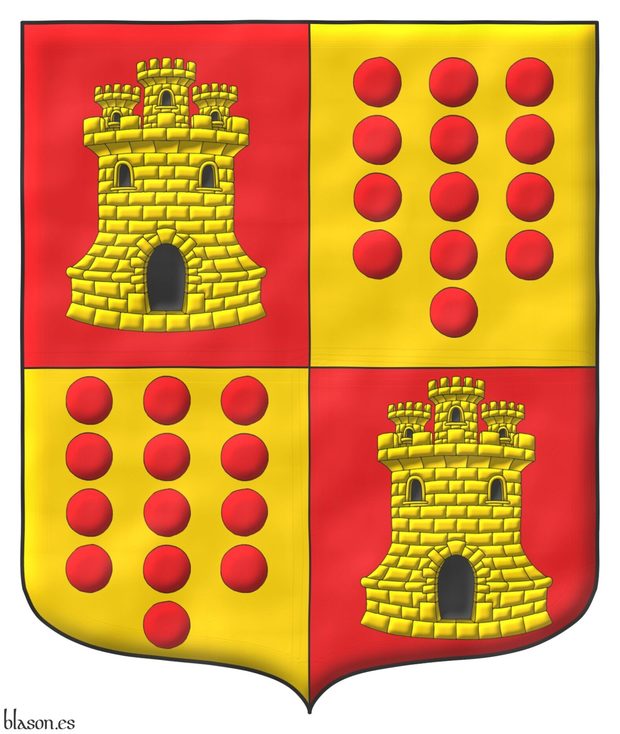
Quarterly: 1 and 4 Gules, a Castle triple towered Or, port, windows and masoned Sable; 2 and 3 Or, thirteen Torteaus, three, three, three, three, and one.
Escudo cuartelado: 1o y 4o de gules, un castillo de oro, aclarado y mazonado de sable; 2o y 3o de oro, trece roeles de gules, cuatro, cinco y cuatro.
I have interpreted this coat of arms with a pointed and rounded shape; tintures gules, or and sable; outlined with sable; and a watercolor finish.
The blazon in Spanish specifies the number of elements in each column and the blazon in English specifies the number of elements in each row.
Blazon keywords: Quarterly, Gules, One, Castle, Or, Port and windows, Masoned, Sable, Thirteen and Torteau.
Style keywords: Ogee, Watercolor and Outlined in sable.
Classification: Interpreted, Personal and Coat of arms.
Bearer: González López, Manel.


Granada, Soberana y Muy Noble Orden de la
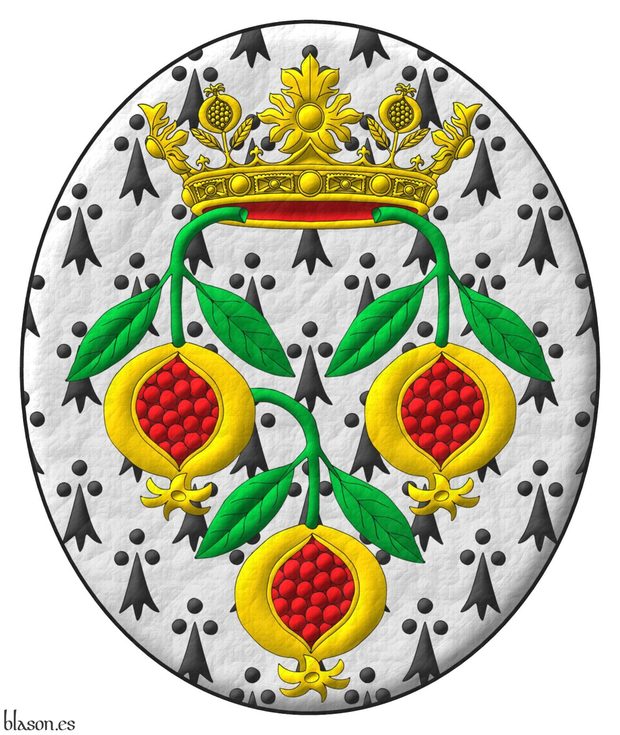
Ermine, three pomegranates inverted Or, seeded Gules, slipped and leaved Vert, ensigned with an open crown, alternating four rosettes of acanthus leaves, visible three, and four pomegranates Or, visible two, lined Gules.
Escudo de armiños, tres granadas ranversadas de oro, rajada de gules, talladas y hojadas de sinople, sumadas de una corona abierta, alternando cuatro rosetas de hojas de acanto, visibles tres, y cuatro granadas, visibles dos, todas de oro, forrada de gules.
Coat of arms emblazoned by me with an oval shape, illuminated, and with a leather finishing that seems watercolor.
Blazon keywords: Without divisions, Ermine, Three, Pomegranate, Reversed, Or, Seeded (pomegranate), Gules, Slipped, Leaved, Vert, On, One, Crown, Alternately, Four, Rosette of acanthus leaves, Visible, Two and Lined.
Style keywords: Outlined in sable, Oval, Illuminated and Leather.
Classification: Socioeconomic, Interpreted and Coat of arms.
Bearer: Granada, Soberana y Muy Noble Orden de la.


Gregorio Lanzagorta Llaguno, plain tincture
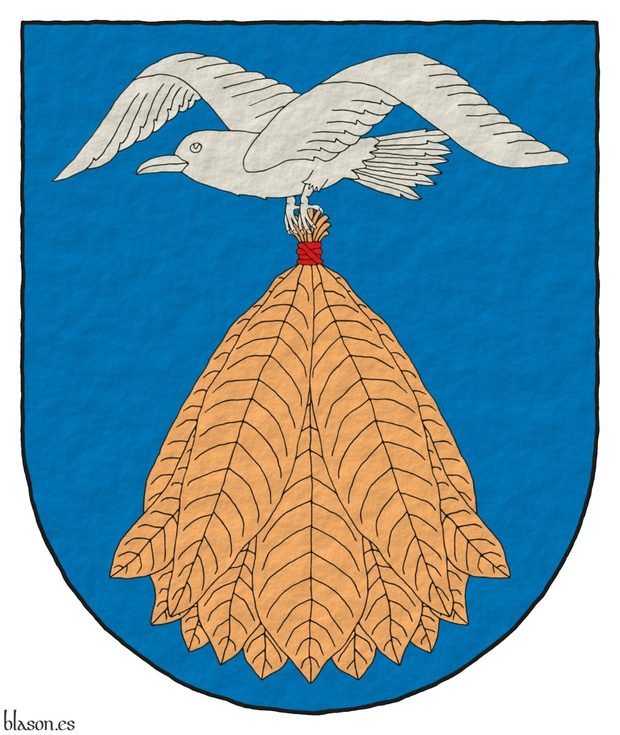
Azure, a seagull volant Argent, carrying in its feet a sheaf of tobacco proper, bound Gules.
Arms painted by me, in flat tinctures, outlined in Sable, with a semi-circular outer contour and with a texturized finishing.
The coat of arms of Gregorio Lanzagorta Llaguno, harbor of San Blas, and cigar maker in Nayarit, Mexico. This coat of arms was designed by Juan Lanzagorta Vallín and painted by me. Proper tinctures can be placed on both color and metal fields. For proper tinctures, the heraldic rule of tincture of colors and metals does not apply. However, contrast remains essential. For instance, an emerald proper on a Vert-green field is heraldically correct, but the green of the emerald will render it nearly invisible against the green field. While it's technically correct, it's best avoided. The following blazon is a heraldic joke regarding this principle «Argent, a polar bear proper», it's heraldically correct, but all white.
Blazon keywords: Azure, Argent, Gules, One, Seagull, Volant, Grasping, Foot (palmiped), Sheaf of tobacco, Proper and Bound.
Style keywords: Outlined in sable, Plain tincture and Semi-circular.
Classification: Personal, Interpreted, Boa and Coat of arms.
Bearer: Gregorio Lanzagorta Llaguno.


Gregory X
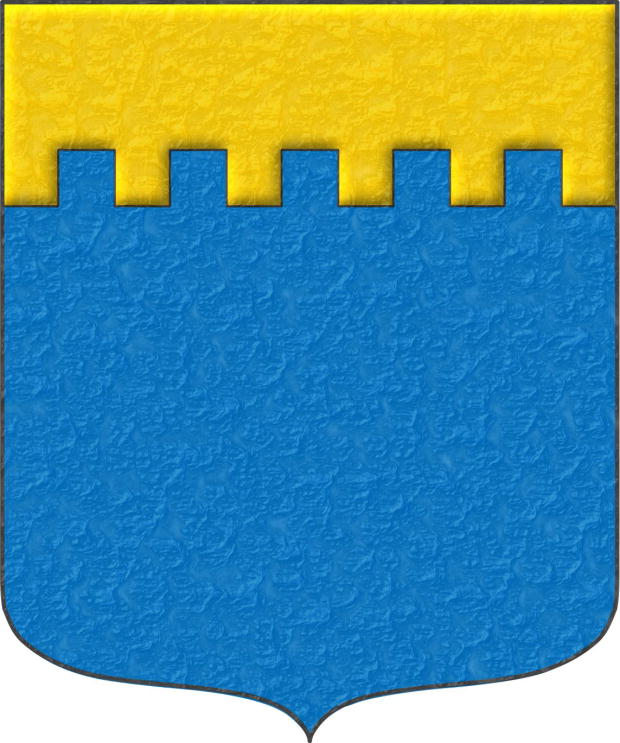
184th Pope of the Church, from 1271 to 1276. «Gregorius X», born Teobaldo Visconti, was born in Piacenza and convened the 14th Ecumenical Council, known as the Second Council of Lyon.
Azure, a chief embattled Or.
Escudo de azur, el jefe almenado de oro.
Papal coat of arms interpreted by me with: a pointed and rounded shield shape; the field in plain Azure; the chief embattled, illuminated in metal Or and outlined in Sable; and the whole with a marbled finish.
My first version of the blazon in English was «Azure, a chief Or, embattled», but Michael McCartney suggested that it was more correct as «Azure, a chief embattled Or».
Blazon keywords: Without divisions, Azure, Chief, Or and Embattled.
Style keywords: Ogee, Illuminated, Outlined in sable and Marmoreal.
Classification: Interpreted, Religious and Papal States.
Bearer: Gregory X.


Grimaldi, François
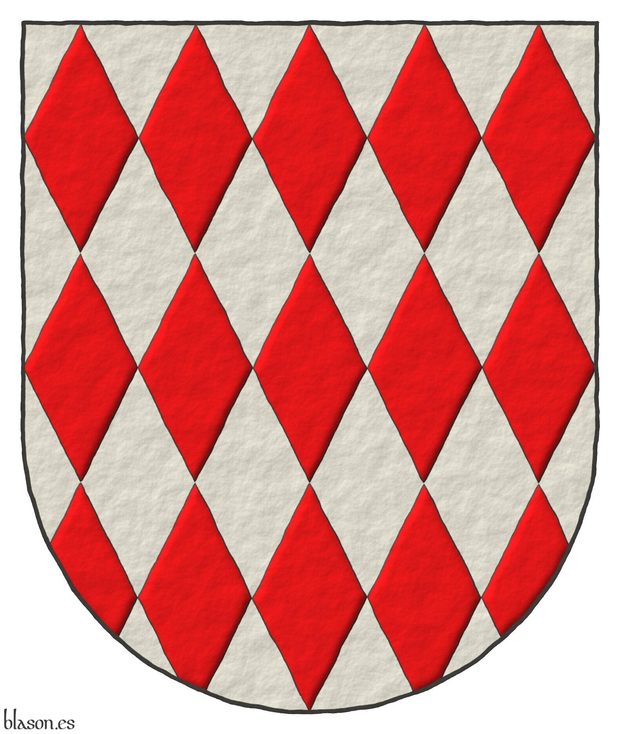
François Grimaldi ~ Francisco Grimaldi ~ Francesco Grimaldi.
Fusilly Argent and Gules.
Escudo fusado de plata y gules.
Coat of arms interpreted with: the semicircular base shape; the field of plain metal Argent; the fusils illuminated in Gules, outlined in Sable; the fusilly of proportion 3 x 5; and the whole with a raised-stroke effect.
Unlike how I have blazoned it here, this coat of arms can be found blazoned in [Arco y García, F. del; 1996b; page 10] as «Fusilly Argent and Gules».
He was the Genoese leader of the Guelphs who conquered the so-called Rock of Monaco on January 8, 1297, at night. To enter his fortress and have the gates opened for him, he dressed as a Franciscan monk along with his cousin Rainier I, Lord of Cagnes, and thus entered with his group of armed men. That is why the coat of arms of the Principality of Monaco has as supporters 2 Franciscan monks unsheathing their swords.
Francesco Grimaldi had no children, so after his death in 1309, he was succeeded by his cousin Rainier I, with whom he entered Monaco, and it is from Rainier I that the Grimaldi family and the Princes of Monaco who have governed the Principality ever since descend.
Blazon keywords: Fusilly, Argent and Gules.
Style keywords: Semi-circular, Illuminated, Outlined in sable and Freehand.
Classification: Interpreted and Personal.
Bearer: Grimaldi, François.


Gryffindor at Hogwarts
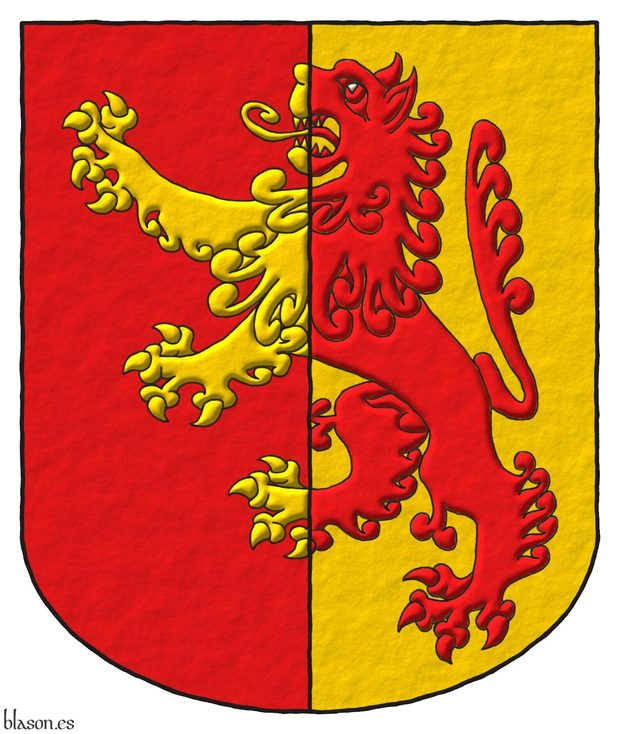
You might belong in Gryffindor, Where dwell the brave. It is their daring, nerve and chivalry that set Gryffindors apart.
Party per pale Gules and Or, overall a lion rampant counterchanged.
Escudo partido de gules y oro, un león rampante del uno al otro.
Imaginary arms of Gryffindor House made with the following characteristics: the mouth of the imaginary coat of arms is rounded; the shield is party per pale; the field is enameled in flat tinctures of Gules and Or; the lion is illuminated in Or and Gules and outlined in Sable; and the whole is finished with a raised-stroke effect.
The initial quote, next to the Hufflepuff coat of arms, is taken from [Rowling, J. K.; 1997] and corresponds to «You might belong in Gryffindor, Where dwell the brave at heart, Their daring, nerve and chivalry Set Gryffindors apart».
This imaginary coat of arms of the Gryffindor House at Hogwarts School of Witchcraft and Wizardry has been interpreted without taking much into account other of the multiple realizations that have been produced and disseminated.
Blazon keywords: Party per pale, Or, Gules, Lion, Rampant and Counterchanged.
Style keywords: Rounded, Illuminated, Outlined in sable and Freehand.
Classification: Interpreted, Imaginary, Coat of arms and Harry Potter saga.
Imaginary bearer: Gryffindor at Hogwarts.


Guebara of Navarre
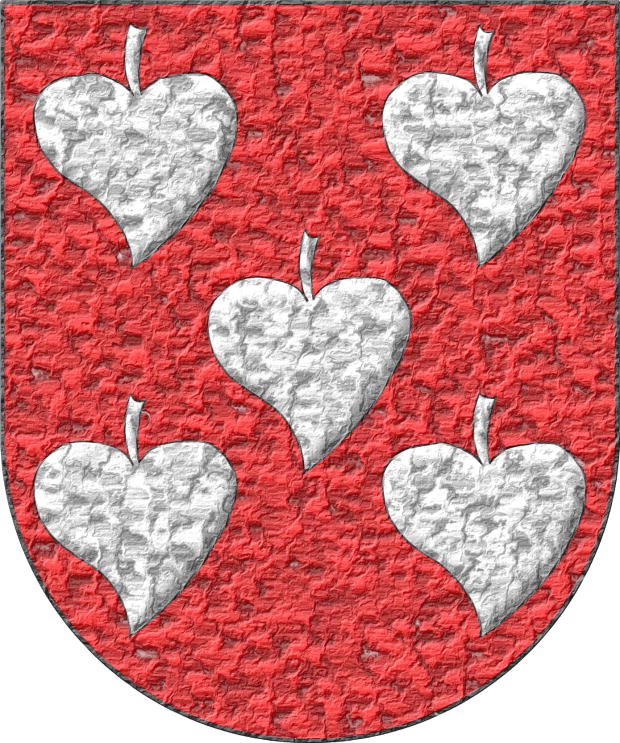
Of the twelve lineages of Noblemen, it is the second, descendant of Álava, the very ancient and powerful one, in which some served under Navarre, and others under the kings of Castile; they bear for arms and insignia, on a field Gules, which is red, five poplar-leaves (panelas) Argent, in the form and design in which this shield is painted.
Gules, five Poplar-leaves Argent, inverted.
Escudo de gules, cinco panelas de plata.
Coat of arms interpreted with: a semicircular (round) base; the field in flat Or; the pales outlined in Sable and illuminated in Azure enamel; and finished in highly-hammered metal.
Interpretation based on the second coat of arms of the «ricoshombres» of Navarre from [Bosque, J. del; 1540; folio 1 of the numbering of 1613] and the accompanying text is from the transcription made in [Martinena Ruiz, J. J.; 1982; pages 122 and 123].
The «panela» is a figure typical of Spanish heraldry [Valero de Bernabé, L.; 2007; page 11]. It is a leaf shaped like a heart with its stalk pointing upward. It could be a leaf of a tree such as, for example, the poplar, although there is no certainty that it is specifically that tree.
With first appearances prior to heraldry on Hispano-Roman tombstones, the «panela» is of Alavese origin, [Menéndez Pidal de Navascués, F.; 1985; page 474], spreading through the Basque-Navarrese region and from there throughout Spain, with the peculiar name «panela», which was initially called «pannella», [Valverde Ogallar, P. B.; 2001; page 532] derived from «pan», [Real Academia Española; 2001].
In the heraldry of other countries, leaves from different trees are used as heraldic symbols, but usually with the stalk pointing downward; therefore I transcribe in this blazon «panelas» ~ «Poplar-leaves, inverted».
[Menéndez Pidal de Navascués, F.; 1985; page 474] states that the «panela» is a natural figure equivalent to the linden leaf in German heraldry, with the stalk downward, and to the water-lily leaf in French heraldry, with the stalk upward; but since these are such different plants, I do not find it suitable to use linden, and even less water-lily, in the English transcription of this Navarrese blazon.
Under the title «Surname of Guebara» it can be consulted in [Vega, P. J. de; 1702; folio 2 of the manuscript].
Blazon keywords: Without divisions, Gules, Poplar leaf and Argent.
Style keywords: Semi-circular, Illuminated, Outlined in sable and Hard metal.
Classification: Interpreted, Personal and Kingdom of Navarre.
Bearer: Guebara of Navarre.


Hacienda de Triana
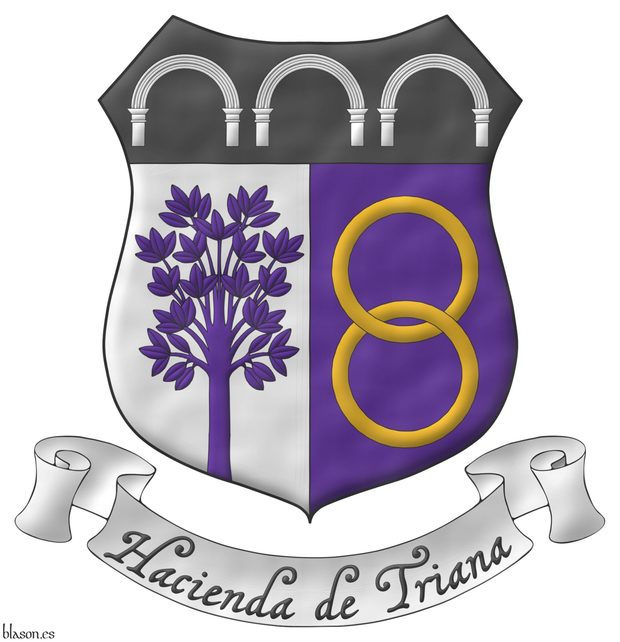
Party per pale: 1 Argent, a tree issuant from base Murrey; 2 Murrey; two annulets interlaced, in pale Or; in a chief Sable, three arches Argent. Motto: «Hacienda de Triana».
Escudo partido: 1o de plata, un árbol moviente de la punta de morado; 2o de morado, dos anilletes entrelazos, en palo de oro; en un jefe de sable, tres arcos de plata. Divisa: «Hacienda de Triana».
Arms depicted by me, highlighted with lights and shadows, with a chasuble outer contour and with a watercolor finish.
Blazon keywords: Sable, Argent, Murrey, Or, One, Two, Three, Party per pale, Tree, Issuant, Base, Annulet, Interlaced, In pale, Chief, Arch and Motto.
Style keywords: Illuminated, Chasuble and Watercolor.
Classification: Socioeconomic, Interpreted, Boa and Coat of arms.
Bearer: Triana, Hacienda de.


Harten, von

Azure, three plates, 1 and 2.
Escudo de azur, tres bezantes de plata, 1 y 2.
Coat of arms interpreted by me with a modern German / Scandinavian shape, illuminated and with a rough finishing.
Blazon keywords: Azure, Three, Bezant and plate, Argent and Disordered.
Style keywords: Outlined in sable, Rounded trapezoid, Illuminated and Rough.
Classification: Personal, Interpreted and Coat of arms.
Bearer: Harten, von.


Hatching technique for the arms of the Municipality of Candasnos

Party per fess, the base per pale: 1 Or, a hurt; 2 Gules and 3 Argent, over both a cross of Malta counterchanged.
Escudo cortado y medio partido: 1o de oro, un roel de azur; 2o de gules y 3o de plata, brochante sobre ambos, una cruz de Malta del uno al otro.
Arms interpreted by me, contoured in Sable, and with a texturized finish.
Coat of arms of the municipality of Candasnos, Huesca, designed by Valeriano Labara Ballestar, approved by the Government of Aragon. It has been an honor for me to emblazon this hatching version for Valeriano Labara. [Labara Ballestar, V. C.; 2019; pages 361] «The figure of the Balsa Buena has been represented symbolically and in a stylized manner through a roundel or torteau. This avoids any hint of naturalism, which is so contrary to the art and science of heraldry».
Blazon keywords: Or, Azure, Gules, Argent, One, Party per fess, the base per pale, Hurt, Eight-pointed cross, Cross couped and Counterchanged.
Style keywords: Outlined in sable and Hatching.
Classification: Civic, Interpreted, Design rationale, Boa and Coat of arms.
Bearer: Candasnos, municipality of.


Heidi Garcia-Bosch-de Morales-de Sola née Adriaensen
Party per pale: 1 Gules, a bend sinister debruised by an inescutcheon Or charged with a bend Azure charged with five fusils palewise Argent, in base on a triangle Argent the Sacred Heart of Jesus proper [for Adriaensen]; 2 Azure, a fleur de lis Argent above a doe sejeant proper surrounded by twelve mullets in orle Or [granted by Bourbon-Parma]. Crest: A crown of Noble. Motto: «Biche délicate».
Coat of arms emblazoned by me with a lozenge shape, illuminated, and with a free hand finishing.
G0084, Chief Herald of Malta's grant of Heidi Garcia-Bosch-de Morales-de Sola née Adriaensen's arms, whose full achievement has been emblazoned by me for such grant.
Blazon keywords: Party per pale, Gules, One, Bend sinister, Or, In base, Triangle, Argent, Charged, Sacred Heart of Jesus, Heart enflamed, Heart, Enflamed, Proper, Overall, Inescutcheon, Bend, Azure, Five, Fusil, Palewise, Doe, Sejant, Above, Fleur de lis, Surrounded, Twelve, Mullet, In orle, Crest and mantling, Crown of Noble, Crown, Motto and Scroll.
Style keywords: Outlined in sable, Illuminated, Freehand and Rhombus.
Classification: Personal, Interpreted, Coat of arms, Latin language and Doctor.
Bearer: Garcia-Bosch-de Morales-de Sola née Adriaensen, Heidi.


Heikki Halkosaari, plain tincture
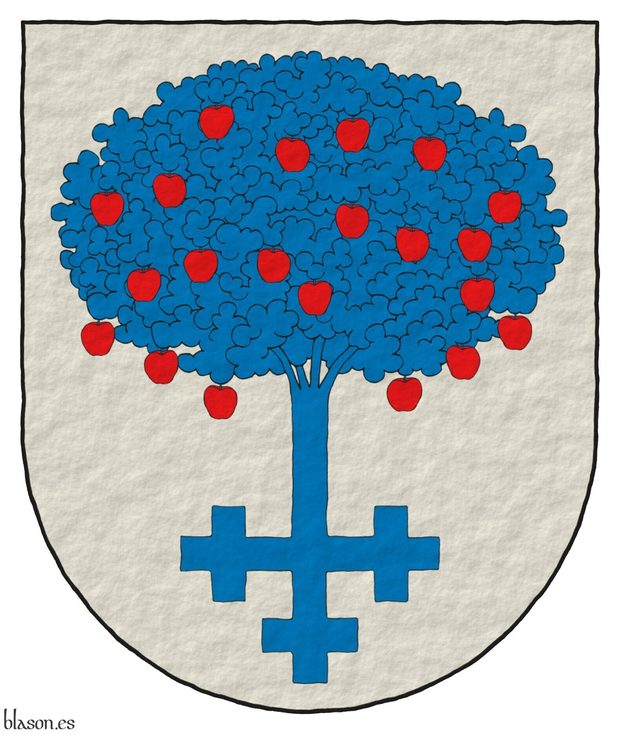
Argent, an apple tree, the base of its trunk forming a cross crosslet Azure, fructed Gules.
Arms interpreted by me, in flat tinctures, outlined in Sable, with a semi-circular outer contour and with a texturized finishing.
The coat of arms of Heikki Halkosaari, Finland, emblazoned by me.
Blazon keywords: Argent, Azure, Gules, One, Apple tree, Base, Trunk, Cross, Crosslet, Cross couped and Fructed.
Style keywords: Outlined in sable, Plain tincture and Semi-circular.
Classification: Personal, Interpreted, Boa and Coat of arms.
Bearer: Halkosaari, Heikki.


Henry II of England
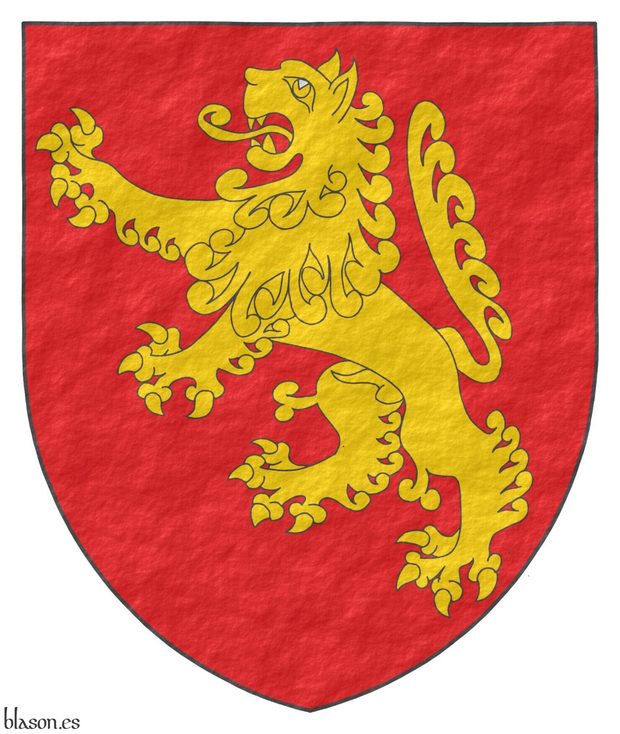
Henry II Plantagenet, King of England, Duke of Normandy, Duke of Aquitaine, Count of Anjou, Count of Maine, and Count of Nantes.
Gules, a lion rampant Or.
Escudo de gules, un león rampante de oro.
Existing arms interpreted by me as follows: the shield's shape is pointed; the field has been enamelled in flat Gules; the lion in Or has been outlined in Sable; and the whole composition has a rough texture finish.
It is believed that Henry I was the first King of England to have a coat of arms, featuring a single lion rampant, but no documentary evidence has yet been found [Rabbow, A.; 1999; paragraph 8].
[Ailes, A.; 1982; page 62] argues that Henry II may have used three different versions of his arms featuring a) a single lion rampant, b) two leopards, and c) three leopards. However, it remains unclear whether these versions were used sequentially over time or concurrently. For this interpretation, I have chosen the version with the lion rampant.
Blazon keywords: Without divisions, Gules, One, Lion, Or and Rampant.
Style keywords: Pointed, Plain tincture, Outlined in sable and Rough.
Classification: Interpreted, Coat of arms, Personal, House of Plantagenet and Kingdom of England.
Bearer: Henry II of England.


Henry III of England
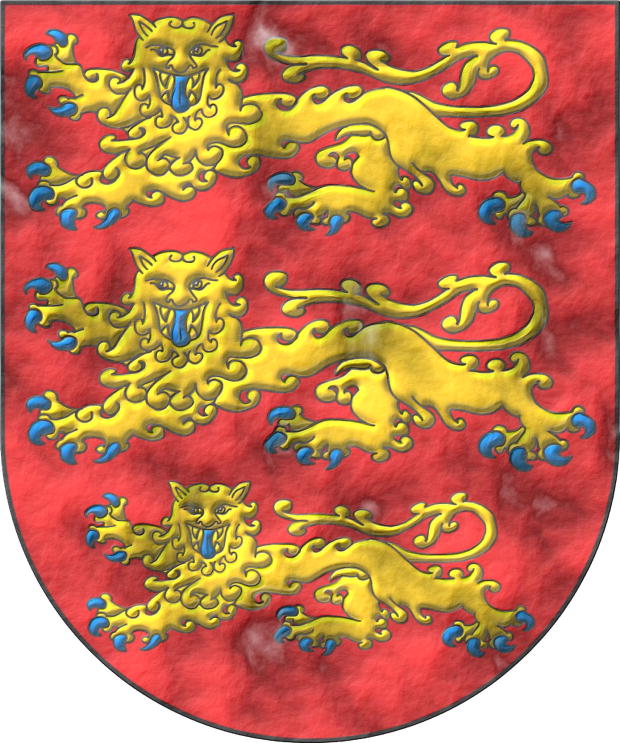
King of England, Lord of Ireland and Duke of Aquitaine from the year 1216 to the year 1272
Gules, three lions, passant, guardant, in pale Or, armed and langued Azure.
Escudo de gules, tres leopardos en palo de oro, armados y lampasados de azur.
Coat of arms interpreted as follows: the mouth of the shield is semicircular (round); its field has been enamelled in a flat tint of Gules; its leopards are illuminated in Or and Azure and outlined in Sable; and the whole has a finish of aged parchment.
Blazon keywords: Without divisions, Gules, Or, Azure, Three, Leopard, Armed, Langued and In pale.
Style keywords: Semi-circular, Illuminated, Outlined in sable and Old parchment.
Classification: Interpreted, Personal, Coat of arms, House of Plantagenet and Kingdom of England.
Bearer: Henry III of England.


Henry of Castile, Infante
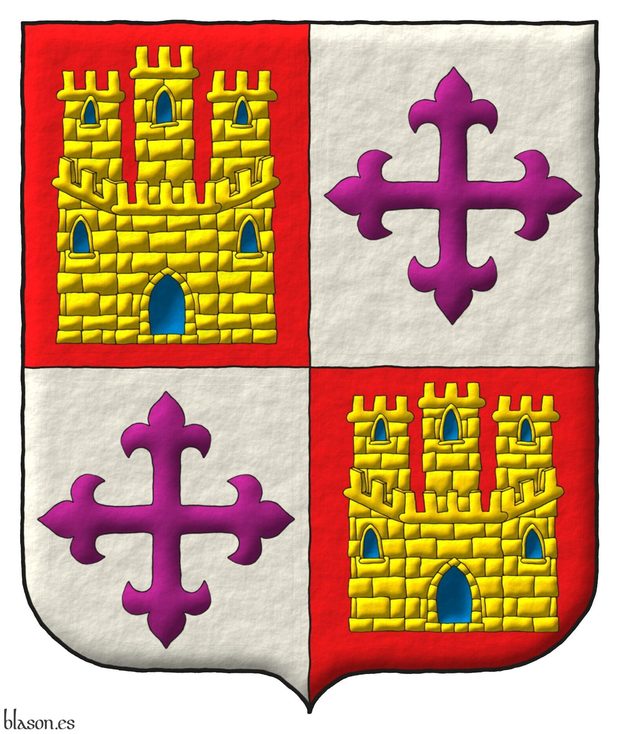
Quarterly: 1 and 4 Gules, a castle triple-towered Or, port and windows Azure, and masoned Sable; 2 and 3 Argent, a cross flory Purpure.
Escudo cuartelado: 1o y 4o de gules, un castillo de oro, aclarado de azur, mazonado de sable; 2o y 3o de plata, una cruz flordelisada de púrpura.
Arms depicted by me, highlighted with lights and shadows, outlined in Sable, with an ogee external shape and with a freehand finishing.
Coat of arms of the Infante Henry of Castile, 1230–1303, 6th offspring of the King Ferdinand III of Castile, 1199-1252, and the Queen Beatrice of Swabia, 1205–1235. He bore his father's arms, replacing the lion Purpure of the Kingdom of León with a cross flory Purpure, likely due to his close association with the Order of Calatrava, whose emblem is a cross flory Gules. However, he retained the metal Argent field in the 2nd and 3rd quarters and the lion's purple color, suggesting this was more of a conceptual change than a quartering by alliance with the Order of Calatrava.
Blazon keywords: Gules, Or, Azure, Sable, Argent, Purpure, One, Quarterly, Castle, Triple-towered, Port and windows, Masoned, Cross flory and Cross couped.
Style keywords: Outlined in sable, Illuminated, Ogee and Freehand.
Classification: Personal, Kingdom of Castile and Leon, Interpreted, Boa and Coat of arms.
Bearer: Henry of Castile, Infante.


Her Excellency Myriam Spiteri Debono, Xirka Gieh ir-Repubblika
Tierced per pale: 1 Or, upon a fess Azure a lion passant Gules holding a sword point upwards Argent [for Spiteri]; 2 Azure, upon a base Vert a tree eradicated proper, supported at sinister by a man proper wearing a loincloth Argent and holding in his sinister a spear point upwards Or and in chief three mullets of six points in fess Or [for Debono], 3 Gules, two hands clasped throughout proper, vested Argent, holding a dagger point upwards Argent, hilted Or, in chief three mullets of six points in fess Or and in base a sprig of olive fesswise proper [for Zammit]. The shield is surrounded by the Xirka Gieh ir-Repubblika, as Head of Orden.
Coat of arms emblazoned by me, highlighted with lights and shadows, outlined in Sable, with a pointed outer contour and with a leather finishing.
Personal coat of arms of Her Excellency Myriam Spiteri Debono, President of Malta, grant G0134 by Dr. Charles A. Gauci, Chief Herald of Arms of Malta. This coat of arms has been emblazoned by me.
Blazon keywords: Or, Azure, Gules, Argent, Vert, One, Three, Tierced per pale, Fess, Lion, Passant, Sword, Point upwards, Base, Tree, Eradicated, Proper, Sinister, Male figure, Loincloth, Spear, In chief, Mullet, In fess, Two hands clasped, Dagger, Hilted, In base, Sprig, Olive tree, Fesswise, Surrounded and Decoration.
Style keywords: Outlined in sable, Illuminated, Pointed and Leather.
Classification: Personal, Interpreted, Boa and Coat of arms.
Bearer: Spiteri Debono, Myriam.


![Ver [Heraldic blog of David B. Appleton] en enlaces recomendados. Áncora de oro y la divisa enlace.](../css/Ancora.Enlace.png)
Heraldic blog of David B. Appleton
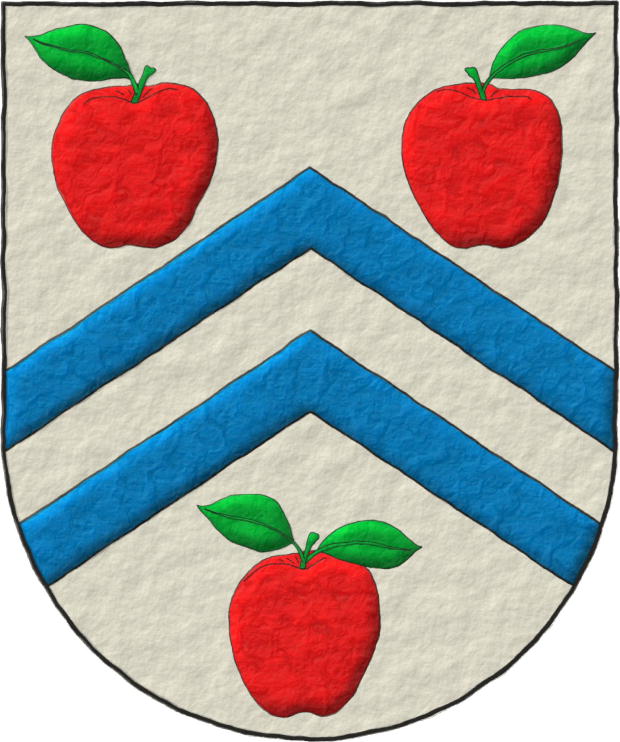
Appleton Studios
David B. Appleton studies, researches, teaches, and writes about heraldry, and through his blog, he shares his heraldic knowledge with us, as well as through publications and presentations.
David B. Appleton is open to questions from his readers and provides advice on heraldic topics in which he specializes.
His blog is Blog.AppletonStudios.com and his website is AppletonStudios.com, from which he offers his services related to the world of heraldry, its dissemination, and knowledge.
Since 2009, David B. Appleton's heraldic blog has been an endless source of knowledge, images, ideas, curiosities, original reflections, and links to heraldic sites selected by him.
Heraldry: Musing on an esoteric topic
David B. Appleton stands out for his continuous analysis of all types of heraldic manifestations, which he finds everywhere, in the world we live in: from those we have inherited from ancient times to the fiercely current, from books to cinema, from fashionable clothing to urban furniture, from east to west and north to south, including those that appear in logos and emblems, those using traditional techniques and those created or disseminated through new technologies, on ships, sports cars, and airplanes, on porcelain, facades, and stained glass, on television, on t-shirts and coins, in auctions and universities, in comics and sports, etc. with a systematic publication rhythm, more than 2 posts per week, nothing heraldic escapes the record and genuine analysis of David B. Appleton on Blog.AppletonStudios.com, which I highly recommend.
Categories: Link, Interpreted, Personal, Coat of arms, Without divisions, Freehand, Soft metal, Illuminated, Outlined in sable, Canting, Heraldry and heralds, Argent, Azure, Gules, Vert, Chevronel, Between, Apple, Slipped and Leaved.
External links:
- Interpretation of his coat of arms.
- Interpretation by Xavier García at Appleton Studios.
- Interpretation by Xavier García at Dibujo Heráldico with his blazon in English and Spanish.
Root: Appleton, David B..


Heraldic device of László Linnet Regina
Heraldic document for the arms of László Linett Regina. Her coat of arms has been created by her, and emblazoned by me, and this heraldic document has been edited, signed, sealed, and dated by me. The image shows 2 pages of this heraldic document.
Blazon keywords: Azure, Or, Argent, Three, One, Eight, Lightning flash, In pall, Debruised, Unicorn, Head, Couped, The eyes, Bordure and Fleur de lis.
Style keywords: Outlined in sable, Illuminated and Pointed.
Classification: Personal, Interpreted, Boa, Catalogue, Heraldic document and Frame.
Bearer: László Linnet Regina.


Hermanos Trujillo Jiménez, structured and parallel blazons
Blazon keywords: Without divisions, Purpure, Three, Dragon, Passant, In pale, Argent, One, Bordure, Gules, Eight, Saltire and Or.
Style keywords: Ogee, Outlined in sable, Illuminated and Watercolor.
Classification: Personal, Interpreted, Coat of arms and Structured and parallel blazons.
Bearer: Trujillo Jiménez, Hermanos.


Holy Trinity
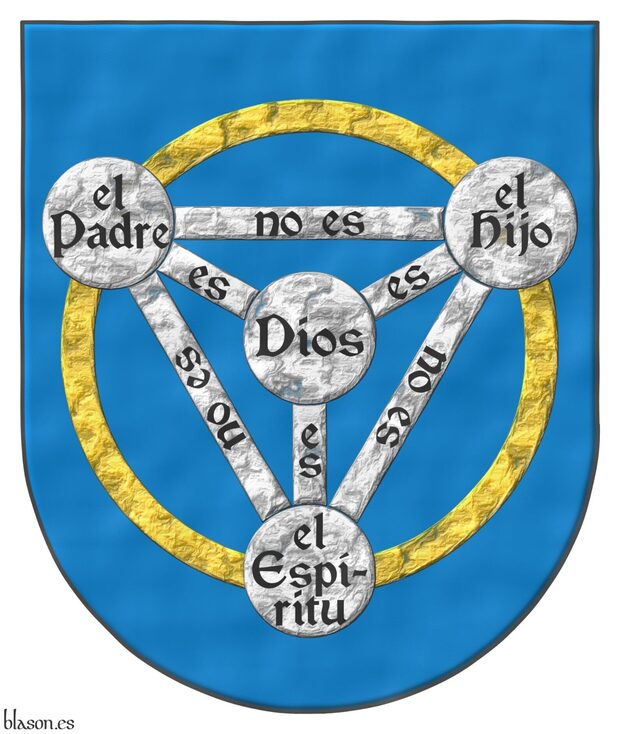
Azure, a pall couped Argent, its three arms charged with «es» Sable, within a triangle reversed Argent, its three arms charged with «no es» Sable, within an annulet Or, all debruised by four plates, three on the vertex of the triangle, in dexter chief, charged with «el Padre» Sable, in sinister chief, charged with «el Hijo» Sable, in base, charged with «el Espítiru» Sable, and one on the fess point, charged with «Dios» Sable.
Escudo de azur, una perla recortada de plata, sus tres brazos cargados con «es» de sable, dentro de un triángulo ranversado de plata, sus tres brazos cargados con «no es» de sable, dentro de un anillo de oro, todo resaltado de cuatro bezantes de plata, tres sobre los vértices del triángulo, en la diestra del jefe, cargado de «el Padre» de sable, en la siniestra del jefe, cargado con «el Hijo» de sable, en la punta, cargado con «el Espítiru» de sable y uno sobre el corazón, cargado con «Dios» de sable.
Imaginary coat of arms that I have interpreted as follows: its base is semicircular (round); its field is illuminated in watercolor Azure; the rest in heavily beaten metal, outlined of the field and illuminated in Argent, except for the annulet which is illuminated in Or; and its letters all in plain Gules ink.
Annulet
The circular crown when it is large and in the middle of the shield [Cadenas y Vicent, V. de; 1975] is called an annulet. [Avilés, J.; 1780a; pages 296 and 297] calls it annulet or small annulet depending on its size, if it is large an annulet and if it is small a small annulet. In English and French heraldry it is called «cyclamor» and hence the expression «cyclamor annulet» can also be found.
This annulet is my aesthetic contribution to this imaginary coat of arms as it is normally not represented with this annulet.
Bordure and Orle
In other interpretations the words «non est» go on a bordure or on an orle, the latter being the case blazoned, for example, [Husenbeth, F. C.; 1882; 2nd appendix] in the following way: «Gules, an orle and pall Argent, conjoined and surmounted of four plates, occupying the dexter and sinister chief and the base and fess points respectively; the first inscribed Pater, the second Filius, and the third Spiritus Sanctus, the centre Deus; the connecting portions of the orle between them having the words non est, and those of the pall est».
Blazon keywords: Without divisions, Azure, Cyclamor, Pall, Closed, Argent, Charged, Bezant and plate, Or, Dexter, Sinister, Chief, Base (lower 1/3) and Heart.
Style keywords: Semi-circular, Illuminated, Outlined in the field tincture, Watercolor and Hard metal.
Classification: Religious, Interpreted, Imaginary and Coat of arms.
Imaginary bearer: Holy Trinity.


House of Hohenzollern
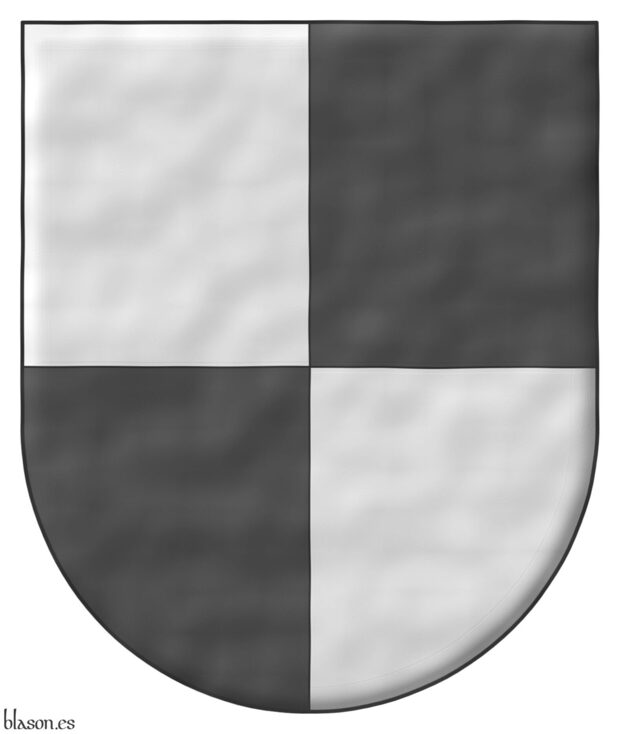
Royal and imperial German dynasty.
Quarterly Argent and Sable.
Escudo cuartelado de plata y sable.
Illuminated with lights and shadows and with a watercolor finish.
Blazon keywords: Quarterly, Argent and Sable.
Style keywords: Watercolor, Outlined in sable, Illuminated and Semi-circular.
Classification: Interpreted.
Bearer: House of Hohenzollern.


Howel ap Res

Howel Ap Rhys ~ Howel ap Res.
Gules, a chevron Argent, between three mullets Argent.
Escudo de gules, un cabrio de plata, acompañado de tres estrellas de cinco puntas de plata.
Included in [Vincent, MS; 1285; number 623] also known as [St. George's Roll; 1285; number 623].
The coat of arms of Howel Ap Rhys is the inverse of the coat of arms of Adan de Creeting.
Blazon keywords: Without divisions, Gules, One, Chevron, Argent, Between, Three and Mullet.
Style keywords: Semi-circular, Plain tincture and Outlined in sable.
Classification: Interpreted and Personal.
Bearer: Howel Ap Rhys.
Blazon equivalent to: Juan le Sturmy.


Hradec Králové Region
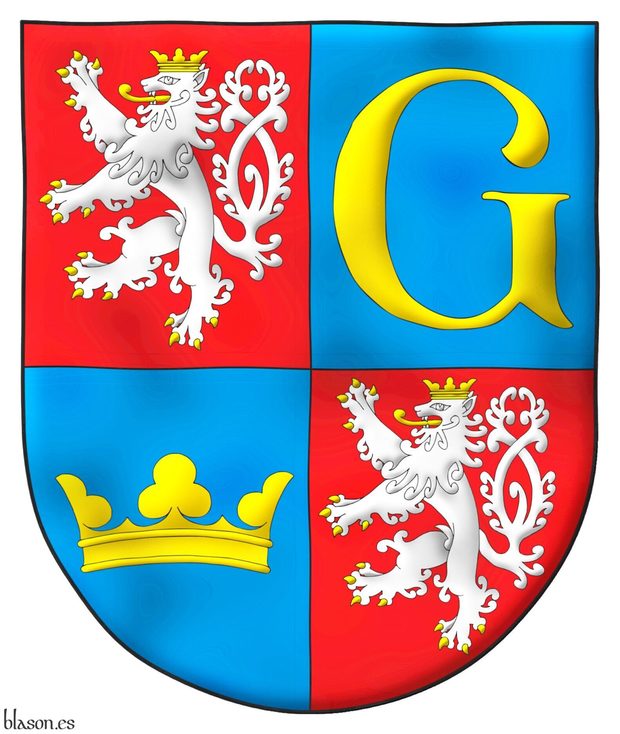
Quarterly: 1 and 4 Gules, a lion rampant, double queued Argent, armed, langued, and crowned Or; 2 Azure, a letter «G» Or; 3 Azure, a coronet trefoiled Or
Escudo cuartelado: 1o y 4o de gules, un león rampante, de cola horquillada de plata, armado, lampasado y coronado de oro; 2o de azur, una letra «G» de oro; 3o de azur, una corona trebolada de oro
This coat of arms is illuminated with lights and shadows and has a finish like glass.
The Hradec Králové Region is an administrative unit of the Czech Republic. It is located in the historical region of Bohemia. Its capital is Hradec Králové, whose Latin name is «Gradicium», hence its old name «Gradec». The letter «G» seen in both the coat of arms of the Hradec Králové Region and the coat of arms of its capital originates from this historical name. The lion rampant Anrgent, double queued and crowned in the 1st and 4th quarters is the symbol of Bohemia, and it also appears in the 1st and 4th quarters of the coat of arms of the Czech Republic. «Králové» means «of the queen» in Czech and there is a trefoiled crown in the 3rd quarter
Blazon keywords: Quarterly, Gules, One, Lion, Rampant, Tail, Double queued, Argent, Armed, Langued, Crowned, Or, Azure, Letter, Coronet trefoiled, Ancient coronet, Crown and Trefoiled.
Style keywords: Glass, Outlined in sable, Illuminated and Semi-circular.
Classification: Civic and Interpreted.
Bearer: Hradec Králové Region.


Hufflepuff at Hogwarts
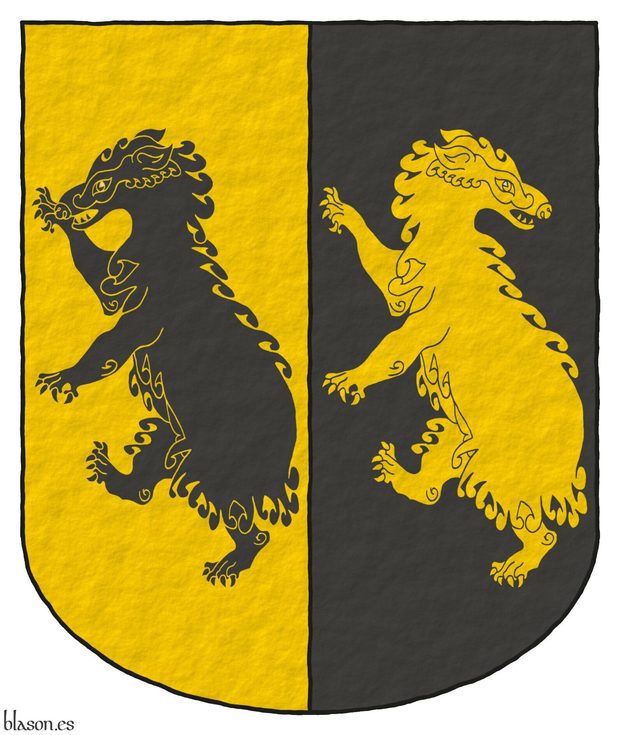
Hard work, patience, justice, and loyalty.
Party per pale: 1 Or, a badger rampant Sable; 2 Sable, a badger rampant, regardant Or.
Escudo partido: 1o de oro, un tejón rampante de sable; 2o de sable, un tejón rampante, contornado de oro.
Imaginary arms of the student House Hufflepuff at Hogwarts School of Witchcraft and Wizardry, made with the following differential characteristics compared to other representations: the mouth of the coat of arms is rounded; the shield is party per pale; the field and the badgers are enameled in flat tinctures of Sable and Or; the badgers, facing Dexter and Sinister, are outlined by the field; and the whole is finished with a raised-stroke effect.
This imaginary coat of arms of the Hufflepuff House at Hogwarts has been interpreted without taking much into account other of the multiple realizations that have been produced and disseminated.
Blazon keywords: Party per pale, Or, Sable, Badger, Rampant and Regardant.
Style keywords: Rounded, Plain tincture, Outlined in the field tincture and Freehand.
Classification: Interpreted, Imaginary, Coat of arms and Harry Potter saga.
Imaginary bearer: Hufflepuff at Hogwarts.


IESE, University of Navarra
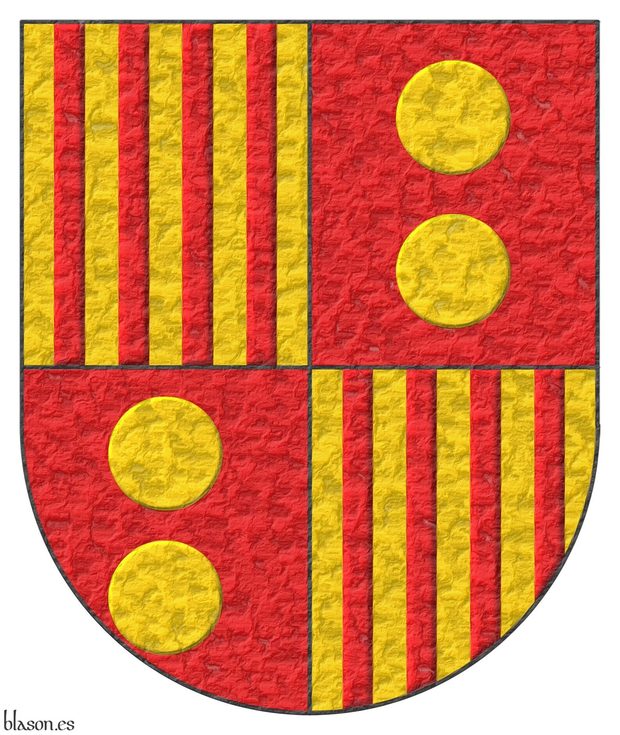
Quarterly: 1 and 4 Or, four pallets Gules; 2 and 3 Gules, two bezants in pale.
Escudo cuartelado: 1o y 4o de oro, cuatro palos de gules; 2o y 3o de gules, dos bezantes en palo de oro.
Coat of arms of IESE interpreted by me as follows: the shield has a semicircular (round) base; the field is illuminated in flat tinctures Or and Gules; the eight pales and the four bezants are illuminated in Gules and Or; and the whole coat of arms has a beaten metal finish.
IESE was founded in 1958 under the name Institute of Higher Business Studies, it is the business management school of the University of Navarra and is currently known as IESE Business School.
Blazon keywords: Quarterly, Gules, Or, Pale, Bezant and plate and In pale.
Style keywords: Semi-circular, Illuminated and Metal beaten.
Classification: Interpreted, Socioeconomic, Education and Coat of arms.
Bearer: IESE.


Ignasi Pujol, comparation
[ Azure, a mount issuant from the base, in chief a fleur the lis Argent ] and [ Party per chevron Azure and Or, in chief a fleur de lis Argent, in base four pallets Gules ].
The coat of arms of Ignasi Pujol was designed by him based on the ancient arms of the Pujol lineage, 1st image, and refined and emblazoned by me, 2nd image. The comparison of the blazon of the Pujol lineage with the blazon for Ignasi Pujol is the following.
Blazon keywords: Azure, Argent, Or, Gules, One, Mount, Issuant from base, In chief, Party per chevron, Fleur de lis, In base, Pallet and Pale.
Style keywords: Outlined in sable and Illuminated.
Classification: Lineage, Personal, Compare, Interpreted, Coat of arms and Boa.
Bearer: Pujol, Ignasi.


Infante Manuel of Castile, ratios

Quarterly: 1 and 4 Gules, a hand Carnation, embowed, vambraced and winged Or, holding a sword point upwards Argent, hilted Or; 2 and 3 Argent, a lion rampant Purpure, armed and langued Gules. Crest: An open royal crown.
Coat of arms of the Infante Manuel of Castile, 1234–1283, 7th son of the King Ferdinand III of Castile, 1199-1252, and the Queen Beatrice of Swabia, 1205–1235. This coat of arms has been delineated with proportions by me.
Blazon keywords: Gules, Or, Argent, Purpure, One, Quarterly, Hand, Arm, Vambraced, Embowed, Winged, Sword, Point upwards, Hilted, Lion, Rampant, Armed, Langued, Crest, Open royal crown and Crown.
Style keywords: Ratio, Outlined, Outlined in sable and Ogee.
Classification: Personal, Kingdom of Castile and Leon, Interpreted, Boa and Coat of arms.
Bearer: Manuel of Castile, Infante.


Innocent IV
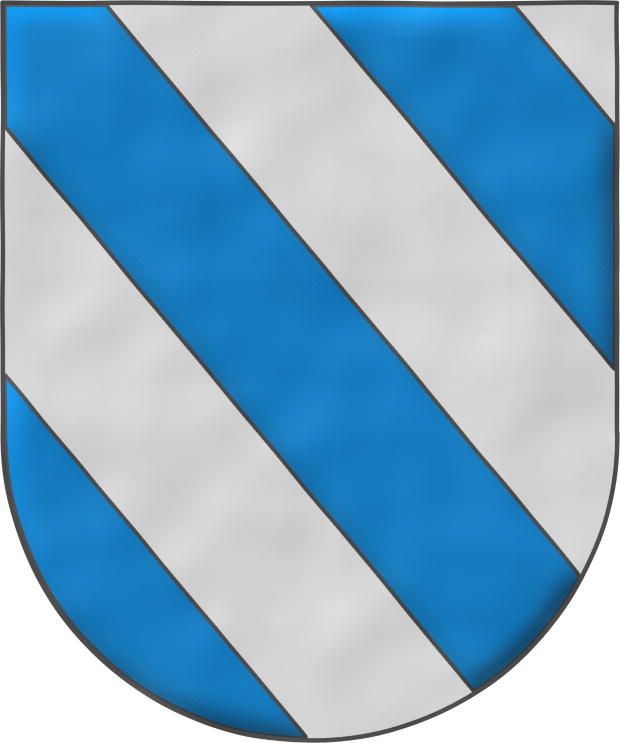
180th Pope of the Church, from 1243 to 1254. «Innocentius IV», born Sinibaldo dei Fieschi, was born in Manarola in northwest Italy.
Bendy of six Azure and Argent.
Escudo bandado de seis piezas de azur y plata.
Papal coat of arms interpreted by me with: a semicircular shield shape; a plain Argent field; bands illuminated in Azure and outlined in Sable; and the whole design with a watercolor finish.
Order of tinctures
In the bendy pattern, the tinctures are named starting from the one located at the dexter base of the shield and following an ascending sequence towards the sinister chief, although the most orthodox approach is to have only 2 tinctures, being one color and one metal.
Number of bands
It is said that it is not necessary to specify the number of bands when there are precisely 6, as in this case, and that it should be specified when there are, for example, 4 or 8. I have chosen to specify it for greater clarity of the blazon.
About the bendy pattern and the need to specify or not specify the number of its pieces, [Avilés, J.; 1725a; pages 40 and 41] and [Avilés, J.; 1780a; pages 45 and 46] say that it is «composed of four, six, or eight bends; in such a way that there are as many colors as metals, always specifying the number four and eight bands when blazoning, and not the one composed of six, as it is understood thus, without declaring the number of pieces» and without agreeing with it, and by its wording I believe that he is not entirely in agreement either, he adds «the reason that may exist for not specifying the number of six bends (although the authors do not express it) is that as the bend is one-third of the shield; and having six pieces, or six bends, the resulting number is doubled, as if the three parts were divided, which implies that the shield is filled with three bends; and taking the denomination of the figure infers, that the bendy is of six pieces: which does not happen with this equality in those of four and eight, requiring other proportions and consequently it becomes necessary to specify their number», therefore, note that the bendy of 6 does not follow the proportions of the bend, nor do those of 4 or 8, the only differential property of the one of 6 is being a multiple of 3, being 1/3 the width of the bend.
Blazon keywords: Without divisions, Bendy, Six, Azure and Argent.
Style keywords: Semi-circular, Illuminated, Outlined in sable and Watercolor.
Classification: Interpreted, Religious and Papal States.
Bearer: Innocent IV.


Ireland

Azure, a harp Or, stringed Argent
Escudo de azur, un arpa de oro, cordada de plata
Illuminated and a leather finishing.
Blazon keywords: Without divisions, Azure, One, Harp, Or, Stringed and Argent.
Style keywords: Leather, Outlined in sable, Illuminated and Ogee.
Classification: Civic, Republic of Ireland, Interpreted and Coat of arms.
Bearer: Ireland.


ISCH Certification for Rolando Yñigo-Genio
The Commoners' Certification of Arms for Rolando Ýñigo-Genio, arms designed by him and emblazoned by me.
Or, six fleurs de lis in orle, five Gules and one in chief Azure. Motto: «Vade Plvs Vltra».
Credits:
- Rolando Yñigo-Genio is the designer of the coat of arms.
- Antonio Salmerón y Cabañas is the author of the heraldic art.
Blazon keywords: Or, Six, Fleur de lis, Orle, Five, Gules, One, Azure, In chief and Motto.
Classification: Interpreted, Personal, Certification and Heraldic document.
Bearer: Yñigo-Genio, Rolando.


Israel
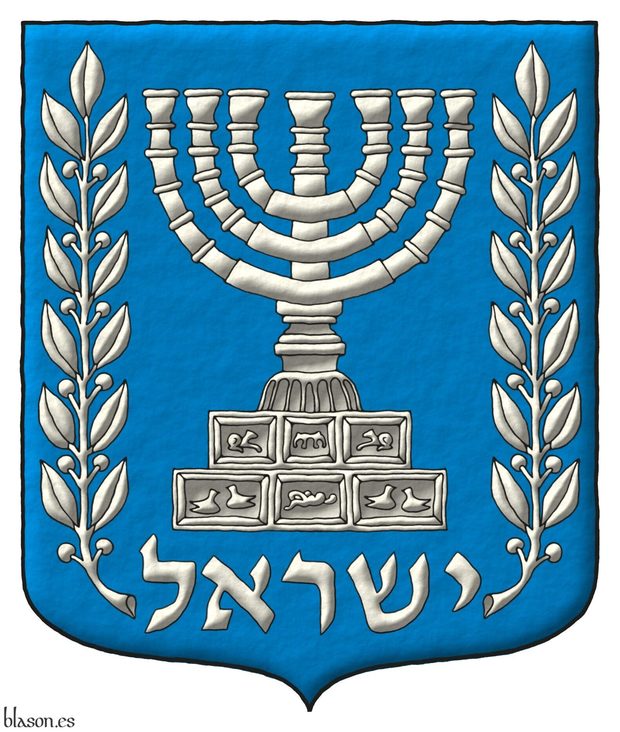
Israel~ישראל.
Azure, a Menorah between two olive branches Argent; in base the legend
«ישראל» Argent.
Interpreted coat of arms: with a rounded and pointed shape; illuminated with metal argent and color azur; outlined with sable; and a Watercolor finish.
Blazon keywords: Without divisions, Azure, One, Menorah, Argent, Accosted, Two, Branch, Olive tree, Tree and Motto (identification).
Style keywords: Ogee, Illuminated, Outlined in sable and Freehand.
Classification: Coat of arms, Interpreted, Civic and State of Israel.
Bearer: Israel.


James de Sottone, le Fitz

James de Sutton ~ James de Sottone, le Fitz.
Ermine, a canton Sable.
Escudo de armiños, un cantón de sable.
Included in [Vincent, MS; 1285; number 599] also known as [St. George's Roll; 1285; number 599].
Blazon keywords: Without divisions, Ermine, One, Canton and Sable.
Style keywords: Semi-circular and Illuminated.
Classification: Interpreted and Personal.
Bearer: Jaime de Sutton.


James I of Aragon
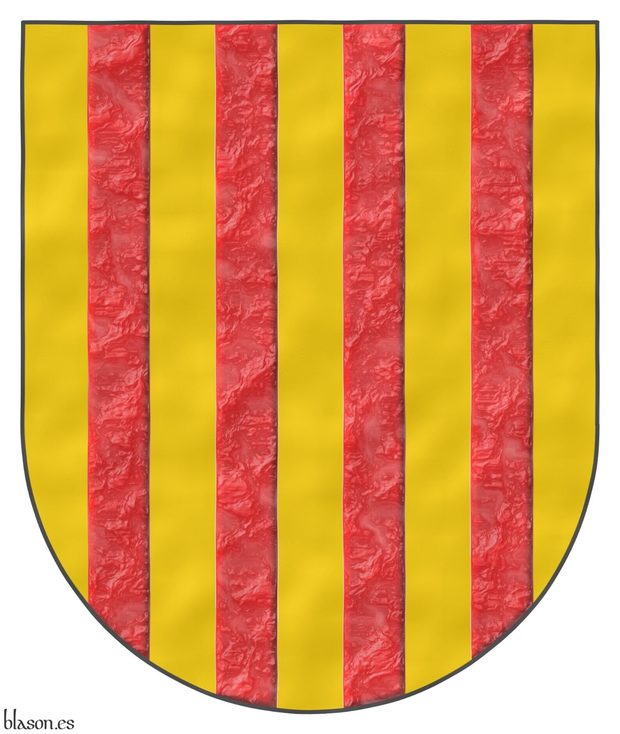
King of Aragon, Valencia and Majorca, Count of Barcelona, Count of Urgell, Lord of Montpellier and known as the Conqueror
Or, four pallets Gules.
Escudo de oro, cuatro palos de gules.
Coat of arms interpreted by me as follows: the escutcheon shape is semicircular; the field is rendered in flat Or with a watercolored effect; and the pallets are illuminated and finished with a crystalline texture.
A semicircular-shaped shield of Aragon can be seen, for instance, in [Argote de Molina, G.; 1588; chapter XLII].
This shield, but with a pointed base, appears in the second part of the armorial [Wijnbergen; 1265; shield no. 1,293], under the title «Le roy Darragon». This second part was compiled between 1270 and 1285 and, since James I was king of Aragon from 1213 to 1276, it could refer to him; although it might also refer to his son Peter III, the Great, who succeeded James I in 1276.
This coat of arms is also the arms of Aix-en-Provence, granted to that French city, according to tradition, by Alfonso II of Aragon [Aix-en-Provence; 1351], grandfather of James I, the Conqueror.
Blazon keywords: Without divisions, Or, Four, Pale and Gules.
Style keywords: Semi-circular, Illuminated, Watercolor and Crystalline.
Classification: Interpreted, Personal, Coat of arms and Kingdom of Aragon.
Bearer: James I of Aragon.


James II of Urgell

Known as the Unfortunate, Count of Urgell, Viscount of Àger, Baron of Fraga, Antillón and Alcolea de Cinca (1380–1433).
Dimidiated: 1 Or, four pallets Gules; 2 chequey Or and Sable.
Escudo dimidiado: 1o de oro, cuatro palos de gules; 2o ajedrezado de oro y sable.
Arms interpreted with: a shield shape of convex-sided triangles; the tinctures of the pallets and the chequey are flat gold, gules and sable; and the whole design has a heavily hammered metal finish.
James II of Urgell, 1380–1433, known as the Unfortunate, Count of Urgell, Viscount of Àger, and Baron of Fraga, Antillón and Alcolea de Cinca, was one of the main claimants to the throne after the death of Martin I of Aragon. His rejection of the Compromise of Caspe led to his defeat and imprisonment.
Blazon keywords: Dimidiated, Pale, Chequey, Or, Gules and Sable.
Style keywords: Triangular curved, Plain tincture and Hard metal.
Classification: Interpreted, Personal, Coat of arms and Kingdom of Aragon.
Bearer: James II of Urgell.


Jamilena, province of Jaen
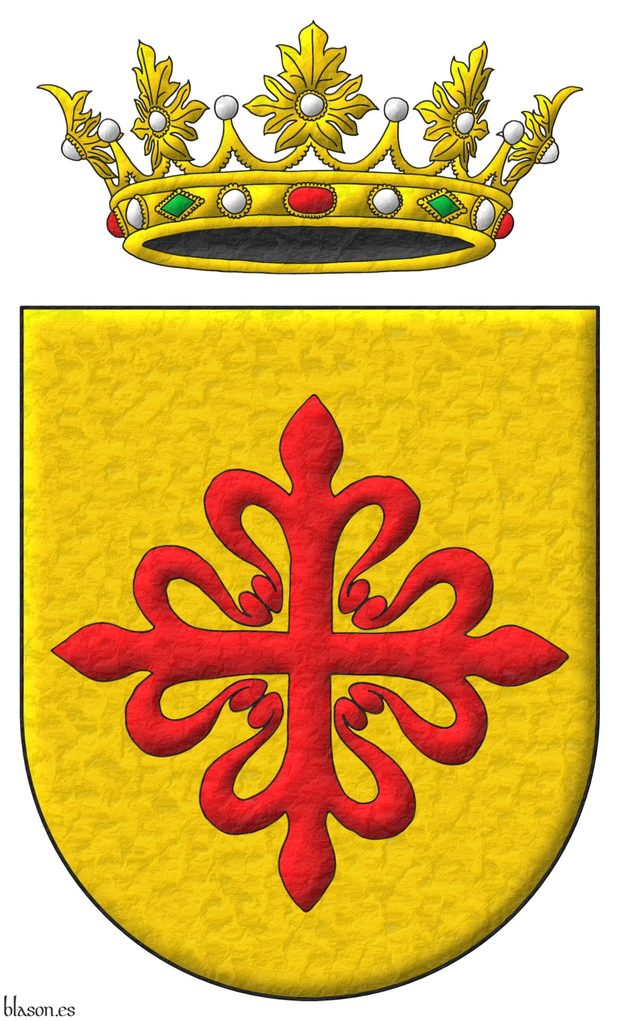
Or, a cross of Calatrava. Crest: An open royal crown Or.
Escudo de oro, una cruz de Calatrava. Timbrado de una corona real abierta.
Coat of arms interpreted as follows: the shield's shape is a semicircular arch; the field is illuminated in metal Or; the cross of Calatrava is outlined in Sable and illuminated in Gules; the royal crown is open, outlined in Sable and illuminated in metal Or, pearls in Argent, gemstones in Gules and Vert, and the visible base hollow in Sable; and the entire piece has a slightly hammered metal finish.
The municipality of Jamilena belongs to the La Campiña region and is the smallest in the province of Jaén. I have depicted its coat of arms with an open royal crown, but representations with a closed royal crown can also be found.
The origin of the cross of Calatrava in its heraldic coat of arms dates back to the year 1525 when Emperor Charles V issued several decrees from Toledo to build a convent for nuns in Jamilena. For the construction of this convent, stones from the Muslim castle, which was reformed and occupied by the Order of Calatrava, were used.
Blazon keywords: Without divisions, Or, Cross of Calatrava, Cross couped, Cross, Crest, Open royal crown and Crown.
Style keywords: Semi-circular, Illuminated, Outlined in sable and Soft metal.
Classification: Interpreted, Civic and Coat of arms.
Bearer: Jamilena.


Janovsti of Janovic of Czechia, lineage
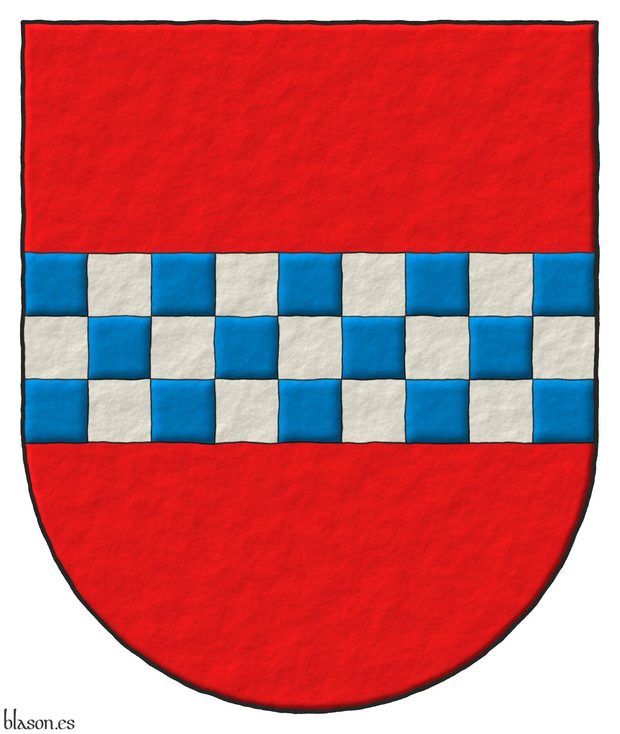
Gules, a fess chequey Azure and Argent.
Escudo de gules, una faja ajedrezada de azur y plata.
Arms emblazoned by me, highlighted with lights and shadows, contoured in Sable, with a semi-circular outer contour and with a freehand finish.
Coat of arms of the lineage Janovsti of Janovic of Czechia. It is also the coat of arms of the lineage Klenovsky of Klenove of Czech. I have emblazoned it with a fess chequy of 3 rows, symmetric and with 9 columns of squares, provided that its height is 1/3 of the width of the coat of arms.
Blazon keywords: Gules, Azure, Argent, One, Three, Nine, Fess and Chequey.
Style keywords: Outlined in sable, Illuminated, Semi-circular and Freehand.
Classification: Personal, Lineage, Interpreted, Boa and Coat of arms.
Bearer: Janovsti of Janovic of Czechia, lineage.
Blazon equivalent to: Lindsay of Scotland, lineage.


Javier Fernández-Cortés y Fonseca, nobleza de Asturias

Escudo cuartelado: 1o y 4o de azur, cinco bezantes de oro en sotuer; 2o y 3o de oro, tres corazones de gules ordenados. Timbrado de un yelmo de plata; lambrequines de azur doblados de oro; y burelete de oro y azur; cimado de un león rampante de oro, lampasado y armado de gules. Pendiente de la punta la insignia del Cuerpo de la Nobleza del Principado de Asturias.
Blazon keywords: Quarterly, Azure, Five, Bezant, Bezant and plate, In saltire, Or, Three, Heart, Gules, Ordered, Crest and mantling, Helm, Argent, Mantling, Wreath, Lion, Rampant, Langued, Armed, Suspended, Base (lower 1/3) and Decoration.
Style keywords: Freehand, Semi-circular, Illuminated and Outlined in sable.
Classification: Coat of arms, Interpreted and Personal.
Bearer: Fernández-Cortés y Fonseca, Javier.


Jean Mortés, schema 1x2
Azure, a tower Or, embattled and masoned Sable, overall a lion rampant barry Purpure and Argent.
Coat of arms of Jean Mortes from Brittany, France, emblazoned by me in 2 steps: an outline drawing and flat colors and metals.
Blazon keywords: Azure, Or, Sable, Argent, Purpure, One, Tower, Embattled, Masoned, Overall, Lion, Rampant and Barry.
Style keywords: Outlined, Outlined in sable and Plain tincture.
Classification: Personal, Interpreted, Schema, Boa and Coat of arms.
Bearer: Mortés, Jean.


Jean-Baptiste Bessières, structured and parallel blazons
Blazon keywords: Quarterly, Azure, One, Lion, Rampant, Or, Argent, Falcon, Rising, Grasping, Claw, Serpent, Sable, Tower, Port and windows, Masoned, Gules, Fox, Passant, Chief, Semé, Mullet, Five and Base (lower 1/3).
Style keywords: Ogee, Outlined in sable, Illuminated and Watercolor.
Classification: Personal, Interpreted, Coat of arms and Structured and parallel blazons.
Bearer: Bessières, Jean-Baptiste.


Jean-Christophe Loubet del Bayle, schema
Or, a wolf passant Gules; on a chief Gules, three bells Or. Crest: Upon a helm with a wreath Or and Gules, a demi-wolf Gules supporting with both paws an armillary sphere Or. Mantling: Gules doubled Or. Motto: «Varia vivendi cupidus».
The coat of arms of Jean-Christophe Loubet del Bayle designed by him emblazoned by me. The image shows the geometric structure used to arrange the heraldic elements in harmony.
Blazon keywords: Or, Gules, One, Three, Wolf, Passant, Chief, Bell, Crest, Upon (wreath), Helm, Wreath, Demi, Supporting, Paw, Armillary sphere, Mantling and Motto.
Style keywords: Ratio, Outlined in sable, Illuminated and Semi-circular.
Classification: Personal, Interpreted, Schema, Boa and Coat of arms.
Bearer: Loubet del Bayle, Jean-Christophe.


Jesus Christ, preparation schema

Schema for an imaginary coat of arms that will have the following characteristics: its base will be semicircular (round); it will contain a closed pearl charged with four bezants; and it will be differenced by a label of three points, which being three is normal, its number will not be specified in the blazon.
Label
The way to elaborate a label can be found in [Avilés, J.; 1780a; page 248] who writes that «it is made of a fillet, which is the ninth part of the latitude of the Chief with three points in the form of a Carpenter's wedge, or of badly formed triangles, which united to it without separation of lines, fall twice as much, as the fillet is wide, the two being placed at its ends, and one in its middle, its ordinary situation being in the middle of the length of the Chief itself, without reaching the edges of the Shield».
Label points
In [Avilés, J.; 1780a; pages 248 and 249] it is said that «the simple Label is always of three points», as is the case at hand, «but having 4, 5, or 6, which is the greatest number found, it is necessary to specify it», although in [Avilés, J.; 1780a; page 114] he seems to consider that the maximum is five as he writes «Points, it is said of three, four and up to five points of the Labels».
Blazon keywords: Without divisions, Pall, Closed, Charged, Bezant and plate, Dexter, Sinister, Chief, Base (lower 1/3), Heart and Label.
Style keywords: Semi-circular.
Classification: Religious, Schema, Interpreted and Imaginary.
Imaginary bearer: Jesus Christ.


Joan de Okinton

John de Octon ~ Joan de Okinton.
Or, three cinquefoils Gules.
Escudo de oro, tres quinquefolios de gules.
Included in [Vincent, MS; 1285; number 620] also known as [St. George's Roll; 1285; number 620].
Blazon keywords: Without divisions, Or, Three, Cinquefoil, Gules and Ordered.
Style keywords: Triangular curved, Illuminated, Outlined in sable and Freehand.
Classification: Interpreted and Personal.
Bearer: Juan de Octon.


John Berry

Sir John Berry, Admiral of the Royal Navy
Or, three fesses Gules.
Escudo de oro, tres fajas de gules.
Coat of arms interpreted as follows: the top of the shield is pointed; its field has been painted in flat Or; its fesses have been outlined in Sable and illuminated in Gules; and the whole set has a pearly finish.
The arms of John Berry, and therefore those of Berry of Molland, are equivalent to those of Pope Clement V and to the Castilian arms of Diego Fernández de Córdoba y Carrillo.
Blazon keywords: Without divisions, Or, Fess and Gules.
Style keywords: Pointed, Illuminated, Outlined in sable and Iridescent (nacar).
Classification: Interpreted, Personal and Army and Navy.
Bearer: Berry, John.


John de Beauchamp
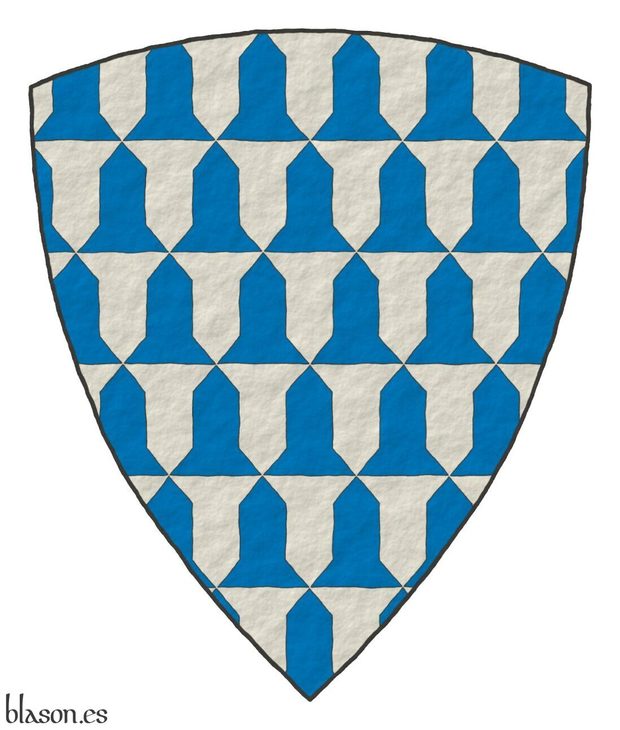
Joan de Beauchamp ~ John de Beauchamp.
Vair.
Escudo de veros.
Interpreted coat of arms, the shape of the shield is triangular and curved plain tinctures metal Argent and color Azure, outlined in sable; and a free hand finishing.
Included in [Vincent, MS; 1285; number 64] also known as [St. George's Roll; 1285; number 64].
Blazon keywords: Without divisions, Vair, Argent and Azure.
Style keywords: Triangular curved, Plain tincture and Outlined in sable.
Classification: Interpreted and Personal.
Bearer: Juan de Beauchamp.


John de Ladbrooke
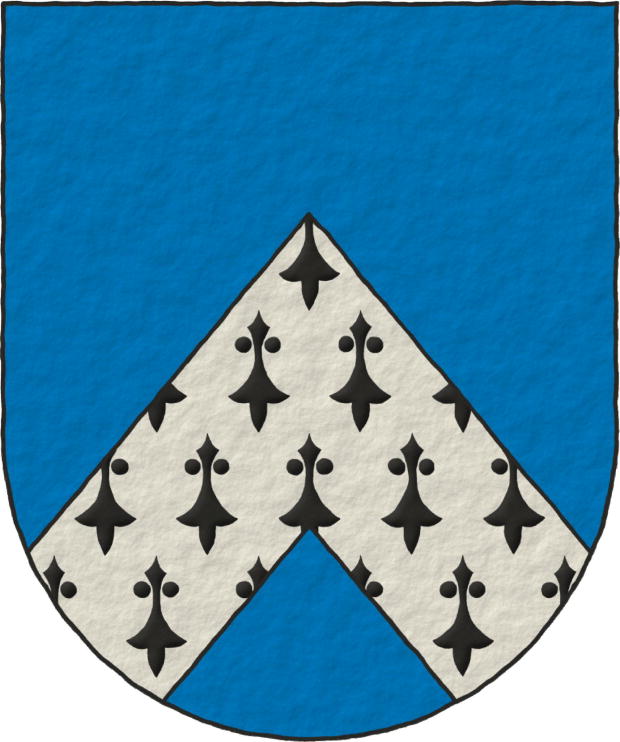
John de Ladbrooke ~ Joan de Lodbroke.
Azure, a chevron Ermine.
Escudo de azur, un cabrio de armiños.
Included in [Vincent, MS; 1285; number 662] also known as [St. George's Roll; 1285; number 662].
Blazon keywords: Without divisions, Azure, One, Chevron and Ermine.
Style keywords: Semi-circular, Illuminated and Outlined in sable.
Classification: Interpreted and Personal.
Bearer: Juan de Ladbrooke.


John Lackland
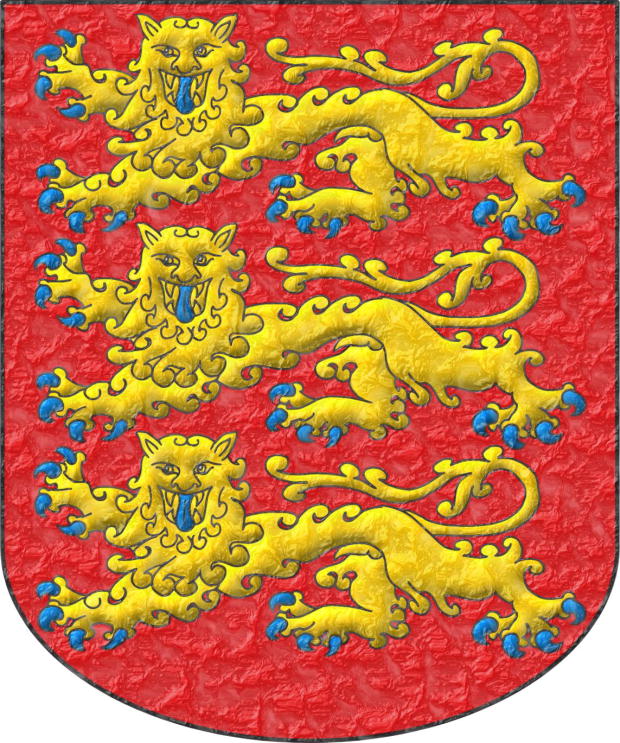
King of England and Lord of Ireland from 1199 to 1216.
Gules, three lions, passant, guardant, in pale Or, armed and langued Azure.
Escudo de gules, tres leopardos en palo de oro, armados y lampasados de azur.
Arms of King John interpreted with: a rounded (semicircular) base; the field enamelled with a flat tint of Gules; the leopards illuminated in Or and Azure, outlined in Sable, all three of the same size; and the whole finished with a crystalline effect.
Blazon keywords: Without divisions, Gules, Or, Azure, Three, Leopard, Armed, Langued and In pale.
Style keywords: Rounded, Illuminated, Outlined in sable and Crystalline.
Classification: Interpreted, Personal, Coat of arms, House of Plantagenet and Kingdom of England.
Bearer: John I of England.


John le Sturmy

Juan le Sturmy ~ Joan le Strumi ~ John le Sturmy.
Gules, a chevron Argent, between three Mullets Argent.
Escudo de gules, un cabrio de plata, acompañado de tres estrellas de cinco puntas de plata.
Included in [Vincent, MS; 1285; number 664] also known as [St. George's Roll; 1285; number 664].
Blazon keywords: Without divisions, Gules, One, Chevron, Argent, Between, Three and Mullet.
Style keywords: Pointed, Plain tincture and Outlined in sable.
Classification: Interpreted and Personal.
Bearer: Juan le Sturmy.
Blazon equivalent to: Howel Ap Rhys.


John Stuart, schema 2x3
Or, a fess chequey Argent, charged with an ermine spot, and Azure, between in chief two cross patty Gules, in base a thistle proper; a diminished bordure Azure.
The coat of arms of Reverend John Stuart, XVIII century, emblazoned by me in 3 approaches: 1) Classic bordure: Using a bordure with a width equal to 1/6 of the coat of arms' base. In the image, this is marked with texts and lines in Vert. Notice that the squares in columns 2 and 8 are split by the inner border of the bordure, which is unfortunate as it disrupts the design. 2) Diminished bordure: Using a narrower bordure with a width equal to 2/3 of the classic bordure, corresponding to 1 square of the fess chequey. In the image, this is marked with texts and lines in Gules. This approach avoids splitting any squares, allows for larger figures, and is my preferred solution. In England, diminished bordures, often simply blazoned as bordure, are more common than in Castile. 3) Without squares splitted: Retaining the classic bordure but shifting the fess chequey 1/2 square to either dexter or sinister to prevent splitting squares. However, this sacrifices the symmetry of the design. This last adjustment was used in the hatchment of Reverend John Stuart in St. George's Cathedral, Kingston, Ontario, 1785.
Blazon keywords: Or, Argent, Azure, One, Three, Nine, Two, Fess, Chequey, Charged, Ermine spot, Between, In chief, Cross, Patty, In base, Thistle, Proper and Diminished bordure.
Style keywords: Ratio, Outlined in sable, Illuminated, Semi-circular and Freehand.
Classification: Personal, Interpreted, Schema, Boa and Coat of arms.
Bearer: Stuart, John.


John XXI

187th Pope of the Church, from 1276 to 1277. «Johannes XXI», born Pedro Julião, also known as Pedro Hispano, born in Lisbon, Portugal.
Quarterly: 1 and 4 Argent, three crescents Gules; 2 and 3 Sable, two pallets Or.
Escudo cuartelado: 1o y 4o de plata, tres crecientes de gules; 2o y 3o de sable, dos palos de oro.
Coat of arms with: a shield with a pointed and rounded top; the field in plain Argent and Sable; the figures outlined in Sable and illuminated in Gules and Or; and the whole in an elevated line style.
John XXI should have actually been John XX, but Cardinal Pedro Julião, upon being elected pope, decided to skip the number XX and called himself John XXI, with the aim of correcting what was believed to be a historical error, which in the end was not so.
This historical error consisted of the belief in the existence of 2 popes named John XIV, as seemed to be deduced from the records of the «Liber Pontificalis». They were therefore referred to as: the 1st John XIV and the 2nd John XIV bis.
By skipping the number XX, John XXI believed he was correcting this historical error. But the reality is that there was only one Pope John XIV, the same pope with 2 entries in the «Liber Pontificalis», the 1st entry during the time of his pontificate in freedom and the 2nd entry for the time he exercised his pontificate in prison, imprisoned by his enemy, the so-called «antipope» Boniface VII, who, in turn, managed to occupy the papal throne twice, separated by a decade, in 974 and in 984, somewhat like a double «antipope».
Therefore, John XXI, instead of correcting a historical error, made one, and for this reason, there is no Pope John XX in all of history, nor can there ever be one.
Blazon keywords: Quarterly, Argent, Three, Crescent, Gules, Ordered, Sable, Two, Pale and Or.
Style keywords: Ogee, Illuminated, Outlined in sable and Freehand.
Classification: Interpreted, Religious and Papal States.
Bearer: John XXI.


Jon Sneddon, arms on tartan
Argent, three lozenges Sable; on a chief wavy Azure, three snowflakes Argent.
Heraldic device emblazoned by me, highlighted with lights and shadows, outlined in Sable, with a semi-circular external shape and with a watercolor finishing.
The coat of arms of Jon Sneddon emblazoned by me over his personal tartan registered in the Scottish Register of Tartans. John Sneddon designed his tartan with the help of Elliot Nesterman.
Blazon keywords: Argent, Sable, Azure, Three, Lozenge, Chief, Charged, Wavy, Snowflake and Ordered.
Style keywords: Outlined in sable, Illuminated, Semi-circular and Watercolor.
Classification: Personal, Interpreted, Boa and Tartan.
Bearer: Sneddon, Jon.


Jonathan Pons Paneque

Quarterly: 1 and 4 Gules, a three arch bridge issuant from base and throughout Or; 2 and 3 Azure, five fleurs de lis, in base two bars wavy Or.
Coat of arms emblazoned by me with a shape ended with an rounded arch, illuminated, and its finishing is that seems leather.
These arms were designed by Felipe Trujillo Jimenez as a derivation of the primitive arms of Pons and Peneque lineages. The Pons lineage has canting arms: «Or, a three arch bridge issuant from base and throughout Sable». The blazon of the ancient arms of Paneque lineage is: «Azure, five fleurs de lis Or, in base two bars Argent».
Credits:
- Felipe Trujillo Jiménez is the designer of the coat of arms.
- Antonio Salmerón y Cabañas is the author of the heraldic art.
Blazon keywords: Quarterly, Gules, One, Bridge, Issuant from base, Throughout, Or, Azure, Five, Fleur de lis, In base, Two, Fess and Wavy.
Style keywords: Pointed, Outlined in sable, Illuminated and Leather.
Classification: Personal, Interpreted and Coat of arms.
Bearer: Pons Paneque, Jonathan.


José Manuel Villauriz Álvarez, schema 1x3
Or, a badger rampant Sable.
Coat of arms of Jose Manuel Villauriz Alvarez, emblazoned by me in 3 steps: outlined, plain color and metal, and lights and shadows. A heraldic artwork made under the directions of Alfonso Ceballos-Escalera Gila, Cronista de Armas de Castilla y Leon.
Blazon keywords: Or, Sable, One, Badger and Rampant.
Style keywords: Outlined, Outlined in sable, Plain tincture, Illuminated and Semi-circular.
Classification: Personal, Interpreted, Boa and Coat of arms.
Bearer: Villauriz Álvarez, José Manuel.


Juan Lanzagorta Aras, plain tincture

Party per pale bendy wavy Azure and Or and bendy wavy Azure and Argent, overall three fish naiant in pale Argent.
Arms painted by me, in plain tinctures, contoured in Sable, with a semi-circular external shape and with a texturized finishing.
Coat of arms of Juan Lanzagorta Aras designed by Juan Lanzagorta Vallín and emblazoned by me. Note that the second quarter begins and ends in Argent; therefore, while the first quarter is properly bendy, having an even number of bands and beginning in Or and ending in Azure, the second is not, as it has an odd number. It is almost impossible to align both quarters so that the wavy bands continue seamlessly from one to the other. Heraldically, such continuity is not required, but artistically it makes much more sense. For this reason, in this case, I chose to prioritize the artistic criterion of continuity, even if the second quarter ends with a small strip of Argent instead of finishing in Azure.
Blazon keywords: Azure, Or, Argent, Three, Party per pale, Bendy, Wavy, Overall, Fish, Naiant and In pale.
Style keywords: Outlined in sable, Plain tincture and Semi-circular.
Classification: Personal, Interpreted, Boa and Coat of arms.
Bearer: Lanzagorta Aras, Juan.


Juan Lanzagorta Vallín
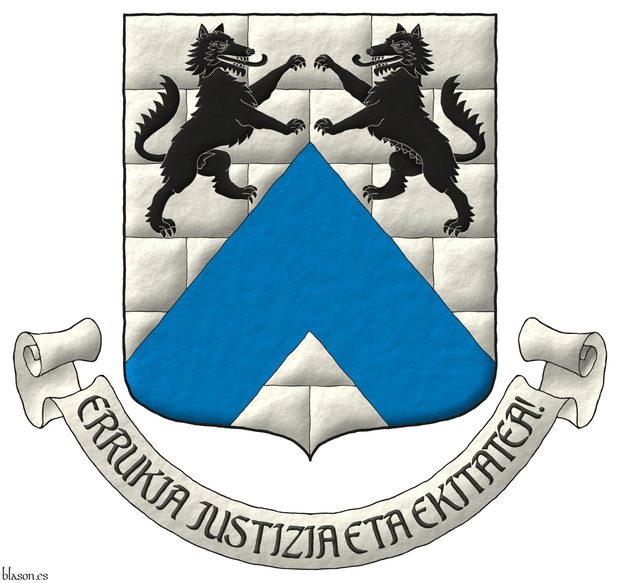
Argent masoned Sable, a chevron Azure, in chief a wolf and a she-wolf combatant Sable. Motto: «Errukia justizia eta ekitatea!».
Escudo de plata mazonado de sable, un cabrio de azur, en jefe un lobo y una loba afrontados de sable. Lema: «Errukia justizia eta ekitatea!».
Coat of arms depicted by me, outlined in Sable, with an ogee external shape and with a freehand finishing.
Coat of arms of Juan Lanzagorta Vallin designed by him and emblazoned by me. I have never painted a field masoned sable. The chevron Azure symbolizes the firmament seen through an open hole in the masoned wall, like a window open to the sky.
Credits: Juan Lanzagorta Vallin is the designer of the coat of arms.
Blazon keywords: Azure, Argent, Sable, One, Two, Masoned, Chevron, In chief, Wolf, She-wolf, Combatant and Motto.
Style keywords: Outlined in sable, Ogee and Freehand.
Classification: Personal, Interpreted, Boa and Coat of arms.
Bearer: Lanzagorta Vallín, Juan.


King Arthur, banner with cross flory

Banner Vert, a cross flory Argent.
Pendón de sinople, una cruz flordelisada de plata.
Imaginary banner interpreted in the following way: the banner has a 5x6 proportion; the field has been enameled with flat color Vert; the cross flory is illuminated Argent and outlined in Sable; and the finish is cloth-like.
This banner appears in [Edward IV of England; 1461; row 15, 1st column].
Blazon keywords: Without divisions, Vert, Argent, Cross flory and Cross couped.
Style keywords: Rectangular, Illuminated, Outlined in sable and Fabric.
Classification: Interpreted, Imaginary, Flag, Banner of arms and Kingdom of England.
Imaginary bearer: Arthur of Britain.


King Charles III Tartan, collage
Quarterly: 1 and 4 Gules, three lions passant, guardant, in pale Or, armed and langued Azure; 2 Or, a lion rampant Gules, armed and langued Azure, within a double tressure flory counterflory Gules; 3 Azure, a harp Or, stringed Argent.
Coat of arms of His Majesty King Charles III emblazoned by me. The background of the shield is the «King Charles III Tartan», combined with two fragments taken from photographs of His Majesty’s kilt: the first placed to the dexter side and below the shield, scaled so that the kilt’s stripes match in size and allow verification of the thread count, sett composition, and physical details confirming the tartan’s vertical alignment; and the second taken from the same photograph of the same kilt but enlarged, where the twill can be seen the bend sinisterwise layout.
Blazon keywords: Gules, Or, Azure, One, Three, Quarterly, Leopard, Pale, Armed, Langued, Lion, Rampant, Double tressure, Flory, Counterflory, Harp and Stringed.
Style keywords: Outlined in sable, Illuminated, Ogee and Metal beaten.
Classification: Personal, Interpreted, Boa, Tartan and Collage.
Bearer: Charles III of the United Kingdom.


Kingdom of Jerusalem

Metal Or over metal Argent.
Argent, a cross potent cantoned of four crosslets potent Or.
Escudo de plata, una cruz potenzada cantonada de cuatro cruces potenzadas todas de oro.
Illuminated with lights and shadows and with a freehand finish.
Perhaps the most classic example of non-compliance with the heraldic rule of tinctures having metal Or over metal Argent. In [Galdiano L.; Century XVII; folio 6], you can see a version of the arms of Jerusalem with the field in Gules, which would indeed follow the rule of tinctures as it is metal on color.
Blazon keywords: Without divisions, Argent, One, Cross potent, Cross couped, Cantoned, Four and Or.
Style keywords: Freehand, Outlined in sable, Illuminated, Semi-circular and Metal on metal.
Classification: Interpreted and Civic.
Bearer: Kingdom of Jerusalem.


Knights Templar, Grand Master number 02
Lozengy Or and Gules. Behind the shield a cross patty Gules.
Classification: Religious, Military, Knights Templar, Interpreted, Doctor, Article, Castilian language and Black and white and color illustrations.
Bearer: Craon, Robert de.


La Forcade, Pierre de
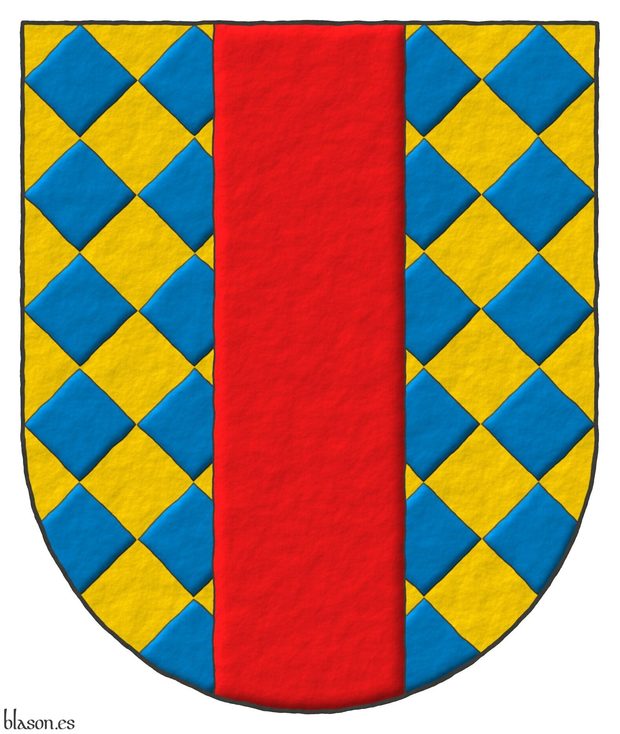
Pierre de La Forcade ~ Pierre de Forcade (XV century).
Lozengy Or and Azure, a pale Gules.
Escudo losanjado oro y azur, un palo de gules.
Coat of arms interpreted with: the semicircular base shape; the field of plain metal Or; the lozenges illuminated in Azure, outlined in Sable and with their 4 angles at 90o; the lozengy of proportion 5 x 6; the pale illuminated in Gules and outlined in Sable; and the whole with a raised-stroke effect.
Blazon keywords: Lozengy, Or, Azure, Pale and Gules.
Style keywords: Semi-circular, Illuminated, Outlined in sable and Freehand.
Classification: Interpreted and Personal.
Bearer: La Forcade, Pierre de.


Labarrieta N, María

Azure semé of moons with human face Argent, a sword point upwards Gules, the sinister of its blade debruised by a moon with human face Argent both bend sinisterwise.
Escudo de azur sembrado de lunas figuradas de plata, una espada alzada de gules, la siniestra de su hoja resaltada de una luna figurada de plata ambas puestas en barra.
Coat of arms depicted by me, in plain tinctures, contoured in Sable, with a semi-circular external shape and with a texturized finish.
The coat of arms of María Labarrieta N. designed by Juan Lanzagorta Vallín and emblazoned by me.
Blazon keywords: Azure, Argent, Gules, One, Semé, Moon, With human face, Sword, Point upwards, Sinister, Debruised and Bend sinisterwise.
Style keywords: Outlined in sable, Plain tincture and Semi-circular.
Classification: Personal, Interpreted, Boa and Coat of arms.
Bearer: Labarrieta N, María.


Lanzagorta Escutia, Juan Bautista

Azure, a chief wavy and barry wavy of twelve Azure and Argent debruised and interlaced by a fish urinant Argent.
Escudo de azur, un jefe ondado y burelado ondado de doce piezas de azur y plata, resaltado y entrelazado de un pez sumergido de plata.
Coat of arms of Juan Bautista Lanzagorta Escutia designed by Juan Lanzagorta Vallín and emblazoned by me. It recalls the sad story of a shipwreck.
Blazon keywords: Azure, Argent, One, Twelve, Chief, Wavy, Barry, Debruised, Interlaced, Fish and Urinant.
Style keywords: Ratio, Outlined, Outlined in sable, Illuminated, Semi-circular and Freehand.
Classification: Personal, Interpreted, Boa and Coat of arms.
Bearer: Lanzagorta Escutia, Juan Bautista.


Lanzagorta-Escutia, marriage
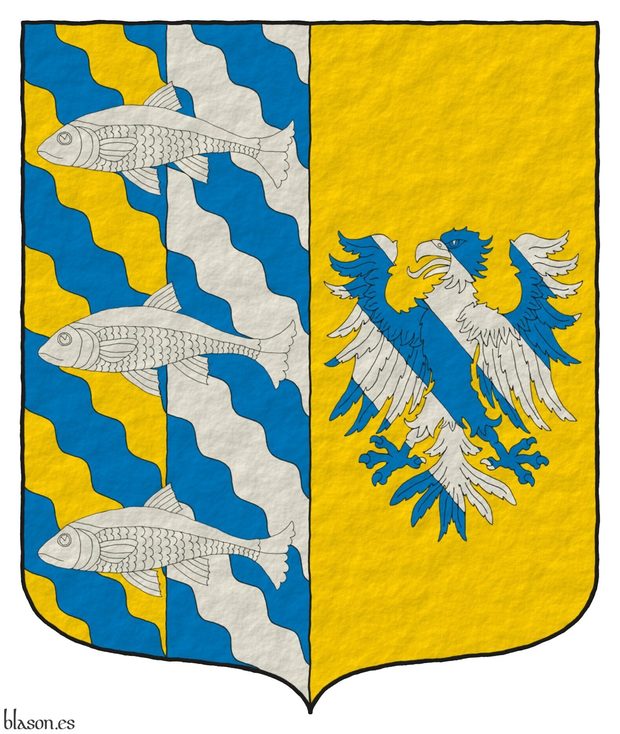
Party per pale: 1 party per pale bendy wavy Azure and Or and bendy wavy Azure and Argent, overall three fish naiant in pale Argent; 2 Or, an eagle displayed bendy Azure and Argent.
Escudo partido: 1 partido: 1o bandado ondado de azur y oro; 2o bandado ondado de azur y plata, brochante sobre el todo tres peces nadantes en palo de plata; 2o de oro, un águila bandada de azur y plata.
Coat of arms depicted by me, in plain tinctures, contoured in Sable, and with a texturized finishing.
This is the coat of arms of the marriage Lanzagorta-Escutia, designed by Juan Lanzagorta Vallín and emblazoned by me. They are the married couple composed of Juan Lanzagorta Aras and María Dolores Escutia Sánchez. It is composed of the arms of Juan Lanzagorta Aras impaled with those of María Dolores Escutia Sánchez.
Blazon keywords: Azure, Or, Argent, Three, One, Party per pale, Bendy, Wavy, Overall, Fish, Naiant, In pale, Eagle and Displayed.
Style keywords: Outlined in sable and Plain tincture.
Classification: Personal, Interpreted, Boa and Coat of arms.
Bearer: Lanzagorta-Escutia, marriage.


Larre, lineage of Bayonne, French Basque Country
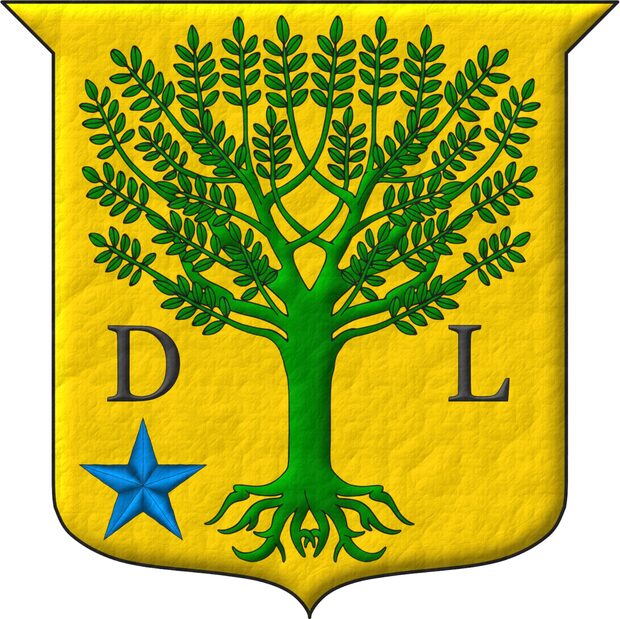
D'or à un arbre arraché de sinople, accosté à dextre de la lettre capitale «D» et à senestre de la lettre capitale «L» du même, et une étoile d'azur posée au canton dextre de la pointe.
Or, a tree eradicated Vert between a capital letter «D» and a capital letter «L» Sable, in the dexter of the base a mullet Azure.
Illuminated with lights and shadows and with a leather finish.
Blazon keywords: Without divisions, Or, One, Tree, Erased, Vert, Between, Letter, Sable, Canton, Dexter, Base (lower 1/3), Mullet, Five and Azure.
Style keywords: Leather, Outlined in sable, Illuminated and Semi-circular.
Classification: Interpreted, Lineage and Kingdom of France.


Laurent Liu-Lecomble, structured and parallel blazons
Coat of arms of Laurent Liu-Lecomble designed by him and emblazoned by me, with the blazon written in English and Castilian in a structured way to observe the parallelism between both forms.
Blazon keywords: Azure, Argent, Gules, Or, One, Three, Quarterly, Dexter, Hand, Appaumée, Sword, Point upwards, Between, Cross patty, Cross couped, Sinister, Eight-pointed cross, Plough share, Affronty, Disordered, Eagle claw, Inescutcheon, Charged and Fleur de lis.
Style keywords: Outlined in sable, Illuminated, Ogee and Rough.
Classification: Personal, Interpreted, Structured and parallel blazons, Boa and Coat of arms.
Bearer: Liu-Lecomble, Laurent.


Laydin, lineage

Azure, five flies in saltire Or.
Escudo de azur, cinco moscas puestas en sotuer de oro.
Arms painted by me, highlighted with lights and shadows, contoured in Sable, with an ogee outer contour and with a freehand finish.
This is the coat of arms of the lineage Laydin emblazoned by me, as described in [Cadenas y Vicent, V. de; 1987; page 989], whose blazon is equivalent to that of the Zendreros lineage, also described in [Cadenas y Vicent, V. de; 1987; page 1941].
Blazon keywords: Azure, Or, Five, Fly and In saltire.
Style keywords: Outlined in sable, Illuminated, Ogee and Freehand.
Classification: Personal, Lineage, Interpreted, Boa and Coat of arms.
Bearer: Laydin, lineage.


Lazaro of Aragon, lineage
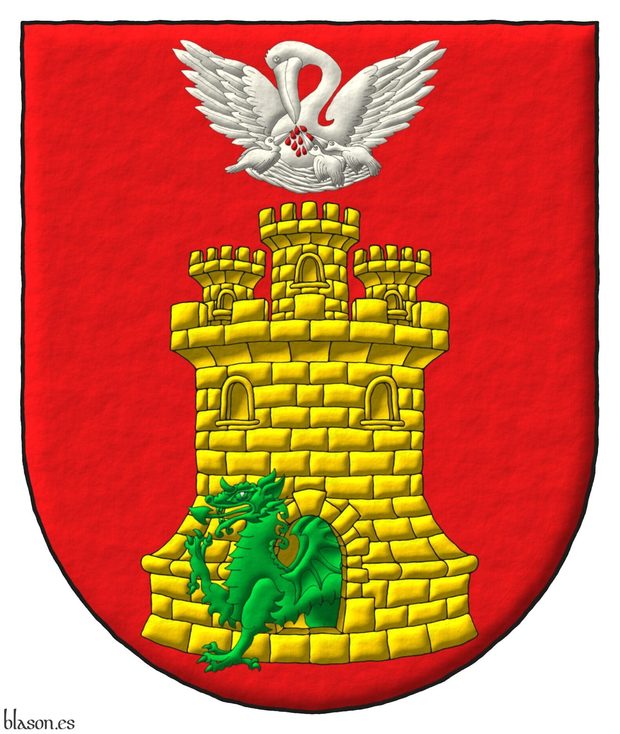
Gules, a castle triple-towered Or, masoned Sable, issuant from its port a dragon passant Vert, in chief a pelican in her piety Argent, vulned Gules.
Escudo de gules, un castillo de oro, mazonado de sable y saliendo por su puerta un dragón pasante de sinople, en jefe un pelícano desplegado de plata, la piedad de gules.
Coat of arms interpreted by me, highlighted with lights and shadows, outlined in Sable, with a semi-circular outer contour and with a freehand finishing.
Ancient arms of the lineage Lazaro of Aragon emblazoned by me.
Blazon keywords: Gules, Or, Vert, Argent, One, Castle, Triple-towered, Masoned, Issuant (port), Dragon, Passant, In chief, Pelican in her piety and Pelican.
Style keywords: Outlined in sable, Illuminated, Semi-circular and Freehand.
Classification: Personal, Lineage, Interpreted, Boa and Coat of arms.
Bearer: Lazaro of Aragon, lineage.


Lazcano, lineage of the Canary Islands
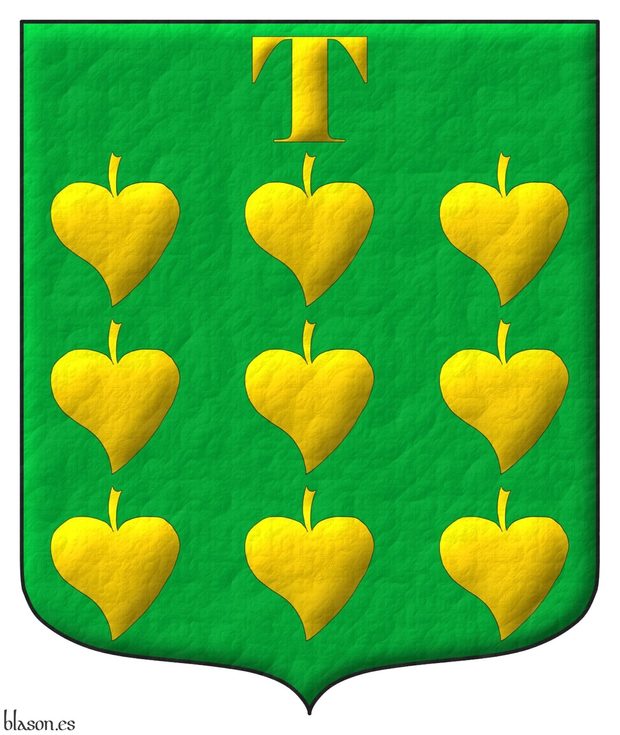
Blazon of the lineage Lazcano in the Canary Islands.
Vert, nine Poplar leaves ordered, in chief a «T» letter Or.
Illuminated and leather finishing.
It can be consulted at [Chaparro D'Acosta L.; 1979; página 251].
Blazon keywords: Without divisions, Vert, Letter, Poplar leaf, Or and Nine.
Style keywords: Leather, Outlined in sable and Illuminated.
Classification: Interpreted.


Leonor de Aquitania y Enrique de Inglaterra
[ Gules, a lion rampant Or, ] accolé with [ Gules, a lion passant, guardant Or ].
[ Escudo de gules, un león rampante de oro, ] acolado de un [ escudo de gules, un leopardo de oro].
Existing arms interpreted by me as follows: both coat of arms are rotated ±30o; their shapes are pointed; the field of each coat of arms has been enamelled in flat Gules; the lion and the leopard in Or are outlined in Sable; and the whole composition of both arms has a rough texture finish.
Examples of accolated coat of arms (written as «accolé» in the 18th century) can be seen in [Avilés, J.; 1780a; pages 24 and 25 and plate 1: figures 1 and 2].
Blazon keywords: Without divisions, Gules, One, Lion, Or, Rampant and Leopard.
Style keywords: Pointed, Plain tincture, Outlined in sable, Tilted shield and Metal beaten.
Classification: Interpreted, Personal, Accolé arms, Duchy of Aquitaine, Kingdom of France and Kingdom of England.
Bearer: Leonor de Aquitania.


Leonor Plantagenet and Alfonso VIII
[ Gules, a castle triple towered Or, port and windows Azure, masoned Sable ] accolé with [ Gules, three lions, passant, guardant, in pale Or, armed and langued Azure ].
[ Escudo de gules, un castillo de oro, aclarado de azur, mazonado de sable ] acolado de un [ escudo de gules, tres leopardos en palo de oro, armados y lampasados de azur ].
Arms of the King and Queen of Castile interpreted with: the escutcheons' shapes pointed and rounded; the field of each shield, the castle, and the three leopards enamelled in flat tints of Gules and metal Or, with windows, claws, and tongues in Azure; and the whole composition finished with a raised line technique.
[Medél, R.; 1846; page 38] provides a heraldic description of the leopard.
Blazon keywords: Without divisions, Gules, Or, Azure, Three, Leopard, Armed, Langued, In pale, Sable, One, Castle, Port and windows and Masoned.
Style keywords: Ogee, Plain tincture, Outlined in sable, Tilted shield and Freehand.
Classification: Interpreted, Personal, Accolé arms, House of Plantagenet, Kingdom of England and Kingdom of Castile.
Bearer: Leonor Plantagenet.


Leonor Princess of Asturias
![Leonor Princess of Asturias Quarterly: 1 Gules, a castle triple-towered Or, port and windows Azure, masoned Sable [for Castile]; 2 Argent, a lion rampant Purple, armed and langued Gules, crowned Or [for Leon]; 3 Or, four pallets Gules [for Aragon]; 4 Gules, a chain orlewise, crosswise, and saltirewise Or, charged in the fess point with an emerald Vert [for Navarre]; enté en point Argent, a pomegranate proper, seeded Gules, slipped and leaved Vert [for Granada]; an inescutcheon Azure, three fleurs de lis Or, 2 and 1, a bordure Gules [for Bourbon]; the whole debruised by a label of three points Azure.](../escudo_armas/LeonorPA.21.CoA.TrazoAlzado.jpg)
Quarterly: 1 Gules, a castle triple-towered Or, port and windows Azure, masoned Sable [for Castile]; 2 Argent, a lion rampant Purple, armed and langued Gules, crowned Or [for Leon]; 3 Or, four pallets Gules [for Aragon]; 4 Gules, a chain orlewise, crosswise, and saltirewise Or, charged in the fess point with an emerald Vert [for Navarre]; enté en point Argent, a pomegranate proper, seeded Gules, slipped and leaved Vert [for Granada]; an inescutcheon Azure, three fleurs de lis Or, 2 and 1, a bordure Gules [for Bourbon]; the whole debruised by a label of three points Azure.
Escudo cuartelado: 1o de gules, un castillo de oro, aclarado de azur, mazonado de sable [de Castilla]; 2o de plata, un león rampante de púrpura, lampasado y armado de gules, coronado de oro [de León]; 3o de oro, con cuatro palos de gules [de Aragón]; 4o de gules, una cadena puesta en orla, en cruz y en sotuer de oro, cargada en el centro de una esmeralda de sinople [de Navarra]; entado en punta de plata, una granada al natural, tajada de gules, tallada y hojada de sinople [de Granada]; un escusón de azur, tres flores de lis de oro, 2 y 1, una bordura de gules [de Borbón]; brisado de un lambel de tres pendientes de azur.
Coat of arms painted by me, highlighted with lights and shadows, outlined in Sable, with a semi-circular external shape and with a freehand finish.
This is the coat of arms of Her Royal Highness Doña Leonor Princess of Asturias, Princess of Girona, and Princess of Viana, heiress of the throne of Spain as the elder daughter of King Felipe VI and Queen Letizia. This version of her coat of arms has been emblazoned by me.
Blazon keywords: Gules, Azure, Purpure, Vert, Or, Argent, One, Three, Four, Quarterly, Castle, Triple-towered, Port and windows, Masoned, Lion, Rampant, Crowned, Pallet, Chain, Orlewise, Crosswise, Saltirewise, Charged, In the fess point, Emerald, Enté en point, Pomegranate, Proper, Slipped, Leaved, Inescutcheon, Fleur de lis, Ordered, Bordure, Cadency and Label of three points.
Style keywords: Outlined in sable, Illuminated, Semi-circular and Freehand.
Classification: Personal, Kingdom of Spain, Interpreted, Boa and Coat of arms.
Bearer: Leonor Princess of Asturias.


Leopold Nisnoni, page of armorial
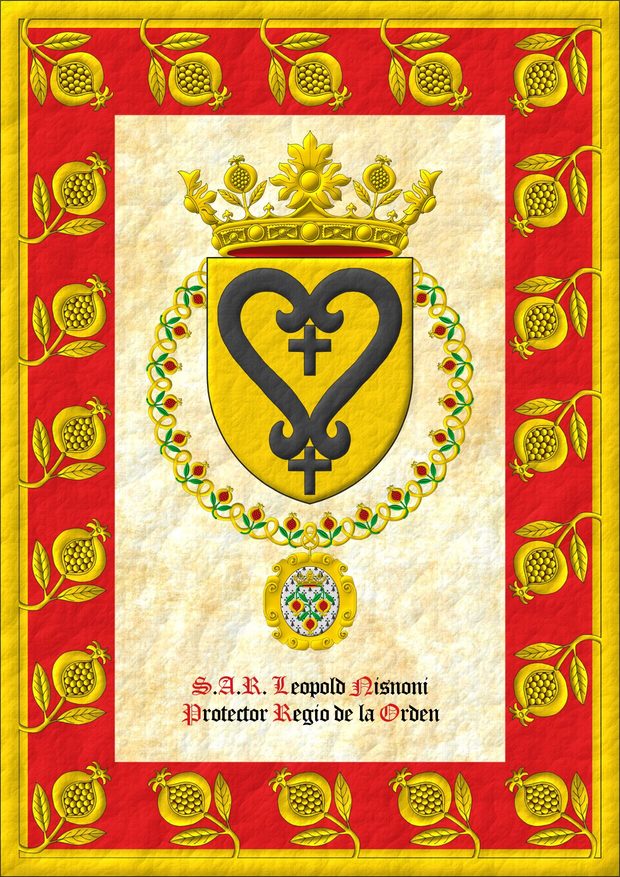
Or, the symbol of the Royal House of Kupang Sable. Crest: A crown of the Sovereign and Most Noble Order of the Pomegranate. The shield is surrounded by the Grand Collar of the Sovereign and Most Noble Order of the Pomegranate.
This is his coat of arms of emblazoned by me for the Roll of Arms of the Sovereign and Most Noble Order of the Pomegranate.
Blazon keywords: Without divisions, Or, One, Symbol, Sable, Crest and mantling, Crown, Pomegranate, Surrounded and Grand collar.
Style keywords: Pointed, Outlined in sable, Illuminated and Leather.
Classification: Civic, Interpreted, Coat of arms, Armorial roll and Castilian language.
Bearer: Kupang, Royal House of.


Lete of Navarre
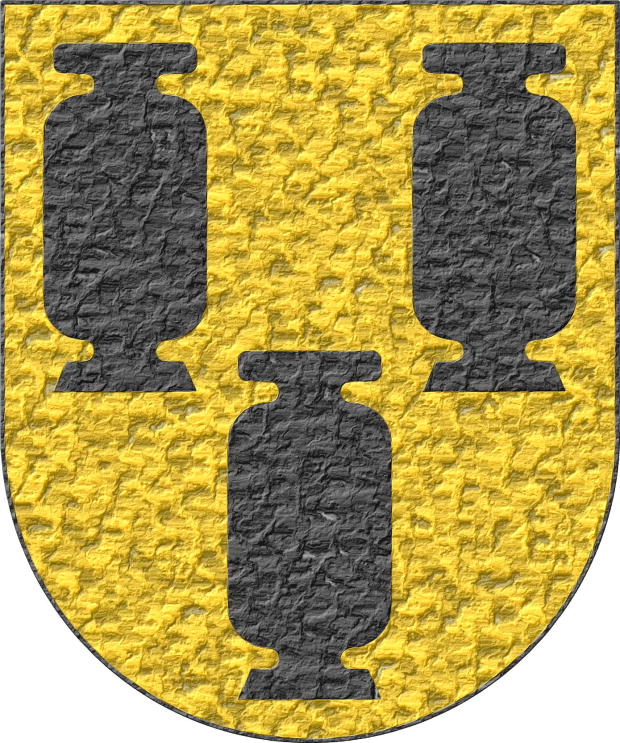
Of the twelve lineages of Noblemen, the sixth is that of Lete, from which descended Don Juan Corbarán de Let: they bear as arms, on a field Or, three pots shaped like cauldrons, slightly elongated, as painted in this shield.
Or, three Fleshpot Sable.
Escudo de oro, tres potes de sable.
Coat of arms interpreted with: a semicircular (round) base; the field in flat Or metal; the three pots illuminated in Sable with vertical, but not horizontal symmetry; and finished in highly-hammered metal.
It is not easy to find in English a similar figure:
- it could be considered «pote» ~ «pot», although perhaps «pot» is too generic,
- another possibility is «pote» ~ «fleshpot», which, although usually represented with three legs instead of a base and with two handles, is the one I tend to prefer,
- the English term «cauldron», but this corresponds to our «caldero» ~ «cauldron».
Coat of arms based on the sixth of the Navarrese «ricoshombres» from [Bosque, J. del; 1540; folio 1 of the numbering of 1613]. The text heading this article is taken from the transcription made by [Martinena Ruiz, J. J.; 1982; pages 122 and 123].
Although I have not found any reference about it, it could be considered that originally they might have been canting arms and that these three «potes» could have been milk pots, in reference to their bearers «Lete».
Under the title «Surname of Let» it can also be consulted in [Vega, P. J. de; 1702; folio 6 of the manuscript], although the number has been altered, possibly having been a 5 and perhaps interpreted as an 8, it is deduced by being placed after folio 7.
Blazon keywords: Without divisions, Or, Clay pot and Sable.
Style keywords: Semi-circular, Illuminated and Hard metal.
Classification: Interpreted, Personal, Kingdom of Navarre and Canting.
Bearer: Lete of Navarre.


Lincoln's Inn, The Honourable Society of

Azure semé of millrinds Or; on a dexter canton Or, a lion rampant Purpure, armed and langued Gules.
Escudo de azur sembrado de anillas de molino de oro; en un cantón diestro de oro, un león rampante de púrpura, armado y lampasado de gules.
Coat of arms emblazoned by me with a pointed shape, the lion is outlined with the color of the field, Purpure, the millrinds are outlined Sable, all the coat of ars is illuminated, and with a watercolor finishing.
Blazon keywords: Azure, Semé, Millrind, Or, One, Canton, Dexter, Lion, Rampant, Purpure, Armed, Langued and Gules.
Style keywords: Pointed, Outlined in sable, Outlined in the field tincture, Illuminated and Watercolor.
Classification: Socioeconomic, Interpreted and Coat of arms.
Bearer: Lincoln's Inn, The Honourable Society of.


Lindsay of Scotland, lineage
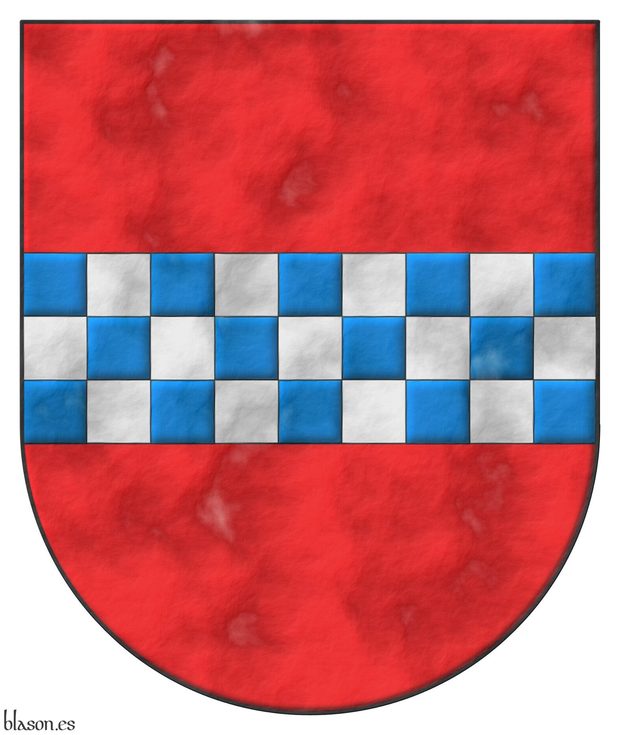
Gules, a fess chequey Azure and Argent.
Escudo de gules, una faja ajedrezada de azur y plata.
Arms depicted by me, highlighted with lights and shadows, outlined in Sable, with a semi-circular external shape and with a parchment finishing.
Coat of arms of the lineage Lindsay of Scotland. I have emblazoned it with a fess chequy of 3 rows, symmetric and with 9 columns of squares, provided that its height is 1/3 of the width of the coat of arms.
Blazon keywords: Gules, Azure, Argent, One, Three, Nine, Fess and Chequey.
Style keywords: Outlined in sable, Illuminated, Semi-circular and Parchment.
Classification: Personal, Lineage, Interpreted, Boa and Coat of arms.
Bearer: Lindsay of Scotland, lineage.
Blazon equivalent to: Janovsti of Janovic of Czechia, lineage.


Lindsay of the Byres, lineage
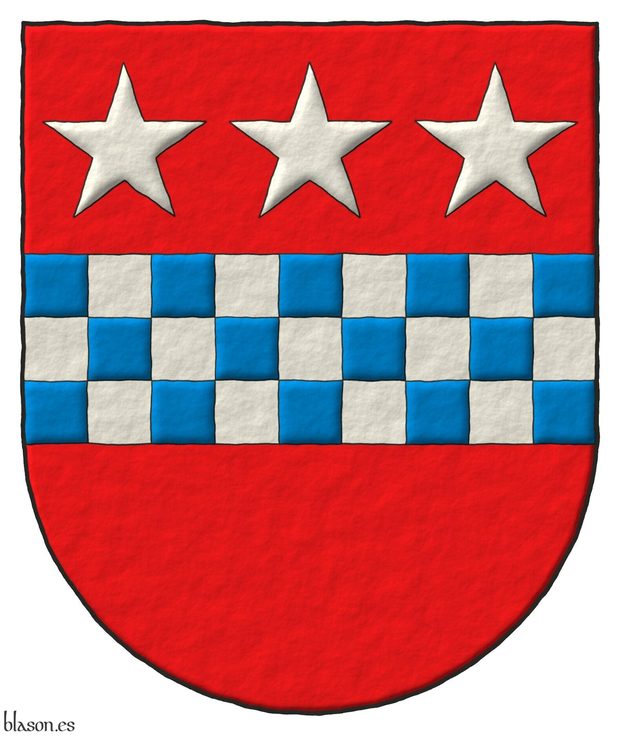
Gules, a fess chequey Azure and Argent, in chief three mullets of five points Argent.
Escudo de gules, una faja ajedrezada de azur y plata, en jefe tres estrellas de cinco puntas de plata.
Arms interpreted by me, highlighted with lights and shadows, outlined in Sable, with a semi-circular outer contour and with a freehand finish.
Coat of arms of the lineage Lindsay of the Byres. I have emblazoned it with a fess chequy of 3 rows, symmetric and with 9 columns of squares, provided that its height is 1/3 of the width of the coat of arms.
Blazon keywords: Gules, Azure, Argent, One, Three, Nine, Fess, Chequey, In chief and Mullet.
Style keywords: Outlined in sable, Illuminated, Semi-circular and Freehand.
Classification: Personal, Lineage, Interpreted, Boa and Coat of arms.
Bearer: Lindsay of the Byres, lineage.


Lineage Argüello of Extremadura

Azure, a holm oak proper, fructed and eradicated Or, between two goats Argent supporting it. Motto: «In Deo Spes Mea».
Escudo de azur, una encina al natural, frutada y arrancada de oro, con dos cabras de plata empinadas al tronco. Lema: «In Deo Spes Mea».
Coat of arms depicted by me, highlighted with lights and shadows, outlined in Sable, with a semi-circular external shape and with a watercolor finish.
Coat of arms of the lineage Argüello of Extremadura emblazoned by me. This motto was found by Eleonora on a pair of Chinese porcelain plates made for the Spanish market, Qianlong period, circa 1770, which bear the arms of the Argüello lineage.
Blazon keywords: Azure, Or, Argent, One, Two, Holm oak, Proper, Fructed, Eradicated, Goat, Supporting and Motto.
Style keywords: Outlined in sable, Illuminated, Semi-circular and Watercolor.
Classification: Personal, Lineage, Interpreted, Boa and Coat of arms.
Bearer: Argüello of Extremadura, lineage.


Lineage Baldovino from Venecia, plain tincture
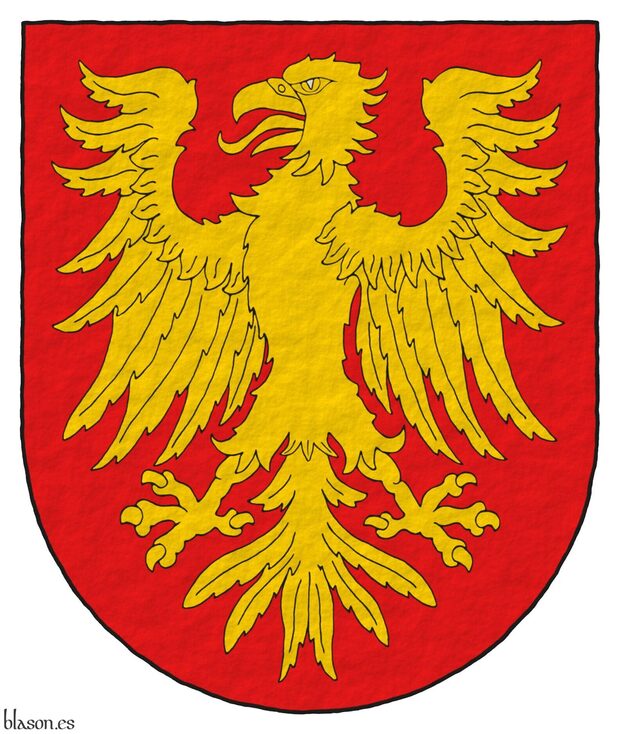
Gules, an eagle displayed Or.
Arms depicted by me, in flat tinctures, contoured in Sable, with a semi-circular external shape and with a texturized finish.
Coat of arms of the lineage Baldovino from Venecia. From Jean-Baptiste Rietstap, «Armorial général», 1st edition, 1861, [Rietstap, J. B.; 1861; P1 CXII B, row 7, column 7].
Blazon keywords: Gules, Or, One, Eagle and Displayed.
Style keywords: Outlined in sable, Plain tincture and Semi-circular.
Classification: Personal, Lineage, Interpreted, Boa and Coat of arms.
Bearer: Baldovino from Venecia, lineage.


Lineage Mark of Germany, collage
[ Or, a fess chequey Gules and Argent ] · [ Or, a fess chequey Azure and Argent ] · [ Gules, a fess chequey Azure and Argent ] · [ Gules, a fess chequey Azure and Argent ] · [ Azure, a fess chequey Gules and Argent ].
Diagram featuring the coat of arms of the lineage Mark of Germany with the coats of arms of Stewart of Scotland, Janovští z Janovic, Klenovský z Klenové of Czechia, and Lindsay and Boyd of Scotland.
Blazon keywords: Or, Gules, Argent, Azure, One, Three, Nine, Fess and Chequey.
Style keywords: Outlined in sable, Illuminated, Semi-circular and Iridescent.
Classification: Personal, Lineage, Interpreted, Schema, Boa and Coat of arms.
Bearer: Mark of Germany, lineage.


Lineage Peraza of Cantabria, comparation 1x2
Or, a holm oak eradicated Vert, fructed Or, in front of its trunk two boars passant, in pale Sable.
Ancient arms of the lineage Peraza of Cantabria emblazoned by me with 2 approaches: one with the boars outlined in Sable and the other with the boars outlined in Or, matching the metal of the field.
Blazon keywords: Or, Vert, Sable, Holm oak, Eradicated, Fructed, In front (tree), Trunk, Boar, Passant and In pale.
Style keywords: Outlined in sable, Outlined in the field tincture, Illuminated and Semi-circular.
Classification: Personal, Lineage, Interpreted, Boa and Compare.
Bearer: Peraza of Cantabria, lineage.


Lineage Rothstein
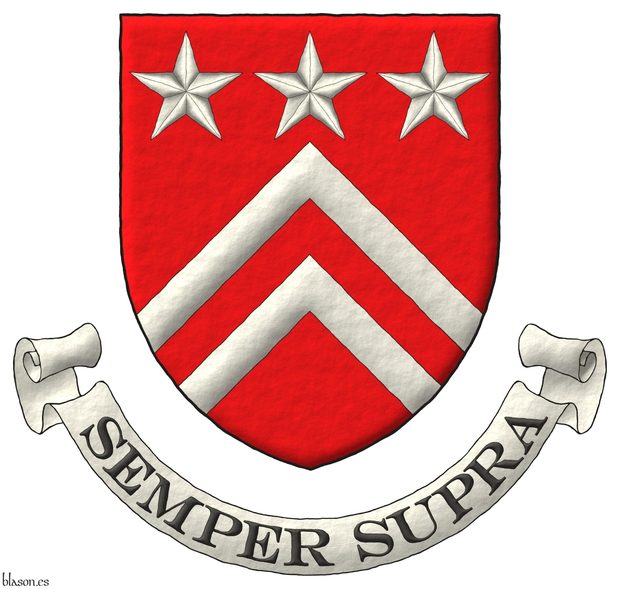
Gules, two chevronels, in chief three mullets Argent. Motto: «Semper Supra».
Escudo de gules, dos tenazas de plata, en jefe tres estrellas todo de plata. Lema: «Semper Supra».
Arms painted by me, highlighted with lights and shadows, outlined in Sable, with a pointed external shape and with a freehand finish.
Blazon keywords: Gules, Argent, Two, Three, Chevronel, In chief, Mullet and Motto.
Style keywords: Outlined in sable, Illuminated, Pointed and Freehand.
Classification: Personal, Lineage, Interpreted, Boa and Coat of arms.
Bearer: Rothstein, lineage.


Lloscós y Soldevilla, Guilaberto
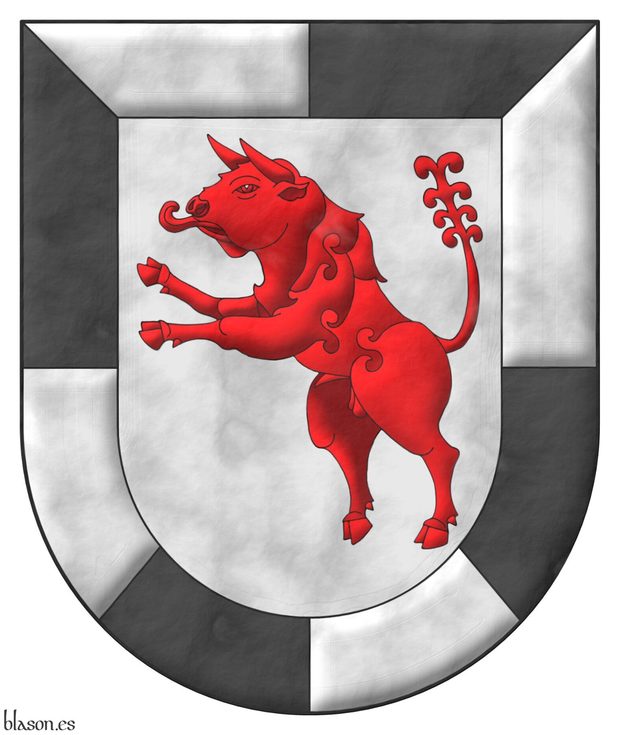
Guilaberto Lloscós y Soldevilla was grand prior of the Order of Saint John from 1449 to 1460.
Argent, a bull salient Gules within a bordure compony Argent and Sable.
Illuminated and parchment finishing.
He also known as Guilaberto Loscós y Soldevilla, and his coat of arms can be consulted at [García Carraffa, A.; García Carraffa, A.; 1968; volume II, page 407], who does not depict this bull with its tongue out.
The Lloscós lineage resided on the island of Mallorca and succeeded in the position of royal procurator of the island. Lázaro Lloscós was the procurator of the island in 1332, his son Mateo Lloscós was in 1392 and his grandson Mateo Lloscós was too. Mateo Lloscós helped King Alonso V of Aragon, the Magnanimous, with the expenses of the Naples campaign in 1435 and, therefore, the king donated the town of Bañalbufar and the title of baron. Mateo Lloscós was the father of Guilaberto Lloscós y Soldevilla grand prior of the Order of Saint John.
Blazon keywords: Argent, One, Bull, Salient, Gules, Bordure, Compony and Sable.
Style keywords: Parchment, Outlined in sable and Illuminated.
Classification: Personal and Interpreted.
Bearer: Lloscós y Soldevilla, Guilaberto.


Lopez Linares, Barbaro Jonathan
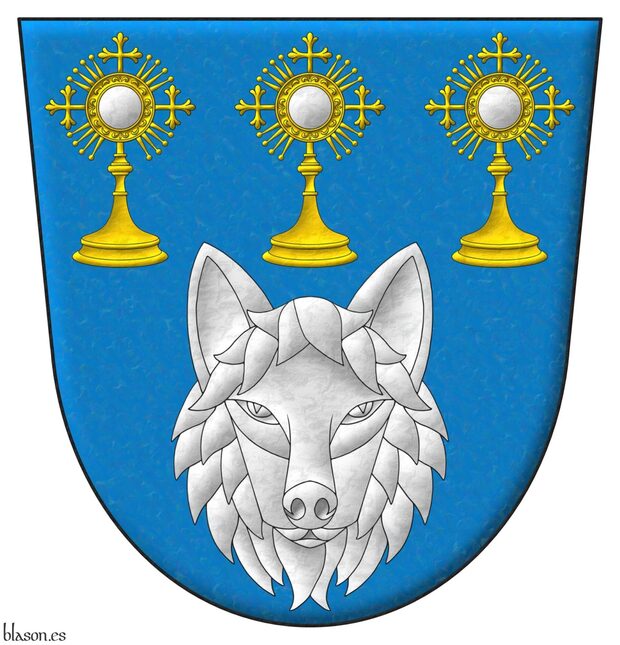
Azure, a wolf's head caboshed Argent, in chief three monstrances in fess proper.
Escudo de azur, una cabeza de frente de lobo de plata, acompañada en jefe de tres custodias en faja al natural.
Arms depicted by me, illuminated with lights and shadows, contoured in Sable, with a rounded trapezoidal outer contour and with a metal and iridescent finishing.
Coat of arms of Barbaro Jonathan Lopez Linares, Cuba, designed by him and emblazoned by me. In English heraldry the term caboshed applies to the head of any animal shown affronty, but it always refers only to the head, with no part of the neck visible; for example, one may blazon «a bull’s head caboshed» or «a wolf’s head caboshed», whereas if the neck is shown the proper term is «a bull’s head couped affronty»; in other words, a head caboshed does not show any of the neck, it is just the animal’s face; this usage of caboshed is valid both for horned animals such as the stag, the goat, or the bull, and also for hornless animals such as the wolf; in Castilian heraldry, however, [Cadenas y Vicent, V. de; 2002] defines «reencuentro» specifically for the frontal head of the bull, and by extension for other horned animals such as the stag or the goat; thus, for a wolf, one should properly blazon simply «una cabeza de lobo de frente» ~ «a wolf’s head affronty»; finally, the [Real Academia Española; 2014] standardizes the spelling «reencuentro» with double «e», although it also accepts the shorter variant «rencuentro», which is the one I personally prefer to use. In heraldry, when a monstrance is blazoned proper, it is understood that the entire structure of the object is of the metal Or, with its characteristic details such as rays, sunburst, or base also in gold, and that inside it the Host is visible in Argent; therefore, a «monstrance proper» must always appear in gold with the silver Host at its center.
Blazon keywords: Azure, Argent, One, Three, Wolf, Head, Caboshed, In chief, Monstrance, Proper and Motto.
Style keywords: Outlined in sable, Illuminated, Rounded trapezoid and Metal and iridescent.
Classification: Personal, Interpreted, Canting, Boa and Coat of arms.
Bearer: Lopez Linares, Barbaro Jonathan.


Lord of South Clifton, hand-drawn
Sable, a tyger rampant Argent; a bordure Argent charged with eight crosses crosslet fitchy Sable.
Coat of arms of the Lord of South Clifton. The image combines a photograph of a drawing of a tyger rampant with the final version of his coat of arms, both created by me. From my original hand-drawn sketch to its final heraldic embodiment, this tyger has lost the stripes on its back because the heraldic tyger should not have them, unlike a natural tiger. The image also shows how the mane evolved from the original hand-drawn sketch to the final heraldic version, ensuring the tyger's mane is distinctly different from a lion's.
Blazon keywords: Sable, Argent, One, Eight, Tyger, Rampant, Bordure, Charged and Cross crosslet fitchy.
Style keywords: Outlined in sable, Illuminated and Pointed.
Classification: Personal, Interpreted, Boa, Hand-drawn, Collage and Photographic.
Bearer: South Clifton, Lord of.


Louis IX of France
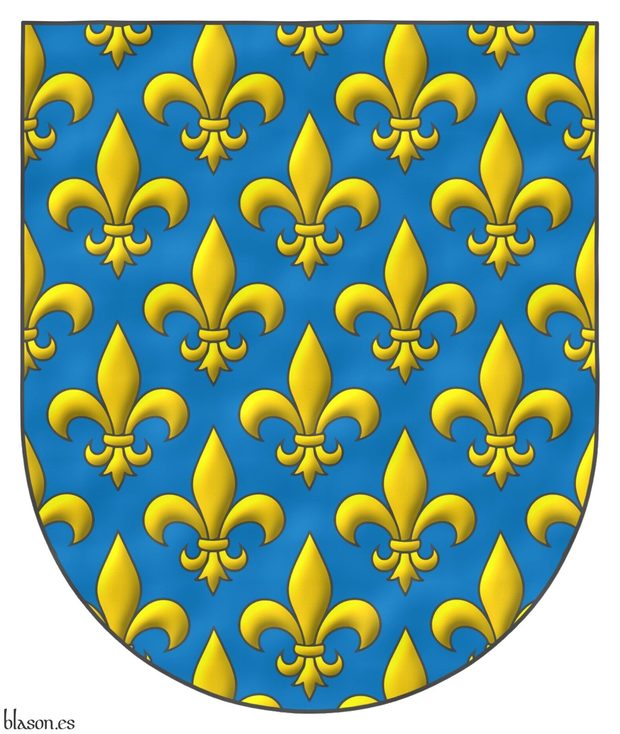
Saint Louis, King of France (1214-1270), son of Blanche of Castile.
Azure semé of fleurs de lis Or.
Escudo de Azur sembrado de flores de lis de oro.
Coat of arms interpreted by me as follows: the shield has a semicircular (round) base; the field is enamelled in flat Azure; the fleurs-de-lis are outlined in Sable and illuminated in Or; and finished with a watercolor effect.
Toward the end of his reign, the armorial called [Wijnbergen; 1265] was created, whose first part is devoted to recording his coat of arms [Wijnbergen; 1265; shield no. 1], which was also that of his father Louis VIII, husband of Blanche of Castile, and the coats of arms of those who were his vassals.
Blazon keywords: Without divisions, Azure, Or, Semé and Fleur de lis.
Style keywords: Semi-circular, Illuminated, Outlined in sable and Watercolor.
Classification: Interpreted, Personal, Coat of arms, Kingdom of France and House of the Capetians.
Bearer: Louis IX of France.


Lucius III
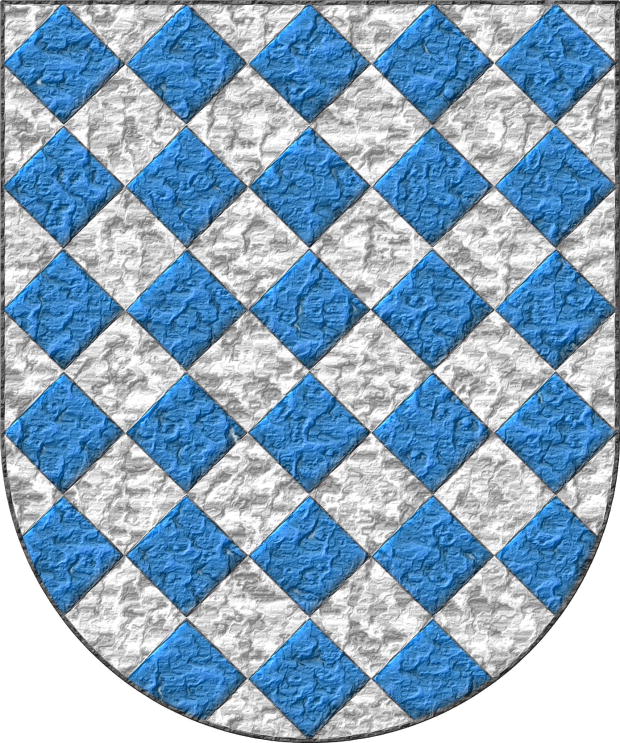
171st Pope of the Church, from the year 1181 to the year 1185. «Lucius III», born Ubaldo Allucinoli, was born in Lucca in northwest Italy.
Lozengy Argent and Azure.
Escudo losanjado de plata y azur.
Papal coat of arms interpreted by me with: a semicircular shield shape; a plain Argent field; checky or squares illuminated in Azure and outlined in Sable; and the whole design with a watercolor finish.
Blazon keywords: Without divisions, Lozengy, Argent and Azure.
Style keywords: Semi-circular, Illuminated, Outlined in sable and Hard metal.
Classification: Interpreted, Religious and Papal States.
Bearer: Lucius III.


Luigi Merante Critelli
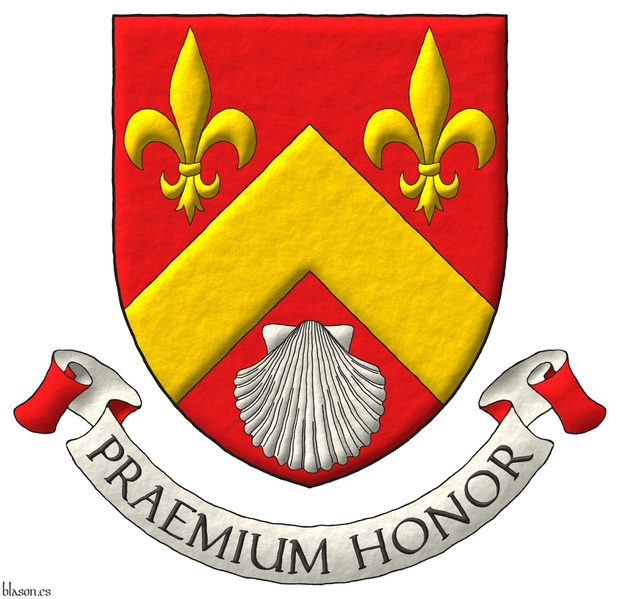
Gules, a chevron, between in chief two fleurs de lis Or, and in base an escallop Argent. Motto: «Praemium Honor».
Escudo de gules, un cabrio de oro, acompañado en jefe de dos flores de lis de oro, y en punta de una venera de plata. Lema: «Praemium Honor».
Coat of arms emblazoned by me, highlighted with lights and shadows, contoured in Sable, and with a freehand finishing.
Blazon keywords: Gules, Or, Argent, One, Two, Chevron, Between, In chief, Fleur de lis, In base, Escallop and Motto.
Style keywords: Outlined in sable, Illuminated and Freehand.
Classification: Personal, Interpreted, Boa and Coat of arms.
Bearer: Merante Critelli, Luigi.


Lukas Podlipny
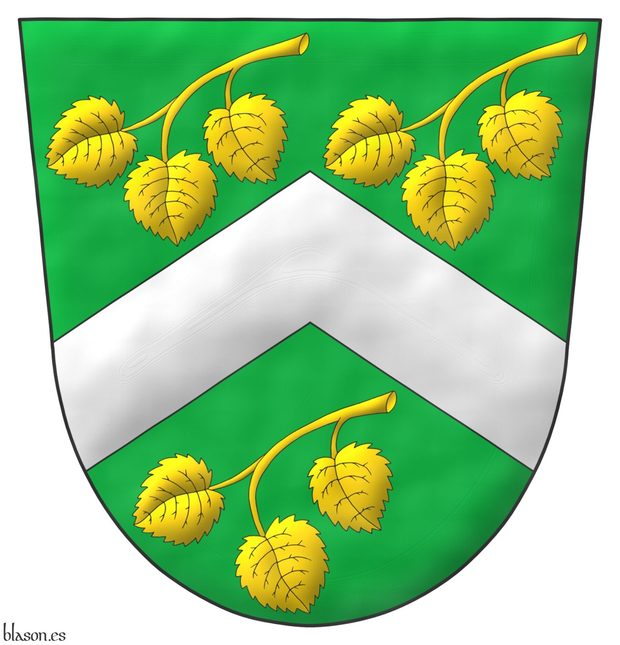
Vert, a chevron Argent between three linden sprigs, three-leaved, enarched bend sinisterwise Or.
Escudo de sinople, un chevron de plata acompañado de tres ramitas de tilo, de tres hojas, arqueadas, puestas en barra de oro.
Coat of arms painted by me, highlighted with lights and shadows, outlined in Sable, with a rounded trapezoidal outer contour and with a watercolor finishing.
Coat of arms of Lukas Podlipny, Slovakia, emblazoned by me. His name, with the diacritical marks used in Slovak, is written as Lukáš Podlipný. These are canting arms, in Slovak, «lipa» ~ linden tree, and the surname Podlipný would mean «under the linden tree», «pod» ~ under, «lip-» ~ linden, hence the arched linden sprigs in the coat of arms.
Blazon keywords: Vert, Argent, Or, One, Three, Chevron, Between, Linden, Sprig, Leaved, Enarched and Bend sinisterwise.
Style keywords: Outlined in sable, Illuminated, Rounded trapezoid and Watercolor.
Classification: Personal, Interpreted, Boa and Coat of arms.
Bearer: Lukas Podlipny.


Malka Gittel Bas Reuven, structured and parallel blazons
Coat of arms of Her Excellency Ratu Muda Malka Bas Reuven emblazoned by me with a shape known as a vesica piscis, and with the blazon written in English and Castilian in a structured way to observe the parallelism between both forms. My experience is that if shield shapes are named after countries, this creates problems in an international context. For example, if the shield with a rounded base is called a «Spanish shield», sooner or later someone will point out that the same shape is also used in Portugal, Hungary, or Poland, making it not exclusively Spanish. For this reason, I avoid assigning shield shapes names based on countries or kingdoms and instead give them names that describe their formal characteristics, which is not always easy. For example, I call the «semi-circular shield» in English and «escudo de medio punto» in Castilian to the commonly referred as «Spanish», or the «ogee shield» one that ends in an inverted ogee arch, «conopial» in Castilian. Despite this, at some point, breaking my own rule, I used the term «Bantu» to refer to the almond-shaped shield, only to be quickly corrected and informed of its connection to other African kingdoms. My mistake was not using the name I had always given it: «mandorla» in Castilian and «vesica piscis» in English.
Blazon keywords: Azure, Gules, Sable, Or, One, Six, Tierced pallwise inverted, Overall, Chevron, Between, Dexter, Chief, Mullet, Sinister, Pair of scales, In base, Open book and Book.
Style keywords: Outlined in sable, Illuminated, Vesica piscis and Leather.
Classification: Personal, Interpreted, Structured and parallel blazons, Boa and Coat of arms.
Bearer: Gittel Bas Reuven, Malka.


Malvin de Montazet, lineage of Languedoc
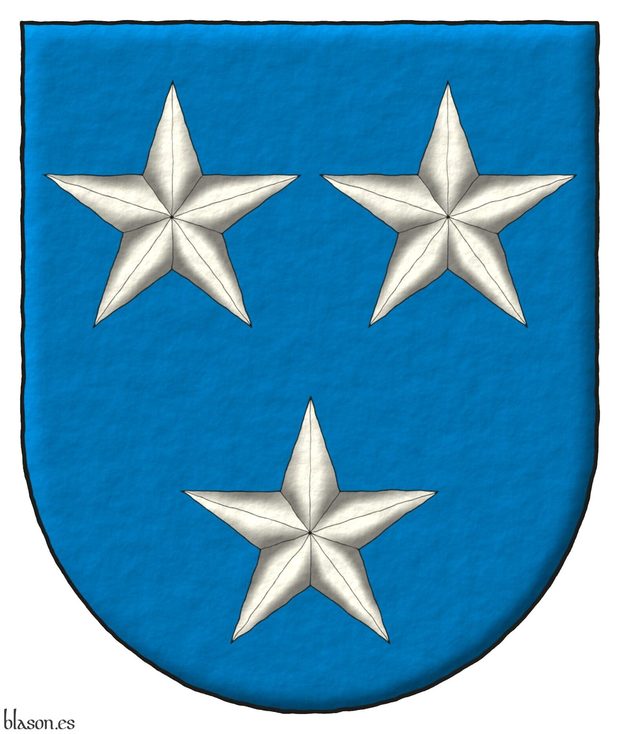
Blazon of the Malvin de Montazet lineage of Languedoc, France.
Azure, three mullets Argent, 2 and 1.
Illuminated and a freehand finishing.
Its French blazon «d'azur, à trois étoiles d'argent, 2 et 1» can be found at [Rietstap, J. B.; 1861; page 140].
Blazon keywords: Without divisions, Azure, Three, Mullet, Argent and Ordered.
Style keywords: Freehand, Outlined in sable, Illuminated and Semi-circular.
Classification: Interpreted, Lineage and Kingdom of France.


Manuel Beninger

Quarterly: 1 and 4 Gules, a fess Azure; 2 and 3 Or, a fess dancetty Argent.
Coat of arms emblazoned by me with a semi-circular ended shape, illuminated, and its finishing is that seems leather.
Blazon keywords: Quarterly, Gules, One, Fess, Azure, Or, Dancetty and Argent.
Style keywords: Colour on colour, Metal on metal, Semi-circular, Outlined in sable, Illuminated and Leather.
Classification: Personal, Interpreted and Coat of arms.
Bearer: Beninger, Manuel.


Margaret Byrne

Party per chevron Gules and Vert, overall a chevron ermine between, in the dexter of the chief a dexter hand apaumée couped at the wrist, in the sinister of the chief a key palewise, ward to dexter chief, and in base a boar passant Argent.
Escudo mantelado en punta de gules y sinople, brochante sobre el todo un cabrio de armiño acompañado, en la diestra del jefe, de una mano diestra apalmada y cortada por la muñeca, en la siniestra del jefe, de una llave puesta en palo, con el dentado hacia la diestra del jefe, y en la punta, de un jabalí pasante de todo de plata.
Blazon keywords: Party per chevron, Gules, Vert, Overall, One, Chevron, Ermine, Between, Dexter, Chief, Hand, Appaumée, Party per fess, Wrist, Sinister, Key, Palewise, Key ward, Base (lower 1/3), Boar, Passant and Argent.
Style keywords: Outlined in sable, Pointed and Plain tincture.
Classification: Personal, Interpreted and Coat of arms.
Bearer: Byrne, Margaret.


María Dolores Escutia Sánchez, plain tincture

Or, an eagle displayed bendy Azure and Argent.
Coat of arms emblazoned by me, in plain tinctures, contoured in Sable, with a semi-circular external shape and with a texturized finish.
Coat of arms of María Dolores Escutia Sánchez designed by Juan Lanzagorta Vallín and emblazoned by me. In the case of a bendy field like that of this eagle, it is not immediately clear whether it should be blazoned as bendy Azure and Argent, or rather as bendy Argent and Azure. I have followed the criterion of starting to list the tinctures from the dexter chief, that is, from the upper part of the eagle’s dexter wing, and therefore I blazon it as bendy Azure and Argent.
Blazon keywords: Or, Azure, Argent, One, Eagle, Displayed and Bendy.
Style keywords: Outlined in sable, Plain tincture and Semi-circular.
Classification: Personal, Interpreted, Boa and Coat of arms.
Bearer: Escutia Sánchez, María Dolores.


Mark, County of
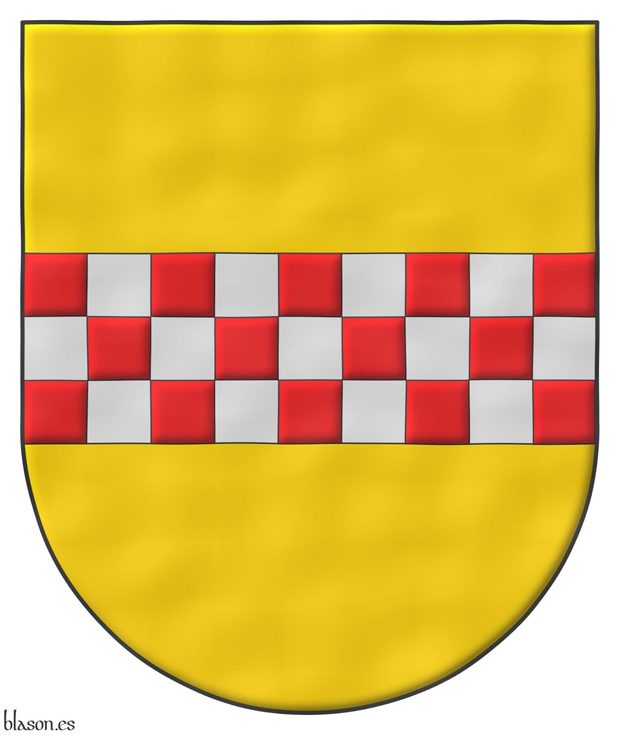
Or, a fess chequey Gules and Argent.
Escudo de oro, una faja ajedrezada de gules y plata.
Arms emblazoned by me, highlighted with lights and shadows, outlined in Sable, with a semi-circular external shape and with a watercolor finish.
Coat of arms of the County of Mark, Germany. I have emblazoned it with a fess chequy of 3 rows, symmetric and with 9 columns of squares, provided that its height is 1/3 of the width of the coat of arms.
Blazon keywords: Or, Gules, Argent, One, Three, Nine, Fess and Chequey.
Style keywords: Outlined in sable, Illuminated, Semi-circular and Watercolor.
Classification: Civic, Interpreted, Boa and Coat of arms.
Bearer: Mark, County of.


Martin S. J. Goldstraw, tartan 3x3
Argent, on a chevron Gules three feathers Argent, between three swords erect Gules. Motto: «Ab Initio Goostrey».
This is the coat of arms of Martin Goldstraw emblazoned by me over his family tartan. This tartan was designed by Don Smith and is registered in the Scottish Register of Tartans, 2002.
Blazon keywords: Without divisions, Argent, Gules, Chevron, Charged, Sword, Point upwards, Ordered, Between, Quill and Motto.
Style keywords: Rounded, Illuminated, Outlined in sable and Freehand.
Classification: Interpreted, Personal, Cheshire County and Tartan.
Bearer: Goldstraw, Martin S. J..


Mascarenhas, lineage of Portugal

Blazon of the Mascarenhas lineage of Portugal.
Gules, three bars Or.
Illuminated and a freehand finishing.
It can be found at [Cró, J. do; 1509; page 77].
Blazon keywords: Without divisions, Gules, Three, Fess and Or.
Style keywords: Freehand, Outlined in sable, Illuminated and Semi-circular.
Classification: Interpreted, Lineage and Kingdom of Portugal.


Mauleón of Navarre

Of the twelve lineages of Noblemen, the twelfth bears as insignia and arms, on a shield Or, a rampant lion Gules, as painted in this shield.
Or, a Lion Gules, rampant.
Escudo de oro, un león de gules, rampante.
Coat of arms interpreted with: a semicircular (round) base; the field in flat Or; the lion illuminated in Gules and outlined in the colour of the field, that is, in Or metal; and the whole finished in highly-hammered metal.
Coat of arms interpreted from the last of the shields of the Navarrese «ricoshombres» illustrated in [Bosque, J. del; 1540; folio 1 of the numbering of 1613] and with the text preceding the blazon taken from the transcription by [Martinena Ruiz, J. J.; 1982; pages 122 and 123].
I consider these to be canting arms, and that this «lion» Gules refers to its bearers «Mauleón».
Under the title «Surname of Mauleon», without an accent on the letter «o», it can be consulted in [Vega, P. J. de; 1702; folio 12 of the manuscript].
Blazon keywords: Without divisions, Or, Lion, Gules and Rampant.
Style keywords: Semi-circular, Illuminated, Outlined in sable and Hard metal.
Classification: Interpreted, Personal, Kingdom of Navarre and Canting.
Bearer: Mauleón of Navarre.


McCartney, Michael

Or, a stag trippant Gules, attired Azure; a bordure Azure charged with eight saltires couped Argent.
Escudo de oro, un ciervo pasante de gules, acornado de azur; una bordura de azur cargada con ocho sotueres de plata.
Coat of arms interpreted and emblazoned by me with with a semi-circular ended shape, illuminated, and with a parchment finishing.
Blazon keywords: Without divisions, Or, One, Stag, Tripant, Gules, Attired, Azure, Bordure, Charged, Eight, Saltire and Argent.
Style keywords: Parchment, Outlined in sable, Illuminated and Semi-circular.
Classification: Interpreted and Coat of arms.
Bearer: McCartney, Michael.


Miguel Francisco Lanzagorta Escutia
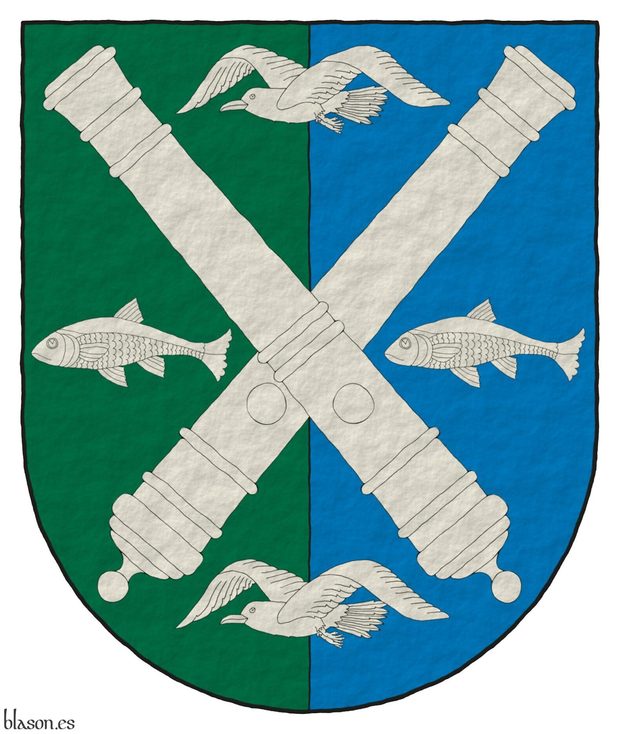
Party per pale Vert and Azure, overall two cannons dismounted in saltire, between two seagulls volant in pale, and two fish naiant in fess Argent.
Escudo partido de sinople y azur, brochante sobre el todo dos tubos de cañón en sotuer, acompañados de dos gaviotas volantes en palo y dos peces nadantes en faja, todo de plata.
Blazon keywords: Party per pale, Vert, Azure, Overall, Two, Cannon dismounted, Cannon, In saltire, Between, Seagull, Volant, In pale, Fish, Naiant, In fess and Argent.
Style keywords: Semi-circular, Outlined in sable and Plain tincture.
Classification: Personal, Interpreted and Coat of arms.
Bearer: Lanzagorta Escutia, Miguel Francisco.


Moguer, municipality of

Chequey of fifteen Or and Azure; a bordure compony of sixteen sections, eight gules, a castle triple-towered Or, port and windows Azure, masoned Sable, eight Argent, a lion rampant Purpure, crowned Or, armed and langued Gules.
Escudo ajedrezado de quince piezas de oro y azur; una bordura componada de dieciséis compones, ocho de gules, un castillo de oro, aclarado de azur, mazonado de sable, ocho de plata, un león rampante de púrpura, coronado de oro, armado y lampasado de gules.
Coat of arms emblazoned by me, highlighted with lights and shadows, outlined in Sable, with a semi-circular outer contour and with a watercolor finish.
Coat of arm of the municipality of Moguer, Andalusia, emblazoned by me.
Blazon keywords: Or, Azure, Gules, Argent, One, Fifteen, Sixteen, Eight, Chequey, Bordure, Compony, Section, Charged, Castle, Triple-towered, Port and windows, Masoned, Lion, Rampant, Crowned, Armed and Langued.
Style keywords: Outlined in sable, Illuminated, Semi-circular and Watercolor.
Classification: Civic, Interpreted, Boa and Coat of arms.
Bearer: Moguer, municipality of.


Montbard, André de

Azure, two barbels addorsed Argent.
Escudo de azur, dos barbos adosados de plata.
Coat of arms emblazoned by me with a semi-circular shape, illuminated, and with a freehand finishing.
Blazon keywords: Azure, Two, Barbel, Addorsed and Argent.
Style keywords: Outlined in sable, Semi-circular, Illuminated and Freehand.
Classification: Religious, Military, Knights Templar, Interpreted and Coat of arms.
Bearer: Montbard, André de.


Monteagudo of Navarra
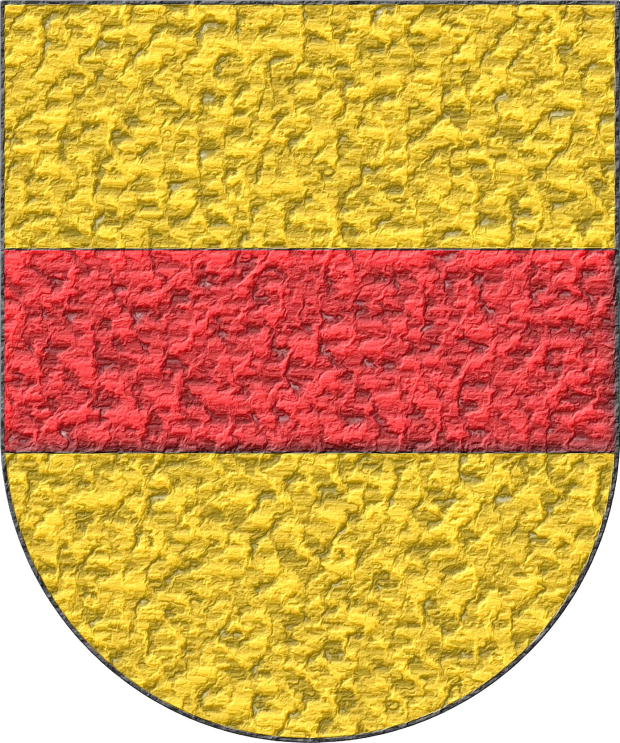
Of the twelve lineages of Noblemen, the eleventh is the house of Monteagudo; they bear as arms a shield Or, and in the middle a fess Gules, in the manner in which this shield is painted.
Or, a fess Gules.
Escudo de oro, una faja de gules.
Coat of arms interpreted as follows: a semicircular (round) base; the field enamelled in flat Or; the fess outlined in Sable and illuminated in Gules; and the whole finished in highly-hammered metal.
Interpreted from the eleventh coat of arms of the Navarrese «ricoshombres» from [Bosque, J. del; 1540; folio 1 of the numbering of 1613] and with the preceding text taken from the transcription appearing in [Martinena Ruiz, J. J.; 1982; pages 122 and 123].
Under the title «Surname of Monteagudo» this blazon can be consulted in [Vega, P. J. de; 1702; folio 11 of the manuscript].
Blazon keywords: Without divisions, Or, Fess and Azure.
Style keywords: Semi-circular, Illuminated, Outlined in sable and Hard metal.
Classification: Interpreted, Personal and Kingdom of Navarre.
Bearer: Monteagudo of Navarra.


Morgan, Michael W.

Or, a griffin segreant Sable, on a chief invected Azure three naval crowns Or, the whole debruised by a label of three points Argent.
Escudo de oro, un grifo rampante de sable; en un jefe acanalado de azur, tres coronas navales de oro, brisado de un lambel de tres pendientes de plata.
Arms interpreted by me, illuminated with lights and shadows, outlined in Sable, and with a leather finish.
Coat of arms of Michael W. Morgan, UE, emblazoned by me. He is the eldest son of Commander Stephen T. Morgan and his cadency mark is a label.
Blazon keywords: Or, Sable, Gules, Azure, Argent, One, Three, Griffin, Segreant, Chief, Invected, Naval crown, Cadency and Label of three points.
Style keywords: Outlined in sable, Illuminated and Leather.
Classification: Personal, Interpreted, Boa and Coat of arms.
Bearer: Morgan, Michael W..


Motto of Tomasz Arkadiusz Grzeszkowiak
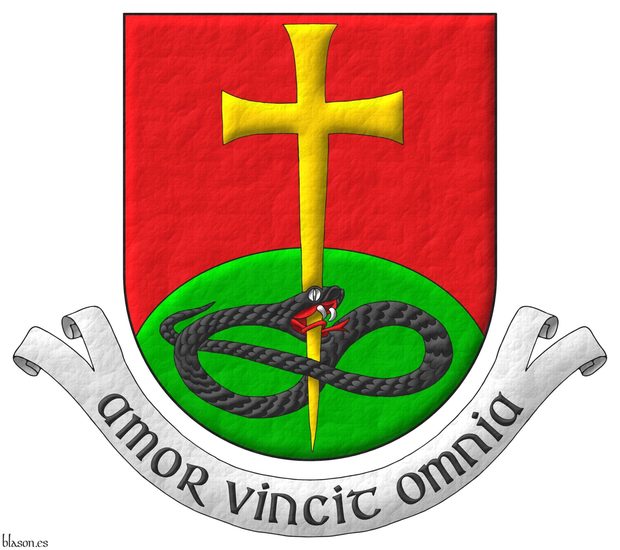
Gules, a base enarched Vert, overall a cross patty fitchy Or, piercing in base the head of a serpent nowed and facing sinister Sable, langued Gules. Motto: «Amor vincit omnia»
Blazon keywords: Without divisions, Gules, One, Mount, Vert, Issuant from base, Overall, Cross patty fitchy, Cross couped, Piercing, Head, Serpent, Nowed, Facing sinister, Sable, Langued and Motto.
Style keywords: Semi-circular, Leather and Outlined in sable.
Classification: Interpreted, Personal and Coat of arms.
Bearer: Grzeszkowiak, Tomasz Arkadiusz.


Municipality of Gudja

Argent, a fess dancetty of four points Gules. Motto: «Pluribus Parens».
Escudo de plata, una faja encajada de cuatro piezas de gules. Lema: «Pluribus Parens».
Arms emblazoned by me, illuminated with lights and shadows, contoured in Sable, with a pointed external shape and with a freehand finishing.
G0138, Chief Herald of Arms of Malta's grant for the arms of the municipality of Gudja, Malta. These arms have been emblazoned by me for such grant. The motto «Pluribus Parens» means «mother of many children», as Gudja was the historical center and origin of several nearby settlements such as Safi, Kirkop, Luqa, Mqabba, Tarxien, and others.
Blazon keywords: Argent, Gules, Four, Fess, Dancetty and Motto.
Style keywords: Outlined in sable, Illuminated, Pointed and Freehand.
Classification: Civic, Interpreted, Boa and Coat of arms.
Bearer: Gudja, municipality of.


Muscat, John
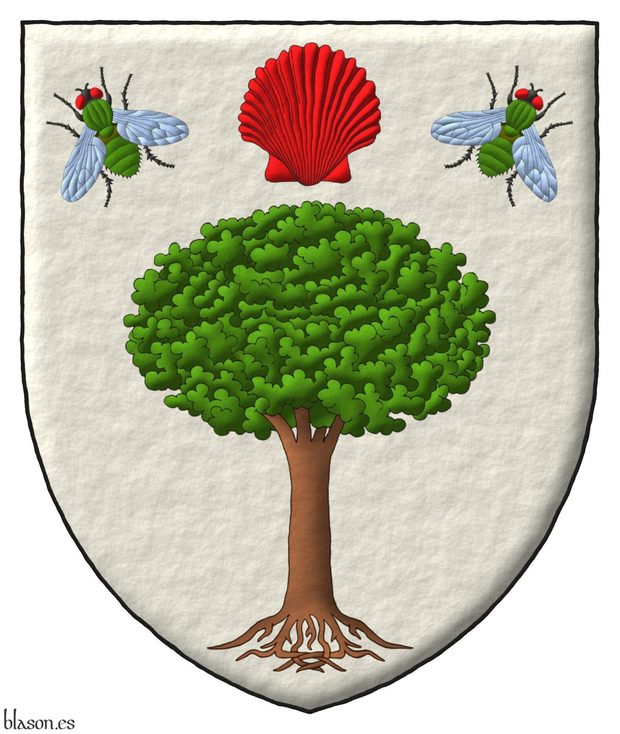
Argent, a tree eradicated proper, in chief an escallop reversed Gules, between two flies in pilewise proper.
Escudo de plata, un árbol arrancado al natural, en jefe una venera ranversada de gules acompañada de dos moscas puestas en pila al natural.
Arms painted by me, illuminated with lights and shadows, outlined in Sable, with a pointed external shape and with a freehand finish.
G0117, Chief Herald of Arms of Malta's grant of the coat of arms of the Reverend John Muscat, Honorary Monsignor of the Canon Chapter, Roman Catholic Cathedral of the Assumption, Gozo. This coat of arms has been emblazoned by me.
Blazon keywords: Argent, Gules, One, Two, Tree, Eradicated, Proper, In chief, Escallop, Between, Fly, Bendwise and Pilewise.
Style keywords: Outlined in sable, Illuminated, Pointed and Freehand.
Classification: Religious, Interpreted, Boa and Coat of arms.
Bearer: Muscat, John.


Nastri, Marcio Vieira

Tierced per fess: 1 Sable, seven mullets Argent arranged as the Plough of Ursa Major; 2 Azure; 3 Sanguine, a demi-sun issuant from base Or.
Escudo terciado en faja: 1o de sable, siete estrellas de cinco puntas de plata dispuestas como el Carro de la Osa Mayor; 2o de azur; 3o de sanguíneo con un sol moviente de la punta de oro.
Arms depicted by me, illuminated with lights and shadows, outlined in Sable, with an ogee external shape and with a leather finish.
Blazon keywords: Sable, Azure, Sanguine, Argent, Or, Seven, One, Tierced per fess, Mullet, Plough of Ursa Major, Demi, Sun, Issuant from base, Motto and Scroll.
Style keywords: Outlined in sable, Illuminated, Ogee and Leather.
Classification: Personal, Interpreted, Boa and Coat of arms.
Bearer: Nastri, Marcio Vieira.


Navarra, chains Or

Gules, a chain orlewise, crosswise, and saltirewise Or, charged in the fess point with an emerald Vert.
Escudo gules, una cadena puesta en orla, en cruz y en sotuer de oro, cargada en el centro de una esmeralda de sinople.
Coat of arms interpreted with: a semicircular (round) base; the field in flat Gules; the chains and the emerald illuminated in Or and Vert and outlined in Sable; and the whole executed with a raised-stroke finish.
This coat of arms, except for the emerald, corresponds to the blazon written in [Avilés, J.; 1780a; page 412 and figure 260] which says «Gules, a chain placed in orle, cross, and saltire Or, which some blazon differently», leaving me, as a reader, curious to know what that other way he refers to might be.
Then, [Avilés, J.; 1780a; pages 412–413] writes his version of the origin of the arms, saying that «...it was borne by Sancho VIII, called the Strong, and twenty-first King of Navarre, in the year 1212, for the battle of Las Navas de Tolosa in Sierra Morena ...given to him by the King of Castile, Don Alfonso IX, whose aid he had joined...», which we would say Alfonso VIII of Castile, «the one of Las Navas».
Blazon keywords: Without divisions, Gules, One, Chain, Orlewise, Crosswise, Saltirewise, Or, Charged, In the fess point, Emerald and Vert.
Style keywords: Freehand, Illuminated and Outlined in sable.
Classification: Interpreted, Civic and Coat of arms.
Bearer: Navarre.

Nhf, Norsk Heraldisk Forening
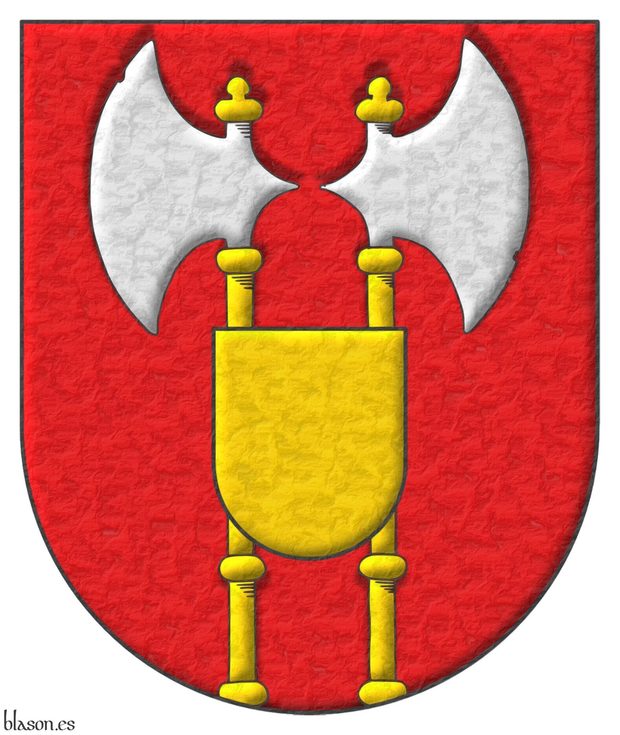
Gules, two Axes Argent, hafted Or, addorsed, issuant from the base; overall, at the nombril, an Escutcheon Or.
Escudo de gules, dos hachas adosadas de plata, fustadas de oro, movientes de la punta; brochante sobre el todo, en el ombligo, un escudete de oro.
Coat of arms interpreted with: the semicircular shape; its field illuminated with Gules; its figures and escutcheon illuminated with Or and Argent and outlined in Sable; and with a free hand texture.
At the nombril
A distinctive feature of this coat of arms is that its escutcheon, instead of being overall in the center, is positioned on a point of the coat of arms called the nombril, which, as we learn from [Avilés, J.; 1725a; page 159 and illustration 19] and also [Avilés, J.; 1780a; pages 147 and 148], in «Heraldry, the nombril of the coat of arms, is the place through which the human body receives nourishment in the mother's womb, and in the shield, it corresponds to the point where the fess ends and the base begins.».
If this escutcheon, «escudete» in Castilian, had been positioned in the center of the coat of arms, then it would have to be blazoned as the piece called an inescutcheon, «escusón» in Castilian. In fact, the Norsk Heraldisk Forening uses the English term «escutcheon» to describe the blazon of its arms.
Blazon keywords: Without divisions, Gules, Axe, Argent, Hafted, Or, Addorsed, Issuant from base, Overall, At the nombril and Escutcheon.
Style keywords: Semi-circular, Illuminated, Outlined in sable, Shaded and Soft metal.
Classification: Interpreted, Socioeconomic and Coat of arms.
Bearer: Norsk Heraldisk Forening.


Nicholas Malmains
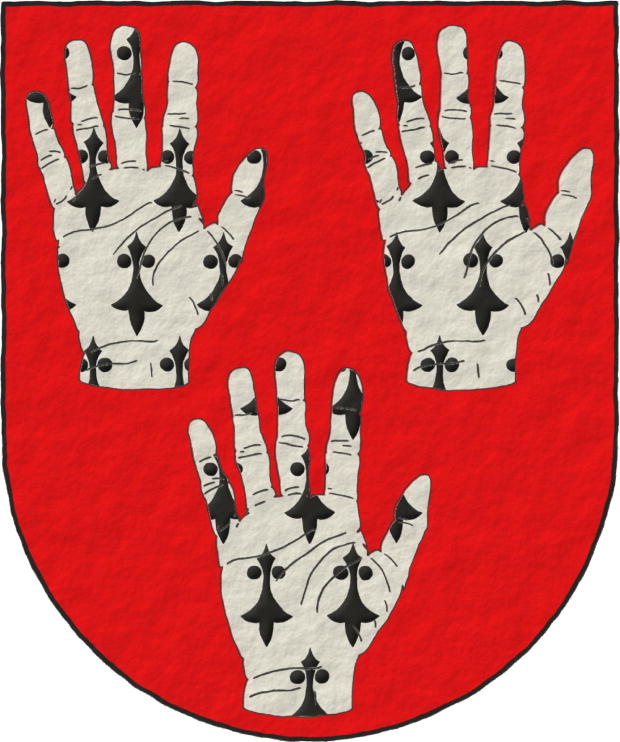
Nicolás Malmains ~ Nicholas Malmains ~ Nicol Malemeins.
Gules, three dexter hands turned up, and appaumée Ermine.
Escudo de gules, tres manos diestras levantadas y apalpadas de armiños.
Included in [Vincent, MS; 1285; number 622] also known as [St. George's Roll; 1285; number 622].
Blazon keywords: Without divisions, Gules, Three, Hand, Dexter, Ermine, Turned up, Appaumée and Ordered.
Style keywords: Semi-circular, Illuminated, Outlined in sable and Freehand.
Classification: Interpreted and Personal.
Bearer: Nicolás Malmains.


Nilda Ernestina Lucca de Anaya
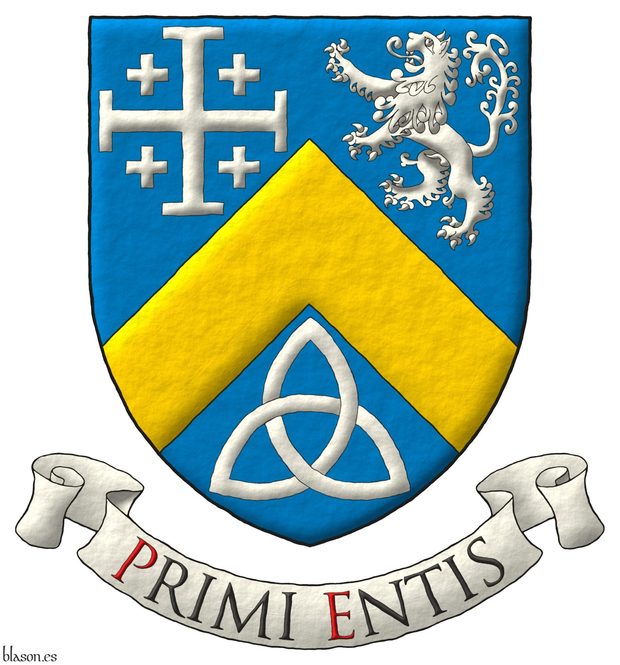
Azure, a chevron Or, between in chief a cross potent cantoned of crosslets, and a lion rampant, and in base a Celtic Trinity knot Argent. Motto: «Primi entis» Sable, with initial letters Gules, over a scroll Argent.
Escudo de azur, un cabrio de oro, acompañado en jefe de una cruz potenzada cantonada de cuatro cruces, y un león rampante, en punta de un nudo celta de la Trinidad, todo de plata. Lema: «Primi entis» de sable, con iniciales de gules, sobre una filacteria de plata.
Design rationale
The Cross of the Episcopal Church, a lion because of the city of Ponce, Puerto Rico, a Holy Spirit symbol, the tinctures of Anaya Argent, Or, and Azure, and her motto for being the first woman ordained as a priest in the Episcopal Anglican Church in Latin America, and one of the first in the United States of America.
Credits:
- Ernesto Juan Anaya is the designer of the coat of arms.
- Antonio Salmerón y Cabañas is the author of the heraldic art.
Blazon keywords: Azure, One, Chevron, Or, Between, In chief, Cross of Jerusalem, Cross couped, Cross potent, Cantoned, Four, Crosslet, Lion, Rampant, In base, Celtic Trinity knot, Knot, Celtic, Trinity, Scroll, Charged and Motto.
Style keywords: Outlined in sable, Illuminated, Pointed and Freehand.
Classification: Religious, Interpreted, Coat of arms, Latin language and Design rationale.
Bearer: Lucca de Anaya, Nilda Ernestina.


Noblemen of Navarre

The King of Navarre, at the time of his new and solemn coronation, is raised and lifted up as King by the hands of twelve barons of the greatest and oldest houses of the said Kingdom, and these are the twelve Noblemen who are named on the other side, with their blazons and coats of arms.
Interpretation and composition of 13 coats of arms that I have created with a parchment-like finish.
A free interpretation, for example, without the central crown over the arms of Navarre, with a different title, written «Navarra» and not «Nabarra», etc., based on the principal plate of [Bosque, J. del; 1540; folio 1 of the numbering of 1613] and with texts taken from the transcription by [Martinena Ruiz, J. J.; 1982; pages 122 and 123].
«Ricohombre», written together, currently means «title that formerly belonged to the highest nobility of Spain», [Real Academia Española; 2001].
Its plural «ricoshombres» is the most commonly used form, but «ricohombres» is also correct and used; and in [Bosque, J. del; 1540] it is written separately, and «honbre» with an «n» before the «b», that is, «ricos honbres».
Blazon keywords: Without divisions, Party per bend, Azure, Gules, Or, Argent, Sable, Vert, Eagle, Chequey, Cross flory, Cross couped, Fess, Chief, Lion, Pale, Poplar leaf, Clay pot and Rampant.
Style keywords: Semi-circular and Old parchment.
Classification: Interpreted and Kingdom of Navarre.
Bearer: Noblemen of Navarre.


Norman Darcy

Norman de Darcy ~ Norman Darcy ~ Norman de Arci.
Argent, three cinquefoils Gules.
Escudo de plata, tres quinquefolios de gules.
Included in [Vincent, MS; 1285; number 230] also known as [St. George's Roll; 1285; number 230].
Blazon keywords: Without divisions, Argent, Three, Cinquefoil, Gules and Ordered.
Style keywords: Triangular curved, Illuminated, Shaded, Outlined in sable and Fabric.
Classification: Interpreted and Personal.
Bearer: Norman de Darcy.


Northam, Jason Landers
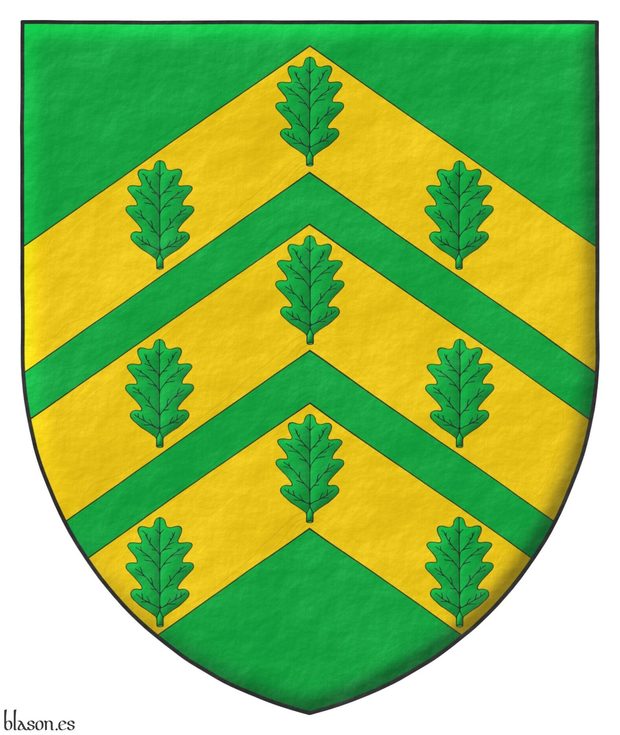
Vert, on three chevrons Or nine oak leaves Vert, 3, 3, and 3.
Escudo de sinople, tres cabrios de oro cargados de nueve hojas de roble de sinople, 3, 3 y 3.
Coat of arms interpreted by me, illuminated with lights and shadows, outlined in Sable, with a pointed external shape and with a rough finishing.
Coat of arms of Jason Landers Northam from Illinois, emblazoned by me. His coat of arms, his badge, and his heraldic standard are registered in The International Register of Arms, 4th July 2025, registration number 0745, volume 5.
Blazon keywords: Vert, Or, Three, Nine, Chevron, Oak, Tree, Leaf and Motto.
Style keywords: Outlined in sable, Illuminated, Pointed and Rough.
Classification: Personal, Interpreted, Boa and Coat of arms.
Bearer: Northam, Jason Landers.


Order of Alcantara, emblem
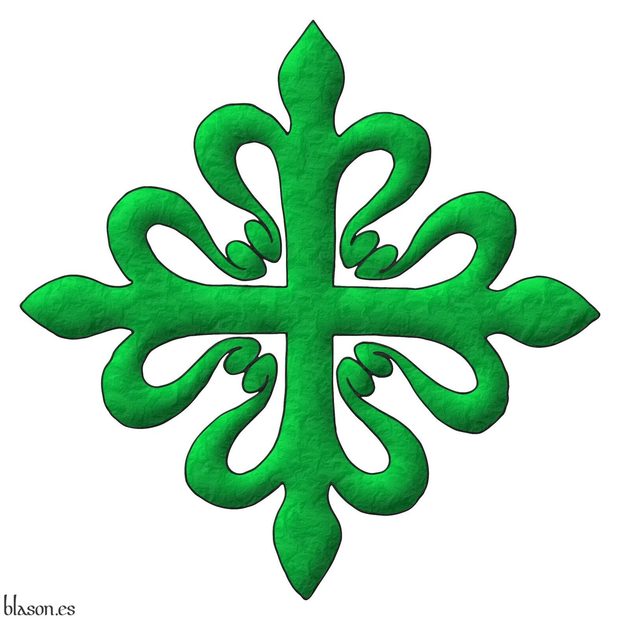
Order of Cavalry of Alcantara
A cross of Alcantara.
Una cruz de Alcántara.
Interpretation of the emblem of the order with: its cross outlined in Sable, illuminated in Vert; and a heavily beaten metal finish.
The Royal Council of the Orders of Chivalry of Santiago, Calatrava, Alcantara, and Montesa, in its historical account of the foundation of the Order of Alcantara, states that, according to Alonso de Torres y Tapia, Prior of Alcantara and a 17th-century chronicler, it was founded in 1156, by Don Suero Fernández Barrientos along with other knights from Salamanca, in Pereiro near the River Coa, under the name of the Order of Saint Julian of Pereiro and during the reign of Ferdinand II of León.
Emblem
Regarding the emblem of the Order of Cavalry of Alcantara, [Avilés, J.; 1780b; treatise IV, chapter V, page 340, figure 102], reusing the same figure 102 as for the Order of Calatrava, says «In the past, the Order of Alcantara displayed on its Standard the Gules Straps of Calatrava», remember that due to the commandery of the city of Alcantara, they had to assume some dependency on that of Calatrava, «next to a Pear tree in Vert on a field of Or, which was the insignia of the Order of Pereiro, due to the conformity with which these two Orders lived; but upon changing their Habit, the Pope» Eugene IV «granted them the green Cross», Vert, «in the manner they wear it today, differing from that of Calatrava only in color».
Blazon keywords: Cross of Alcantara, Cross couped and Cross.
Style keywords: Illuminated, Outlined in sable and Soft metal.
Classification: Interpreted, Religious, Military and Emblem.
Bearer: Alcantara, Order of.


Order of Calatrava, emblem
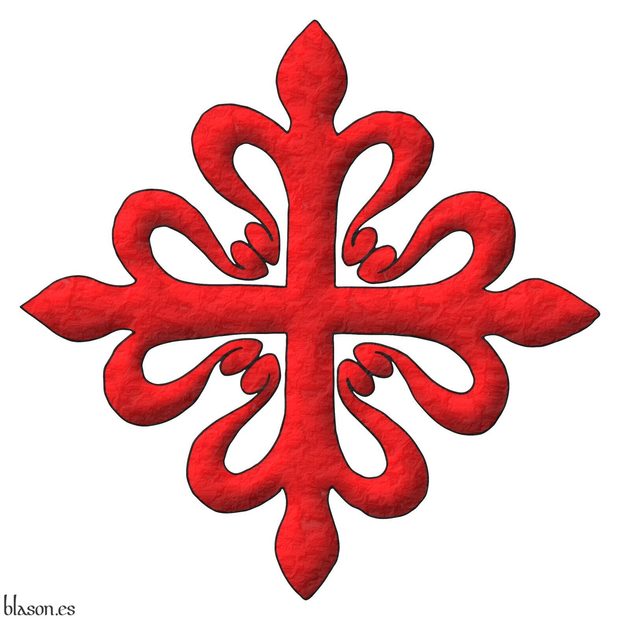
Order of Chivalry of Calatrava
A cross of Calatrava.
Una cruz de Calatrava.
Interpretation of the emblem of the order with: its cross outlined in Sable, illuminated in Gules; and a heavily beaten metal finish.
The Royal Council of the Orders of Chivalry of Santiago, Calatrava, Alcantara, and Montesa, in its historical review of the foundation of the Order of Calatrava, states that it was founded during the reign of Sancho III of Castile in the 12th century.
After the Templars withdrew from the defense of the town, King Sancho III proposed in Toledo and later confirmed in Almazán, in January 1158, the perpetual donation of the town of Calatrava to Raymond, then Abbot of the Cistercian monastery of Fitero, who, together with the former soldier Diego Velázquez, committed to defending it from attacks by the Almohads. For this mission, they received financial support from the Archbishop of Toledo, Juan, and from Toledo itself, thus managing to form an army of more than 20,000 men.
Emblem
Regarding the emblem of the Order of Chivalry of Calatrava [Avilés, J.; 1780b; treatise IV, chapter IV, page 338, figure 102] it states «the Seal was always a red cross with blue straps, and the Banner originally bore a black Cross; but today they use the red cross florety, bordered with eight circles, placed side by side, and joined at the center, formed by a cord that emerges from the leaves of the flower, which Benedict XIII gave (while recognized in Spain) and which is the Commandery that the Knights of this Order wear on their chest today, or hanging from a red ribbon on a gold medal; that is, on a field of Or a cross of Gules».
Blazon keywords: Cross of Calatrava, Cross couped and Cross.
Style keywords: Illuminated, Outlined in sable and Soft metal.
Classification: Interpreted, Religious, Military and Emblem.
Bearer: Calatrava, Order of.


Order of Mercy, rounded and crystalline
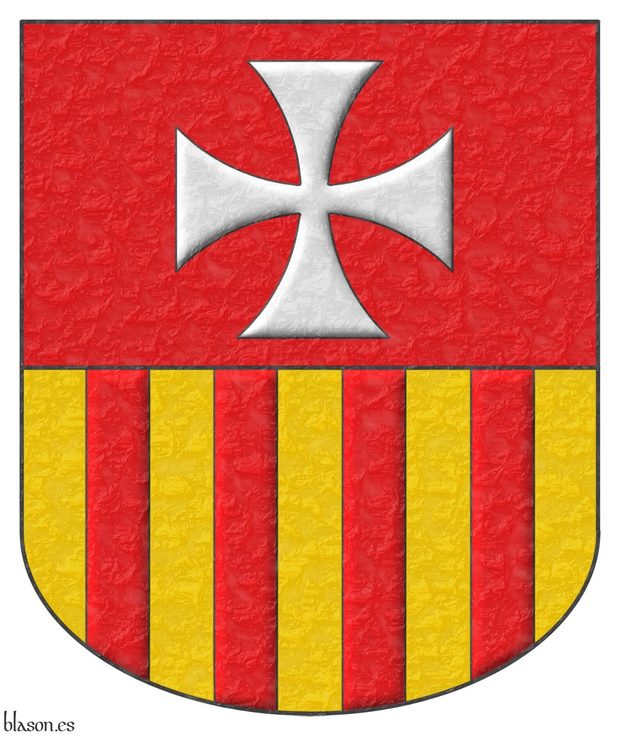
Party per fess: 1 Gules, a cross patty Argent; 2 Or, four pallets Gules.
Escudo cortado: 1o de gules, una cruz patada de plata; 2o de oro, cuatro palos de gules.
Already existing arms interpreted by me in the following manner: the mouth of the coat of arms is rounded in shape; the field has been enameled with Gules and Or flat tinctures; its cross patty and its 4 pales are illuminated; and the whole has received a crystalline finish.
The redemptive mission of the Order of Mercy, founded by Peter Nolasco on August 10, 1218, is represented by a cross Argent, a symbol of innocence and purity, on a field Gules, of blood ready to be shed, and the pales Gules, symbols of love and charity, on a field Or, are an expression of nobility and goodness.
Blazon keywords: Party per fess, Gules, Or, Argent, Cross, One, Cross patty, Cross couped and Pale.
Style keywords: Rounded, Illuminated, Outlined in sable and Crystalline.
Classification: Interpreted, Religious and Coat of arms.
Bearer: Our Lady of Mercy, Order of.


Order of Montesa, emblem
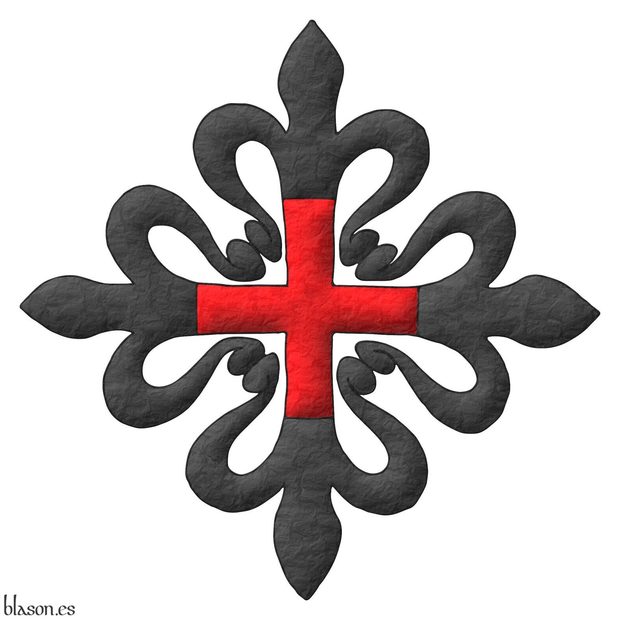
Order of Chivalry of Saint Mary of Montesa and Saint George of Alfama.
A cross of Montesa.
Una cruz de Montesa.
Interpretation of the emblem of the order with: its cross outlined in Sable, illuminated in Gules; and a highly hammered metal finish.
The Royal Council of the Orders of Chivalry of Santiago, Calatrava, Alcantara, and Montesa, in its historical review of the founding of the Order of Montesa, states that it was created in 1317, at the request of James II, King of Aragon, through a bull issued by Pope John XXII.
Emblem
About the emblem of the Order of Chivalry of Montesa [Avilés, J.; 1780b; treatise IV, chapter VI, page 342, figure 103], it states that «the Ensign of the Knights of Montesa is a plain red Cross», gules, «plain, which they wear on their Capitular Mantles, or hanging from a red ribbon on the chest over a gold oval; that is, on a field of gold a plain cross of gules (different from how the Masters wore it)» and, therefore, it describes the first emblem of the Order of Montesa and not the one they wear now, which is that same plain cross of gules charged on a cross like that of the Order of Calatrava or like that of the Order of Alcantara, but in Sable instead of Gules or Vert.
Blazon keywords: Cross of Montesa, Cross couped and Cross.
Style keywords: Illuminated, Outlined in sable and Soft metal.
Classification: Interpreted, Religious, Military and Emblem.
Bearer: Montesa, Order of.


Order of Santiago, emblem

Order of Chivalry of Santiago
A cross of Saint James.
Una cruz de Santiago.
Interpretation of the emblem of the order with: its cross outlined in Sable, illuminated in Gules; and a heavily hammered metal finish.
The Royal Council of the Orders of Chivalry of Santiago, Calatrava, Alcantara, and Montesa, in its historical account of the foundation of the Order of Santiago, describes three different points of view:
- The one presented by tradition, which establishes it in 844, after the battle of Clavijo, when fourteen knights led by the Field Master Don Sancho Martínez de Tejada requested permission from Don Ramiro I, king of Asturias between the years 842 and 850, to found it. This traditional view is the one recorded in [Avilés, J.; 1780b; treatise IV, chapter II, page 325] when discussing the origin of the «Military Order of Santiago of the Sword».
- The perspective of historians like Claudio Sánchez Albornoz or Américo Castro, who question the earlier date. Furthermore, [Sánchez Albornoz, C.; 1965; pages 94-136], as cited in [Domínguez García, J.; 2008; pages 69-70], proposes that the actual battle of Clavijo occurred later, in the year 859, and that Ramiro I did not participate, but rather it was a conflict between King Ordoño I and the Moor Muza.
- The view of historians who, based on the statutes of the order found in the Monastery of Uclés, which was the residence of the Master of the Order of Santiago, and the Latin in which they are written, believe that the foundation could indeed date back to the reign of Don Ramiro I.
Emblem
Regarding the emblem of the Order of Chivalry of Santiago, [Avilés, J.; 1780b; treatise IV, chapter II, page 328, plate 25, figure 100] states «the Commandery of this Order was always a red Sword» (gules ~ red), «in the form of a Cross, just as the guards of the ancient Swords that its Knights and Commanders carried on their white Mantles, and today also on the chest in the same manner, hanging from a red ribbon on a gold medal; that is, in a field of Or, a Cross of Gules».
Blazon keywords: Cross of Saint James, Cross couped and Cross.
Style keywords: Illuminated, Outlined in sable and Soft metal.
Classification: Interpreted, Religious, Military and Emblem.
Bearer: Santiago, Order of.


Ormazabal of the Basque Country, lineage
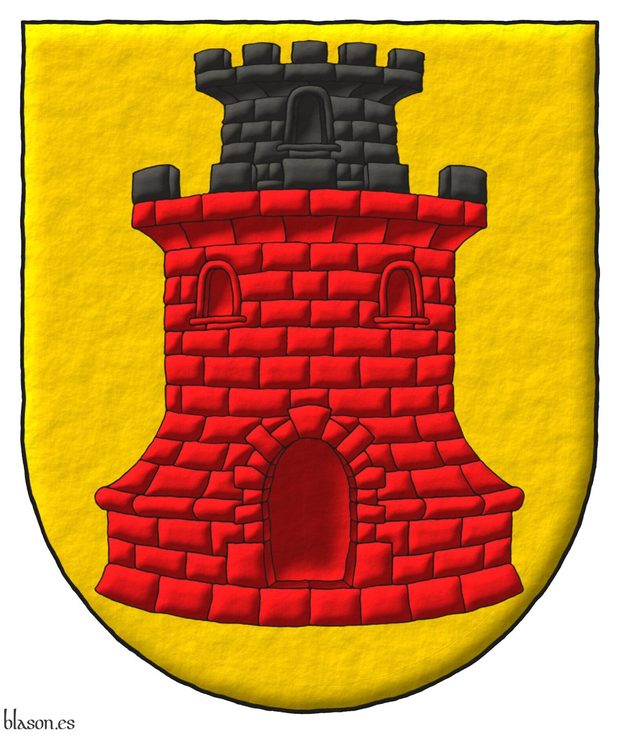
Or, a tower Gules, embattled, masoned and with a turret Sable.
Escudo de oro, una torre de gules, almenada, mazonada y donjonada de sable.
Coat of arms emblazoned by me, highlighted with lights and shadows, outlined in Sable, with a semi-circular outer contour and with a freehand finishing.
Ancient arms of the lineage Ormazabal of the Basque Country emblazoned by me.
Blazon keywords: Or, Gules, Sable, One, Tower, Embattled, Masoned and With a turret.
Style keywords: Outlined in sable, Illuminated, Semi-circular and Freehand.
Classification: Personal, Lineage, Interpreted, Boa and Coat of arms.
Bearer: Ormazabal of the Basque Country, lineage.


Orrantia of the Basque Country, lineage

Vert, a bend sinister Argent.
Escudo de sinople, una barra de plata.
Coat of arms emblazoned by me, illuminated with lights and shadows, outlined in Sable, with a semi-circular outer contour and with a freehand finishing.
Coat of arms of the lineage Orrantia of the Basque Country emblazoned by me.
Blazon keywords: Vert, Argent, One and Bend sinister.
Style keywords: Outlined in sable, Illuminated, Semi-circular and Freehand.
Classification: Personal, Lineage, Interpreted, Boa and Coat of arms.
Bearer: Orrantia of the Basque Country, lineage.


Oschoven of the Rhin

Argent, flanched Sable, in chief a mullet of six points Gules.
Escudo de plata, flanqueado curvo de sable, en jefe una estrella de seis rayos de gules
Coat of arms interpreted with: a semicircular (round) base; illuminated in the tinctures Argent, Gules, and Sable; all outlined in Sable; and finished with a raised-stroke effect.
[Avilés, J.; 1725a; pages 92 and figure 197] blazons it as «Argent, and a six-pointed star Gules in chief, flanched in oval Sable». When he illustrates it in [Avilés, J.; 1725a; figure 197], the space left between both flanches is only 1/5 of the base of the coat of arms; this is feasible because the only charge is a mullet in chief. If there were more charges, it would be necessary to leave more space, for example, 1/3 of the base of the shield.
«Oschoven au Rhein» in the book [Menestrier, C. F.; 1659; page 315], it is blazoned «d'argent flanqué arrondi de sable à vne molette de mesme en chef», so the mullet would be Sable, bacause «de mesme» is written, and with a hole in the middle, this hole does not exits in other sources.
In the book [Rietstap, J. B.; 1861], it is blazoned «Argent, flanched in round Sable, Argent charged in chief of a mullet Gules», and in French «d'argent, flanqué en rond de sable, l'argent chargé en chef d'une étoile de gueules».
Some time ago I used to blazon it in English as «Argent, in chief a mullet of six points Gules, between two flanches Sable».
Blazon keywords: Argent, Sable, Gules, Mullet, Chief and Flanched.
Style keywords: Semi-circular, Illuminated, Outlined in sable and Freehand.
Classification: Interpreted and Personal.
Bearer: Oschoven of the Rhin.


Osona, lineage
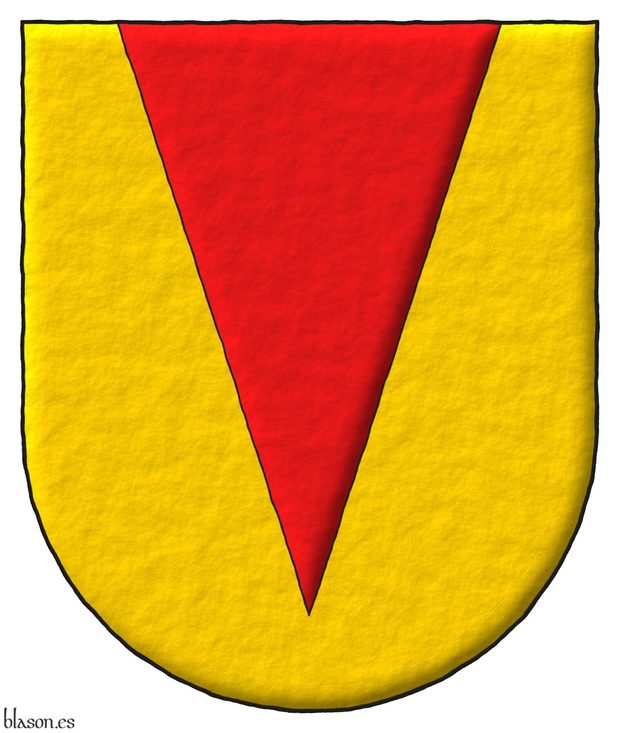
Or, a pile Gules.
Escudo de oro, una pila de gules.
Coat of arms emblazoned by me, illuminated with lights and shadows, contoured in Sable, with a semi-circular external shape and with a freehand finishing.
Coat of arms of the lineage Osona emblazoned by me based on the description by [Cadenas y Vicent, V. de; 1987; page 1325].
Blazon keywords: Or, Gules, One and Pile.
Style keywords: Outlined in sable, Illuminated, Semi-circular and Freehand.
Classification: Personal, Lineage, Interpreted, Boa and Coat of arms.
Bearer: Osona, lineage.


Patus, lineage

Gules, three fleur de lis Or.
Escudo de gules, tres flores de lis de oro.
Coat of arms depicted by me, highlighted with lights and shadows, contoured in Sable, with a semi-circular outer contour and with a leather finish.
Coat of arms of the lineage Patus emblazoned by me.
Blazon keywords: Gules, Or, Three and Fleur de lis.
Style keywords: Outlined in sable, Illuminated, Semi-circular and Leather.
Classification: Personal, Interpreted, Boa and Coat of arms.
Bearer: Patus, lineage.


Persad, Ria

Azure chapé Argent, in dexter an Indian ringneck parrot proper, in sinister a Japanese red chrysanthemum proper, in base an atom Argent.
Escudo de azur cortinado de plata: 1o, una cotorra india de Kramer al natural; 2o, un crisantemo japonés al natural; 3o, un átomo de plata.
Arms painted by me, illuminated with lights and shadows, outlined in Sable, and with a watercolor finish.
Coat of arms of Ria Persad, from Trinidad and Tobago (birth), India and Japan (ancestry), and USA (residence). Her coat of arms has been designed by her, by Rudolph Juchter van Bergen Quast of the Netherlands, and by Kevin D. Couling of the United Kingdom, resident in New Zealand, and painted by me, from the Kingdom of Spain.
Design rationale
Mathematician and astrophysicist from Harvard and Princeton Universities, as well as a classical musician, she represents a woman of the world—scientific and with diverse roots, who expresses her identity through a symbolic language of her own creation. Her design and execution are the result of an international team, in service of an equally international woman, and reflect a path of evolution toward which heraldry is advancing. The Kramer parrot (Psittacula krameri, Indian Ringneck) is shown in its natural colour. It is her favourite animal and at the same time evokes her Indian heritage. The red chrysanthemum, painted in a Japanese style, refers to her Japanese ancestry. The atom symbolises her education and professional career in the field of science. Blue, which dominates the whole, is her favourite colour.
Blazon keywords: Azure, Argent, One, Chapé, Dexter, Parrot, Proper, Sinister, Chrysanthemum, Base and Atom.
Style keywords: Outlined in sable, Illuminated and Watercolor.
Classification: Personal, Interpreted, Design rationale, Boa, Coat of arms, India and Japan.
Bearer: Persad, Ria.


Peter Ferdinand Gummersbach
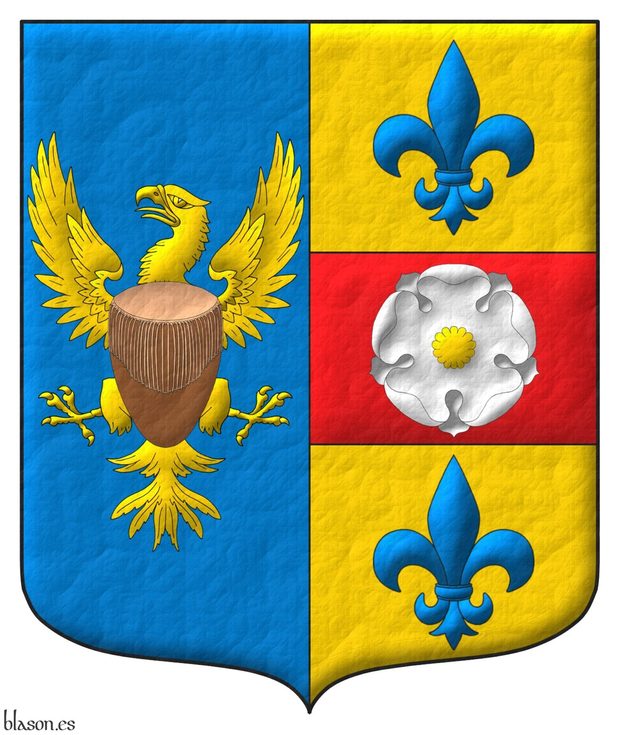
Party per pale: 1 Azure, an eagle displayed Or, charged on the chest with a Royal drum of Bunyoro-Kitara Kingdom proper; 2 Or, on a fess Gules between two fleur de lis Azure, a rose Argent, seeded Or.
Coat of arms emblazoned by me with a shape ended with an ogee arch, illuminated, and its finishing is that seems leather.
This coat of arms was augmented with the Royal drum of the kingdom of Bunyoro-Kitara.
Blazon keywords: Party per pale, Azure, One, Eagle, Or, Charged, Chest, Drum, Royal, Proper, Fess, Gules, Rose, Argent, Seeded, Between, Two, Fleur de lis, In chief and In base.
Style keywords: Ogee, Outlined in sable, Illuminated and Leather.
Classification: Personal, Interpreted and Coat of arms.
Bearer: Gummersbach, Peter Ferdinand.


Peter Iacobucci
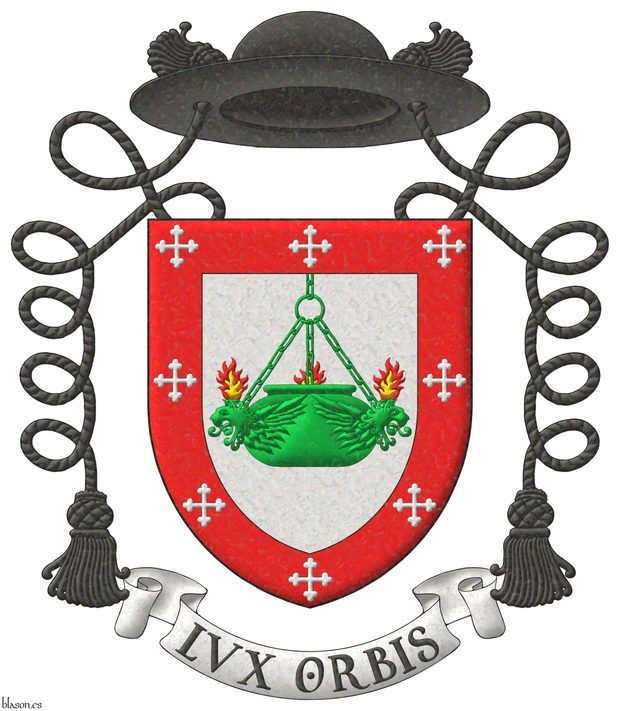
Argent, a suspended oil lamp of three lions' heads erased and winged Vert, two heads visible, enflamed proper; a bordure Gules, charged with eight crosses botonny Argent. Crest: A galero with two cords, one on each side, each with a tassel Sable. Motto «Lux Orbis».
Escudo de plata, pendiente del jefe una lampara de aceite de tres cabezas de león arrancadas y aladas de sinóple; una bordura de gules cargada de ocho cruces botonadas de plata. Timbrado de un galero con cordones y una borla a cada lado de sable. Lema «Lux Orbis»
Coat of arms emblazoned by me, highlighted with lights and shadows, outlined in Sable, with a pointed outer contour and with a iridescent finishing.
Blazon keywords: Argent, Vert, Gules, Sable, One, Three, Two, Eight, Suspended, Oil lamp, Lion, Head, Erased, Winged, Visible, Enflamed, Proper, Bordure, Charged, Cross botonny, Crest, Galero, Cord, Tassel and Motto.
Style keywords: Outlined in sable, Illuminated, Pointed and Iridescent.
Classification: Religious, Interpreted, Boa and Coat of arms.
Bearer: Iacobucci, Peter.


Peter II of Urgell

Count of Urgell, Viscount of Àger, Baron of Entença, Antillón, and Alcolea de Cinca (1340–1408).
Dimidiated: 1 Or, four pallets Gules; 2 chequey Or and Sable.
Escudo dimidiado: 1o de oro, cuatro palos de gules; 2o ajedrezado de oro y sable.
Arms interpreted with: the escutcheon in a pointed and rounded shape; the tinctures of the pales and the chequey rendered in flat inks Or, Gules, and Sable; and the whole finished with a highly hammered metal effect.
Peter II of Urgell (1340–1408), Count of Urgell, Viscount of Àger, and Baron of Entença, Antillón, and Alcolea de Cinca, was a prominent figure of 14th-century Catalan nobility and grandson of Alfonso IV of Aragon.
Blazon keywords: Dimidiated, Pale, Chequey, Or, Gules and Sable.
Style keywords: Ogee, Plain tincture and Hard metal.
Classification: Interpreted, Personal, Coat of arms and Kingdom of Aragon.
Bearer: Peter II of Urgell.


Peter IV of Aragon

And II of Valencia and of Ampurias, I of Mallorca and Sardinia, and III of Barcelona.
Or, four pallets Gules.
Escudo de oro, cuatro palos de gules.
Coat of arms of this king of Aragon interpreted by me as follows: the escutcheon shape is curved triangular; the field and the 4 pallets are rendered in flat tinctures Or and Gules; and the whole shield has a watercolored finish.
This curved triangular shape of the escutcheon is inspired by the shield shown in the lower central part of a document issued by the king himself [Pedro IV de Aragón; 1353].
Blazon keywords: Without divisions, Or, Four, Pale and Gules.
Style keywords: Triangular curved, Illuminated and Watercolor.
Classification: Interpreted, Personal, Coat of arms and Kingdom of Aragon.
Bearer: Peter IV of Aragon.


Philip Daubeny
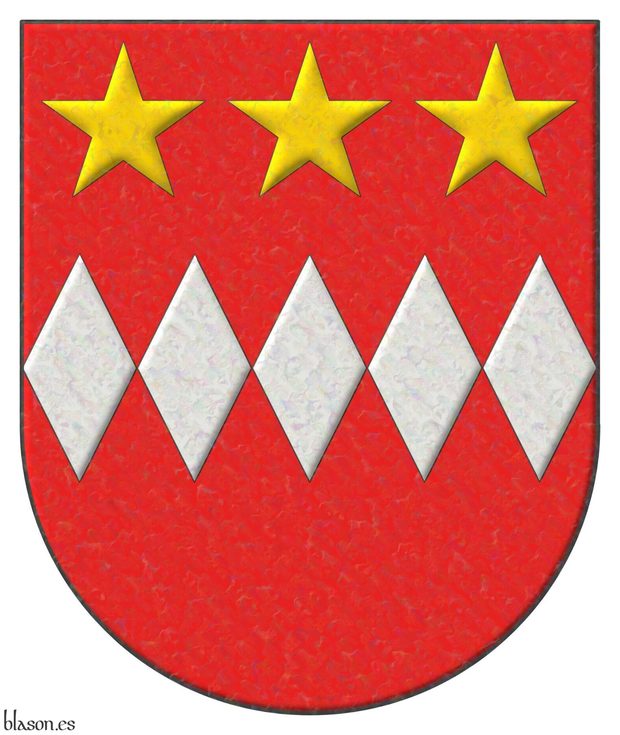
Philip Daubeny ~ Philip Daubeney.
Gules, a fess of five fusils Argent, in chief three mullets Or.
Escudo de gules, una faja de cinco fusos de plata, en jefe tres estrellas de oro.
Coat of arms interpreted in the following manner: the shape of the base is semicircular; the field is illuminated in Gules; the fusils outlined in Sable and illuminated in metal Argent; the fess is 5 fusils in length; the 3 mullets in chief of 5 points, outlined in Sable and illuminated in metal Or; and the whole with an iridescent finish.
This post corresponds to the English post number 61 in the same series.
Blazon keywords: Gules, Fusil, Argent, In fess, Mullet, Or and In chief.
Style keywords: Semi-circular, Illuminated, Outlined in sable and Iridescent.
Classification: Interpreted and Personal.
Bearer: Daubeny, Philip.


Philip III of France

King of France from 1270 to 1285, grandson of Blanche of Castile.
Azure semé of fleurs de lis Or.
Escudo de Azur sembrado de flores de lis de oro.
Coat of arms interpreted with: a pointed base; the field enamelled in flat Azure; the fleurs-de-lis illuminated in Or and outlined in Sable; and finished with a parchment effect.
During his reign, it is believed that the second part of the armorial [Wijnbergen; 1265] was completed, which ends with the coats of arms of several kings, many of them European, beginning this series with the coat of arms of the King of France himself, [Wijnbergen; 1265; shield no. 1,288], which has served as the inspiration for the one recreated here.
Blazon keywords: Without divisions, Azure, Or, Semé and Fleur de lis.
Style keywords: Pointed, Illuminated, Outlined in sable and Parchment.
Classification: Interpreted, Personal, Coat of arms, Kingdom of France and House of the Capetians.
Bearer: Philip III of France.


Philip of Castile, Infante
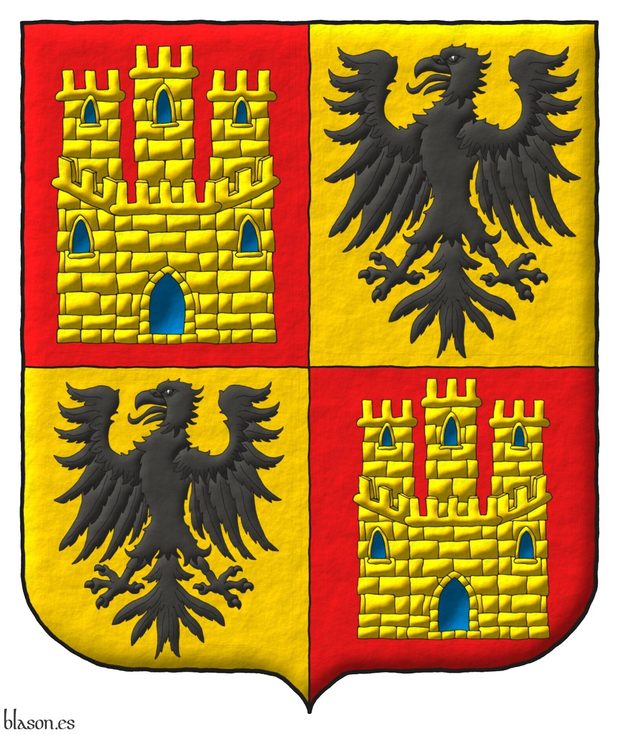
Quarterly: 1 and 4 Gules, a castle triple-towered Or, port and windows Azure, and masoned Sable; 2 and 3 Or, an eagle displayed Sable.
Escudo cuartelado: 1o y 4o de gules, un castillo de oro, aclarado de azur, mazonado de sable; 2o y 3o de oro, un águila de sable.
Arms painted by me, illuminated with lights and shadows, outlined in Sable, with an ogee external shape and with a freehand finish.
Coat of arms of the Infante Philip of Castile, 1231–1274, 7th offspring of the King Ferdinand III of Castile, 1199-1252, and the Queen Beatrice of Swabia, 1205–1235. This coat of arms has been emblazoned by me and can be consulted in [Messía de la Cerda y Pita, L.; 1990; page 146] with the field Or in the 2nd and 3rd quarters. He bears a quarterly shield combining the first quarter of his father’s arms, Castile, with his mother’s arms. Among all his siblings, he is the one who most closely combines the arms of both parents.
Blazon keywords: Gules, Or, Azure, Sable, One, Quarterly, Castle, Triple-towered, Port and windows, Masoned and Eagle.
Style keywords: Outlined in sable, Illuminated, Ogee and Freehand.
Classification: Personal, Kingdom of Castile and Leon, Interpreted, Boa and Coat of arms.
Bearer: Philip of Castile, Infante.


Pius V
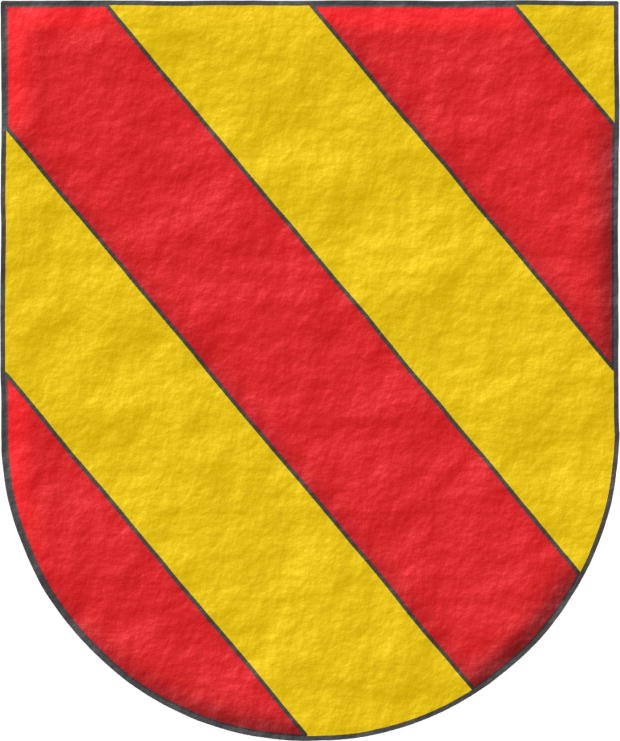
225th Pope of the Church, from 1566 to 1572. «Pius V», named Antonio Michele Ghislieri, was canonized in 1712.
Bendy of six Gules and Or.
Escudo bandado de seis piezas de gules y oro.
Papal coat of arms interpreted with: a rounded mouth; the field in flat tincture of Or; the bands outlined in Sable and illuminated in Gules; and the whole with a rough finish.
I have also seen this coat of arms described as «a shield banded of six pieces of Or and Gules».
Blazon keywords: Without divisions, Bendy, Six, Gules and Or.
Style keywords: Semi-circular, Illuminated, Outlined in sable and Rough.
Classification: Interpreted, Religious and Papal States.
Bearer: Pius V.


Ponce I of Urgell
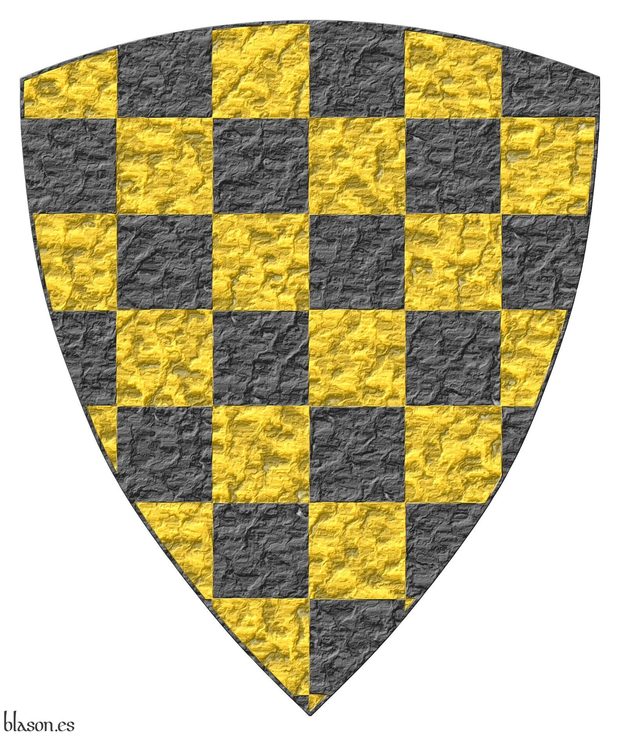
Count of Urgell, Viscount of Àger, deceased in 1243.
Chequey Or and Sable.
Escudo ajedrezado de oro y sable.
Arms interpreted with: a shield shaped as a triangle with curved sides; the chequey pattern in flat metal Or and colour Sable; and a heavily beaten metal finish.
[Avilés, J.; 1780a; page 286] states that he will call «Chequey those ordinaries composed of these small squares, which alternate between metal and colour, or vice versa, just like the boards of those Games.» and he also writes regarding the usual number of panes that «it must have six ranks or rows of these squares, though it is not necessary to specify their number, or at least the shield must include more than fifteen panes; it is only required, to properly blazon it, to always observe the first square, which is in the chief dexter; so that, if this is Or, and the one that follows is Gules, it is said to be Chequey Or and Gules, and so with other colours and metals.»
Although Ponce initially proclaimed himself count of the county of Urgell without sufficient rights, the death of the legitimate heiress and his agreements and assistance to king James I of Aragon enabled him to legalise his title. During this process, the capital of the county ceased to be the municipality of Balaguer only to eventually become it once again.
Blazon keywords: Chequey, Or and Sable.
Style keywords: Triangular curved, Plain tincture and Hard metal.
Classification: Interpreted, Personal, Coat of arms and Kingdom of Aragon.
Bearer: Ponce I of Urgell.


Portugal
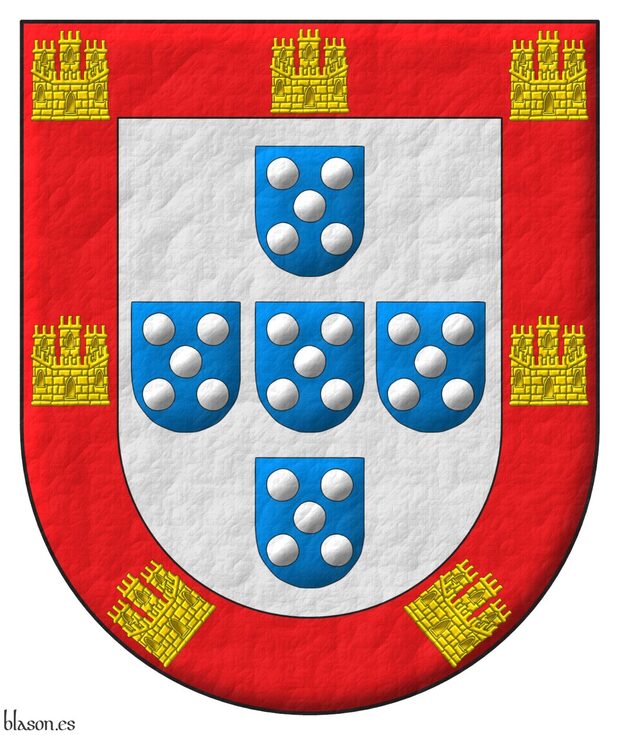
Argent, five escutcheons in cross Azure, each charged with five plates in saltire Argent; a bordure Gules, charged with seven castles triple-towered Or, 3, 2, and 2
Escudo de plata, cinco escudetes en cruz de azur, cada uno cargado de cinco bezantes en sotuer de plata; una bordura de gules, cargada de siete castillos de oro, tres en jefe, uno en cada flanco y dos en punta
Illuminated and a leather finishing.
This coat of arms can be seen in [Avilés, T. de; XVI; página 16], [Bergshammars; 1440; page 4], [Lutzelbourg, N. de; 1530; page 37], and in [Gourdon de Genouillac, H.; 1889; page 247].
Blazon keywords: Without divisions, Argent, Five, Escutcheon, In cross, Azure, Charged, Bezant and plate, Plate, In saltire, Bordure, Gules, Seven, Castle, Or, Three, In chief, One, In each flank and In base.
Style keywords: Leather, Outlined in sable, Illuminated and Semi-circular.
Classification: Civic, Interpreted and Kingdom of Portugal.
Bearer: Portugal.


Poumola, lineage of Catalonia
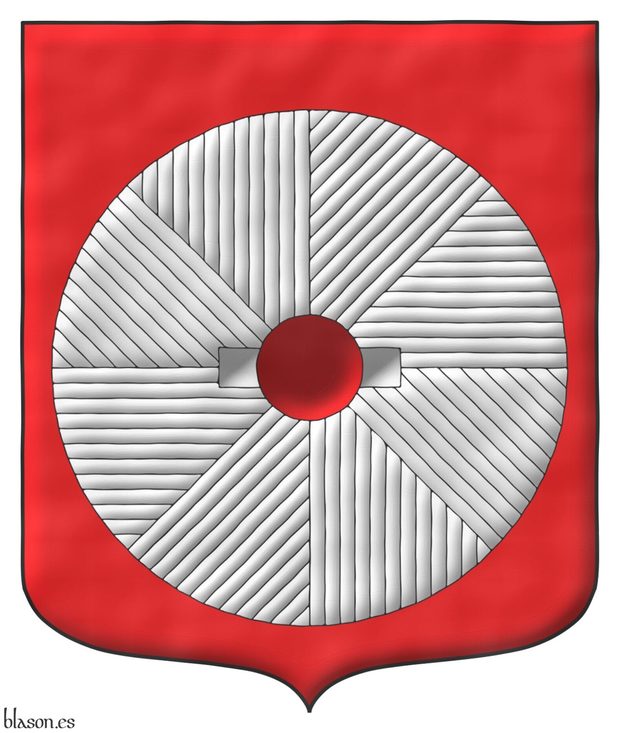
Blazon of the Poumola lineage of Catalonia.
Gules, a millstone Argent.
Escudo de gules, una piedra de molino de plata.
Illuminated and a watercolor finishing with shadow in the hole.
It blazon is describe in [Cadenas y Vicent, V. de; 1987; page 1429], [García Carraffa, A.; García Carraffa, A.; 1968; volume 3, page 358], and [Ferrer i Vives, F.; 1995; volume 2, page 362].
In this case, my theory is that this coat of arms is an example of «canting arms». «Canting arms» use a word or words of the surname or inside the surname to make the coat of arms. The surname Poumola is from Catalonia, we can split the surname into 2 parts «pou-mola», in Catalonian language a) «pou» means «well» and b) «mola» means «millstone» ~ «cadascuna de les dues pedres de forma circular que componen el molí», [GDLC; 1998], and this could be the reason of the symbolism of this coat of arms. «Canting» in heraldry means «talking» or «chatting», in Spanish «canting arms» is translated as «armas parlantes». Some heralds call «canting» to this creative technic.
Blazon keywords: Without divisions, Gules, One, Millstone and Argent.
Style keywords: Watercolor, Outlined in sable, Illuminated and Ogee.
Classification: Interpreted, Lineage and Canting.


Province of Cáceres with Cross of Alcántara

Party per pale: 1 Gules, a castle triple towered Or, port and windows Azure, masoned Sable; 2 Argent, a lion rampant Purpure, armed and langued Gules, crowned Or. Crest: An open royal crown. Behind the shield a cross of Alcantara.
Escudo partido: 1o de gules, un castillo de oro, aclarado de azur, mazonado de sable; 2o de plata, un león rampante de púrpura, armado y lampasado de gules, coronado de oro. Timbrado de una corona real abierta. Acolada detrás del escudo una cruz de Alcántara.
Civic coat of arms interpreted by me as follows: the shield of arms has a semicircular (round) base; the quarters are enameled and illuminated in the tinctures Argent and Gules; the castle, the lion, the Cross of Alcántara and the crown are illuminated; the lion and its crown are outlined in the colour of the field; the open royal crown, the Cross of Alcántara and the castle are outlined in Sable; the Cross of Alcántara is fimbriated Or; and the whole has a watercolor finish.
In [Medél, R.; 1846; plate 35, illustration 5] one can see his interpretation of the Cross of Alcántara.
Blazon keywords: Argent, Purpure, Gules, Or, Azure, Party per pale, Castle, Lion, Port and windows, Masoned, Rampant, Armed, Langued, Crowned, Crest and mantling, Crown, Open royal crown, Behind the shield, Cross, Cross of Alcantara and Cross couped.
Style keywords: Semi-circular, Illuminated and Watercolor.
Classification: Interpreted, Civic and Coat of arms.
Bearer: Cáceres, Province of.


Qasqante of Navarre

Of the twelve lineages of Noblemen, the tenth is that of Qasqante; they bear as arms a shield Or and, on the shield, an eagle Sable, which is black, as it is now painted.
Or, an Eagle displayed Sable.
Escudo de oro, un águila de sable.
Coat of arms interpreted with: a semicircular (round) base; the field in flat Or; the eagle outlined in the colour of the field and illuminated in Sable; and finished in highly-hammered metal.
Based on the tenth coat of arms of the Navarrese «ricoshombres» from [Bosque, J. del; 1540; folio 1 of the numbering of 1613] and the text is from the transcription made by [Martinena Ruiz, J. J.; 1982; pages 122 and 123].
Under the title «Surname of Cascante» it can also be consulted in [Vega, P. J. de; 1702; folio 10 of the manuscript].
Blazon keywords: Without divisions, Or, Eagle and Sable.
Style keywords: Semi-circular, Illuminated, Outlined in the field tincture and Hard metal.
Classification: Interpreted, Personal and Kingdom of Navarre.
Bearer: Qasqante of Navarre.


Quartered arms of Gilbert Hérail
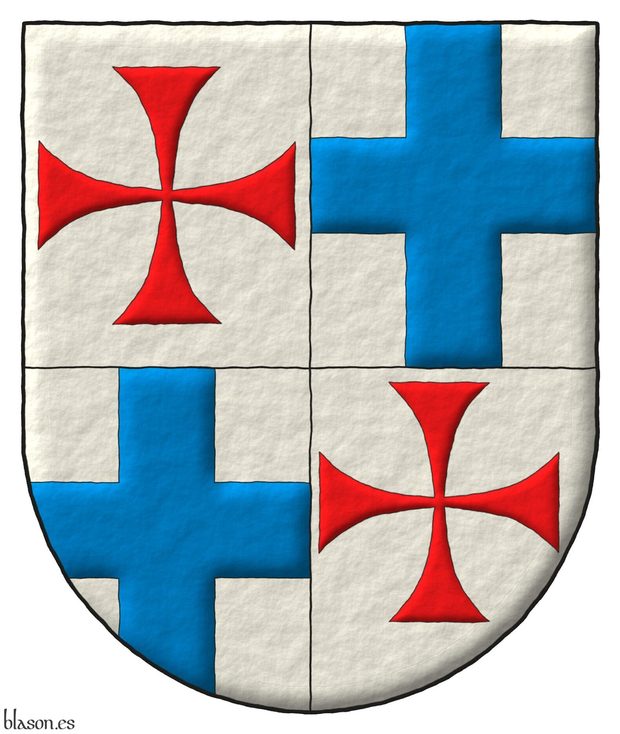
Quarterly: 1 and 4 Argent, a cross patty Gules; 2 and 3 Argent, a cross Azure
Escudo cuartelado: 1o y 4o de plata, una cruz patada de gules; 2o y 3o de plata, una cruz de azur.
Blazon keywords: Argent, One, Cross, Azure, Quarterly, Cross patty, Cross couped and Gules.
Style keywords: Outlined in sable, Illuminated, Semi-circular and Freehand.
Classification: Religious, Military, Knights Templar, Interpreted and Coat of arms.
Bearer: Hérail, Gilbert.


Quartered arms of Jacques de Molay

Quarterly: 1 and 4 Argent, a cross patty Gules; 2 and 3 Azure, a bend Or
Escudo cuartelado: 1o y 4o de plata, una cruz patada de gules; 2o y 3o de azur, una banda de oro.
Blazon keywords: Azure, One, Bend, Or, Quarterly, Argent, Cross patty, Cross couped and Gules.
Style keywords: Outlined in sable, Illuminated, Semi-circular and Freehand.
Classification: Religious, Military, Knights Templar, Interpreted and Coat of arms.
Bearer: Molay, Jacques de.


Rada of Navarre

Of the twelve lineages of Noblemen, the eighth is that of Rada; they bear as arms a shield Or with a flory cross Vert, in the same manner as painted in this shield.
Or, a Cross flory Sinople.
Escudo de oro, una cruz flordelisada de sinople.
Coat of arms interpreted with: a semicircular (round) base; the field in flat Or; the flory cross outlined in Sable and illuminated in Vert enamel; and finished in highly-hammered metal.
Based on the eighth coat of arms of the Navarrese «ricoshombres» from [Bosque, J. del; 1540; folio 1 of the numbering of 1613] and the text is from the transcription made by [Martinena Ruiz, J. J.; 1982; pages 122 and 123].
Under the title «Surname of Rada» it can also be consulted in [Vega, P. J. de; 1702; folio 8 of the manuscript].
Blazon keywords: Without divisions, Or, Cross flory, Cross couped and Vert.
Style keywords: Semi-circular, Illuminated, Outlined in sable and Hard metal.
Classification: Interpreted, Personal and Kingdom of Navarre.
Bearer: Rada of Navarre.


Rage from Discord, first version
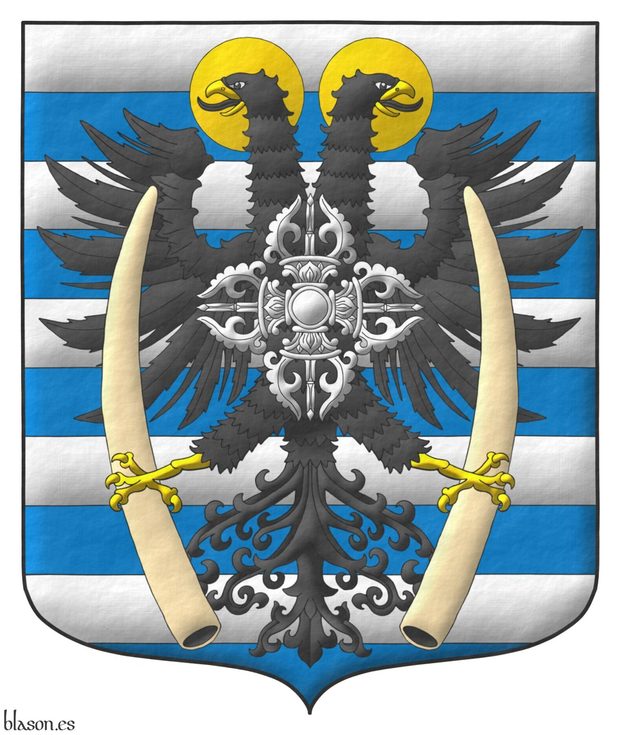
Barry of ten Argent and Azure, overall a double-headed eagle displayed Sable, nimbed, beaked, and membered Or, grasping in each claw an elephant's tusk proper, and charged on its breast with a double vajra Argent.
Escudo fajado de diez piezas de plata y azur, brochante sobre el todo un águila bicéfala de Sable, nimbada, picada y membrada de oro, teniendo en cada garra un colmillo de elefante al natural y su pecho cargado de una vajra doble.
Coat of arms interpreted and emblazoned by me with different shapes and finishings.

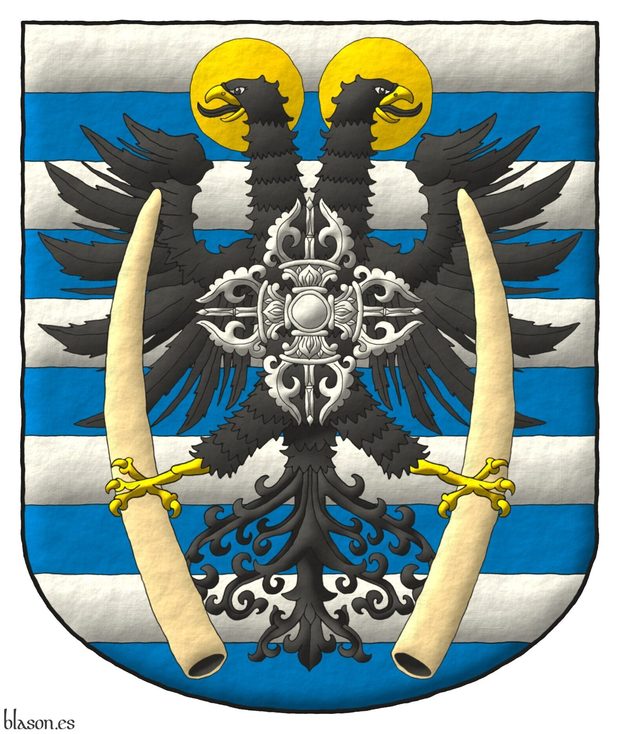
Blazon keywords: Without divisions, Barry, Ten, Argent, Azure, Overall, One, Eagle, Double-headed, Sable, Nimbed, Beaked, Membered, Or, Grasping, Claw, Tusk, Elephant, Proper, Chest, Charged and Double vajra.
Style keywords: Outlined in sable, Illuminated, Freehand, Rough, Rounded, Ogee and Pointed.
Classification: Interpreted and Coat of arms.
Bearer: Rage from Discord.


Ramon Berenguer IV, Count of Barcelona

Or, four pallets Gules.
Escudo de oro, cuatro palos de gules.
Coat of arms of the Count of Barcelona interpreted by me with the following features: the escutcheon shape is semicircular; the field is rendered in flat Or; the pallets are illuminated; and the whole has been given a heavily beaten metal finish.
[Menéndez Pidal de Navascués, F.; 1988; page 537] tells us that, unlike other more territorial emblems, «from his earliest seal the pallets appear on the shield of the equestrian figures on both sides, and in line with this configuration the emblem is inherited, without distinction, by his three sons and all his grandsons... it seems one must conclude that the emblem had a familial, not territorial, character from the very beginning».
Blazon keywords: Without divisions, Or, Four, Pale and Gules.
Style keywords: Semi-circular, Illuminated and Hard metal.
Classification: Interpreted, Personal, Coat of arms and County of Barcelona.
Bearer: Ramon Berenguer IV, Count of Barcelona.


Rex Lancefield
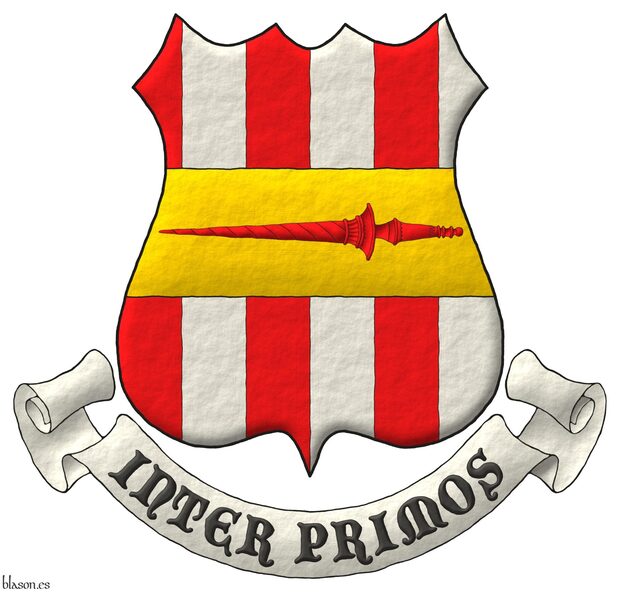
Paly of six Gules and Argent; overall, a fess Or charged with a lance Gules. Motto: «Inter Primos».
Escudo palado de seis piezas de gules y plata; brochante sobre el todo, una faja de oro cargada de una lanza de gules. Lema: «Inter Primos».
Arms interpreted by me, illuminated with lights and shadows, outlined in Sable, with a chasuble outer contour and with a freehand finish.
Canting arms of Rex Lancefield emblazoned by me under the directions of his descendant Erik Paul Arnelien. I usually employ the English term «spear», but as this is a case of canting arms for Rex Lancefield, I have written the blazon in English using the term «lance» instead of «spear», since «Lancefield» begins with «lance».
Blazon keywords: Gules, Argent, Or, Six, One, Paly, Overall, Fess, Charged, Spear and Motto.
Style keywords: Outlined in sable, Illuminated, Chasuble and Freehand.
Classification: Personal, Interpreted, Boa and Coat of arms.
Bearer: Lancefield, Rex.


Reynaldo Romero, plain tincture
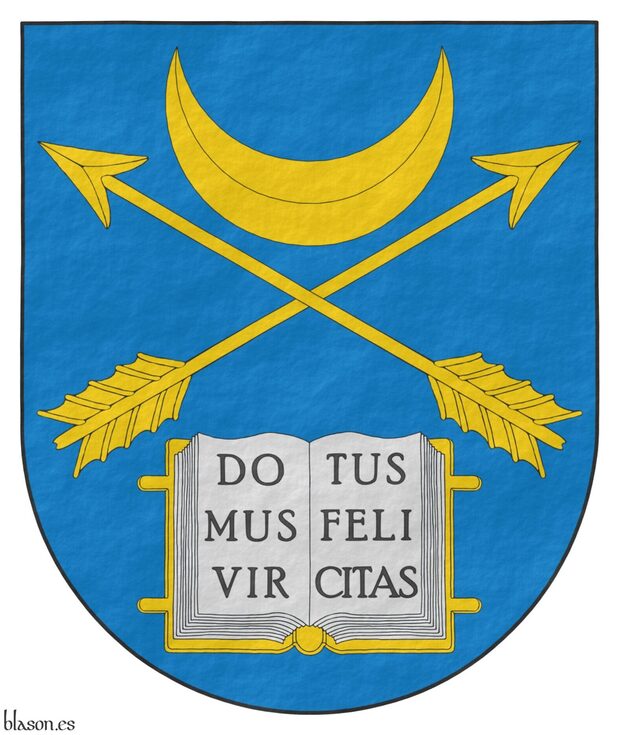
Azure, two arrows points upwards in saltire between, in chief a crescent Or, in base an open book Argent, garnished Or, the pages inscribed «Domus Virtus Felicitas» Sable.
Coat of arms painted by me, in flat tinctures, outlined in Sable, and with a texturized finishing.
The coat of arms of Reynaldo Romero emblazoned by me.
Blazon keywords: Azure, Or, Argent, Sable, One, Two, Arrow, Point upwards, In saltire, Between, In chief, Crescent, In base, Open book, Book, Page and Inscribed.
Style keywords: Outlined in sable and Plain tincture.
Classification: Personal, Interpreted, Boa and Coat of arms.
Bearer: Romero, Reynaldo.


Ricardo de Mandeville, shadows of 5 + 5

Azure fretty Or.
Escudo de azur fretado de oro.
Blazon keywords: Without divisions, Azure, Fretty and Or.
Style keywords: Semi-circular, Illuminated, Outlined in sable, Shaded, Freehand and Hard metal.
Classification: Interpreted and Personal.
Bearer: Ricardo de Mandeville.


Richard Allen Stowe, structured and parallel blazons
Iridescent finishing.
This is an example of my approach to writing structured and parallel blazons in English and Castilian. I use the heraldic term «leopard», instead «lion guardant», because I seek the maximum parallelism between English and Castilian, and in Castilian we also use the heraldic term «leopard».
Blazon keywords: Vert, One, Pall, Raguly, Or, Three, Head, Leopard, Crest and mantling, Wreath, Above, Crown, Between, Two, Wing, Sable and Motto.
Style keywords: Illuminated, Iridescent (nacar), Pointed and Outlined in sable.
Classification: Structured and parallel blazons, Coat of arms, Interpreted and Personal.
Bearer: Stowe, Richard Allen.


Richard de Bures
Or, six annulets Gules, 3, 2, and 1. Behind the shield an eight-pointed cross patty Gules.
The eight-pointed cross patty behind the shield has been diapered with Chinapieria.
Blazon keywords: Or, Six, Annulet, Gules, Ordered, Three, Two, One, Behind the shield, Eight-pointed cross and Cross couped.
Style keywords: Outlined in sable, Semi-circular, Illuminated, Freehand, Diapered and Chinapieria.
Classification: Religious, Military, Knights Templar, Interpreted and Coat of arms.
Bearer: Richard, Richard.


Richard I of England

Lionheart ~ Corazón de León ~ Cœur de Lion.
Escudo de gules, dos leones de oro, afrontados, armados y lampasados de azur.
Coat of arms interpreted as follows: the mouth drawn as a semicircular (round) base; the field enamelled in a flat tint of Gules; the two lions outlined in the colour of the field and illuminated in Or and Azure; and the whole finished with a watercolour effect.
He was born in 1157, being the third of eight children of Henry II of England and Eleanor of Aquitaine, elder brother of Eleanor Plantagenet. He was king of England between 1189 and 1199, although he spent much of his life far from it; in fact, during his ten-year reign, he was on English soil only twice, which together did not amount even to six months. He died in 1199 in Normandy.
In 1198, during the Battle of Gisors, he supposedly used, as watchword or as motto, the expression «Dieu et mon Droit ~ God and my right». This phrase refers to his refusal to bow before Emperor Henry VI, since by his rank Richard acknowledged only God as superior. Later, Henry V of England adopted it as his motto, and since then it has been used by the British monarchy.
According to [Humphery-Smith, C.; 1983], Richard the Lionheart was the first English king who can be proved to have borne arms, although some of his predecessors may also have had them. He bases his statement on the existence of two seals of Richard I: on one, Richard bears a shield with a rampant lion, and on the other there already appear the three lions that are the forerunners of the arms of England. The use of this second seal does not imply that he stopped using the first.
In contrast, there are also British authors who maintain that his shield actually bore two affronted lions; this hypothesis is based on the lion on his first seal facing to sinister. That latter hypothesis is the one interpreted in this shield, remaining a purely artistic interpretation and without my entering into a complex and open discussion about how, when, and why the three leopards, «leones pasantes ~ lions passant» for the English, appeared —a discussion in which there are various alternatives— ranging from the combination of his hereditary arms to the wish to have more lions than his younger brother, who would later be King John I of England, to possible influences from other European realms.
This version of Richard I’s shield is similar to the imaginary shield of Hector of Troy, Gules with two lions Or affronté, which is a term used when «two things are placed facing each other, like two Lions, two Dogs, or other animals that look at one another» [Avilés, J.; 1725a; page 32].
Blazon keywords: Without divisions, Gules, Lion, Or, Combatant, Armed, Langued and Azure.
Style keywords: Semi-circular, Illuminated, Outlined in sable and Freehand.
Classification: Interpreted, Personal, Coat of arms, House of Plantagenet and Kingdom of England.
Bearer: Richard I of England.


Rivas of Aragon, lineage

Argent, on a cross Gules five fleurs de lis Or.
Escudo de oro, una cruz de gules cargada de cinco flores de lis de oro.
Arms depicted by me, illuminated with lights and shadows, contoured in Sable, with a semi-circular outer contour and with a freehand finish.
Ancient arms of the lineage Rivas of Aragon emblazoned by me. Alternative blazon: «Argent, a cross Gules charged with five fleurs de lis Or».
Blazon keywords: Argent, Gules, Or, One, Five, Cross, Charged and Fleur de lis.
Style keywords: Outlined in sable, Illuminated, Semi-circular and Freehand.
Classification: Personal, Lineage, Interpreted, Boa and Coat of arms.
Bearer: Rivas of Aragon, lineage.


Robert de Malet
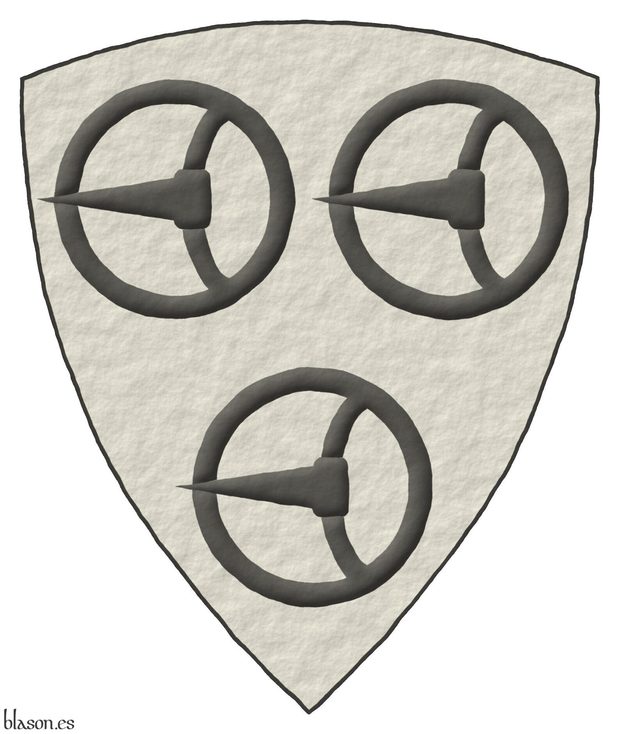
Roberto de Malet ~ Robert de Malet
Argent, three buckles Sable.
Escudo de plata, tres hebillas de sable.
Included in [Vincent, MS; 1285; number 595] also known as [St. George's Roll; 1285; number 595].
Blazon keywords: Without divisions, Argent, Three, Buckle, Sable and Ordered.
Style keywords: Triangular curved, Illuminated and Freehand.
Classification: Interpreted and Personal.
Bearer: Roberto de Malet.


Robert George Alexander Balchin
Quarterly: 1 and 4 Vert, a crescent within eight mullets in lozenge Or; 2 and 3 Azure, a chain fesswise throughout between three fleurs de lis, 2 and 1, all the links and fleurs de lis per pale Or and Argent; an inescutcheon Azure, bearing a crown of count, charged with an eagle displayed within a bordure Or. Crest: A crown of Baron. Behind the shield the cross of a Knight of Justice of the Most Venerable Order of the Hospital of Saint John of Jerusalem.
Coat of arms emblazoned by me with a pointed shape, illuminated, and with a watercolor finishing.
G0067, Chief Herald of Malta's grant of Robert George Alexander Balchin's arms, whose full achievement has been emblazoned by me for such grant.
Blazon keywords: Quarterly, Vert, One, Crescent, Eight, Mullet, In lozenge, Or, Azure, Chain, Fesswise, Throughout, Between, Three, Fleur de lis, Ordered, Party per pale, Argent, Inescutcheon, Crest and mantling, Crown of Count, Crown, Charged, Eagle, Bordure, Crown of Baron, Behind the shield and Cross.
Style keywords: Outlined in sable, Illuminated, Watercolor and Pointed.
Classification: Personal, Interpreted, Coat of arms and Doctor.
Bearer: Balchin, Robert George Alexander.


Robertson of Struan, lineage
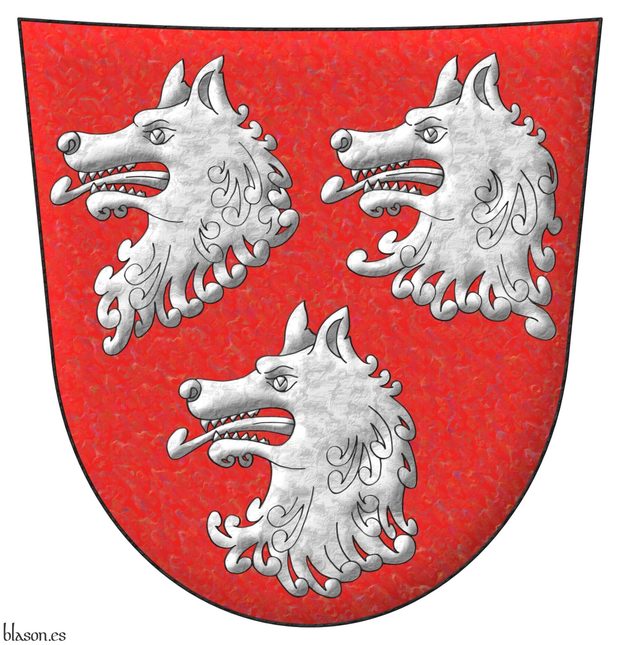
Gules, three wolves' heads erased Argent.
Escudo de gules, tres cabezas de lobo arrancadas de plata.
Arms interpreted by me, illuminated with lights and shadows, outlined in Sable, with a rounded trapezoidal outer contour and with a metal and iridescent finish.
Blazon keywords: Gules, Argent, Three, Wolf, Head and Erased.
Style keywords: Outlined in sable, Illuminated, Rounded trapezoid and Metal and iridescent.
Classification: Personal, Kingdom of Scotland, Lineage, Interpreted, Boa and Coat of arms.
Bearer: Robertson of Struan, lineage.


Rodelo lineage from Galicia
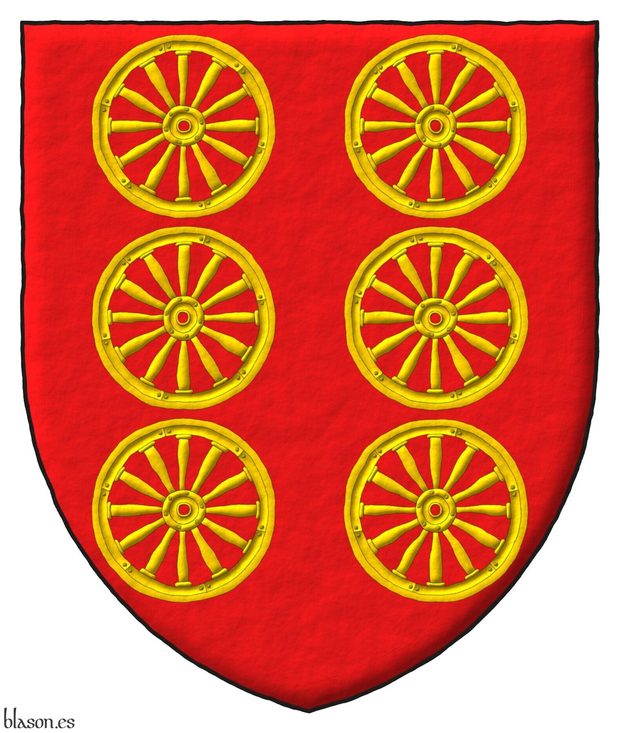
Gules, six wagon-wheels Or, 2, 2, and 2.
Escudo de gules, seis ruedas de carro de oro, 3 y 3.
Coat of arms emblazoned by me with a pointed ended shape, illuminated, and with a freehand finishing.
Another alternative way of writing this same blazon is the following: «Gules, six wagon-wheels Or, arranged in two pallets».
Blazon keywords: Gules, Six, Wagon-wheel and Or.
Style keywords: Outlined in sable, Illuminated, Freehand and Pointed.
Classification: Lineage, Interpreted, Canting and Coat of arms.
Bearer: Rodelo lineage from Galicia.


Roger de Lauria

The 2nd Battalion of the Parachute Brigade of the Spanish Army bears its name and its coat of arms.
Argent, three bendlets sinister Azure.
Escudo de plata, tres barras de azur.
For the interpretation of this coat of arms, I have used: a rounded mouth; the angle I use most often, for example in bends, bendlets, bends sinister, or bendlets sinister, which is 50.2o, resulting from calculating the arctangent of 6/5, that is, the opposite side 6 divided by the adjacent side 5; with a division of the main diagonal into 7 equal parts, resulting from crossing this diagonal with the 6 lines that will form the edges of the 3 bend sinisters; and for the whole, a finish of lightly hammered metal.
Blazon keywords: Without divisions, Argent, Azure and Bend sinister.
Style keywords: Rounded, Illuminated, Outlined in sable and Soft metal.
Classification: Interpreted, Personal and Army and Navy.
Bearer: Lauria, Roger de.


Romanet, Catherine de
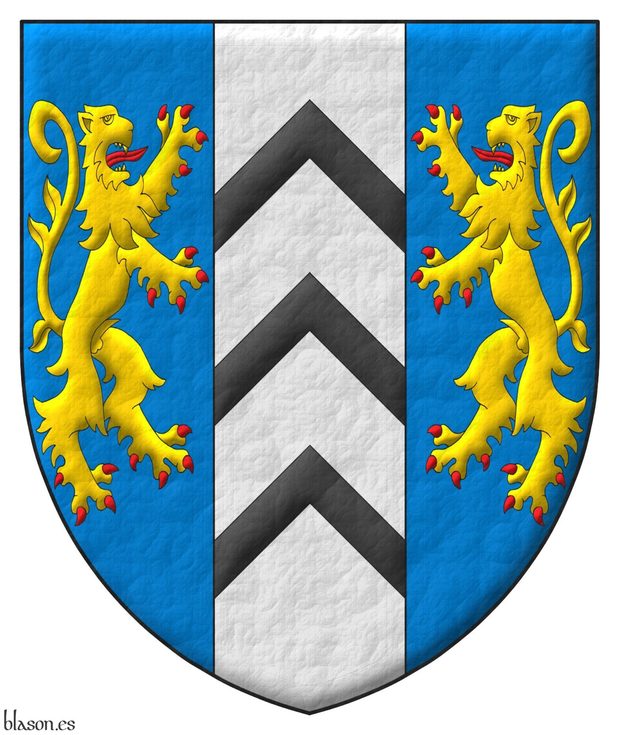
Azure, on a pale Argent, between two lions combatant Or, armed and langued Gules, three chevronels Sable.
Escudo de azur, un palo de plata, cargado de tres tenazas de sable, acostado de dos leones afrontados de oro, armados y lampasados de gules.
Arms depicted by me, illuminated with lights and shadows, contoured in Sable, with a pointed outer contour and with a leather finishing.
The coat of arms of Catherine de Romanet emblazoned by me. Blazon in French: «D'azur, au pal d'argent chargé de trois chevrons de sable et accosté de deux lions affrontés d'or, armés et lampassés de gueules». Alternative blazon: «Azure, a pale Argent, charged with three chevronels Sable, between two lions combatant Or, armed and langued Gules».
Blazon keywords: Azure, Argent, Sable, Or, Gules, One, Three, Two, Pale, Charged, Chevronel, Between, Lion, Combatant, Armed and Langued.
Style keywords: Outlined in sable, Illuminated, Pointed and Leather.
Classification: Personal, Interpreted, Boa and Coat of arms.
Bearer: Romanet, Catherine de.


Royal Association of Hidalgos of Spain, emblem
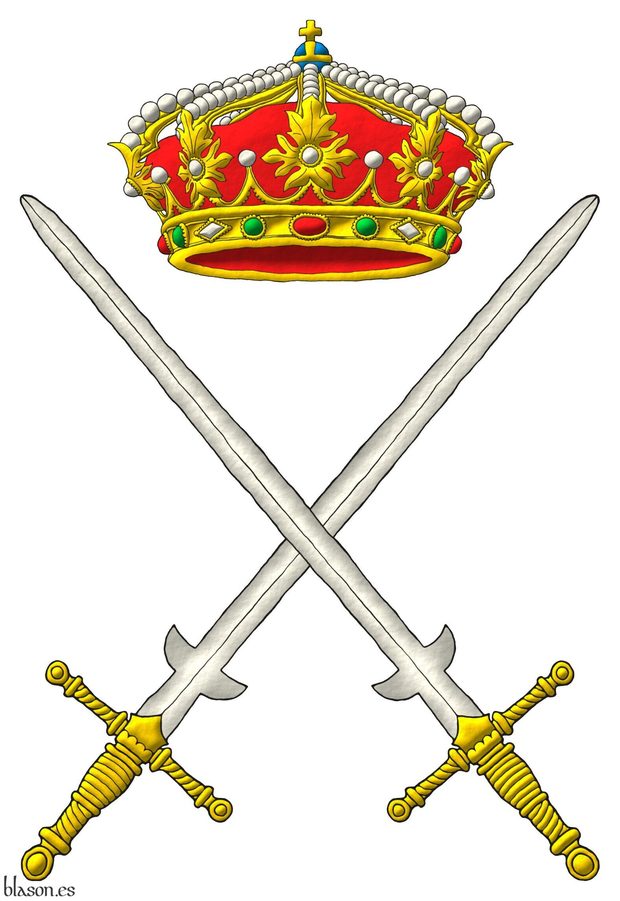
Emblem, two two-handed swords in saltire Argent, hilted Or. Crest: A royal crown Or.
Emblema, dos mandobles en sotuer de plata, guarnecidos de oro. Timbrado de una corona real.
Emblem interpretation with: the two-handed swords placed along the diagonals of an imaginary rectangle, with a 5x6 proportion, like a shield, that is, with angles of 50.2°, between the axis of the two-handed swords and the imaginary base of the emblem, unlike the original emblem where the two-handed swords are on the diagonals of a square, therefore with angles of 45°; the two-handed swords and the closed royal crown are outlined in Sable, illuminated and the whole with a raised-stroke execution.
This emblem of the Royal Association of Hidalgos of Spain has 2 two-handed swords that, unlike usual swords, due to their great length and weight, their fencing must be two-handed, hence their name.
The Spanish word «mandoble» comes from «mano doble», meaning «double hand», and refers to a sword wielded with both hands, the equivalent of the English «two-handed sword».
It is known that they are two-handed swords because the 2 that appear in the emblem have a crescent or crossguard in their iron. This crescent is called in Castilian «falsaguarda» and also «ganchos de parada» and its functionality is to protect from the slashes that the opponent could give close to the blade of the two-handed sword.
Blazon keywords: Two-handed sword, Argent, Hilted, Or, In saltire, Crest, Closed royal crown and Crown.
Style keywords: Illuminated, Outlined in sable and Freehand.
Classification: Interpreted, Socioeconomic and Emblem.
Bearer: Royal Association of Hidalgos of Spain.


![Ver [Royal Council of the Orders of Chivalry] en instituciones citadas. Fortaleza de oro y mazonada de sable.](../css/Fortaleza.Institucion.png)
Royal Council of the Orders of Chivalry
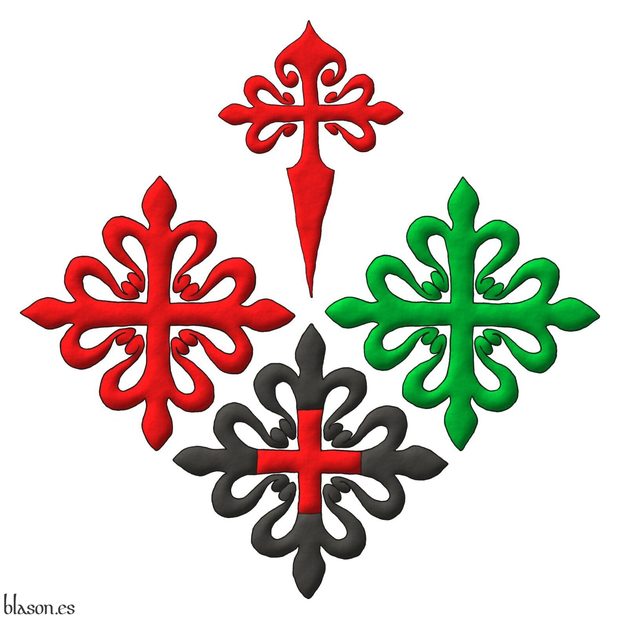
In 1523, the Order of Santiago, the Order of Calatrava, and the Order of Alcantara were definitively incorporated into the Crown of Castile, which marked the consolidation of the Royal Council of the Orders of Chivalry of Santiago, Calatrava, Alcantara, and Montesa. However, it is known that this Royal Council already existed at the beginning of the same 16th century, or even earlier, although there are no foundational documents available to date its inception.
The internet address of its website is ordenesmilitares.es where it also hosts the pages dedicated to each of its four orders:
- Order of Chivalry of Santiago: ordenesmilitares.es/orden-de-santiago.
- Order of Chivalry of Calatrava: ordenesmilitares.es/orden-de-calatrava.
- Order of Chivalry of Alcantara: ordenesmilitares.es/orden-de-alcantara.
- Order of Saint Mary of Montesa and Saint George of Alfama: ordenesmilitares.es/orden-de-montesa.
After the Crusades ended and following the model of the military orders created in the Holy Land, European kings established Orders of Chivalry, many of which were military and religious institutions, like the four grouped under this Royal Council.
Categories: Institution, Interpreted, Socioeconomic, Illuminated, Outlined in sable, Freehand, Emblem, Cross, Quarterly per saltire, Cross of Saint James, Cross couped, Cross of Calatrava, Cross of Alcantara and Cross of Montesa.


Royal Spanish Academy, coat of arms

Argent, a crucible Argent, enflamed and on a bonfire hoguera Gules and Or. Crest: A closed royal crown Or, with eight arches, visible five. Motto: «Limpia, fixa, y da esplendor» Or over a scroll Azure.
Escudo de plata, un crisol de plata, llameante y sumado a una hoguera de gules y oro. Timbrado de una corona real cerrada. Lema: «Limpia, fixa, y da esplendor» de oro sobre una filacteria de azur.
Interpretation made from the Royal Academy emblem: transforming it into a semicircular-based shield, instead of its oval shape; with its motto on a scroll beneath the base, instead of surrounding it; keeping the closed royal crown in its place; with everything illuminated except the field which is in plain color; and the whole outlined in sable and with a parchment-like finish.
In this interpretation, on the Argent field, the Gules fire of the bonfire completely surrounds the Argent crucible, to avoid the metal Argent on the same.
To write the blazon for this coat of arms I use the heraldic term «llameante». Therefore, I do not follow [Avilés, J.; 1780a; page 82 and figure 163] when he writes «...y un Fénix de gules sobre una hoguera encendida de lo mismo.». He uses this example to illustrate the 2 fundamental uses of the term «encendido» which is said when «the Eyes of animals... are of a different color» and «also of a burning Bush and the same for a Torch, when the flame is of a different tincture».
Blazon keywords: Without divisions, Argent, One, Crucible, Enflamed, Bonfire, Gules, Or, Closed royal crown, Crown, Motto, Scroll and Azure.
Style keywords: Semi-circular, Illuminated, Outlined in sable and Parchment.
Classification: Interpreted, Socioeconomic and Coat of arms.
Bearer: Royal Spanish Academy.


Rubén Arjona Berrocal, page of armorial

Ermine papelonny, a lion rampant guardant Gules, armed and langued Azure. Crest: A crown of the Sovereign and Most Noble Order of the Pomegranate. The shield is surrounded by the Grand Collar of the Sovereign and Most Noble Order of the Pomegranate.
This is his coat of arms of emblazoned by me for the Roll of Arms of the Sovereign and Most Noble Order of the Pomegranate.
Blazon keywords: Without divisions, Ermine, Papelonny, One, Lion rampant guardant, Gules, Armed, Langued, Azure, Crest and mantling, Crown, Pomegranate, Surrounded and Grand collar.
Style keywords: Semi-circular, Outlined in sable, Illuminated and Leather.
Classification: Personal, Interpreted, Coat of arms, Armorial roll and Castilian language.
Bearer: Arjona Berrocal, Rubén.


Rubén González Lara, page of armorial
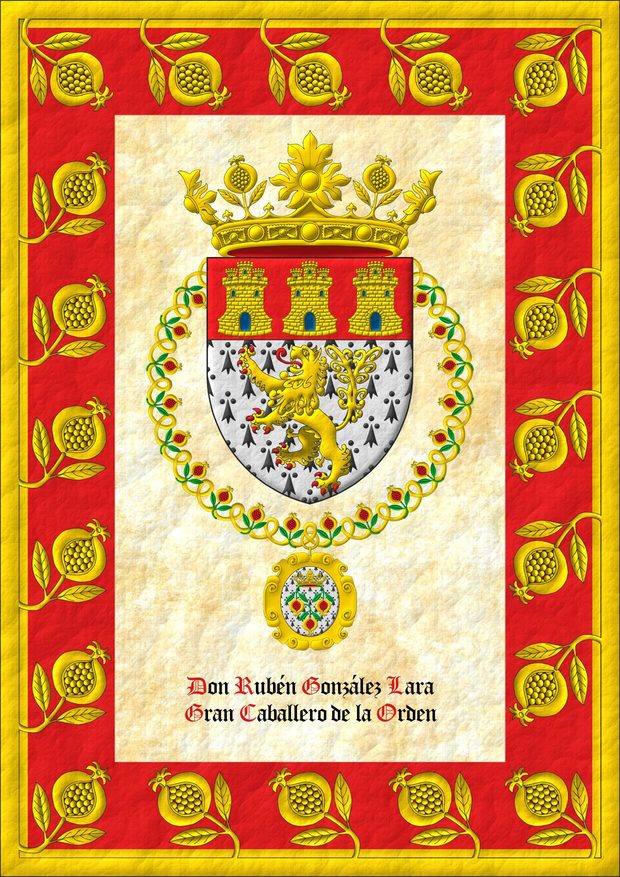
Ermine, a lion rampant double queued Or, armed and langued Gules; a chief Gules, three castles triple-towered Or, port and windows Azure, masoned Sable. Crest: A crown of the Sovereign and Most Noble Order of the Pomegranate. The shield is surrounded by the Grand Collar of the Sovereign and Most Noble Order of the Pomegranate.
This is his coat of arms of emblazoned by me for the Roll of Arms of the Sovereign and Most Noble Order of the Pomegranate.
Blazon keywords: Without divisions, Ermine, One, Lion, Rampant, Tail, Double queued, Or, Armed, Langued, Gules, Chief, Three, Castle, Port and windows, Azure, Masoned, Sable, Crest and mantling, Crown, Pomegranate, Surrounded and Grand collar.
Style keywords: Pointed, Outlined in sable, Illuminated and Leather.
Classification: Personal, Interpreted, Coat of arms, Armorial roll and Castilian language.
Bearer: González Lara, Rubén.


Rudolph Andries Ulrich Juchter van Bergen Quast

Gules, three Leopards faces Or, the whole within a Border Or with two Bars Gules.
Watercolor finishing
Blazon keywords: Gules, Three, Head, Leopard, Or, Ordered, Bordure, Two and Bar.
Style keywords: Watercolor, Pointed, Illuminated and Outlined in sable.
Classification: Coat of arms, Interpreted and Personal.
Bearer: Juchter van Bergen Quast, Rudolph Andries Ulrich.


Sancho IV of Castile
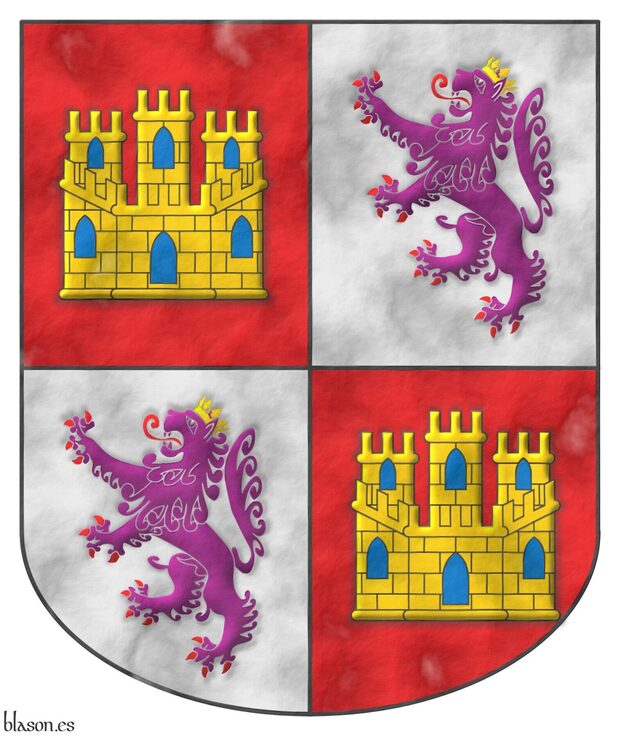
Known as the Brave, king of Castile and León from 1284 to 1295.
Quarterly: 1 and 4 Gules, a castle triple towered Or, port and windows Azure, masoned Sable; 2 and 3 Argent, a lion rampant Purpure, armed and langued Gules, crowned Or.
Escudo cuartelado: 1o y 4o de gules, un castillo de oro, aclarado de azur, mazonado de sable; 2o y 3o de plata, un león rampante de púrpura, armado y lampasado de gules, coronado de oro.
Pre-existing arms interpreted by me as described below: the shield of arms has a rounded (semicircular) base; the field, the two castles and the two lions are illuminated; and the whole has a parchment-like finish.
Blazon keywords: Quarterly, Gules, Or, Azure, Sable, One, Castle, Port and windows, Masoned, Argent, Purpure, Lion, Rampant, Armed, Langued and Crowned.
Style keywords: Rounded, Illuminated and Parchment.
Classification: Interpreted, Personal, Coat of arms and Kingdom of Castile and Leon.
Bearer: Sancho IV of Castile.


Sancho of Castile, Infante
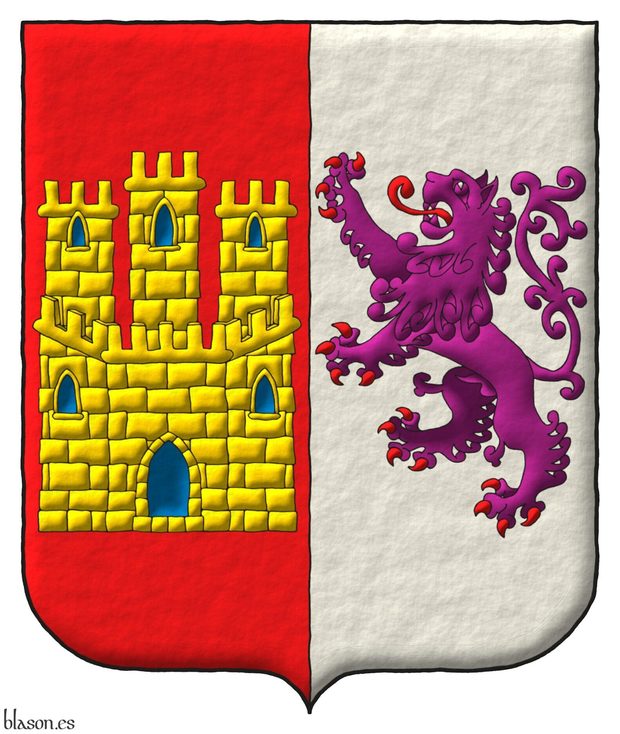
Party per pale: 1 Gules, a castle triple-towered Or, port and windows Azure, and masoned Sable; 2 Argent, a lion rampant Purpure, armed and langued Gules.
Escudo partido: 1o de gules, un castillo de oro, aclarado de azur, mazonado de sable; 2o de plata, un león rampante de púrpura, armado y lampasado de gules.
Arms emblazoned by me, highlighted with lights and shadows, contoured in Sable, with an ogee outer contour and with a freehand finish.
Coat of arms of the Infante Sancho of Castile, 1233–1261, 8th offspring of the King Ferdinand III of Castile, 1199-1252, and the Queen Beatrice of Swabia, 1205–1235. Unlike his siblings, he does not use a quarterly shield but rather impaled arms of Castile and Leon.
Blazon keywords: Gules, Or, Azure, Sable, Argent, Purpure, One, Party per pale, Castle, Triple-towered, Port and windows, Masoned, Lion, Rampant, Armed and Langued.
Style keywords: Outlined in sable, Illuminated, Ogee and Freehand.
Classification: Personal, Kingdom of Castile and Leon, Interpreted, Boa and Coat of arms.
Bearer: Sancho of Castile, Infante.


Savoy, Duchy of
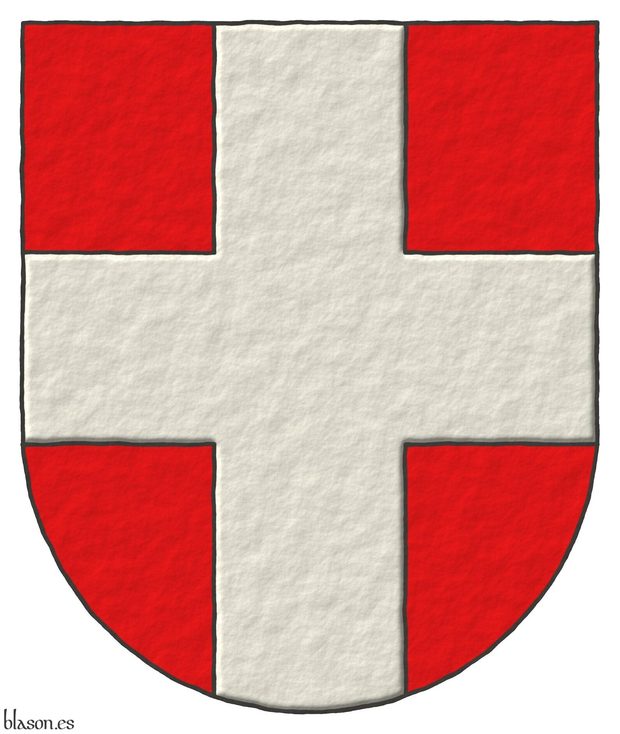
Gules, a cross Argent.
Escudo de gules, una cruz de plata.
Coat of arms of the House of Savoy and the Duchy of Savoy, which I have interpreted as follows: the shield has a semicircular (round) base; the field is illuminated in flat tincture Gules; the cross is illuminated in Argent; and the whole coat of arms is rendered with a raised-stroke effect.
This coat of arms is both familial and political, for it is also the coat of arms of the French departments of Savoy and Haute-Savoie, both belonging to the Rhône-Alpes region.
The cross in this shield is an honourable ordinary, for it is a full cross, the result of combining a fess and a pale. This full cross is wide and reaches the edges of the shield and is therefore large enough to bear charges. For this reason these ordinaries are called “honourable,” because they may be honoured with additional charges. In English heraldry they are known as «ordinaries», [The Heraldry Society; 2013; page 11].
This coat of arms is recorded in the armorial [Marshal, L.; 1295; shield number 32] together with the text «Le Counte de Sauveys, Gules a cross argent, Amadeus V, Comte de Savoie».
Blazon keywords: Without divisions, Gules, Argent and Cross.
Style keywords: Semi-circular, Illuminated and Freehand.
Classification: Interpreted, Personal, Coat of arms and House of Savoy.
Bearer: Savoy, Duchy of.


Scotland

Or, a lion rampant Gules, armed and langued Azure; a double tressure flory counterflory Gules.
Escudo de oro, un león de gules, armado y lampasado de azur; un trechor doble flordelisado y contraflordelisado de gules.
Illuminated and a leather finishing.
The blazon of this coat of arms is usually written with the heraldic term «within». I think it is not necessary because the lion can only be inside the double trechor. Using «within» the blazon is: «Or, a lion rampant Gules, armed and langued Azure, within a double tressure flory counterflory Gules».
Blazon keywords: Or, One, Lion, Gules, Armed, Langued, Azure, Double tressure, Flory, Counterflory and Whitin.
Style keywords: Freehand, Outlined in sable, Illuminated and Pointed.
Classification: Civic, Kingdom of Scotland, Interpreted and Coat of arms.
Bearer: Scotland.


Second schema for the arms of Gilbert des Essarts
Gules, a chevron Or.
Arms of Gilbert des Essarts, France, emblazoned by me. This scheme illustrates the drawing of a chevron, highlighting that the lower point of this wide chevron is positioned at the geometric center of the coat of arms.
Blazon keywords: Gules, Or, One and Chevron.
Style keywords: Outlined in sable, Plain tincture, Illuminated and Pointed.
Classification: Personal, Kingdom of France, Interpreted, Schema, Boa and Coat of arms.
Bearer: Gilbert des Essarts.


Sendat, Jean-Philippe
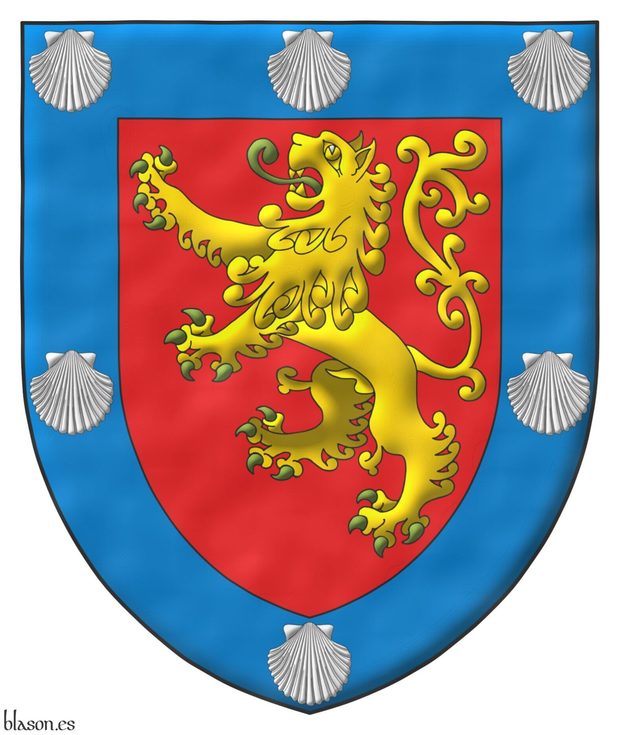
Gules, a lion rampant Or, langued and armed Vert; a bordure Azure charged with six escallops Argent.
Escudo de gules, un león rampante de oro, lampasado y armado de sinople; una bordura de azur cargada de seis veneras de plata.
Arms interpreted by me, illuminated with lights and shadows, contoured in Sable, with a pointed outer contour and with a watercolor finishing.
The coat of arms of the Jean-Philippe Sendat emblazoned by me.
Blazon keywords: Gules, Or, Vert, Azure, Argent, One, Six, Lion, Rampant, Langued, Armed, Bordure, Charged and Escallop.
Style keywords: Outlined in sable, Illuminated, Pointed and Watercolor.
Classification: Personal, Interpreted, Boa and Coat of arms.
Bearer: Sendat, Jean-Philippe.


Silvestri, Maximilian

Argent, a demi-savage issuant from the base Carnation, crined, bearded and vested Tenné, wreathed of leaves Vert, holding in his dexter a close book, bookmarked Gules, garnished, on its cover a mortar with pestle Or, in his sinister an oak club Tenné, leaved and fructed Vert; a chief wavy Gules.
Escudo de plata, un salvaje moviente de la punta de carnación, cabellado, barbelado y vestido de leonado, tortillado de hojas de sinople, teniendo en su diestra un libro cerrado con cintas marcapáginas de gules, adornado de oro, en su cubierta un almirez con mano de oro, y en su siniestra un garrote de roble de leonado, hojado y frutado de sinople; un jefe ondado de gules.
Coat of arms emblazoned by me, illuminated with lights and shadows, outlined in Sable, with a semi-circular external shape and with a watercolor finish.
Design rationale
The wildman represents Silvanus, the Roman god of the countryside, as a canting reference to his surname, Silvestri. The god holds a chemistry book to symbolize the bearer and his PhD in chemistry. The oak club represents the bearer's family, as well as strength, honor, and wisdom.
Blazon keywords: Argent, Or, Gules, One, Demi, Savage, Carnation, Issuant, Base, Crined, Bearded, Vested, Tenné, Wreathed, Leaf, Grasping, Dexter, Closed book, Book, Bookmark, Garnished, Mortar, Pestle, Club, Leaved, Fructed, Chief and Wavy.
Style keywords: Outlined in sable, Illuminated, Semi-circular and Watercolor.
Classification: Personal, Interpreted, Design rationale, Boa and Coat of arms.
Bearer: Silvestri, Maximilian.


Simon de Crombe
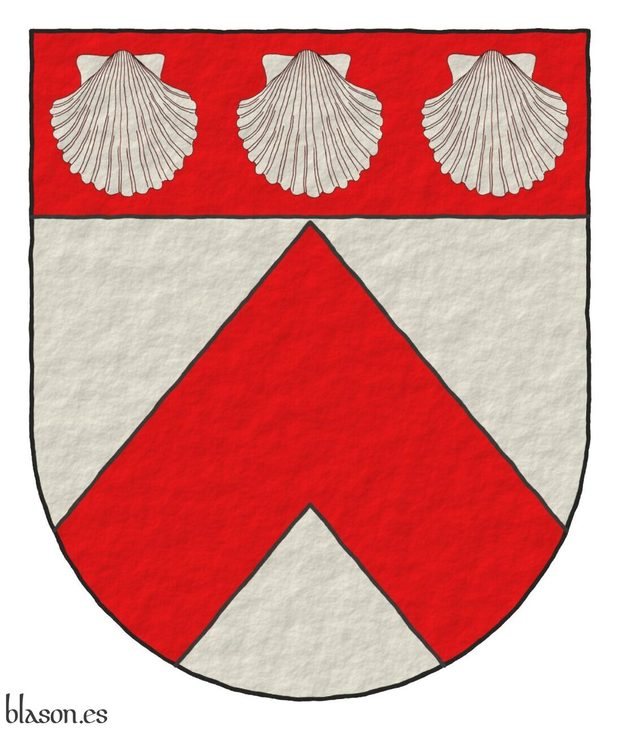
Simon de Croome ~ Simon de Crombe.
Argent, a Chevron Gules, on a Chief Gules, three escallops Argent, in fess.
Escudo de plata: un cabrio de gules; el jefe de azur, tres veneras de plata, en faja.
Included in [Vincent, MS; 1285; number 623] also known as [St. George's Roll; 1285; number 623].
The 3 escallops are in the chief then the description «in fess» are not really needed.
Blazon keywords: Without divisions, Argent, One, Chevron, Gules, Chief, Three, Escallop and In fess.
Style keywords: Semi-circular, Plain tincture, Outlined in sable and Freehand.
Classification: Interpreted and Personal.
Bearer: Simón de Croome.


Simon de Ver
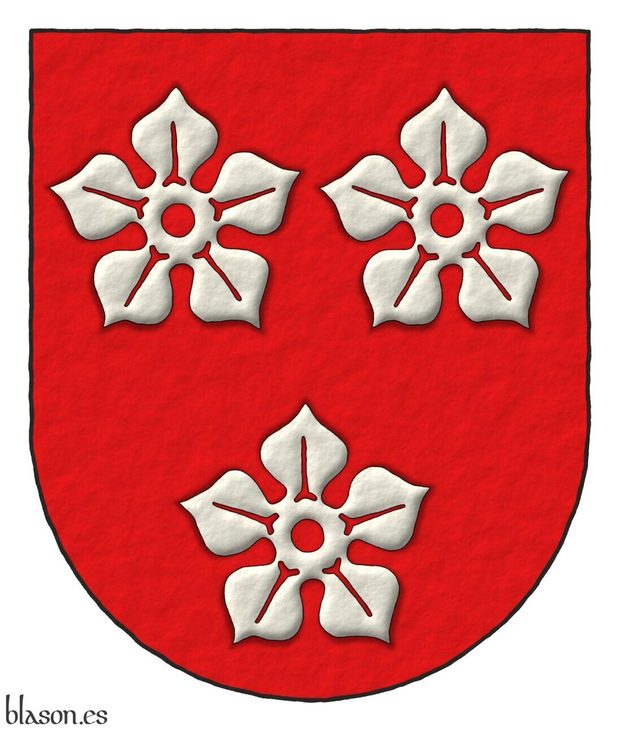
Simon de Vere ~ Simon de Ver.
Gules, three cinquefoils Argent.
Escudo de gules, tres quinquefolios de plata.
Included in [Vincent, MS; 1285; number 85] also known as [St. George's Roll; 1285; number 85].
Blazon keywords: Without divisions, Gules, Three, Cinquefoil, Argent and Ordered.
Style keywords: Semi-circular, Illuminated, Shaded, Outlined in sable and Freehand.
Classification: Interpreted and Personal.
Bearer: Simón de Vere.


Simon le FizSimon
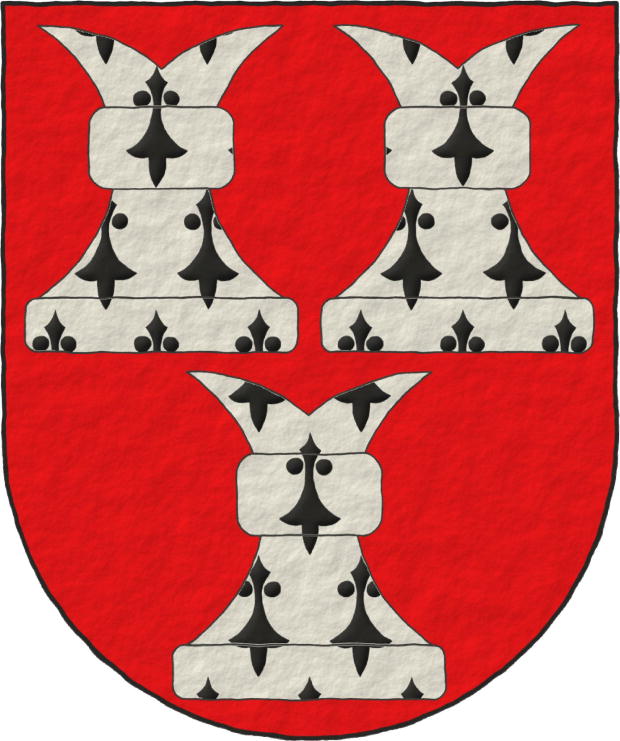
Simon FitzSimon ~ Simon le FizSimon.
Gules, three chess rooks Ermine.
Escudo de gules, tres roques de armiños.
Included in [Vincent, MS; 1285; number 224] also known as [St. George's Roll; 1285; number 224].
Blazon keywords: Without divisions, Gules, Three, Chess rooks, Ermine and Ordered.
Style keywords: Semi-circular, Illuminated and Outlined in sable.
Classification: Interpreted and Personal.
Bearer: Simón FitzSimon.


Sir Robert Knollys (1325-1407), second post
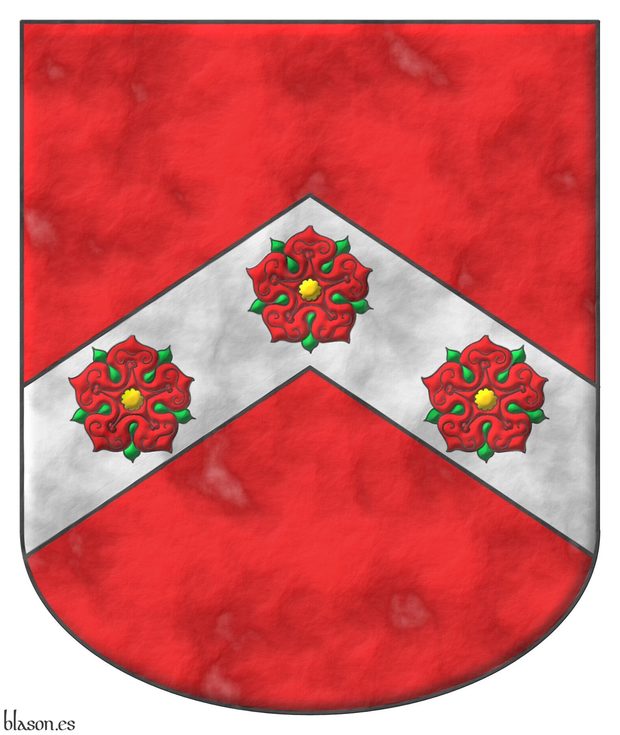
Sir Robert Knollys ~ Sir Robert Knolles (1325-1407).
Gules, on a chevron Argent three roses Gules, barbed Vert and seeded Or.
Escudo de gules, un cabrio de plata cargado de tres rosas de gules, barbadas de sinople y botonadas de oro.
Coat of arms interpreted as follows: the mouth is rounded; the field is illuminated in Gules; the chevron is outlined in Sable and illuminated in Argent metal; the roses outlined in Sable are illuminated the petals in Gules, the leaves in Vert and the central button in Or; and the whole has a parchment finish.
Robert Knolles participated in the Hundred Years' War, on the side of England, and in 1367, he was with Edward of Woodstock, the Black Prince, at the Battle of Nájera.
In the Battle of Nájera, on the way to Navarrete, Pedro I of Castile, with direct English support, and his half-brother Don Enrique de Trastámara, with indirect French support, faced each other. English and French hoped that supporting their side's victory would allow them to have the Castilian fleet on their side, which was more powerful than theirs, in their Hundred Years' War.
Blazon keywords: Without divisions and Gules.
Style keywords: Rounded, Illuminated, Outlined in sable and Parchment.
Classification: Interpreted, Personal, Kingdom of England and Army and Navy.
Bearer: Knollys, Robert.


Sky, Laird
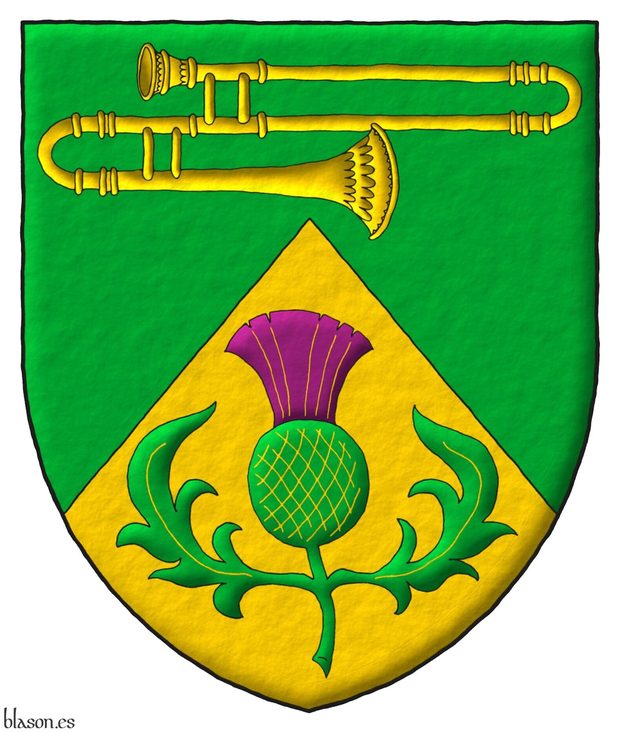
Party per chevron Vert and Or, in chief a sackbut fesswise Or, in base a thistle slipped and leaved proper.
Escudo de sinople, mantelado en punta de oro, en jefe un sacabuche de oro puesto en faja, en punta un cardo de sinople, florido de púrpura.
Illuminated, freehand finishing, and the inner of the thistle is outlined in the metal Or of its field.
Note the different way of writing the blazon in English and Castilian, «...a thistle slipped and leaved proper» ~ «...un cardo de sinople, florido de púrpura».
Blazon keywords: Vert, Party per chevron, Or, In chief, Sackbut, Fesswise, In base, Thistle, Leaved, Slipped and Proper.
Style keywords: Freehand, Outlined in sable, Outlined in the field tincture, Illuminated and Pointed.
Classification: Personal, Interpreted and Coat of arms.
Bearer: Sky, Laird.


![Ver [Society of Heraldic Arts] en instituciones citadas. Fortaleza de oro y mazonada de sable.](../css/Fortaleza.Institucion.png)
Society of Heraldic Arts

Founded in the year 1987, it is the first organisation of its kind in the world
Azure, an inescutcheon Argent, enflamed in orle of sixteen points and irradiated throughout of sixty-four lines Or.
Escudo de azur, un escusón de plata, llameante en orla de Dieciséis llamas y radiante de sesenta y cuatro líneas movientes todas de oro.
First versions
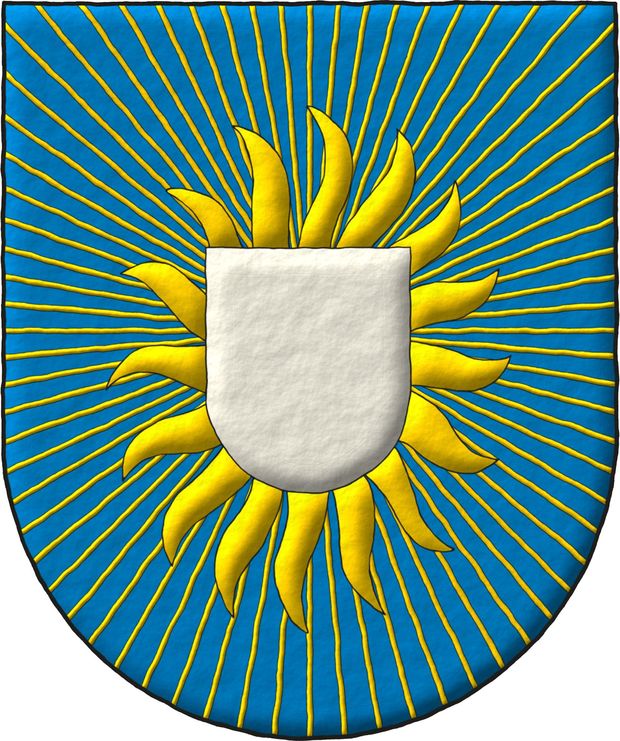
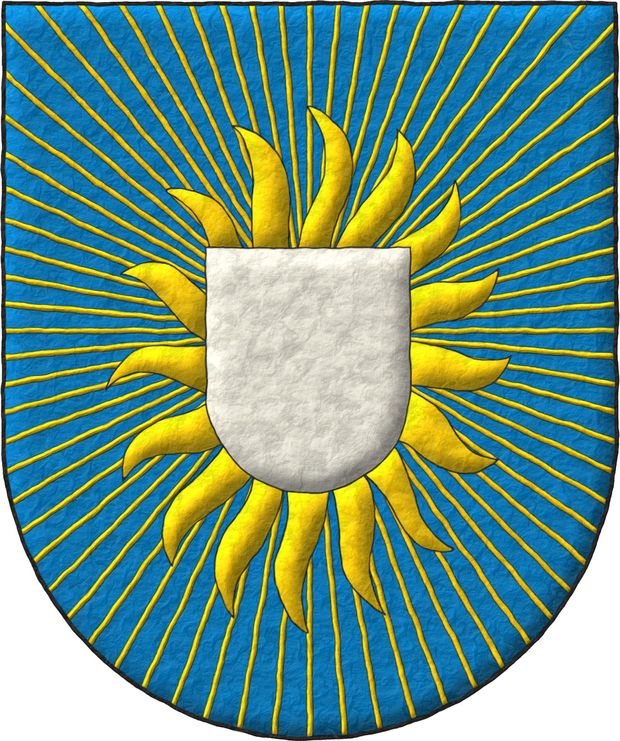
The Society of Heraldic Arts is an international organization founded in 1987, committed to the promotion and preservation of heraldic art. The society brings together artists, craftsmen, and enthusiasts who work in various forms of heraldic expression, from painting and sculpture to calligraphy and jewelry. With members worldwide, the SHA encourages the exchange of knowledge and skill development through exhibitions, publications, and events.
Categories: Institution, Interpreted, Socioeconomic, Illuminated, Semi-circular, Coat of arms, Azure, Inescutcheon, Argent, Enflamed, In orle, Sixteen, Flame, Irradiated, Sixty-four, Line, Throughout (all sides) and Or.


Standard of Rui J. Vaz
Heraldic device depicted by me, in flat tinctures, outlined in Sable, shown as tilted shield, with a semi-circular external shape and with a leather finish.
This is the heraldic standard of Rui J. Vaz's family, US, emblazoned by me. Structure: Coat of arms; Badge; 1st line of the motto «Audacia,Veritas»; Crest; 2nd line of the motto «et Libertas»; Badge.
Blazon keywords: Azure, Gules, Argent, Or, One, Six, Five, Party per pale, Overall, Lion, Rampant, Winged, Grasping, Dexter, Forepaw, Sword, Erect, Crest, Escutcheon, Quarterly, Garuda, Sejant, Castle, Triple-towered, Masoned, Pallet, Plate and Motto.
Style keywords: Tilted shield, Outlined in sable, Plain tincture, Semi-circular and Leather.
Classification: Personal, Interpreted, Boa, Standard and Flag.
Bearer: Vaz, Rui J..


Stauffenberg, Claus von
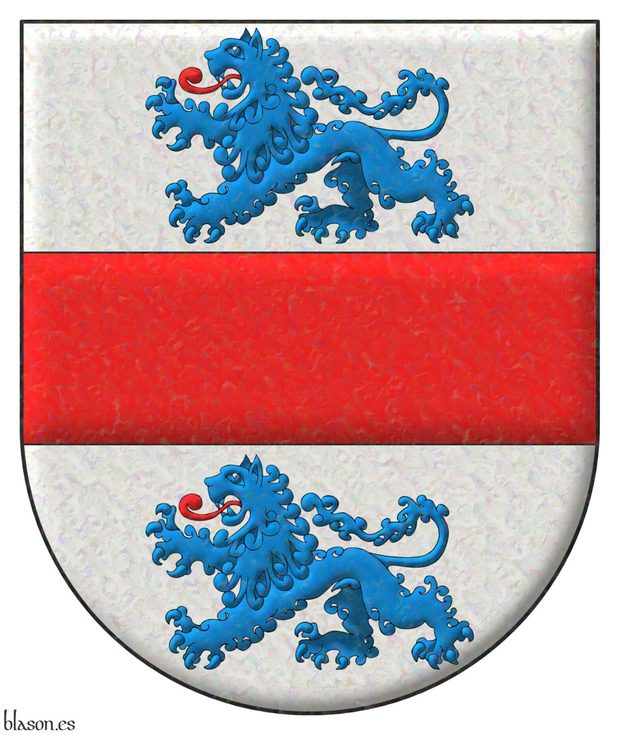
Argent, a fess Gules between two Lions passant Azure, langued Gules.
I have interpreted this coat of arms with a semi-circular shape; tintures argent, gules, and azure; outlined with sable; and a iridiscent finishing.
Blazon keywords: Argent, One, Fess, Gules, Between, Two, Lion passant, Azure and Langued.
Style keywords: Semi-circular, Iridescent (nacar) and Outlined in sable.
Classification: Interpreted, Personal and Coat of arms.
Bearer: Stauffenberg, Claus von.


Stephan Urs Breu with supports
Party per fess: 1 Argent, a rose Gules, barbed and seeded proper; 2 Gules, two swords in saltire Argent, hilted Or. Supporters: Two bears Sable, the eyes, pizzled, langued, armed and gorged Gules.
Blazon keywords: Party per fess, Argent, One, Rose, Gules, Leaved, Seeded, Two, Sword, In saltire, Hilted, Or, Proper, Supporter (animal), Supporter, Bear, Sable, The eyes, Pizzled, Langued, Armed, Collared, Motto and Scroll.
Style keywords: Semi-circular, Outlined in sable, Illuminated and Leather.
Classification: Personal, Interpreted, Coat of arms and Latin language.
Bearer: Breu, Stephan Urs.


Stewart of Scotland, lineage

Or, a fess chequey Azure and Argent.
Escudo de oro, una faja ajedrezada de azur y plata.
Coat of arms emblazoned by me, illuminated with lights and shadows, outlined in Sable, with a semi-circular outer contour and with a rough finishing.
Coat of arms of the lineage Stewart of Scotland. I have emblazoned it with a fess chequy of 3 rows, symmetric and with 9 columns of squares, provided that its height is 1/3 of the width of the coat of arms.
Blazon keywords: Or, Azure, Argent, One, Three, Nine, Fess and Chequey.
Style keywords: Outlined in sable, Illuminated, Semi-circular and Rough.
Classification: Personal, Lineage, Interpreted, Boa and Coat of arms.
Bearer: Stewart of Scotland, lineage.


Subiça of Navarre

Of the twelve lineages of Noblemen, the seventh is Subiça, and bears as arms a shield Or, with a chief Sable at the upper part of the shield, in the same manner as painted in this one.
Or; a chief Sable.
Escudo de oro; el jefe de sable.
Coat of arms interpreted with: a semicircular (round) base; the field in flat Or metal; the chief in flat Sable; and the whole finished in highly-hammered metal.
Coat of arms based on the seventh of the Navarrese «ricoshombres» from [Bosque, J. del; 1540; folio 1 of the numbering of 1613]. The text heading it is taken from the transcription made by [Martinena Ruiz, J. J.; 1982; pages 122 and 123].
Under the title «Surname of Cubiza» these armorial bearings can be consulted in [Vega, P. J. de; 1702; folio 7 of the manuscript].
Blazon keywords: Without divisions, Or, Chief and Sable.
Style keywords: Semi-circular, Plain tincture and Hard metal.
Classification: Interpreted, Personal and Kingdom of Navarre.
Bearer: Subiça of Navarre.


Talbot, lineage of England
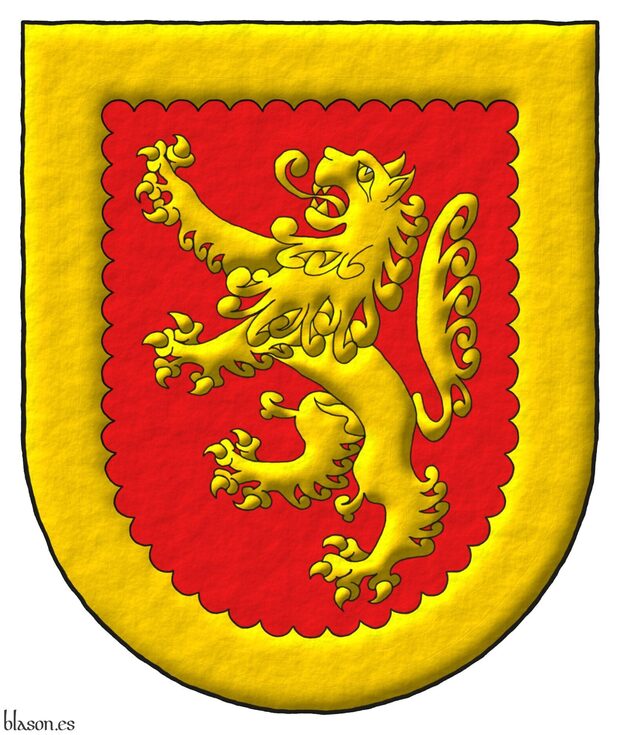
Blazon of the Talbot lineage of England.
Escudo de gules, un león rampante dentro de una bordura angrelada todo oro.
Gules, a lion rampant within a bordure engrailed Or.
Illuminated with lights and shadows and with a freehand finish.
[Rietstap, J. B.; 1861] writes it in French as «de gueules, au lion d'or, à la bordure engrelée du même». y [Burke, J.; 1836; volume 3, pages 359-360] writes it in English as «Gu. a lion rampant, within a bordure engr. or».
Blazon keywords: Without divisions, Gules, One, Lion, Rampant, Within, Bordure, Engrailed and Or.
Style keywords: Freehand, Outlined in sable, Illuminated and Semi-circular.
Classification: Interpreted, Lineage and Kingdom of England.


Tariq Abbasi
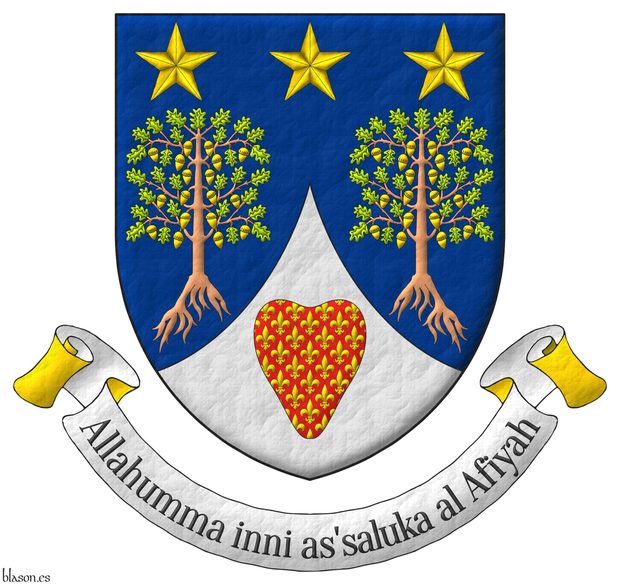
Azure, two oak trees eradicated proper, leaved Vert, fructed Or, in chief three mullets Or; enté en point Argent, a heart Gules semé of fleurs de lis Or. Motto: «Allahumma inni as'saluka al Afiyah» Sable over a scroll Argent doubled Or.
Escudo de azur, dos robles arrancados al natural, hojados de sinople, frutados de oro, en jefe, tres estrellas de cinco puntas de oro; entado en punta de plata, un corazón de gules sembrado de flores de lis de oro. Lema: «Allahumma inni as'saluka al Afiyah» de sable sobre una filacteria de plata doblada de oro.
Arms interpreted by me, illuminated with lights and shadows, outlined in Sable, with a pointed outer contour and with a leather finish.
The coat of arms and motto of Dr. Tariq Abbasi MBE FRSA designed by Vittorio Gifra and emblazoned by me.
Blazon keywords: Azure, Vert, Or, Argent, Gules, One, Two, Three, Oak, Tree, Eradicated, Proper, Leaved, Fructed, In chief, Mullet, Enté en point, Heart, Semé, Fleur de lis, Motto and Scroll.
Style keywords: Outlined in sable, Illuminated, Pointed and Leather.
Classification: Personal, Interpreted, Boa and Coat of arms.
Bearer: Abbasi, Tariq.


Technica impendi nationi

Azure, in base an open book Argent, in chief a sun in splendour Or. Crest: An open royal crown. Motto: «Technica impendi nationi». Motto around the shield: «Universidad de Politécnica de Madrid» fimbriated and depinted Or.
Escudo de azur, un libro abierto de plata surmontado de un sol de oro. Timbrado de una corona real abierta. Lema: «Technica impendi nationi». Divisa alrededor del escudo: «Universidad de Politécnica de Madrid» perfilada y en letras de oro.
Coat of arms interpreted as follows: a semicircular (round) base; the field in flat Azure; the field and charges are illuminated in the tinctures Azure and the metals Argent and Or, all outlined in Sable; my rendition of this coat of arms differs from others in that the sun’s rays, although outlined in Sable, are Or; in the legibility of the text written on the book; and in separating with a dot the words that form the motto; and the whole finished with a beaten-metal effect.
Metal batido y anacarado
Blazon keywords: Without divisions, Azure, Argent, Or, Book, Sun in splendour, Crest and mantling, Crown, Open royal crown, Motto and Motto (identification).
Style keywords: Semi-circular, Oval, Illuminated, Outlined in sable and Metal beaten.
Classification: Interpreted, Socioeconomic and Education.
Bearer: Technical University of Madrid.


Tercio Alessandro Farnese, schema 3x3
Azure, a cross of Burgundy Or; an inescutcheon Or, six fleurs de lis in orle Azure.
Coat of arms of the Tercio Alessandro Farnese, 4th of the Spanish Legion, emblazoned by me in 9 steps. Because «1/3» ~ «one third» ~ «un tercio», and the height and witdh of the inescutcheon is 1/3 of its coat of arms, I use these arms to show a geometric method to calculate it. The inescutcheon has in orle the six fleurs the lis of the Farnese family.
Blazon keywords: Azure, Or, One, Six, Cross of Burgundy, Cross couped, Inescutcheon, Fleur de lis and In orle.
Style keywords: Ratio, Outlined, Outlined in sable, Plain tincture, Illuminated and Semi-circular.
Classification: Military, Interpreted, Schema, Boa and Coat of arms.
Bearer: Tercio Alessandro Farnese.


Tercio Great Captain

Gules, a cross of Burgundy Or; an inescutcheon Or, three bars Gules.
Escudo de gules, una cruz de Borgoña de oro; un escusón de oro, tres fajas de gules.
Arms painted by me, illuminated with lights and shadows, outlined in Sable, with a semi-circular outer contour and with a metal beaten finish.
Coat of arms of the Tercio Great Captain, 1st of the Spanish Legion, emblazoned by me. The inescutcheon represents the coat of arms of Gonzalo Fernandez de Cordoba, 1453-1515, known as «The Great Captain». During the Italian campaigns in the late 15th and early 16th centuries, especially during the wars of Naples, Gonzalo Fernandez de Cordoba reformed the Spanish army, adapting it to the new conditions of Renaissance warfare. He created a flexible tactical system based on the combination of pikemen, inspired by the Swiss; «espingarderos», forerunners of the arquebusiers; and «espadas» or shock troops, this combination would form the foundation of the future «Tercios».
Blazon keywords: Gules, Or, One, Three, Cross of Burgundy, Cross couped, Inescutcheon, Bar and Fess.
Style keywords: Outlined in sable, Illuminated, Semi-circular and Metal beaten.
Classification: Military, Interpreted, Boa and Coat of arms.
Bearer: Tercio Great Captain.


Teresa of Entenza
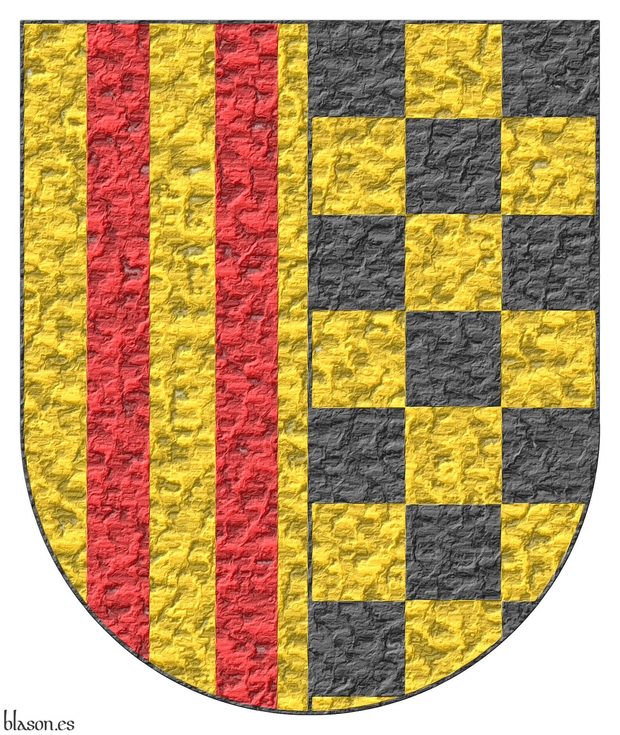
Countess of Urgell, Viscountess of Ager, Lady of Alcolea de Cinca, died in 1327.
Dimidiated: 1 Or, four pallets Gules; 2 chequey Or and Sable.
Escudo dimidiado: 1o de oro, cuatro palos de gules; 2o ajedrezado de oro y sable.
Arms interpreted with: a round-bottom shield; all tinctures in flat Or, Gules, and Sable; and a heavily beaten metal finish.
A dimidiated coat of arms is the result of combining two shields of arms by taking the dexter half of the first and the sinister half of the second.
Dimidiation was used in the 13th and 14th centuries to combine, for instance, the arms of two families.
Its blazoning method does not consist of describing what appears in each of the resulting quarters, but rather, by stating from the beginning that it is dimidiated, describing the original coats of arms. Thus, in this particular case of the arms of Teresa of Entenza, it is not stated that there are only two pallets in the first quarter, but that it is dimidiated and has four pallets, so the reader must know that from the four pallets, only the first two are visible due to the dimidiation.
This method of dimidiating the arms of predecessors results in very beautiful and original designs, but depending on the charges and figures involved, in other cases the result may be unrecognisable or even absurd.
Blazon keywords: Dimidiated, Pale, Chequey, Or, Gules and Sable.
Style keywords: Semi-circular, Plain tincture and Hard metal.
Classification: Interpreted, Personal, Coat of arms and Kingdom of Aragon.
Bearer: Teresa of Entenza.


Teresa Otxoa Magaña, plain tincture

Azure, in chief a moon with human face Argent, in base a crescent chequey Sable and Argent; overall a she-wolf ululant, sejant on the crescent proper, armed and the udders Gules.
Arms emblazoned by me, in plain tinctures, outlined in Sable, with an oval external shape and with a texturized finish.
The coat of arms of Teresa Otxoa Magaña designed by her and her husband Juan Lanzagorta Vallín, and emblazoned by me. Blazon written in Italian by Vittorio Gifra, «Arma: d'azzurro, alla luna figurata d'argento posta in capo, accompanata in punta da un crescente montante scaccato di nero e d'argento; alla lupa di nero sul tutto, seduta su esso crescente, armata e mammellata di rosso».
Blazon keywords: Azure, Argent, Sable, Gules, One, Chief, Moon, With human face, Base, Crescent, Chequey, Overall, She-wolf, Ululant, Sejant, Proper, Armed and Udder.
Style keywords: Outlined in sable, Plain tincture and Oval.
Classification: Personal, Interpreted, Boa and Coat of arms.
Bearer: Otxoa Magaña, Teresa.


Terraza of Aragon, lineage
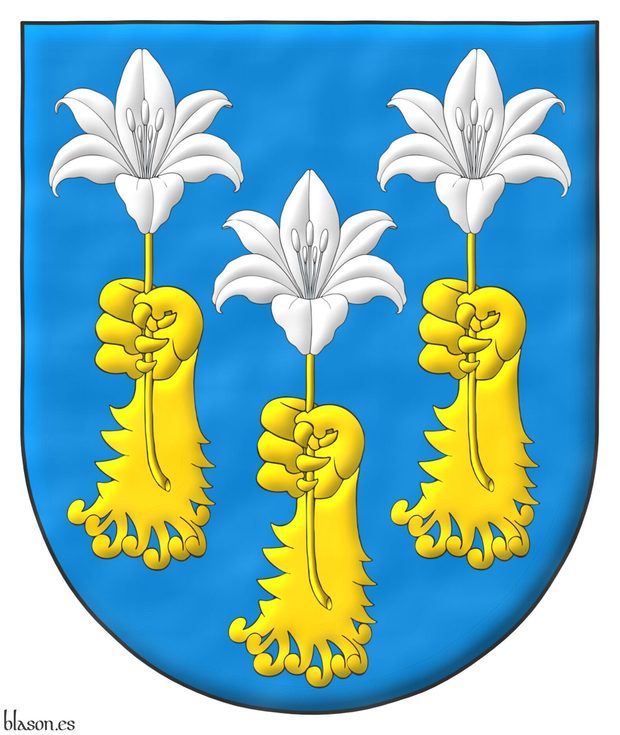
Or, three lion’s paws erect and erased Or, 2 and 1, each grasping a Madonna lily Argent.
Escudo de oro, tres garras de león arrancadas y alzadas de oro, ordenadas, 2 y 1, teniendo cada una una azucena de plata.
Arms emblazoned by me, illuminated with lights and shadows, contoured in Sable, with a semi-circular external shape and with a watercolor finishing.
Coat of arms of the lineage Terraza of Aragon, emblazoned by me following the instructions of Enrique de Alzaga Aliena. The fleur de lis ~ «flor de lis» is a stylized or idealized lily. The lily ~ «lirio» is the flower itself, of which there are various species. The Madonna lily ~ «azucena» is a specific kind of lily; I do not call it white lily to avoid redundancy when it is Argent ~ «plata».
Blazon keywords: Azure, Or, Argent, Three, One, Lion, Paw, Erect, Erased, Ordered, Grasping and Madonna lily.
Style keywords: Outlined in sable, Illuminated, Semi-circular and Watercolor.
Classification: Personal, Lineage, Interpreted, Boa and Coat of arms.
Bearer: Terraza of Aragon, lineage.


The coat of arms of Alena Rehberger in 3 steps
Or, a roe deer springing Gules, in base a triple mount Vert.
Credits:
- Stephan Urs Breu is the designer of the coat of arms.
- Antonio Salmerón y Cabañas is the author of the heraldic art.
Blazon keywords: Or, One, Roe deer, Springing, Gules, In base, Trimount and Vert.
Style keywords: Outlined in sable, Semi-circular, Plain tincture, Illuminated and Leather.
Classification: Personal, Interpreted, Coat of arms and Schema.
Bearer: Rehberger, Alena.


The coat of arms of María Concepción Vallín de Lanzagorta in 3 steps
Gules, on a fess invected Argent, a lioness Azure, armed, langued and the udders Gules.
Blazon keywords: Gules, One, Fess, Invected, Argent, Charged, Lioness, Azure, Armed, Langued and Udder.
Style keywords: Semi-circular, Outlined in sable, Diapered, Plain tincture, Illuminated and Freehand.
Classification: Personal, Interpreted, Coat of arms and Schema.
Bearer: Vallín de Lanzagorta, María Concepción.


The coat of arms of Nathaniel Bendel in 3 steps
Party per pale Azure and Or, a tree eradicated and blasted between two starlings respectant all counterchanged.
Blazon keywords: Party per pale, Azure, Or, One, Tree, Erased, Blasted, Counterchanged, Between, Two, Starling, Respectant and Counterchanged (side-by-side).
Style keywords: Ogee, Outlined in sable, Plain tincture, Illuminated and Freehand.
Classification: Personal, Interpreted, Coat of arms and Schema.
Bearer: Bendel, Nathaniel.


The coat of arms of Ralf Hartemink carved in wood
Or, three puffins proper.
Escudo de oro, tres frailecillos (Fratercula arctica) al natural.
Coat of arms of Ralf Hartemink, founder and owner of Heraldry of the World heraldry-wiki.com, crafted in wood with a height of 60 cm by woodflag.eu, based on my painting of his coat of arms. Since 1995, Heraldry of the World is the most important resource for civic heraldry. The collage contains to the dexter his coat of arms painted by me and to the sinister his coat carved in wood hanging on the wall of the factory where it was made.
Blazon keywords: Without divisions, Or, Three, Puffin and Proper.
Style keywords: Pointed, Outlined in sable, Illuminated and Leather.
Classification: Personal, Interpreted, Coat of arms, Collage and Photographic.
Bearer: Hartemink, Ralf.


The goose volant of Eugene McCarthy
Argent, a stag trippant Gules, attired and hoofed Sable, standing on a terrace in base Vert charged with a fess Or; on a chief Sable, three geese volant contourné Argent.
La imagen combina una fotografía de un dibujo de un ganso volante alterado y su escudo de armas ambos pintados por mí.
Blazon keywords: Argent, One, Stag, Tripant, Gules, Attired, Hoofed, Sable, Terrace in base, Base, Vert, Charged, Fess, Or, Chief, Three, Goose, Volant and Facing sinister.
Style keywords: Outlined in sable and Pointed.
Classification: Personal, Interpreted, Coat of arms, Hand-drawn, Collage and Photographic.
Bearer: McCarthy, Eugene.


![Ver [The Heraldry Society of Scotland] en instituciones citadas. Fortaleza de oro y mazonada de sable.](../css/Fortaleza.Institucion.png)
The Heraldry Society of Scotland

Objectives and activities
The Heraldry Society of Scotland ~ «The Heraldry Society of Scotland», was founded in 1977. Its objectives are to promote the study of heraldry and to encourage its correct use both in Scotland and abroad.
The HSS (acronym for The Heraldry Society of Scotland) encourages those who have a coat of arms and those who intend to adopt their own arms to become members of the society and also encourages to join all those interested in Scottish heraldry, therefore the HSS admits and has members from all over the world.
The HSS holds active and regular meetings throughout the year and organizes conferences and visits to places of historical and heraldic interest, both within Scotland and in other countries.
Online content
They also maintain and update a website, whose domain is Heraldry-Scotland.co.uk, with interesting and abundant reading material, among which their list of online armorials with blazons in English stands out, among which the following armorials can be highlighted:
- Sir David Lindsay's Armorial from 1542, with 504 coats of arms and identification letters «DL», from «DL001» to «DL504». Includes imaginary coats of arms, for example, that of «DL011» of Hector of Troy which it imagines as «Sable, two lions combatant Or», which [Avilés, J.; 1725a; page 7] blazons with a Gules field, this difference would allow tracing the sources of each author, which would be interesting as it is, moreover, imaginary.
- Hamilton Armorial, from 1560, with 82 coats of arms they say, although only 79 appear, and identification letters «HM», from «HM001» to «HM079», where for example, «HM001» is the arms of Scotland «Or, a lion rampant Gules armed and langued Azure within a double tressure flory counter-flory Gules» and «HM026» is the insignia of Scotland «Or, a lion rampant within a double tressure flory counter-flory Gules».
- Queen Mary's Roll from 1562, with 204 coats of arms and identification letters «QM». from «QM001» to «QM204».
- Forman's Armorial from 1563, with 258 coats of arms they say, although only 247 appear, and identification letters «FAL», that is, from «FAL001», the arms of Scotland, to «FAL247».
- Slains Armorial from 1565, with 712 coats of arms they say, although only 638 appear, and identification letters «SL», that is, from «SL001» to «SL638».
- Armorial of Sir David Lindsay of the Mount, Secundus from 1599, with 285 coats of arms and identification letters «DLS».
- Seton Armorial from 1599, with 422 coats of arms and identification letters «SN», from «SN001» to «SN422».
- Dunvegan Armorial estimated to be around 1600, with 282 coats of arms they say, although only 52 appear, and identification letters «DV», only 2 digits and without leading zeros, from «DV1» to «DV52».
- Kings and Nobilities Arms, 2nd volume from 1638, with 111 coats of arms and identification letters «KNB», from «KNB001», the arms of the King of Scotland, to «KNB111».
- Nisbet's A System of Heraldry published in 1722, with 2,608 coats of arms, according to my count, and which I reference as [Nisbet, A.; 1722], 1st edition and [Nisbet, A.; 1816], for a later one that I have available. On the same page appears the blazon of Alexander Nisbet himself, in entry 1,926 according to my calculations, as «Argent, three boars' heads erased Sable within a bordure invected Gules», that is, «Argent: three boars' heads erased Sable; a bordure invected Gules» where «invected» ~ «acanalado» as opposed to «engrailed» ~ «angrelado».
I also find very interesting, for example, their pages on the basic principles of heraldic design, written by Doctor Patrick Barden.
Categories: Institution, Interpreted, Socioeconomic, Illuminated, Outlined in sable, Iridescent (nacar), Freehand, Semi-circular, Coat of arms, Without divisions, Azure, Saltire, Argent, Thistle, Couped (tree), In chief, In base, Inescutcheon and Gules.


The Heraldry Society, schema
The coat of arms of The Heraldry Society emblazoned by me in 4 steps: 1) ratios, 2) delineation, 3) plain tincture, and 4) lights and shadows. Blazon: Quarterly Azure and Gules; overall a leopard face, crowned Or, langued Gules, within a tressure flory Or.
Blazon keywords: Quarterly, Azure, Gules, Overall, Head, Leopard, Crowned, Or, Langued, Within, Tressure and Flory.
Style keywords: Pointed, Illuminated, Outlined in sable, Shaded and Freehand.
Classification: Interpreted, Socioeconomic, Coat of arms and Schema.
Bearer: The Heraldry Society.


Thomas Antrobus
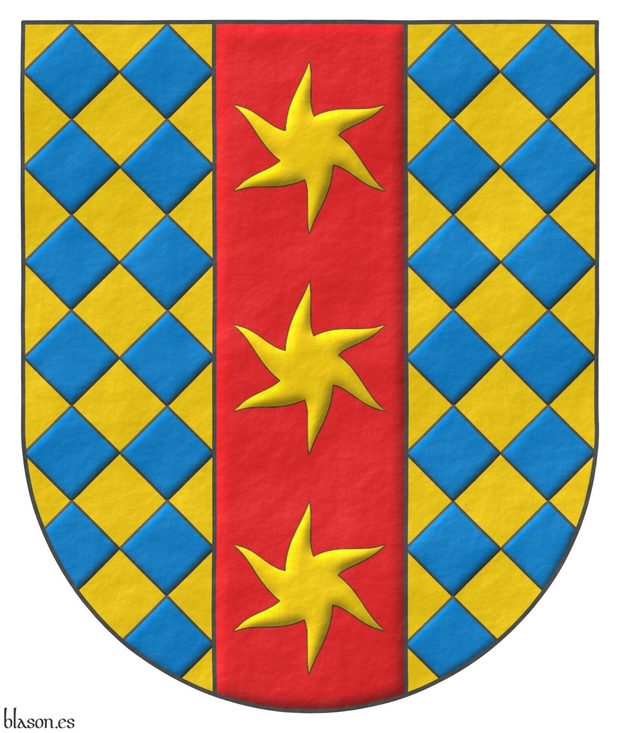
1525-1581.
Lozengy Or and Azure, on a pale Gules, three estoiles Or.
Escudo losanjado oro y azur, en un palo de gules, tres estrella ondadas de oro.
Coat of arms interpreted in the following manner: the shape of the base is semicircular; the field has been enameled in Azure; the lozenges with their 4 rectangular and equal angles, are outlined in Sable and illuminated in metal Or; the lozengy is 6 lozenges wide by 7 lozenges high; the pale outlined in Sable and illuminated in Gules; the estoiles with 6 wavy rays outlined in Sable and illuminated in metal Or; and the whole with a rough finish.
The term in Castilian for the «estrellas ondadas» (wavy stars) is «Estrella» (star) alone, which, like other figures, if not blazoned, is assumed to have 5 straight rays unless another number is stated.
The English term «estoile», which is used in this blazon, as opposed to «mullet», refers to a star of 6 wavy rays ~ «six points and wavy», which in heraldry are called wavy. Sometimes, and depending on the era, these differences may not have been so clear.
Blazon keywords: Lozengy, Or, Azure, Pale, Gules, Charged and Estoile.
Style keywords: Semi-circular, Illuminated, Outlined in sable and Rough.
Classification: Interpreted and Personal.
Bearer: Antrobus, Thomas.


Thomas de Warbleton

Thomas de Warbrentone ~ Thomas de Warbleton.
Lozengy Or and Azure.
Escudo losanjado oro y azur.
Coat of arms interpreted in the following manner: the shape of the base is a semicircular arch; the field has been enameled with plain metal tint Or; the lozenges with their 4 rectangular and equal angles, are outlined in Sable and illuminated in Azure; the lozengy is 6 lozenges wide by 7 lozenges high, which can also be indicated as 7 lozenges in length by 7 lozenges in latitude; and the whole has received a marble finish.
Lozengy is defined by [Avilés, J.; 1780a; page 101] as «it is said of the Shield and pieces covered with lozenges».
Blazon keywords: Lozengy, Or and Azure.
Style keywords: Semi-circular, Illuminated, Outlined in sable and Marmoreal.
Classification: Interpreted and Personal.
Bearer: Warbleton, Thomas de.


Thomas de Werblintone
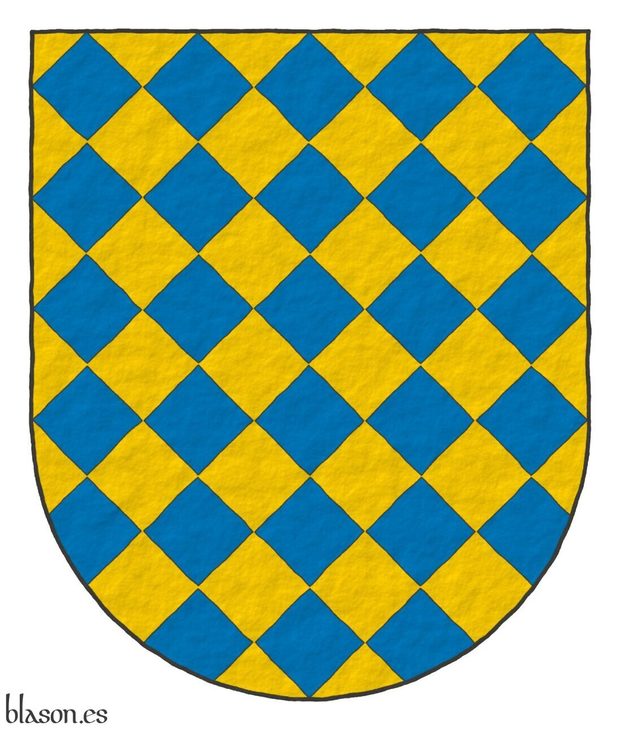
Thomas de Warbleton ~ Thomas de Werblintone.
Lozengy Or and Azure.
Escudo losanjado de oro y azur.
Included in [Vincent, MS; 1285; number 245] also known as [St. George's Roll; 1285; number 245].
Blazon keywords: Without divisions, Lozengy, Or and Azure.
Style keywords: Semi-circular, Plain tincture and Outlined in sable.
Classification: Interpreted and Personal.
Bearer: Tomás de Warbleton.


Thomas Grenville, painting schema
The painting of the coat of arms of Thomas Grenville in 3 steps tracing, tincture and illumination.
Gules, three Clarions Or.
Blazon keywords: Without divisions, Gules, Three, Clarion and Or.
Style keywords: Freehand, Plain tincture and Illuminated.
Classification: Interpreted, Kingdom of England and Schema.
Bearer: Grenville, Thomas.


Thomas le FizThomas
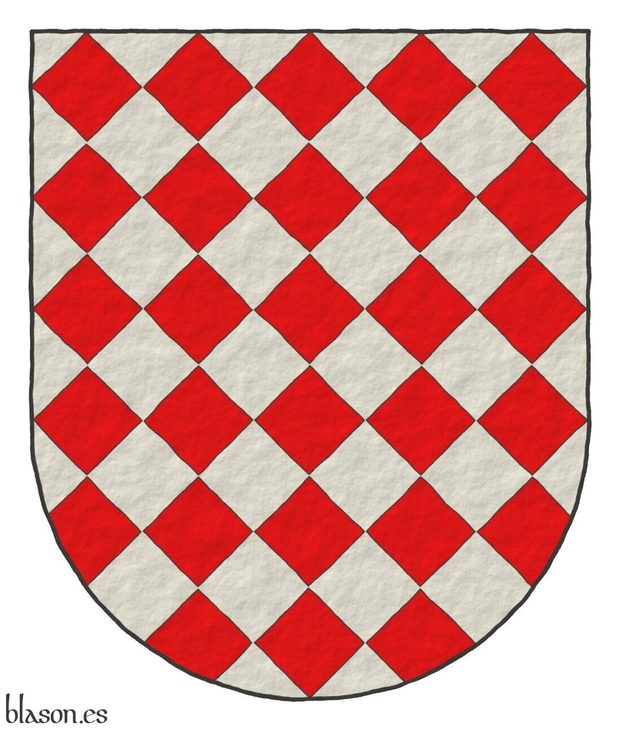
Thomas FitzThomas ~ Thomas le FizThomas.
Lozengy Argent and Gules.
Escudo losanjado de plata y gules.
Included in [Vincent, MS; 1285; number 245] also known as [St. George's Roll; 1285; number 245].
Blazon keywords: Without divisions, Lozengy, Argent and Gules.
Style keywords: Semi-circular, Plain tincture and Outlined in sable.
Classification: Interpreted and Personal.
Bearer: Tomás FitzThomas.


Thomas Roscelyn

Tomás Roscelyn Thomas ~ Roscelyn ~ Thomas Rocelin.
Gules, three buckles Argent.
Escudo de gules, tres hebillas de plata.
Included in [Vincent, MS; 1285; number 595] also known as [St. George's Roll; 1285; number 595].
Blazon keywords: Without divisions, Argent, Three, Buckle, Sable and Ordered.
Style keywords: Triangular curved, Illuminated, Outlined in sable and Freehand.
Classification: Interpreted and Personal.
Bearer: Tomás Roscelyn.


Twist, Michael
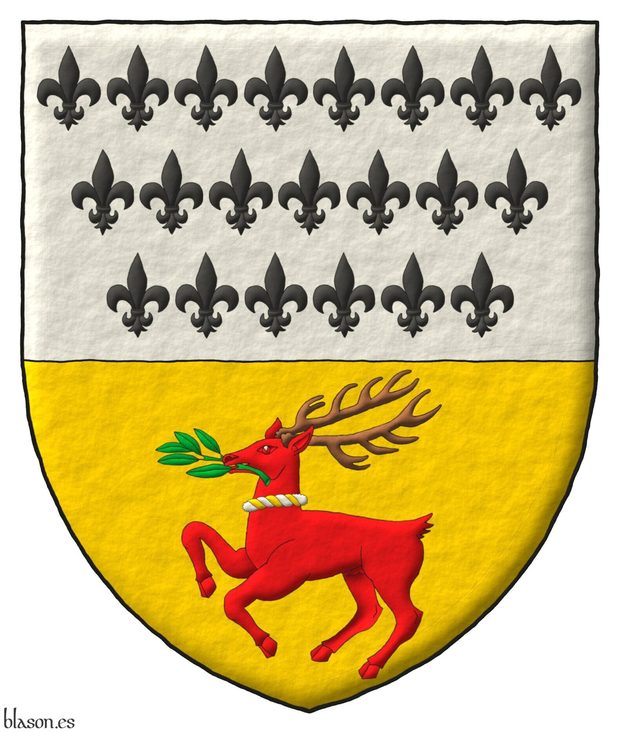
Party per fess Argent and Or, in chief twenty one fleurs de lis Sable, 8, 7, and 6, in base, a stag passant Gules attired proper, holding in its mouth a sprig Vert, gorged with a wreath Argent and Or.
Escudo cortado de plata y oro, en jefe veintiuna flores de lis de sable, 8, 7 y 6, en punta un ciervo pasante de gules, ramado al natural, teniendo en su boca una ramita de sinople, colletado de un burelete de plata y oro.
Arms painted by me, illuminated with lights and shadows, contoured in Sable, with a pointed external shape and with a freehand finishing.
G0130, Chief Herald of Arms of Malta's grant of the coat of arms of Michael Twist, Malta. This coat of arms has been emblazoned by me.
Blazon keywords: Argent, Sable, Or, Gules, Vert, Twenty one, One, Party per fess, In chief, Fleur de lis, Stag, Passant, Attired, Grasping, Sprig, Gorged and Wreath.
Style keywords: Outlined in sable, Illuminated, Pointed and Freehand.
Classification: Personal, Interpreted, Boa and Coat of arms.
Bearer: Twist, Michael.


UBU

Purpure, a castle triple-towered Or, port and windows Azure, masoned Sable; on a chief Azure, a cross patty Or, between two escallops Argent.
Escudo de púrpura, un castillo de oro, aclarado de azur, mazonado de sable; un jefe de azur, cargado de una cruz patada de oro acompañada de dos veneras de plata.
Coat of arms interpreted as follows: with a semicircular (round) base; the field and the chief in the flat tinctures Purpure and Azure, with a lightly-hammered metal finish; and the four charges outlined in Sable, shaded, illuminated, and with a very hammered metal finish.
I hold the University Specialist degree in Real Estate Management and Administration, awarded by the Department of Private Law of the University of Burgos. These studies are structured over three academic years and are pursued online in combination with periods of traditional classes in the summers and on-site examinations during the winters. This was my first long-term online training experience.
Blazon keywords: Purpure, Or, Azure, Sable, Argent, Castle, Chief, Cross, Cross patty, Cross couped and Escallop.
Style keywords: Semi-circular, Illuminated, Shaded, Outlined in sable, Soft metal and Hard metal.
Classification: Interpreted, Socioeconomic and Education.
Bearer: Burgos, University of.


Ukraine
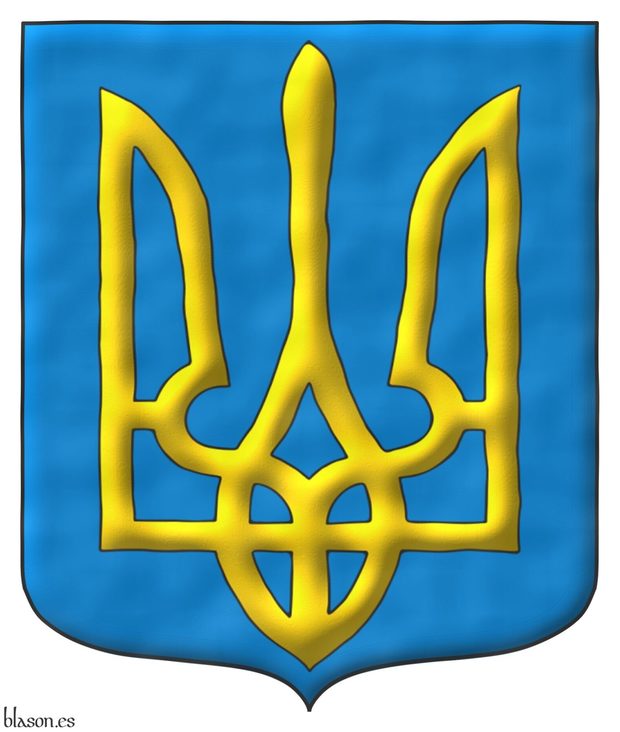
Trident~Tryzub.
Azure, a Tryzub Or.
Interpreted coat of arms: with a rounded and pointed shape; illuminated with metals or and color azure; outlined with sable; and a Watercolor finish.
Blazon keywords: Without divisions, Azure, Trident and Or.
Style keywords: Ogee, Illuminated, Outlined in sable and Freehand.
Classification: Coat of arms, Interpreted, Civic and State of Ukraine.
Bearer: Ukraine.


University of Navarra
![University of Navarra Emblem Azure, Saint Michael Argent, vested and nimbed Or, grasping in his dexter hand a spear Or, point downward, and in his sinister hand bearing [ Gules, a chain orlewise, crosswise, and saltirewise Or, charged in the fess point with an emerald Vert, of Navarre ], upon a dragon Vert, armed, langued, fanged, and the eyes Gules.](../escudo_armas/UnavN.21.SanMiguel.Plata.Vestido.Oro.jpg)
Emblem Azure, Saint Michael Argent, vested and nimbed Or, grasping in his dexter hand a spear Or, point downward, and in his sinister hand bearing [ Gules, a chain orlewise, crosswise, and saltirewise Or, charged in the fess point with an emerald Vert, of Navarre ], upon a dragon Vert, armed, langued, fanged, and the eyes Gules.
Emblema de azur, un San Miguel de plata, vestido y nimbado de oro, teniendo en su diestra una lanza de oro, con la punta hacia abajo y en su siniestra trae [ escudo gules, una cadena puesta en orla, en cruz y en sotuer de oro, cargada en el centro de una esmeralda de sinople, de Navarra ], sostenido por un dragón de sinople, armado, lampasado, fierezado y encendido de gules.
Emblem interpreted by me as follows: an oval shape with proportions 5x6, wider than the original; the field illuminated in Azure; its charges outlined in Sable and illuminated in the colours Gules and Vert and the metals Argent and Or; the Archangel Saint Michael vested in Or, unlike others who appear in Argent; his emerald simplified into an area enameled Vert; and the whole emblem has a lightly beaten metal finish.
Due to its special characteristics, the difficulty in complying with the first rule of heraldry concerning metals and colours, and out of prudence, I categorize it as an emblem rather than a shield.
In a relief of the Church of Saint Michael the Archangel in Estella, Saint Michael can be seen fighting a dragon that represents the devil, in a similar but mirrored arrangement to that of this emblem. In that relief, the Archangel Saint Michael bears a pre-heraldic shield with its umbo. According to [Menéndez Pidal de Navascués, F.; 1963], the umbo of the shield is a reinforcing element that is the predecessor of what would later become the pommelly carbuncle of the shield of the Kingdom of Navarre.
Blazon keywords: Without divisions, Azure, Male figure, Angel, Archangel, Argent, Vested, Nimbed, Or, Grasping, Dexter, Spear, Point downwards, Sinister, Gules, One, Chain, Orlewise, Crosswise, Saltirewise, Charged, In the fess point, Emerald, Vert, Upon, Dragon, Armed, Langued, The fangs and The eyes.
Style keywords: Oval, Illuminated, Outlined in sable and Soft metal.
Classification: Interpreted, Socioeconomic, Education, Emblem and Kingdom of Navarre.
Bearer: University of Navarra.


Urban IV

182nd Pope of the Church, from 1261 to 1264. «Urbanus IV», born Jacques Pantaleon of Court-Palais, was born in Troyes, France.
Quarterly: 1 and 4 Azure, a fleur de lis Or; 2 and 3 Argent, a rose Gules.
Escudo cuartelado: 1o y 4o de azur, una flor de lis de oro; 2o y 3o de plata, una rosa de gules.
Coat of arms of Urban IV with: a pointed and rounded shield shape; the field in plain Azure and Argent enamels; the figures outlined in the field, shaded and illuminated in Or and Gules; and with a watercolor finish.
Blazon keywords: Quarterly, Azure, One, Fleur de lis, Or, Argent, Rose and Gules.
Style keywords: Ogee, Illuminated, Shaded, Outlined in the field tincture and Watercolor.
Classification: Interpreted, Religious and Papal States.
Bearer: Urban IV.


Urban V

200th Pope of the Church, from 1362 to 1370. «Urbanus V», born Guillaume de Grimoard, was born in Le Pont-de-Montvert, in the Languedoc.
Gules, a chief dancetty of four full points Or.
Escudo de gules, un jefe encajado de cuatro piezas enteras de oro.
Papal coat of arms interpreted with: a round-topped shield; the field in plain Gules; the chief indented, illuminated in metal Or, and outlined in Sable; and the whole design in hammered metal.
[Rietstap, J. B.; 1861] blazons it as Grimoard «de gueules, au chef émanché de quatre pièces d'or».
Blazon keywords: Gules, Chief, Dancetty, Or, Three and Two.
Style keywords: Semi-circular, Illuminated, Outlined in sable and Metal beaten.
Classification: Interpreted, Religious and Papal States.
Bearer: Urban V.


Urban VI

202nd Pope of the Church, from 1378 to 1389. «Urbanus VI», named Bartolomeo Prignano, born in Itri, near Naples, in the Lazio region.
Or, an eagle displayed Azure.
Escudo de oro, un águila de azur.
Papal coat of arms interpreted with: a pointed mouth; the field in flat tincture of metal Or; the eagle illuminated in Azure, shaded and outlined in the color of the field; and the whole with a rough finish.
Blazon keywords: Without divisions, Or, One, Eagle and Azure.
Style keywords: Pointed, Illuminated, Outlined in the field tincture, Shaded and Rough.
Classification: Interpreted, Religious and Papal States.
Bearer: Urban VI.


Urgell, County of
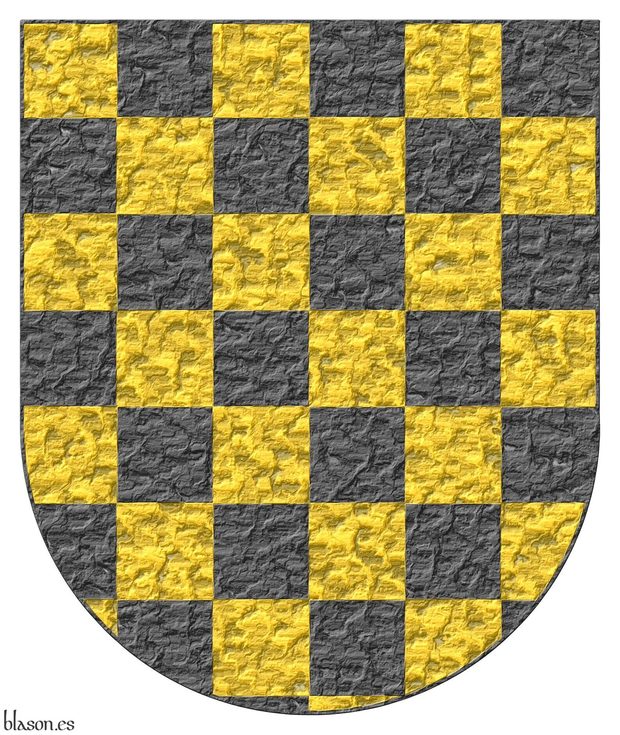
Chequey Or and Sable.
Escudo ajedrezado de oro y sable.
Arms interpreted with: a round-topped shield shape; the chequey pattern in flat metal Or and colour Sable; and a heavily beaten metal finish.
[Avilés, J.; 1780a; page 33] writes about the application of the chequey pattern to shields, ordinaries and charges: «chequey is said of the shield, the principal ordinaries, and even some animals, such as eagles, lions, and other charges, when they are composed of alternating square pieces in the fashion of a chessboard.» On the minimum number of panes he generally specifies that «for a shield to be called chequey, it must have at least twenty chessboard panes; because if it has only nine, it is called equipoll; and if it has fifteen, it is said to be of fifteen panes of chequey» and for its application to ordinaries that «other ordinaries, such as bends, fesses, etc., must have at least two rows of chequey to be considered chequey, otherwise they would be called compony.»
Blazon keywords: Chequey, Or and Sable.
Style keywords: Semi-circular, Plain tincture and Hard metal.
Classification: Interpreted, Civic, Coat of arms and Kingdom of Aragon.
Bearer: Urgell, County of.


Urroz of Navarre
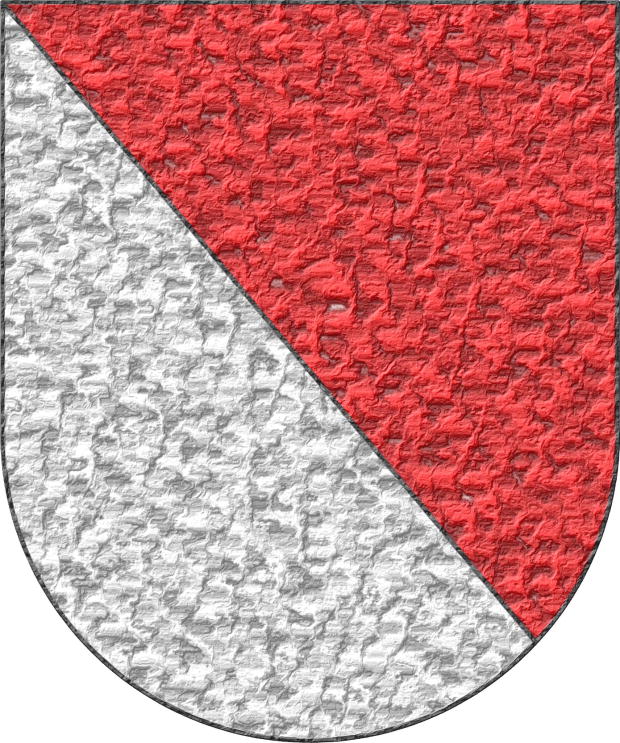
De los doce linajes de Ricos Hombres el quinto es la buena villa de Urroz, la torre blanca; y goza en armas un escudo partido por medio, de lo alto ata baxo, a manera de banda, desta forma e deuisas que en este escudo está de presente pintado.
Party per bend: 1 Gules; 2 Argent.
Escudo tronchado: 1o de gules; 2o de plata.
Coat of arms with poco margen for the interpretación con: la base of semicircular (round); el field of tintas planas of Gules and Argent; y con a finish of metal muy batido.
Coat of arms basado in the 5o of los «ricoshombres» of Navarra de [Bosque, J. del; 1540; folio 1o of the numeración of 1613]. El texto previo a su blasón está extraído of the transcripción realizada por [Martinena Ruiz, J. J.; 1982; páginas 122 and 123].
Bajo the título «Apellido of Vrroz» también puede consultarse en [Vega, P. J. de; 1702; folio 4B of the manuscrito], estando the 4 in the esquina superior izquierda and the B in the base of the coat of arms. Este folio tendría that estar numerado with a 5.
Blazon keywords: Party per bend, Gules and Sable.
Style keywords: Semi-circular, Plain tincture and Hard metal.
Classification: Interpreted, Personal and Kingdom of Navarre.
Bearer: Urroz of Navarre.


Uschiolo and Ustiolo, lineages
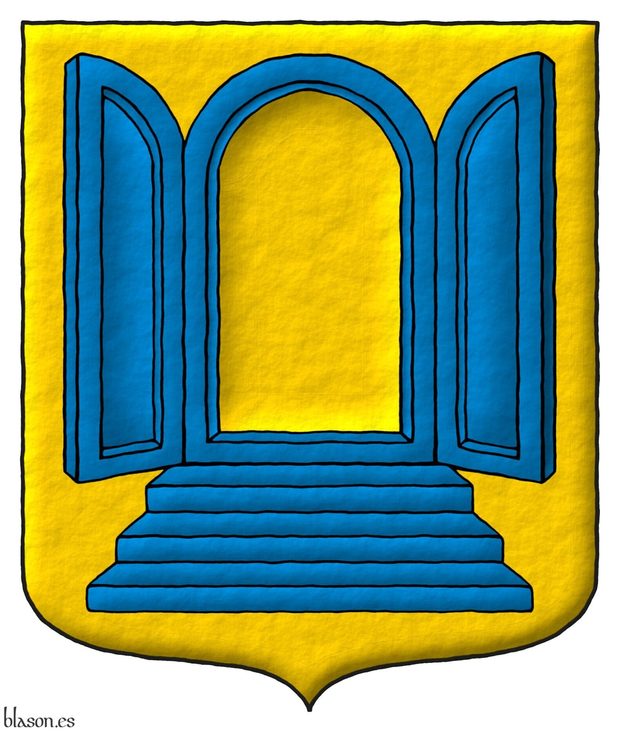
Or, a port Or, with jambs, enarched lintel, and two open leaves, upon a three-step stairway Azure.
Escudo de oro, una puerta con jambas, dintel arqueado, dos hojas abiertas sostenida de una escalinata de tres peldaños todo de azur, aclarada de oro.
Arms painted by me, highlighted with lights and shadows, outlined in Sable, with an ogee external shape and with a freehand finish.
Coat of arms of the lineages Uschiolo and Ustiolo, emblazoned by me following the blazon published by Vittorio Gifra in Italian: «Arma: d’oro, alla porta di due ante a timpano arcuato d’azzurro, scalinata di tre pezzi del medesimo e aperta del campo».
Blazon keywords: Or, Azure, One, Two, Three, Port, Arched, Enarched, Upon, Step, Stairway and Port and windows.
Style keywords: Outlined in sable, Illuminated, Ogee and Freehand.
Classification: Personal, Lineage, Interpreted, Boa and Coat of arms.
Bearer: Uschiolo and Ustiolo, lineages.


Vera, lineage of Aragon

Blazon of the Vera lineage of Aragon.
Vair ancient, a bordure gules charged with eight saltires couped Or.
Escudo de veros antiguos, una bordura de Gules cargada de ocho sotueres cortados de oro.
Illuminated and with a glass finish.
It can be consulted in [Mogrovejo de la Cerda, J.; 1636; cover].
[Friar, S.; 1987; pages 156-157] says of the vair: «originates from the fur of a species of squirrel... which was popular in the Middle Ages as a lining for the garments of those not entitled to wear ermine. The animal was blue-grey on the back and white underneath. By sewing a number of these pelts together, with white and blue-grey alternating,... one which easily translated into the stylized armorial form of Vair and its variants».
Blazon keywords: Vair ancient, One, Bordure, Gules, Charged, Eight, Saltire, Party per fess and Or.
Style keywords: Freehand, Outlined in sable, Illuminated and Semi-circular.
Classification: Interpreted, Lineage and Coat of arms.


Vermandois, County of

Chequey Or and Azure.
Escudo ajedrezado de oro y azur.
Arms interpreted by me, highlighted with lights and shadows, outlined in Sable, with a semi-circular outer contour and with a freehand finishing.
Coat of arms of the County of Vermandois, France, emblazoned by me.
Blazon keywords: Or, Azure and Chequey.
Style keywords: Outlined in sable, Illuminated, Semi-circular and Freehand.
Classification: Civic, Interpreted, Boa and Coat of arms.
Bearer: Vermandois, County of.


Vichiers, Renaud de
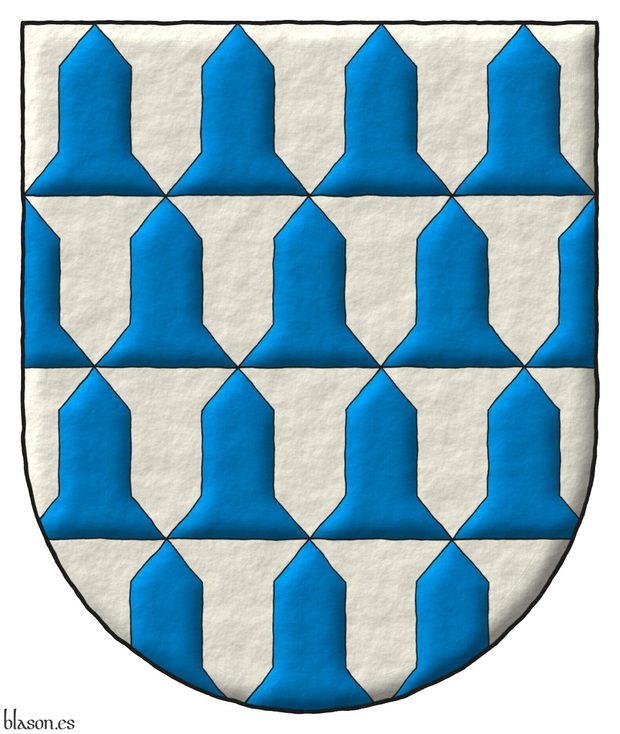
Vair.
Escudo de veros.
Coat of arms emblazoned by me with a semi-circular shape, illuminated, and with a freehand finishing.
You can consult how to paint a veros fur in [Costa y Turell, M.; 1858; page 37, plate 1, illustrations 17 and 18].
Blazon keywords: Vair.
Style keywords: Outlined in sable, Illuminated, Semi-circular and Freehand.
Classification: Religious, Military, Knights Templar, Interpreted and Coat of arms.
Bearer: Vichiers, Renaud de.


Vidaurre of Navarre
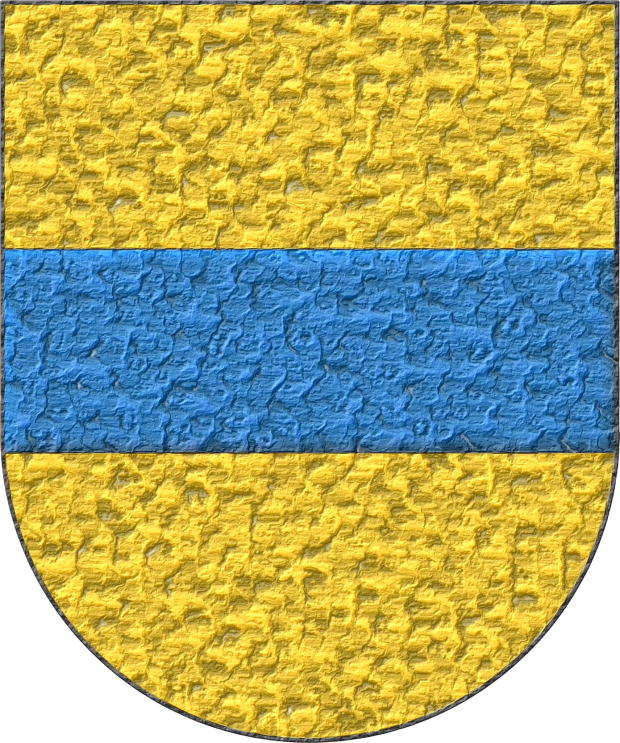
Of the twelve lineages of Noblemen, the ninth is Vidaurre, who bears as arms a shield Or and, in the middle, a fess Azure, in the same manner as this shield is now painted.
Or, a fess Azure.
Escudo de oro, una faja de azur.
Coat of arms interpreted with: a semicircular (round) base; the field in flat Or; the fess illuminated in Azure and outlined in Sable; and the whole finished in highly-hammered metal.
Interpreted from the ninth coat of arms of the Navarrese «ricoshombres» from [Bosque, J. del; 1540; folio 1 of the numbering of 1613] and with the preceding text taken from the transcription appearing in [Martinena Ruiz, J. J.; 1982; pages 122 and 123].
Under the title «Surname of Vidaurre» this coat of arms can be consulted in [Vega, P. J. de; 1702; folio 9 of the manuscript].
Blazon keywords: Without divisions, Or, Fess and Azure.
Style keywords: Semi-circular, Illuminated, Outlined in sable and Hard metal.
Classification: Interpreted, Personal and Kingdom of Navarre.
Bearer: Vidaurre of Navarre.
Blazon equivalent to: Vernon, barón de Shubbroc.


Vidriales García y Bustamante, Carlos
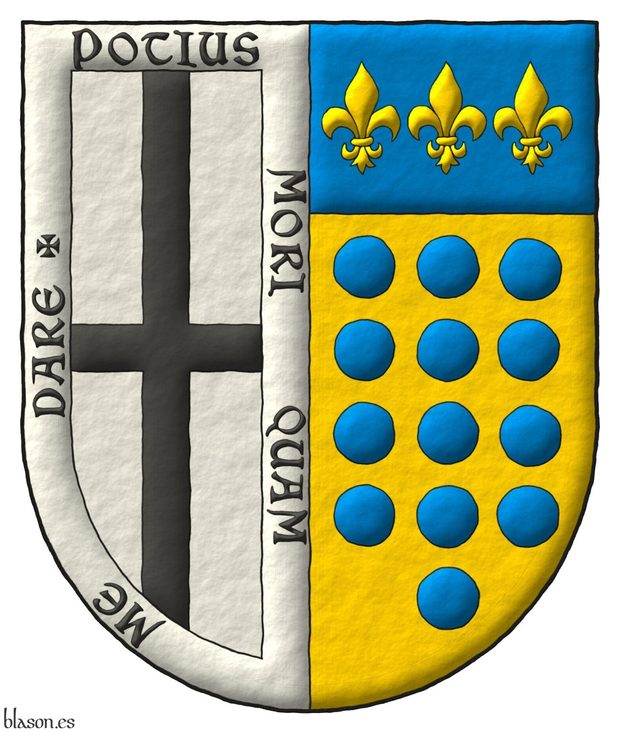
Interpreted coat of arms: with a semi-circular shape; illuminated with metals argent and or and colors sable and azure; outlined with sable; and a freehand finish.
Blazon keywords: Party per pale, Argent, Cross, Sable, Bordure, Motto, Or, Thirteen, Hurt, Hurt, torteau, pellet, pomme and golpe, Azure, Three, In pale, Four, Five, Chief and Fleur de lis.
Style keywords: Freehand, Semi-circular, Illuminated and Outlined in sable.
Classification: Coat of arms, Interpreted and Personal.
Bearer: Vidriales García y Bustamante, Carlos.


Vidriales, C. M.

Interpreted coat of arms: with a semi-circular shape; illuminated with metals argent and or and colors sable and azure; outlined with sable; and a freehand finish.
Blazon keywords: Party per pale, Argent, Cross, Sable, Bordure, Motto, Or, Thirteen, Hurt, Hurt, torteau, pellet, pomme and golpe, Azure, Three, In pale, Four, Five, Chief, Fleur de lis, Label and Suspended.
Style keywords: Freehand, Semi-circular, Illuminated and Outlined in sable.
Classification: Coat of arms, Interpreted and Personal.
Bearer: Vidriales, C. M..


Vidriales, M. P.

Interpreted coat of arms: with a semi-circular shape; illuminated with metals argent and or and colors sable and azure; outlined with sable; and a freehand finish.
Blazon keywords: Party per pale, Argent, Cross, Sable, Bordure, Motto, Or, Thirteen, Hurt, Hurt, torteau, pellet, pomme and golpe, Azure, Three, In pale, Four, Five, Chief, Fleur de lis, Cantoned and Martlet.
Style keywords: Freehand, Semi-circular, Illuminated and Outlined in sable.
Classification: Coat of arms, Interpreted and Personal.
Bearer: Vidriales, M. P..


Vilardi, lineage of Italy
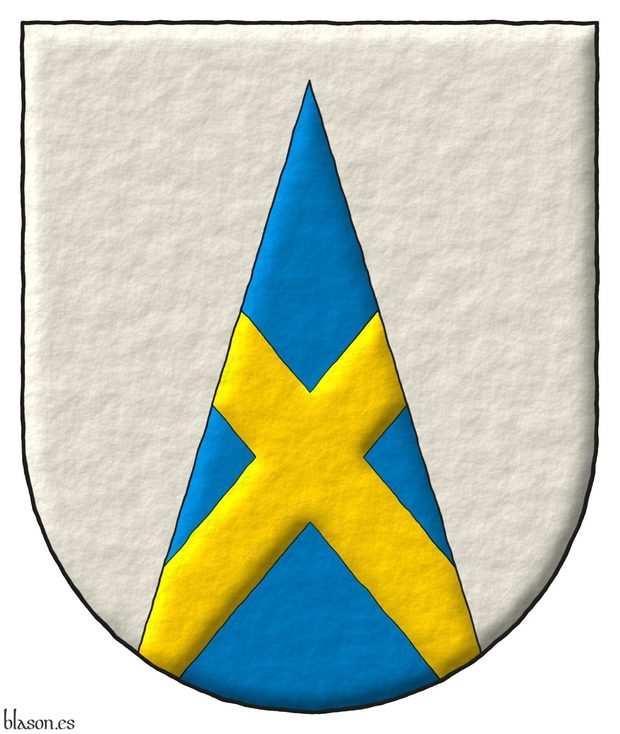
Blazon of the Vilardi lineage of Italy.
Argent, on a pile issuant from the base Azure a saltire Or.
Escudo de plata, una pira de azur cargada de un sotuer de oro.
Illuminated and a free hand finishing.
[Cadenas y Vicent, V. de; 2002; page 138] says that the a pile issuant from the base is «a triangle whose base issues from the base of the shield, being a third of its width», but when it is painted in [Cadenas y Vicent, V. de; 2002; page 268, figure 279] along with the pile the width of the base of both isosceles triangles is 2/3 of the width of the shield. I think the width of 2/3 is, in these 2 cases, better than 1/3 width, because with 1/3 there is not enough room for charges, as shown in the figure below.
There are scholars who say that the pile issuant from the base must not touch the upper edge of the shield and others that its tip should be in the center of the chief. In the previous image, the pile issuant from the base of the 1st shield fulfills the first affirmation, and in the 2nd shield, its tip is in the center of the chief.
I have the doubt if it should not be a saltire raguly.
Blazon keywords: Without divisions, Argent, One, Pile issuant from base, Azure, Charged, Saltire and Or.
Style keywords: Freehand, Outlined in sable, Illuminated and Semi-circular.
Classification: Interpreted, Lineage and Italian Republic.


Vittorio Gifra, triangular curved shape and iridescent finish
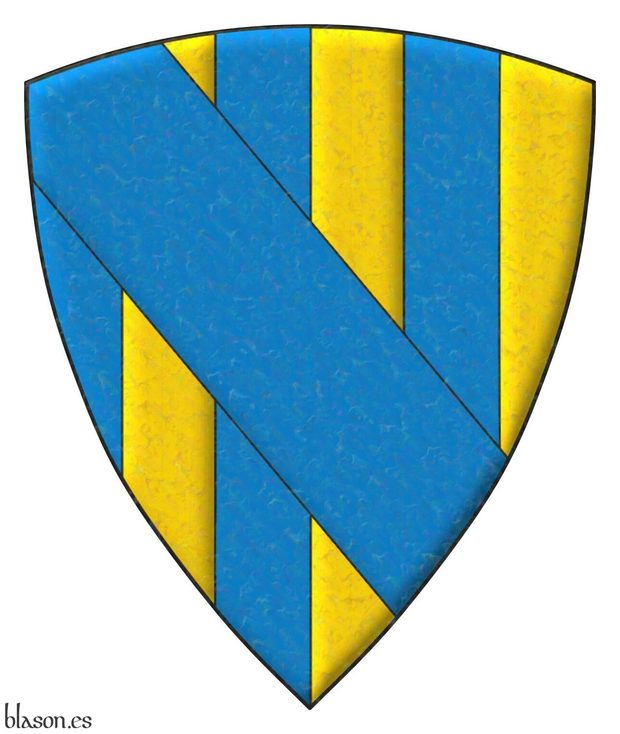
Palato d’azzurro e d’oro di sei pezzi, alla banda del primo attraversante sul tutto.
Paly of six Azure and Or; over all a bend Azure.
Blazon keywords: Paly, Six, Azure, Or, Surmounted, Overall (deprecated) and Bend.
Style keywords: Triangular curved, Iridescent (nacar), Illuminated and Outlined in sable.
Classification: Coat of arms, Interpreted and Personal.
Bearer: Gifra, Vittorio.


Walker, Peter Edward
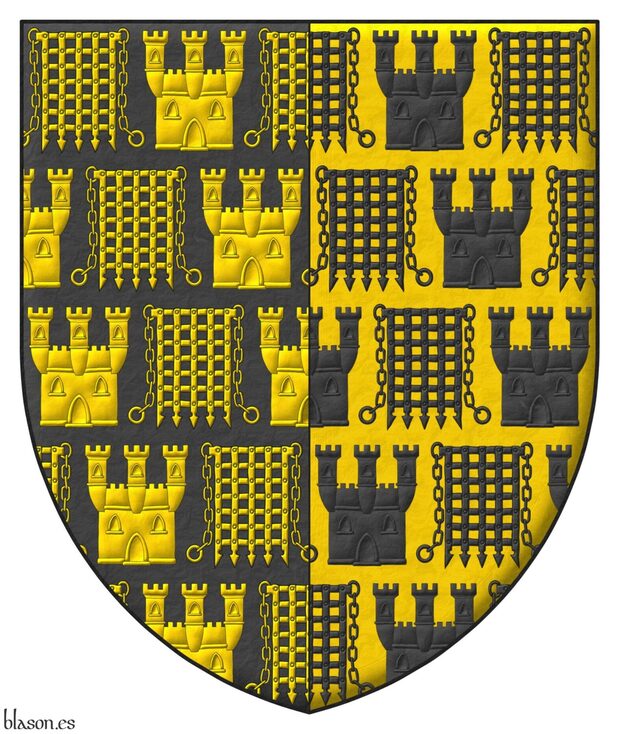
Baron Walker of Worcester
Party per pale Sable and Or semé of portcullises and three turreted towers all counterchanged.
Escudo partido de sable y oro sembrado del uno al otro de rastrillos y torres tridonjonadas.
Illuminated with lights and shadows and with a metallic finish.
Coat of arms of Peter Edward Walker, Baron Walker of Worcester, emblazoned by me in 4 steps, notice that it is a double semé.
Blazon keywords: Party per pale, Sable, Or, Semé, Counterchanged, Portcullis, Tower, With a turret, Three and Turret.
Style keywords: Soft metal, Outlined in sable, Illuminated and Pointed.
Classification: Interpreted and Schema.
Bearer: Walker, Peter Edward.


Warbrentone, Thomas de
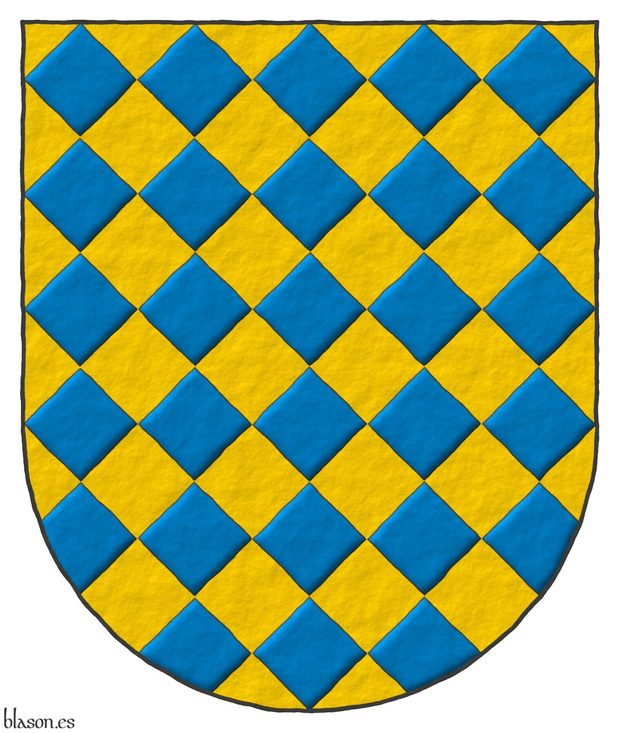
Thomas de Warbleton ~ Thomas de Warbrentone.
Lozengy Or and Azure.
Escudo losanjado oro y azur.
Coat of arms interpreted with: the semicircular base shape; the field of plain metal Or; the lozenges illuminated in Azure, outlined in Sable and with their 4 angles at 90o; the lozengy of proportion 5 x 6; and the whole with a raised-stroke effect.
Can be found in [Heralds' Roll, T.; 1280; shield number 647], in [St. George's Roll; 1285; shield number 245] and in [Charles' Roll; 1285; shield number 360].
Blazon keywords: Lozengy, Or and Azure.
Style keywords: Semi-circular, Illuminated, Outlined in sable and Freehand.
Classification: Interpreted and Personal.
Bearer: Warbrentone, Thomas de.


White tie and Grand Collar of the OERC
It has been painted by me, illuminated with lights and shadows, outlined in Sable, with a semi-circular external shape and with a rough finish.
Heraldry, decoration, and order of wear white tie of the Grand collar of the Ordo Equestris Reginae Caeli, the three have been emblazoned by me. The OERC acts according to the Christian principles of charity and solidarity. Its members engage personally in social and humanitarian initiatives, always aiming to bring concrete help and moral support to people in need. Through these efforts, the OERC seeks to serve peace and human dignity beyond all borders.
Blazon keywords: Order, Decoration, White tie, Azure, Or, Argent, One, Four, Eight-pointed cross, Cross couped, Fleur de lis, Crowned, Monogram, Grand collar and Surrounded.
Style keywords: Outlined in sable, Illuminated, Semi-circular and Rough.
Classification: Interpreted and Boa.
Bearer: Ordo Equestris Reginae Caeli.

William Bardolf

Guillermo Bardolf ~ William Bardolf ~ Willem Bardulf.
Azure, three cinquefoils Or.
Escudo de azur, tres quinquefolios de or.
Included in [Vincent, MS; 1285; number 223] also known as [St. George's Roll; 1285; number 223].
Blazon keywords: Without divisions, Azure, Three, Cinquefoil, Or and Ordered.
Style keywords: Semi-circular, Illuminated, Shaded, Outlined in sable and Freehand.
Classification: Interpreted and Personal.
Bearer: Guillermo Bardolf.


William de Ferrers, Earl of Derby
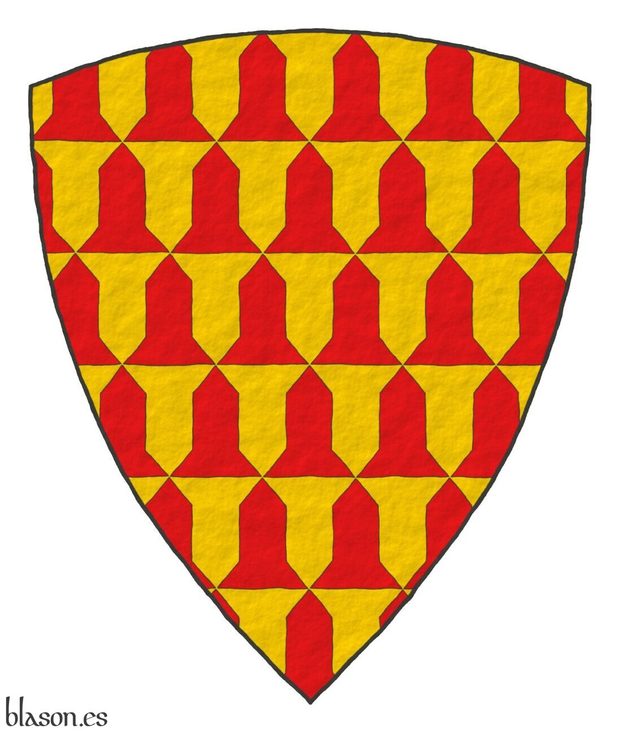
William de Ferrers, Earl of Derby ~ Cunte de Ferrers.
Vairy Or and Gules.
Escudo verado de oro y gules.
Interpreted coat of arms, the shape of the shield is triangular and curved plain tinctures metal Or and color Gules, outlined in sable; and a free hand finishing.
Included in [Vincent, MS; 1285; number 17] also known as [St. George's Roll; 1285; number 17].
Blazon keywords: Without divisions, Vairy, Or and Gules.
Style keywords: Triangular curved, Plain tincture and Outlined in sable.
Classification: Interpreted and Personal.
Bearer: Guillermo de Ferrers.


William de Hondeshacre
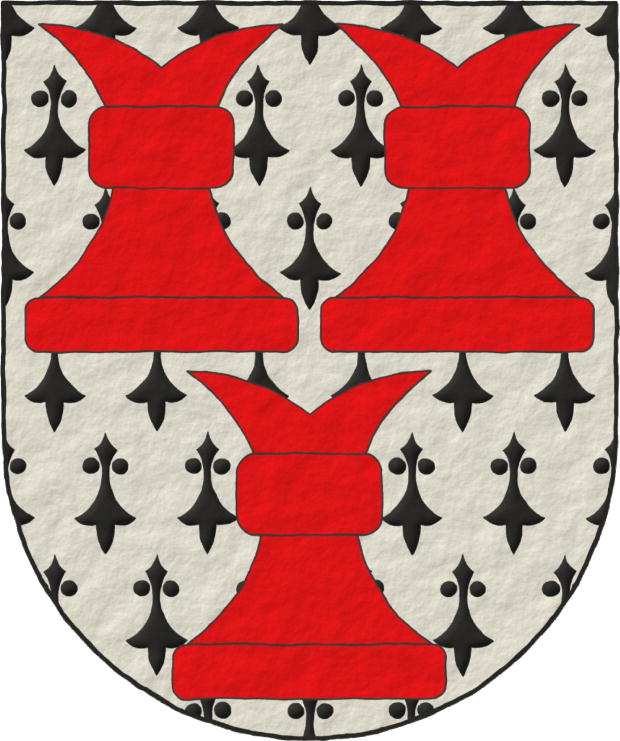
William de Handsacre ~ William de Hondeshacre.
Ermine, three chess rooks Gules.
Escudo de armiños, tres roques de gules.
Included in [Vincent, MS; 1285; number 469] also known as [St. George's Roll; 1285; number 469].
Blazon keywords: Without divisions, Ermine, Three, Chess rooks, Gules and Ordered.
Style keywords: Semi-circular, Illuminated, Outlined in sable and Freehand.
Classification: Interpreted and Personal.
Bearer: Guillermo de Handsacre.

William Shakespeare, lanza de torneo

Or, on a bend Sable, a spear of the first, steeled Argent.
Escudo de oro, una banda de sable, cargada de una lanza de plata, fustada oro.
Coat of arms interpreted by me with: a semicircular (round) base; the field and bend illuminated in Or and Sable; the lance is a tournament one, similar to other Shakespeare coats of arms, which I have illuminated in Argent and Or and outlined from the field; and finished with a lightly hammered metal effect.
In this version of his blazon in English I have written «steeled Argent», which is how some authors write it, while in another article I have specified it as «headed Argent».
In the figure that is charged upon the bend of this interpretation of the shield, I recreate a tournament lance, which is the type usually used to represent the arms of William Shakespeare. Note that the blazon of his shield only indicates «a Spear» ~ «una lanza», so it could equally be the type of lance used by infantry or light cavalry. However, English tradition usually employs, for William Shakespeare, a tournament lance, both for the one charged on the bend and for the one held by the falcon on his crest.
Blazon keywords: Without divisions, Or, Sable, Argent, Bend, Bendwise, Spear and Charged.
Style keywords: Soft metal, Outlined in the field tincture and Illuminated.
Classification: Interpreted, Personal, Coat of arms, Canting and Literature.
Bearer: Shakespeare, William.


Wright, Charles F. M.
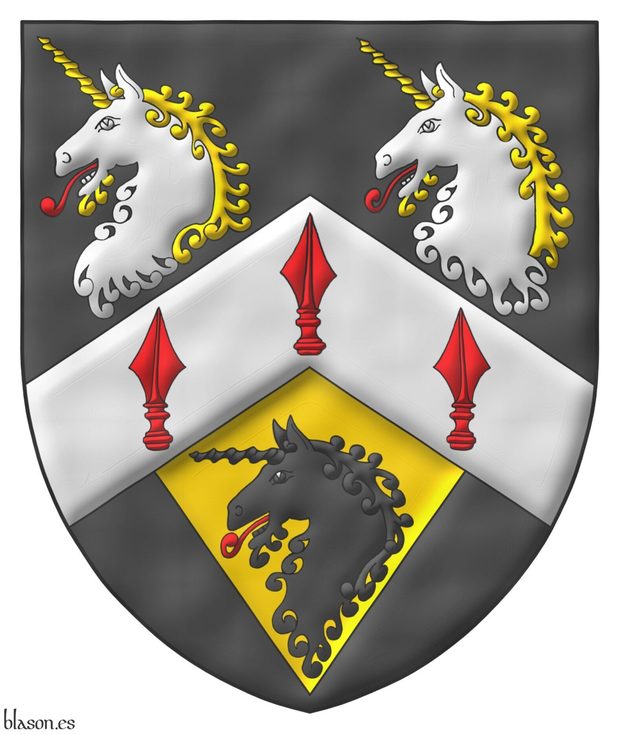
Sable, on a chevron Argent three spears' heads Gules, in chief two unicorns' heads erased Argent, horned and crined Or, langued Gules, in base on a pile of the last issuant from the chevron a unicorn head erased Sable, langued Gules.
Escudo de sable, un cabrio de plata con tres puntas de lanza de gules; en jefe, dos cabezas de unicornio arrancadas de plata, cabelladas y acornadas de oro, lampasadas de gules; en punta, una pila de oro, saliente del cabrio, cargada de una cabeza de unicornio de sable, lampasada de gules.
Illuminated and a watercolor finishing.
Note that it is a pile bacause it does not touch the border of the shield.
Blazon keywords: Sable, Chevron, Argent, Three, Spear's head, Gules, In chief, Two, Head, Unicorn, Erased, Crined, Horned, Or, Langued, In base, One and Pile.
Style keywords: Outlined in sable, Pointed, Illuminated and Watercolor.
Classification: Personal, Interpreted and Coat of arms.
Bearer: Wright, Charles F. M..


Wright, John Anthony

Argent, a cross calvary Gules, in the dexter of the chief a fleur de lis Azure.
Escudo de plata, una cruz de calvario de gules, en la diestra del jefe, una flor de lis de azur.
Arms painted by me, illuminated with lights and shadows, outlined in Sable, with a pointed outer contour and with a freehand finishing.
G0105, Chief Herald of Arms of Malta's grant for the coat of arms of John Anthony Wright, Ireland. This coat of arms has been emblazoned by me.
Blazon keywords: Argent, Gules, Azure, One, Cross calvary, Dexter, Chief and Fleur de lis.
Style keywords: Outlined in sable, Illuminated, Pointed and Freehand.
Classification: Personal, Interpreted, Boa and Coat of arms.
Bearer: Wright, John Anthony.


Yishay Ifrah, outlined
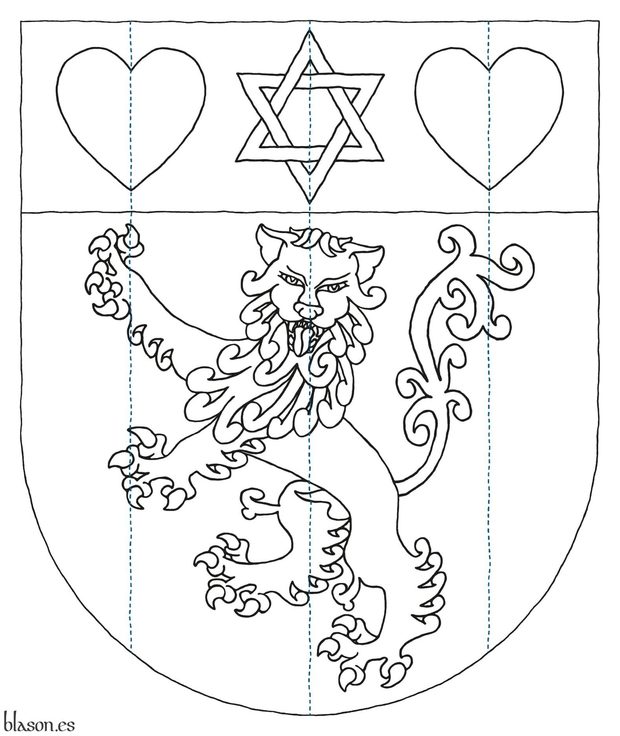
Argent, a lion rampant guardant Vert, armed and langued Gules; on a chief Gules, a mullet of six points voided, interlaced Argent between two hearts Or.
The coat of arms of Yishay Ifrah outlined by me. The internal structure of this design is that the lion's forepaws fall below the center of the dexter heart, the central vertical axis passing through the center of the Star of David runs between the lion's eyes, and the tip of the tail falls below the center of the sinister heart.
Blazon keywords: Argent, Vert, Gules, Or, One, Two, Lion rampant guardant, Armed, Langued, Chief, Charged, Star of David, Mullet, Voided, Interlaced, Between and Heart.
Style keywords: Outlined and Semi-circular.
Classification: Personal, Interpreted, Boa and Coat of arms.
Bearer: Ifrah, Yishay.


Yñigo-Genio, Elias

Or, six fleurs de lis, three, two, one, five Gules and one in the middle of the chief Azure.
Arms interpreted using a semi-circular shape; tinctures metal or and colors gules and azur; the color sable for delineation; and a freehand finish.
Credits: Rolando Yñigo-Genio is the designer of the coat of arms and Antonio Salmerón y Cabañas is the author of the heraldic art.
Blazon keywords: Or, Six, Fleur de lis, Ordered, Three, two and one, Five, Gules, One, Azure and In the middle of the chief.
Style keywords: Semi-circular, Freehand and Outlined in sable.
Classification: Interpreted, Personal and Coat of arms.
Bearer: Yñigo-Genio, Elias.
-
Language
-
Categories of heraldry
-
Divisions of the field
- Without divisions
- Party per pale
- Party per fess
- Party per bend
- Party per bend sinister
- Tierce
- Tierce sinister
- Tierced per pale
- Tierced per fess
- Tierced per bend
- Tierced pallwise inverted
- Quarterly
- Quarterly per saltire
- Gyronny
- Party per fess, the chief per pale
- Party per pale, the sinister per fess
- Party per fess, the base per pale
- Party per pale, the dexter per fess
- Chapé
- Chaussé
- Embrassé
- Contre-embrassé
- Party per chevron
- Enté
- Enté en point
- Flanched
-
Metals
-
Colours
-
Furs
-
Other tinctures
-
Ordinaries and sub-ordinaries
-
Diminutives of the ordinaries
-
Other charges
-
Inanimate charges from Nature
Atom, Crescent, Diamond, Emerald, Estoile, Increscent, Lightning flash, Moon, Mount, Mullet, Mullet of four points, Orbital, Plough of Ursa Major, Rainbow, Ray of the sun, River, Sea, Snowflake, Sun, Sun in splendour, Sun of May, Trimount and Water.
-
Vegetal charges from Nature
Acorn, Apple, Apple tree, Ash, Bluebonnet, Camellia, Chrysanthemum, Cinquefoil, Cornflower, Dogwood flower, Double rose, Elm, Fleur de lis, Flower, Holm oak, Hop cone, Kapok tree, Laurel, Lily, Linden, Lotus flower, Madonna lily, Oak, Olive tree, Palm tree, Pomegranate, Poplar leaf, Rose, Shamrock, Sunflower, Thistle, Tree, Tulip, Vine and Wheat.
-
Animal charges from Nature
Badger, Bald eagle, Barbel, Barn owl, Bear, Beaver, Beetle, Bighorn sheep, Blackbird, Boar, Brach hound, Bull, Doe, Dog, Dolphin, Dove, Eagle, Elephant, Falcon, Fish, Flame, Fly, Fox, Frog, Goat, Goldfinch, Goose, Heron, Horse, Hummingbird, Jaguar, Lark, Leopard, Lion, Lion passant, Lion rampant guardant, Lioness, Lynx, Male figure, Martlet, Merino ram, Owl, Panther, Parrot, Peacock, Pelican, Pelican in her piety, Puffin, Quetzal, Raven, Roe deer, Rooster, Savage, Seagull, Serpent, She-wolf, Stag, Starling, Tyger, Vulture, Warren hound and Wolf.
-
Parts of natural charges
Arm, Beak, Branch, Caboshed, Chest, Claw, Covert, Dorsal fin, Eagle claw, Ermine spot, Escallop, Feather, Foot (palmiped), Foreleg, Forepaw, Hand, Head, Heart, Hoof, Leaf, Neck, Ostrich feather, Palm frond, Paw, Roe deers' attires, Shoulder, Sprig, Stags' attires, Stem, Swallow-tail, Tail, Tail addorsed, Tail fin, Talon, Tooth, Trunk, Trunk (elephant), Two hands clasped, Two wings in vol, Udder, Wheat spike, Wing and Wrist.
-
Artificial charges
Ace of spades, Anchor, Anvil, Arch, Arm vambraced, Armillary sphere, Arrow, Axe, Bell, Bell tower, Beret, Bonfire, Book, Bookmark, Bow, Bridge, Broken, Buckle, Cannon, Cannon dismounted, Cannon port, Canopy roof, Carbuncle, Castle, Celtic Trinity knot, Chain, Chess rooks, Church, Clarion, Clay pot, Closed book, Club, Comb, Compass rose, Conductor's baton, Cord, Covered cup, Crozier, Crucible, Cuffed, Cup, Cyclamor, Dagger, Double vajra, Drum, Ecclesiastical cap, Fanon, Federschwert, Fleam, Four crescents joined millsailwise, Galician granary, Garb, Gauntlet, Geometric solid, Grenade, Halberd, Hammer, Harp, Host, Hourglass, Key, Key ward, Knight, Knot, Lantern, Letter, Line, Loincloth, Menorah, Millrind, Millstone, Millwheel, Monstrance, Mortar, Mullet of six points pierced, Nail, Non-classic artifact, Norman ship, Number, Oar, Oil lamp, Open book, Page, Pair of scales, Parchment, Pestle, Piano, Plough share, Polish winged hussar, Port, Portcullis, Potent, Quill, Ribbon, Rosette of acanthus leaves, Sabre, Sackbut, Sail, Scroll, Scythe, Sheaf of tobacco, Ship, Skirt, Spear, Spear's head, Stairway, Star of David, Step, Sword, Symbol, Tetrahedron, Torch, Tower, Trident, Trumpet, Turret, Two-handed sword, Wagon-wheel, Water-bouget, Wheel, Winnowing fan and With a turret.
-
Immaterial charges
Angel, Archangel, Basilisk, Dragon, Dragon's head, Garuda, Golden fleece, Griffin, Heart enflamed, Mermaid, Our Lady of Mercy, Ouroboros, Paschal lamb, Pegasus, Phoenix, Sacred Heart of Jesus, Saint George, Sea-griffin, Trinity, Triton, Unicorn, Winged hand and Wyvern.
-
External elements
-
Heraldic creations
-
References
-
Formats
-
Keywords on this page
Port and windows, Between, Watercolor, Proper, Pointed, Armed, Azure, Boa, Bordure, Charged, Castle, Crest, Ogee, Crown, Cross couped, Quarterly, Outlined in sable, Dexter, Two, In chief, In base, Coat of arms, Mullet, Fess, Fleur de lis, Personal, Gules, Illuminated, Interpreted, Chief, Langued, Motto, Lion, Lineage, Masoned, Semi-circular, Or, Leather, Argent, Without divisions, Civic, Rampant, Religious, Sable, Vert, Plain tincture, Freehand, Three and One.

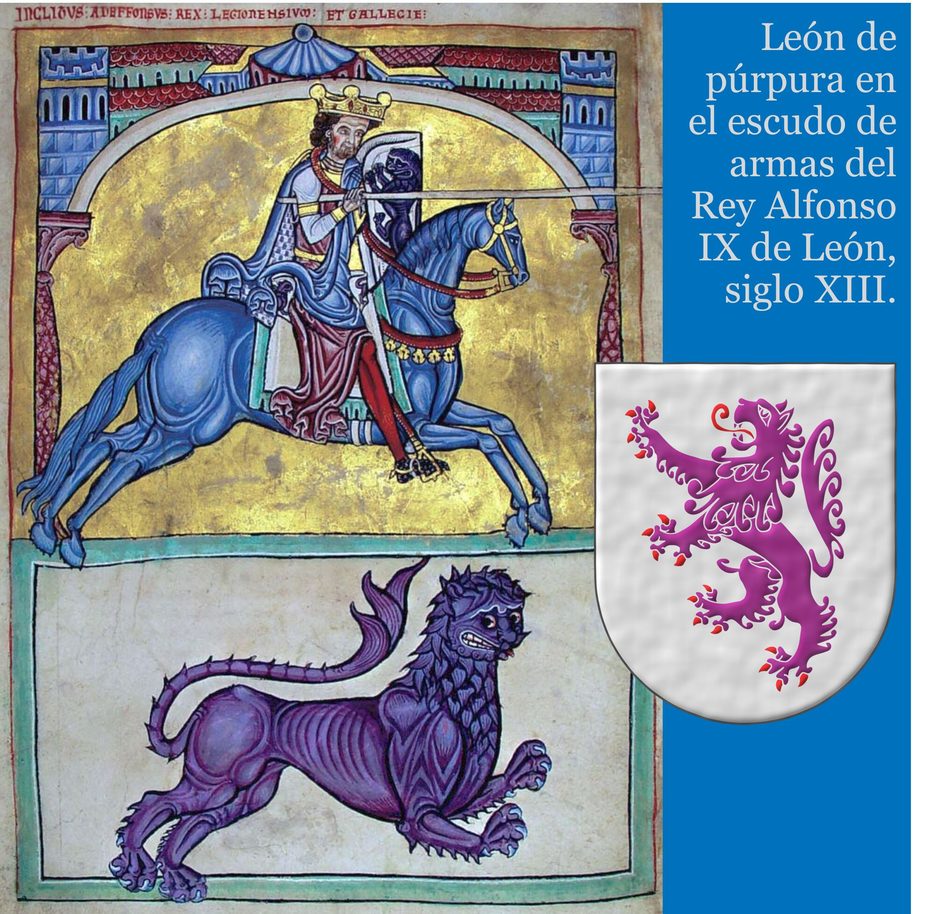



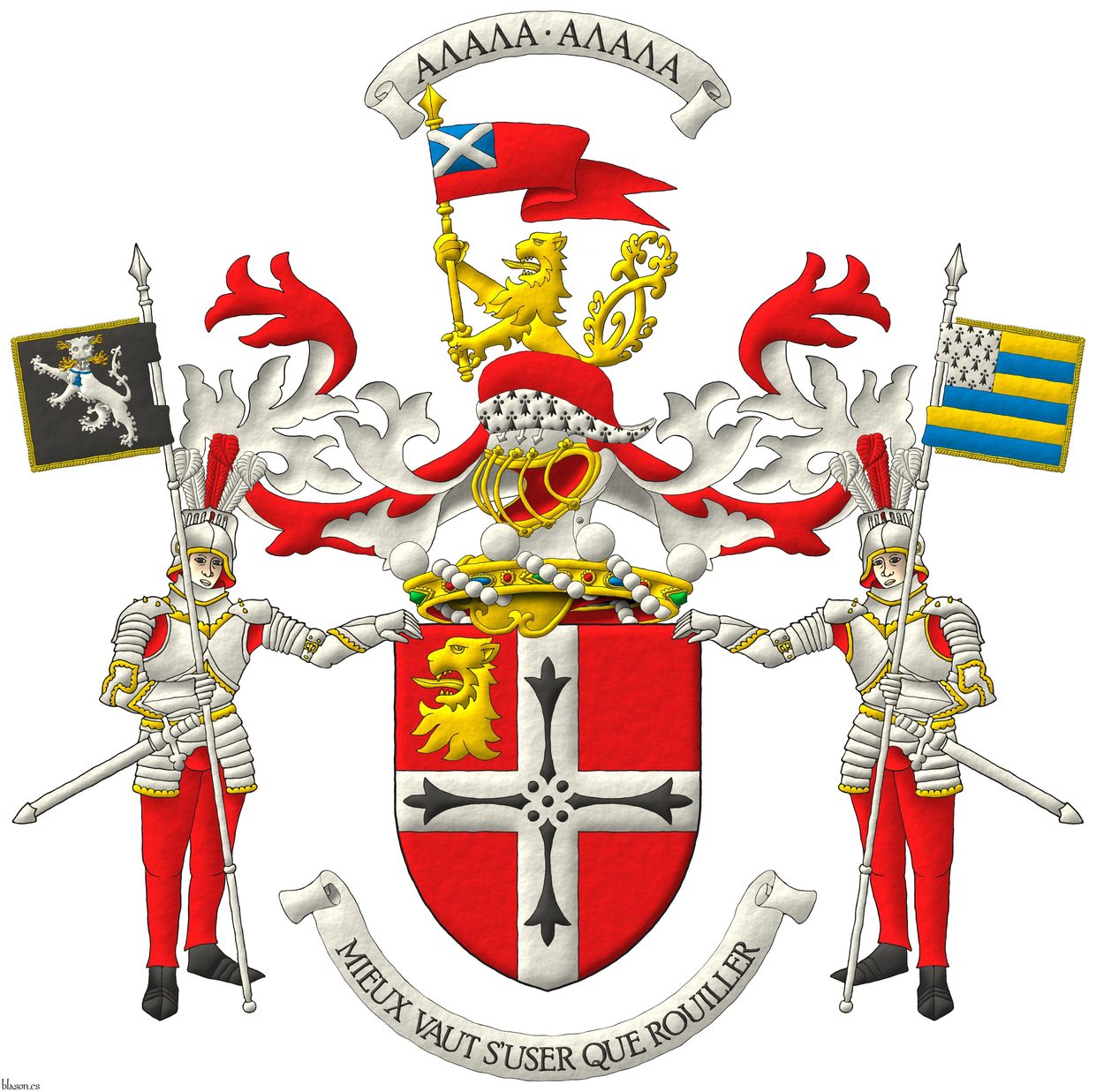
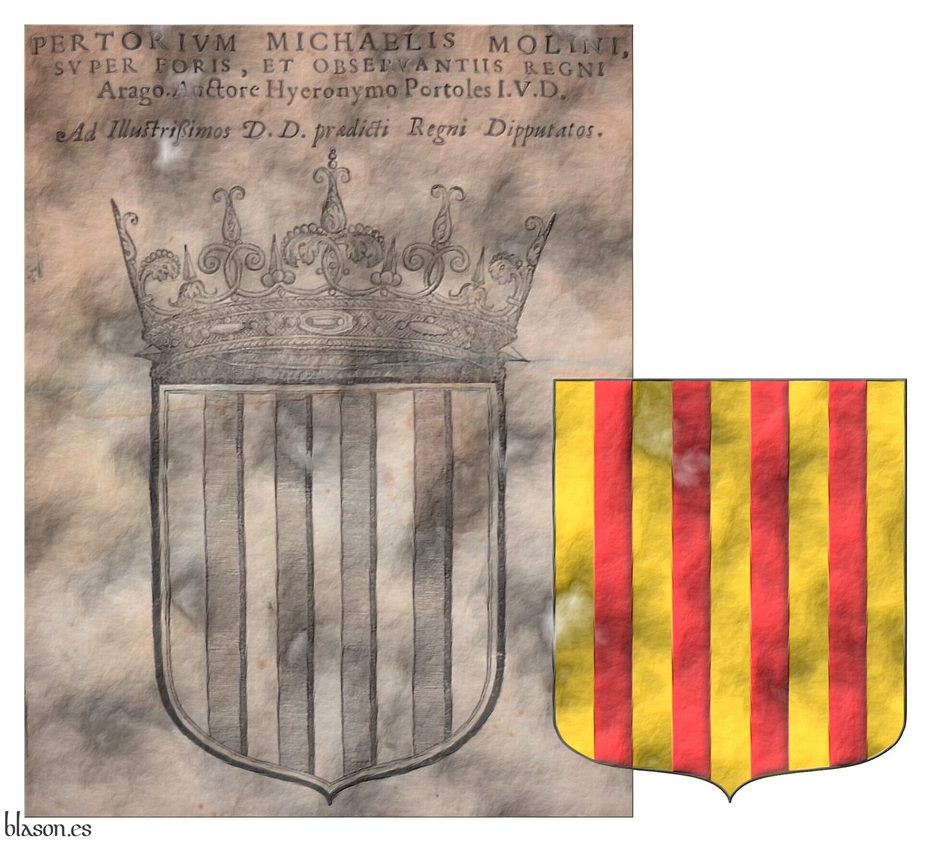

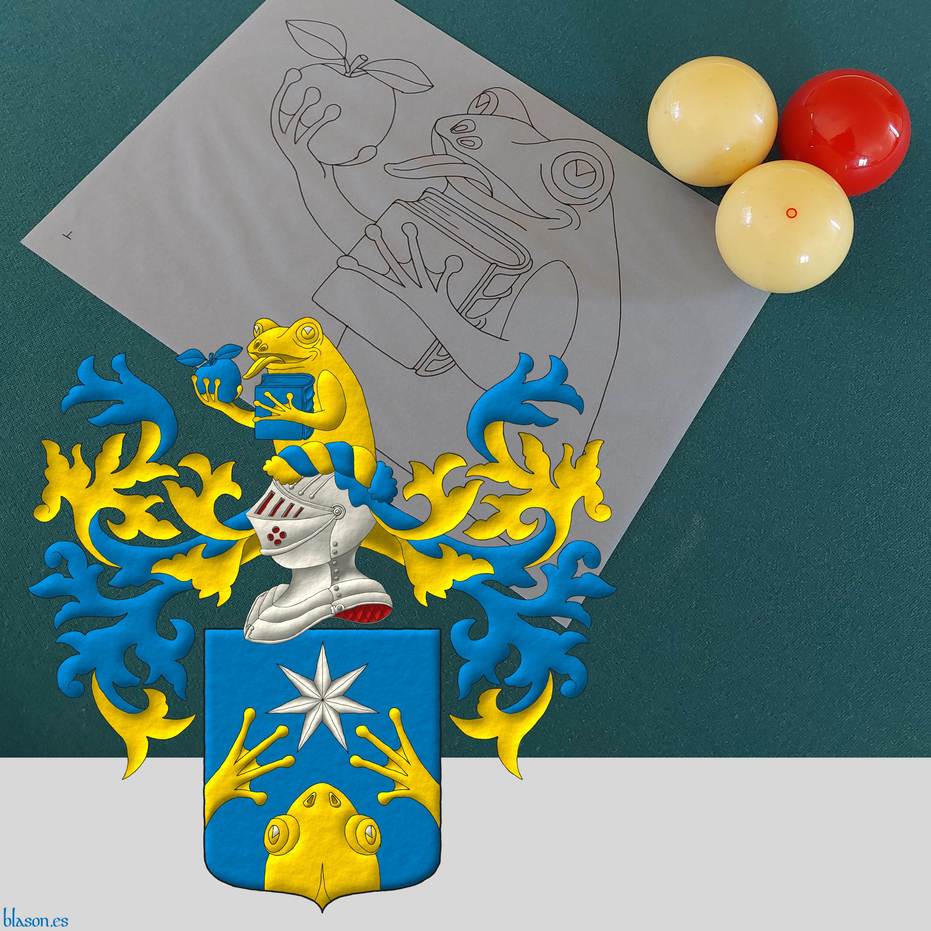
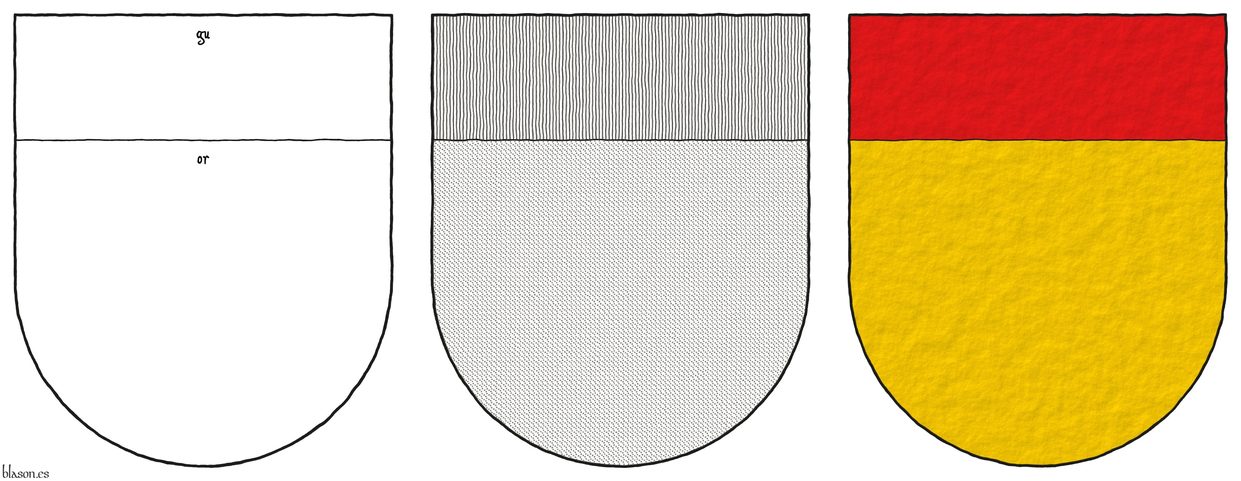
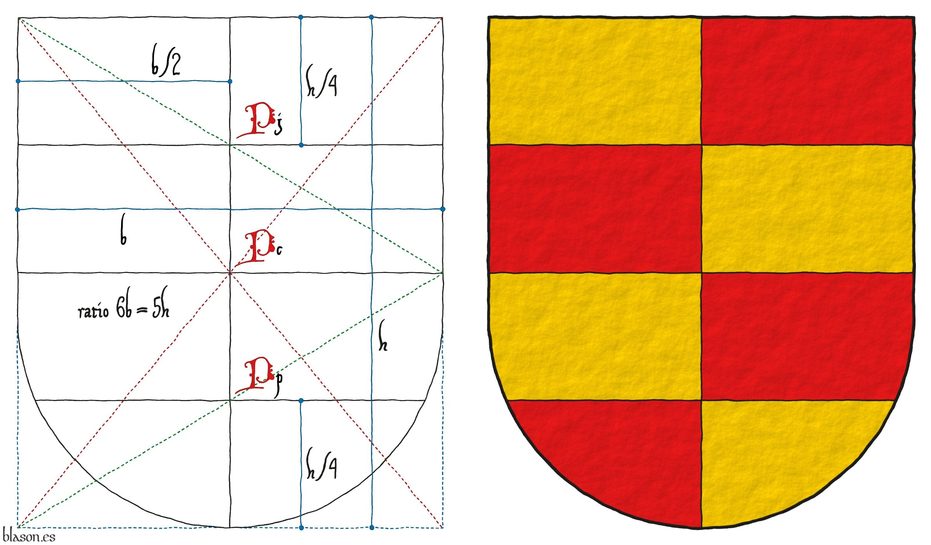

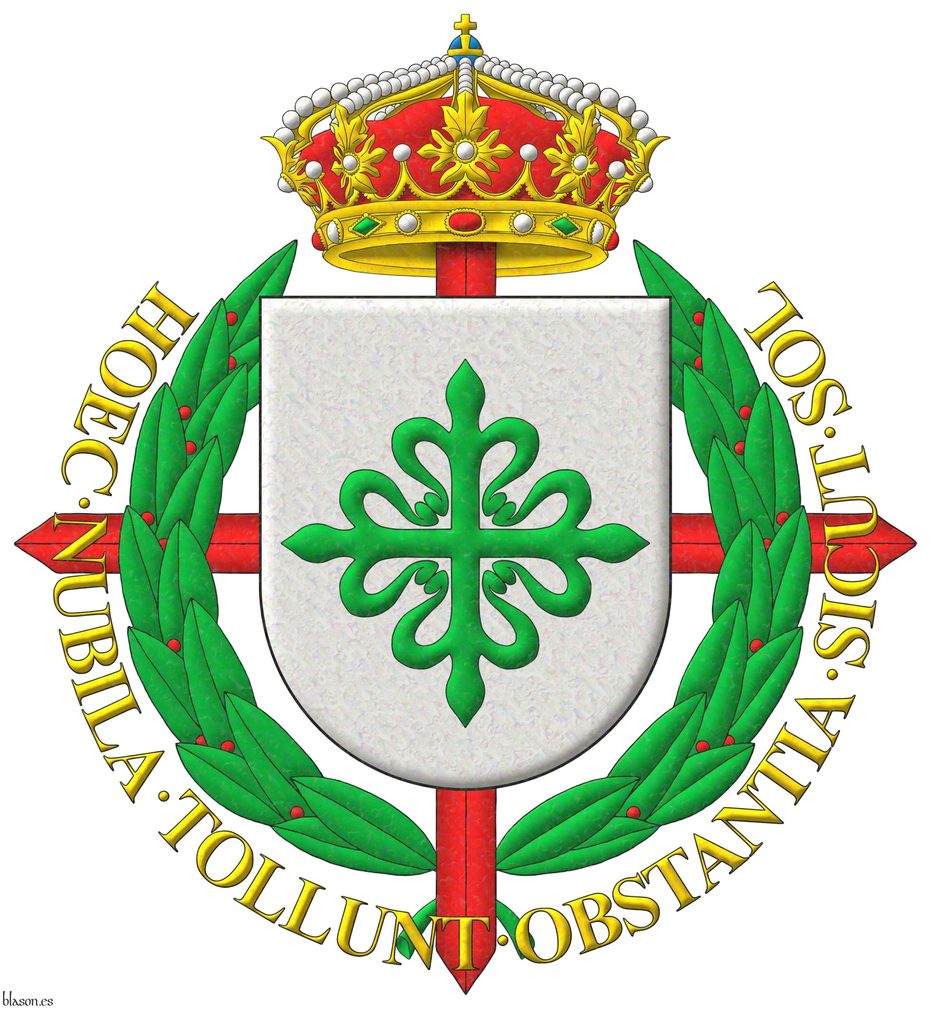
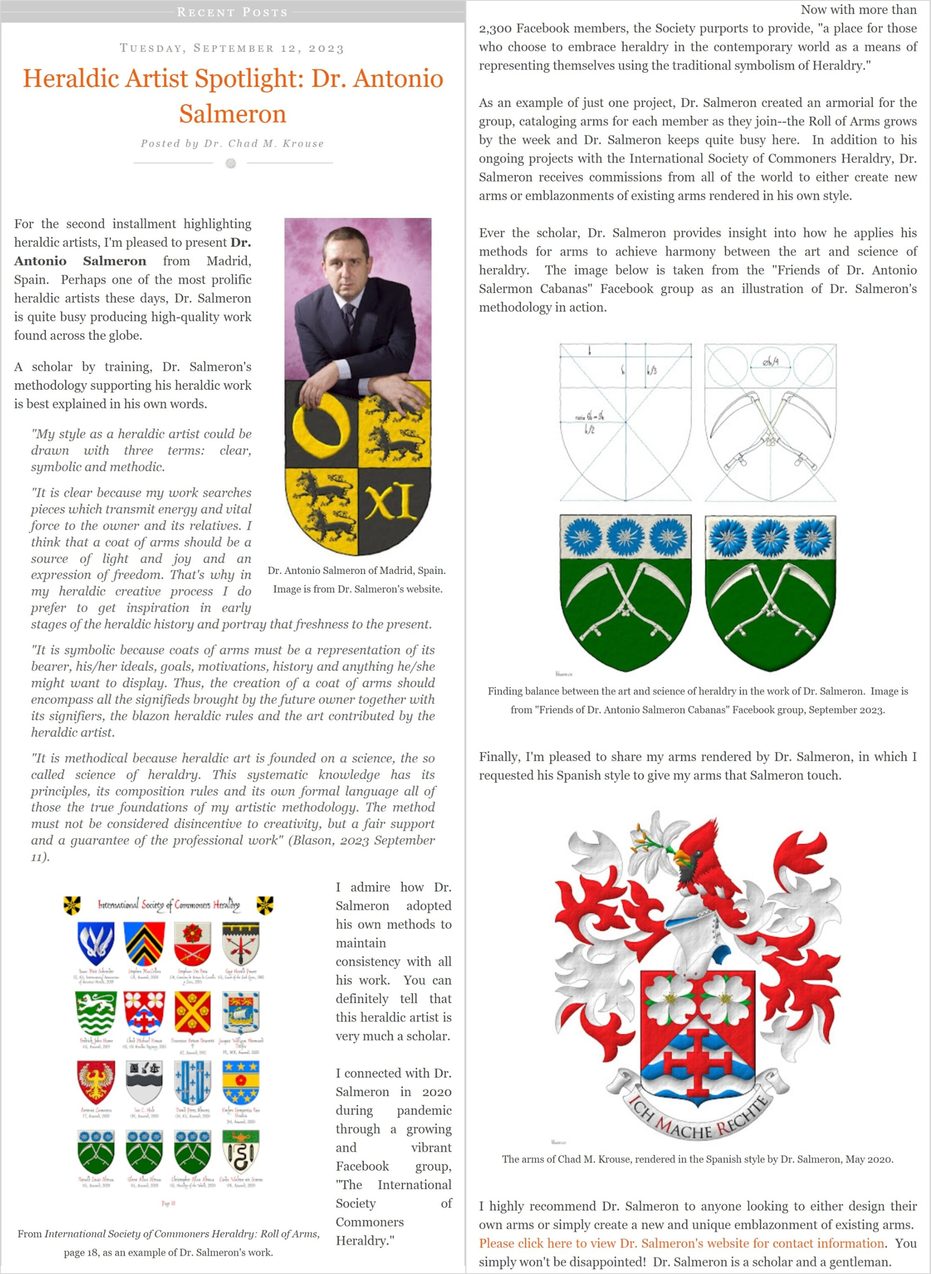

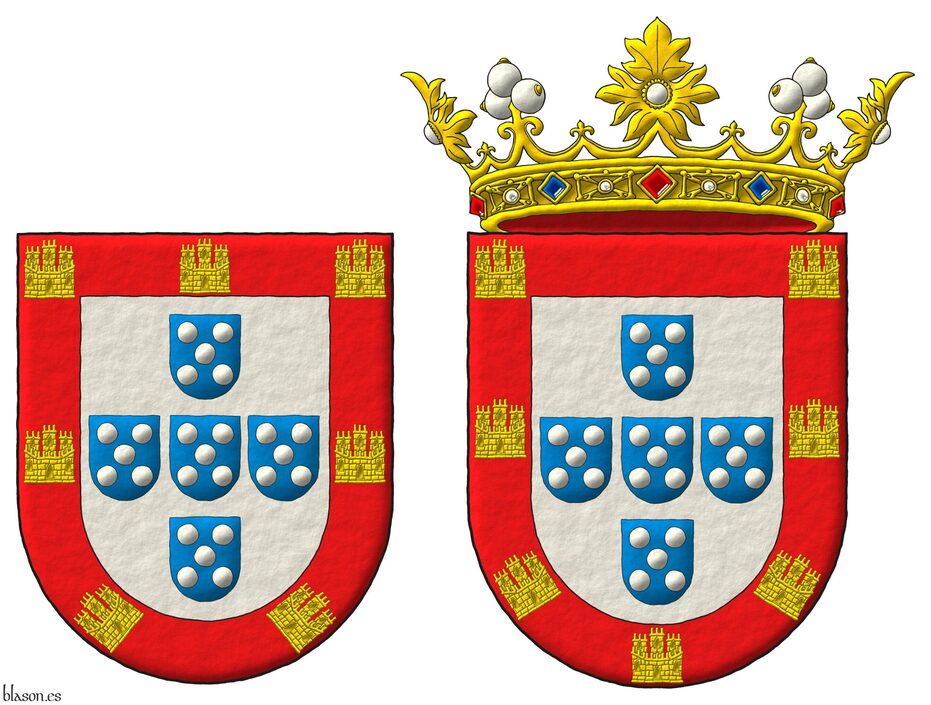
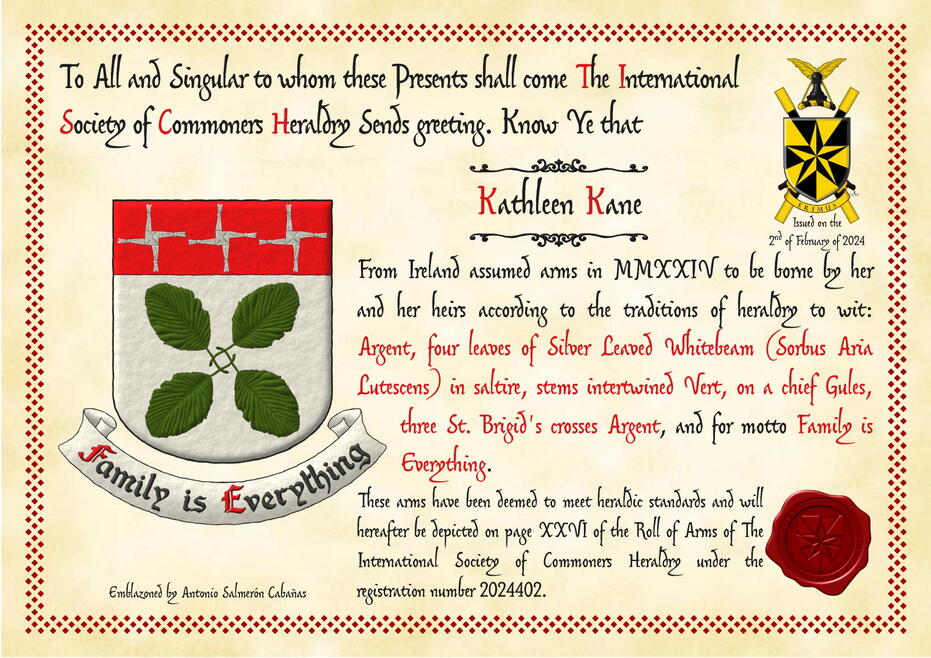
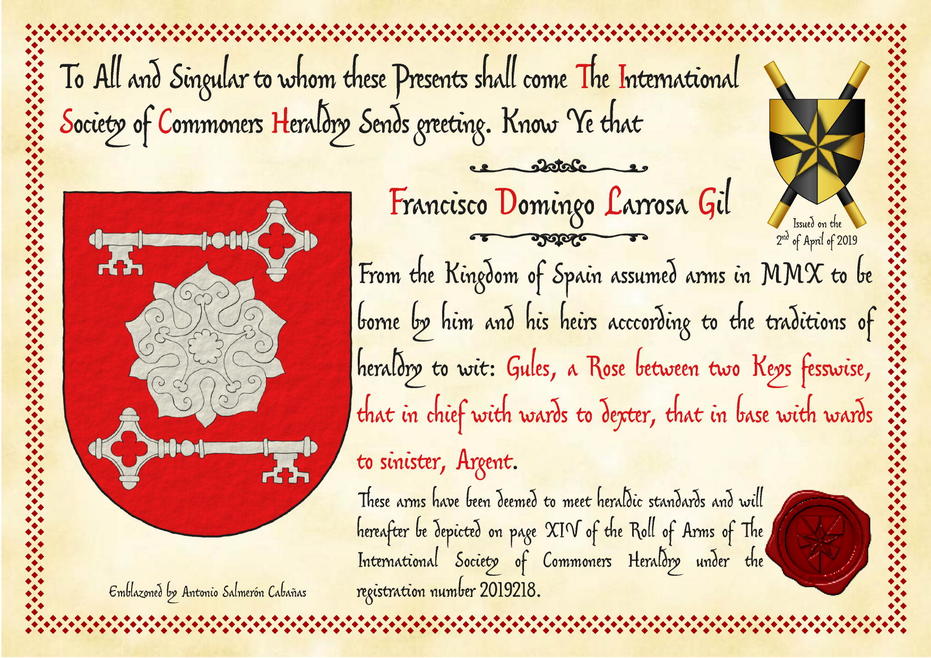
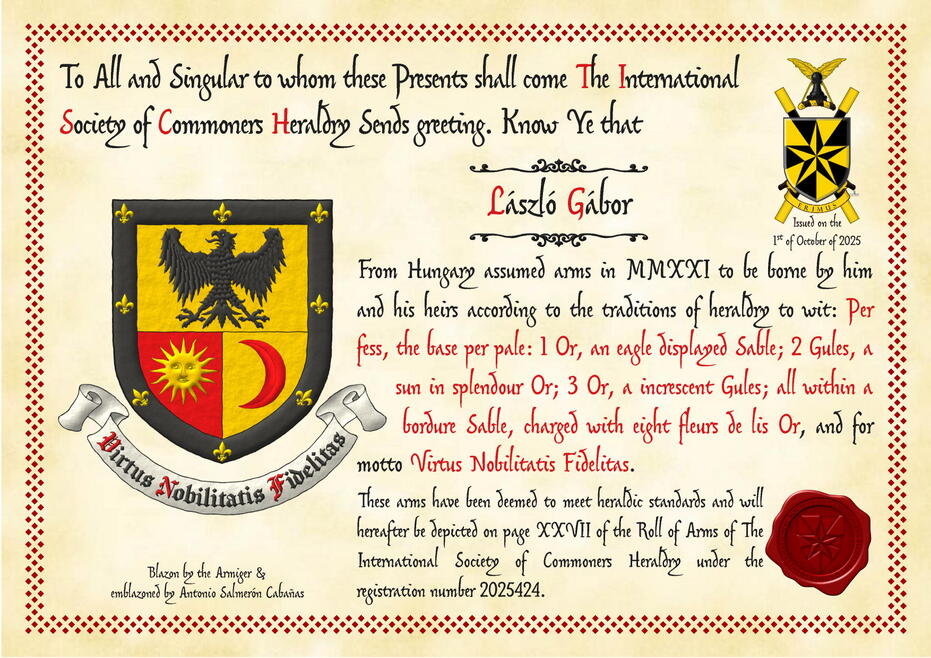



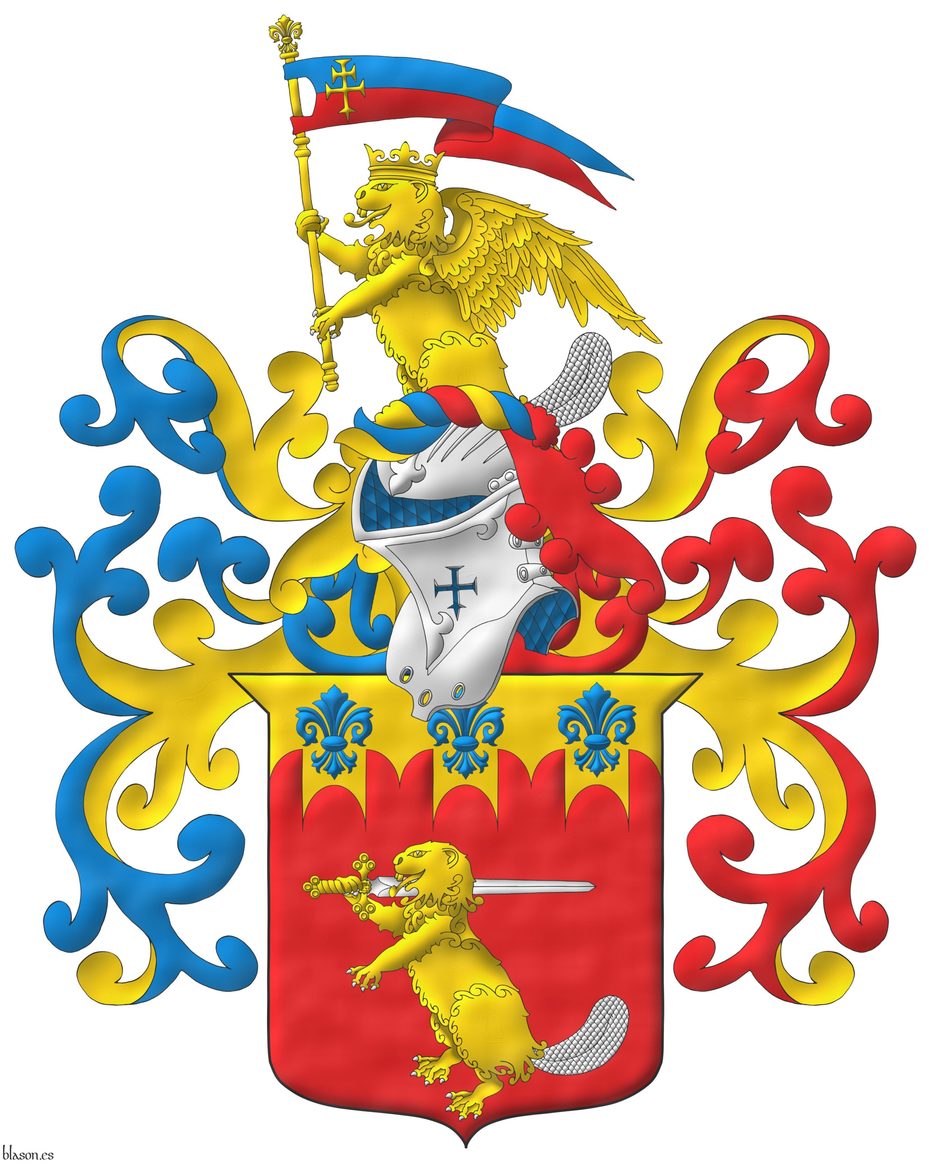
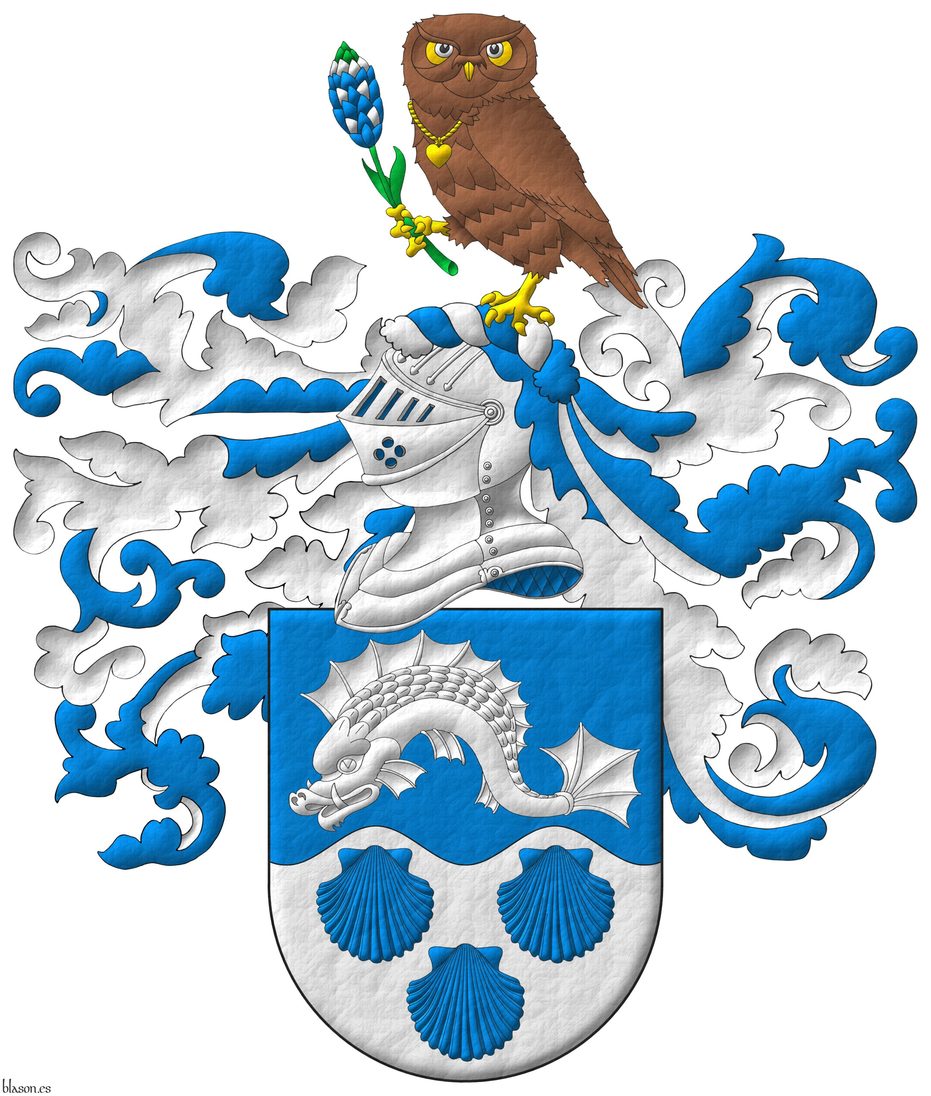

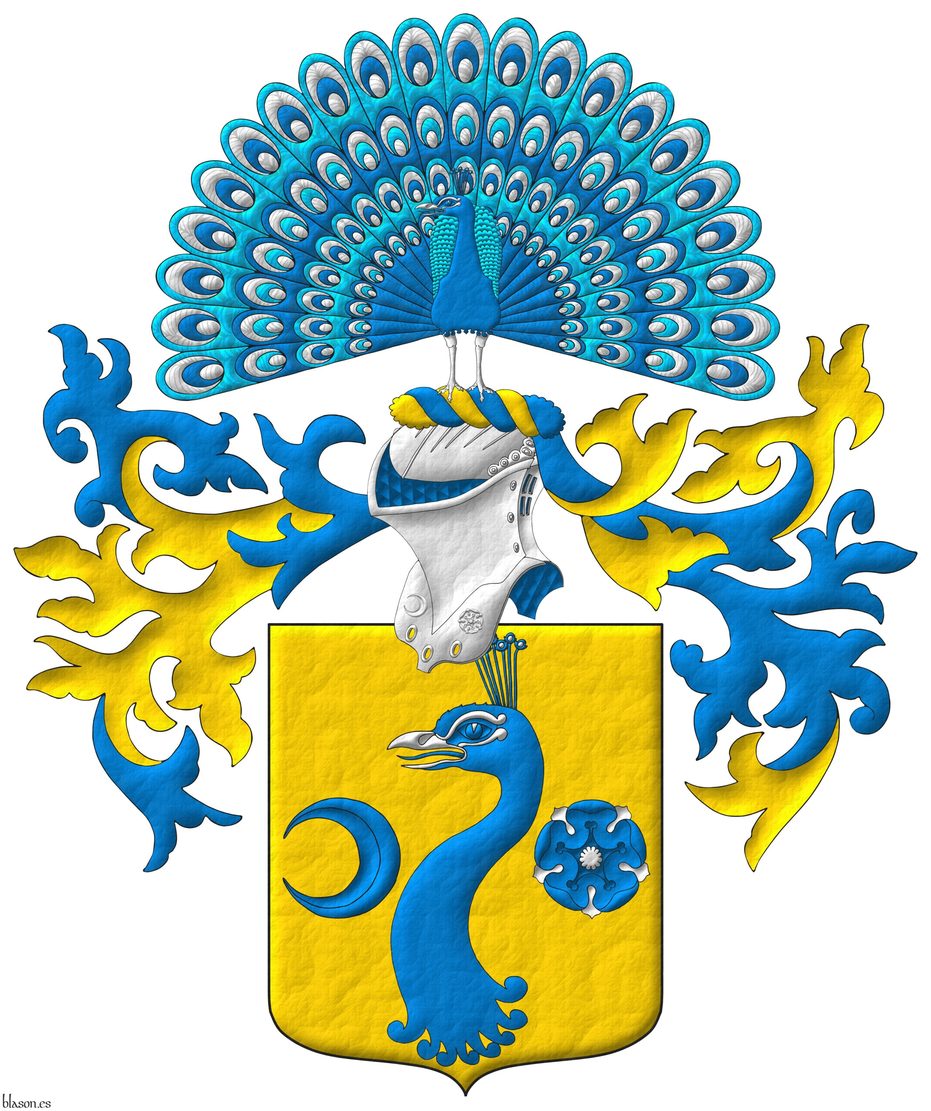
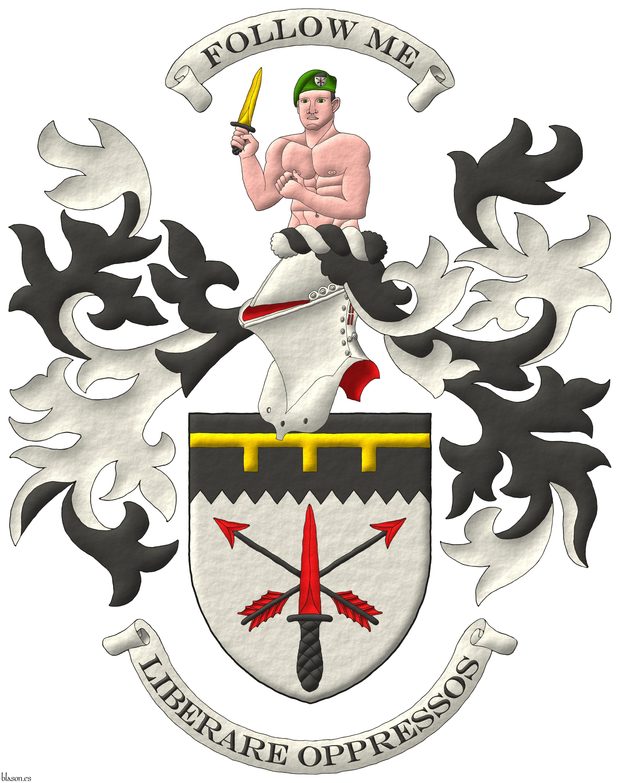
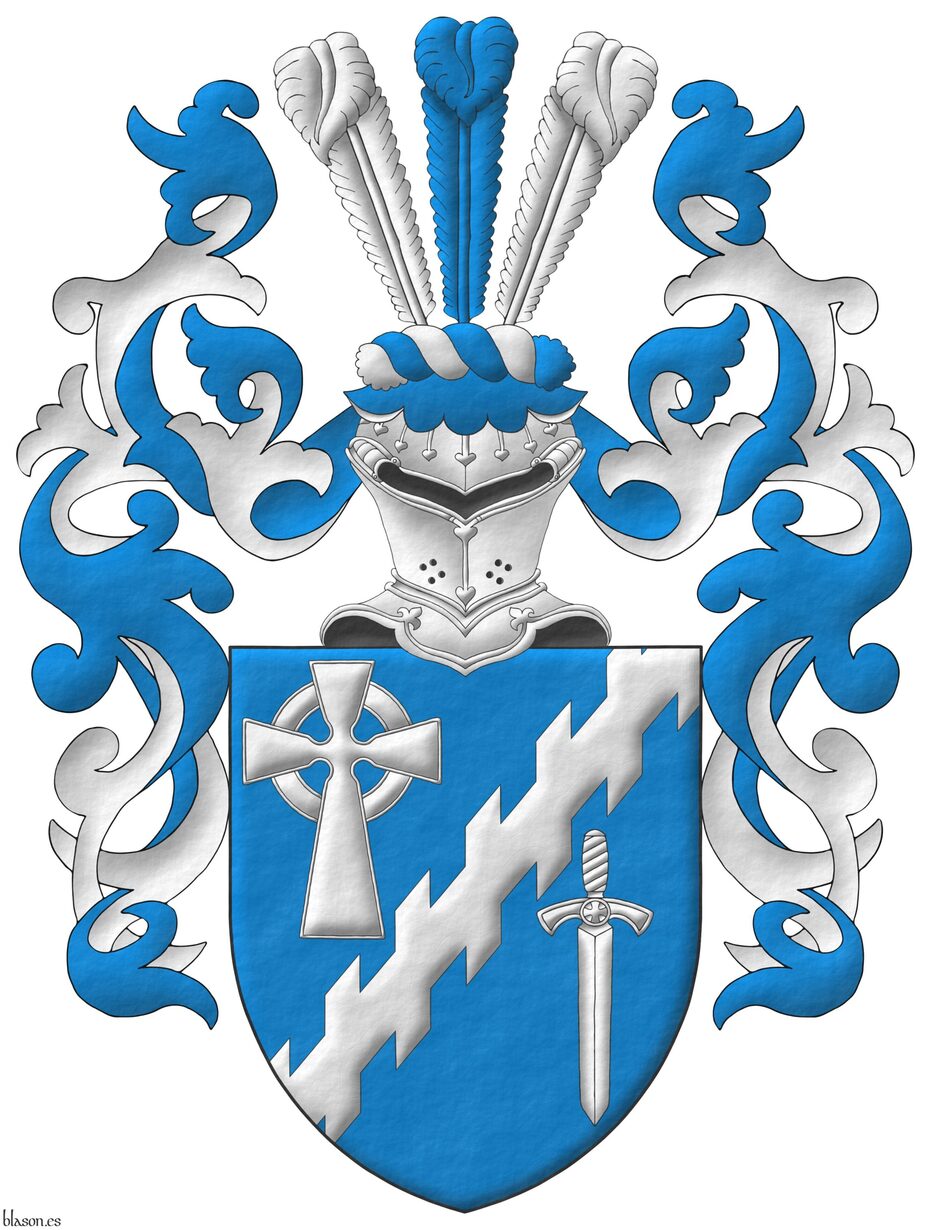
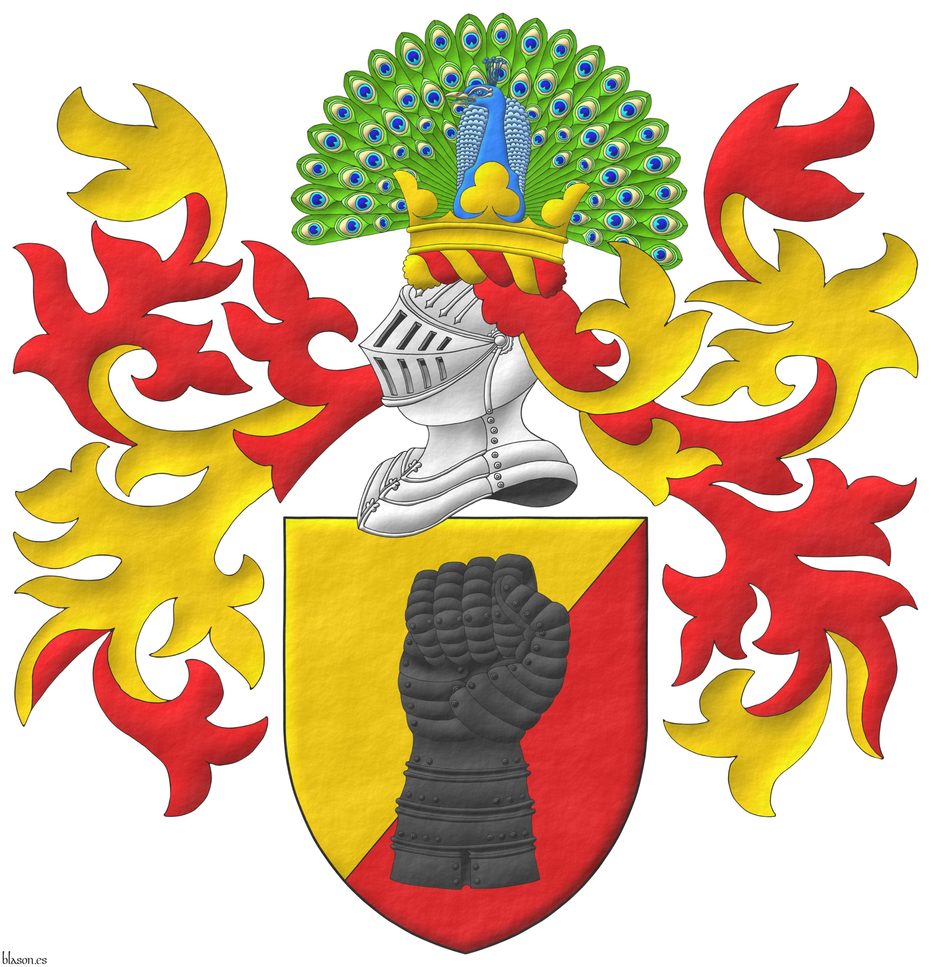


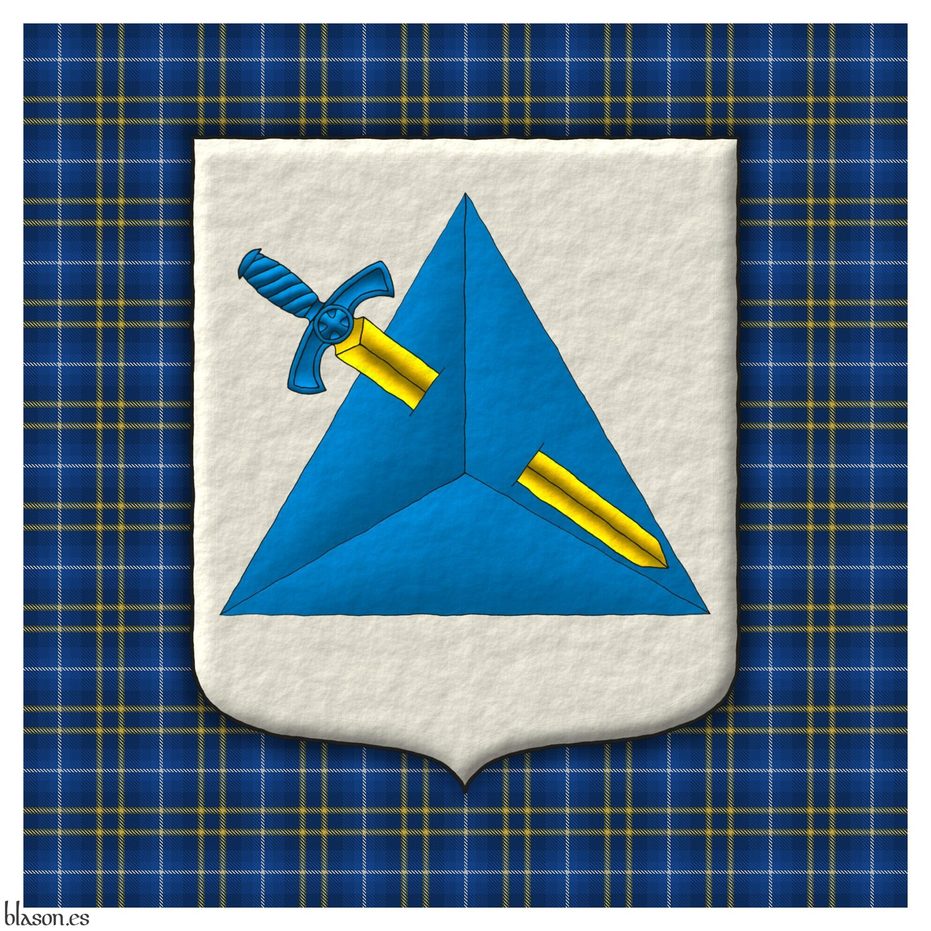

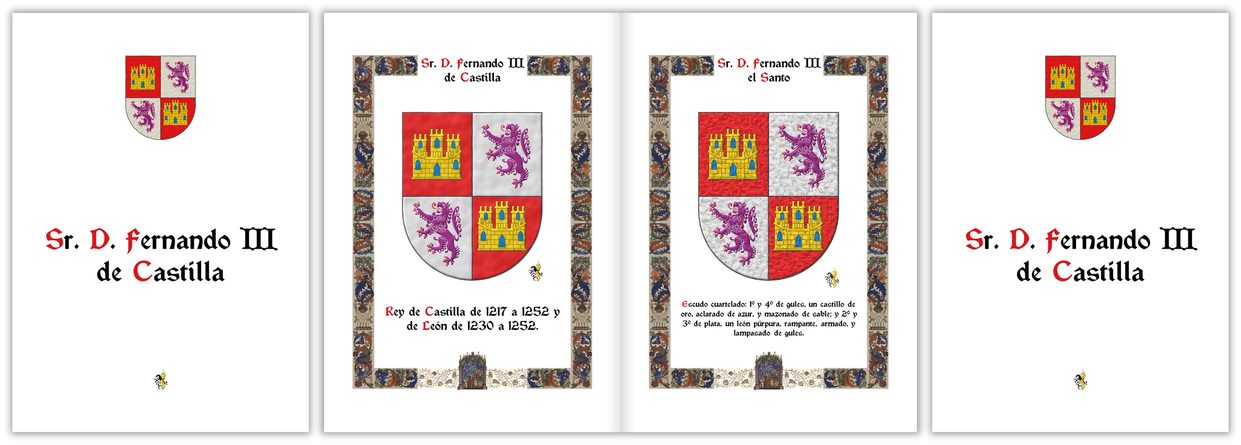
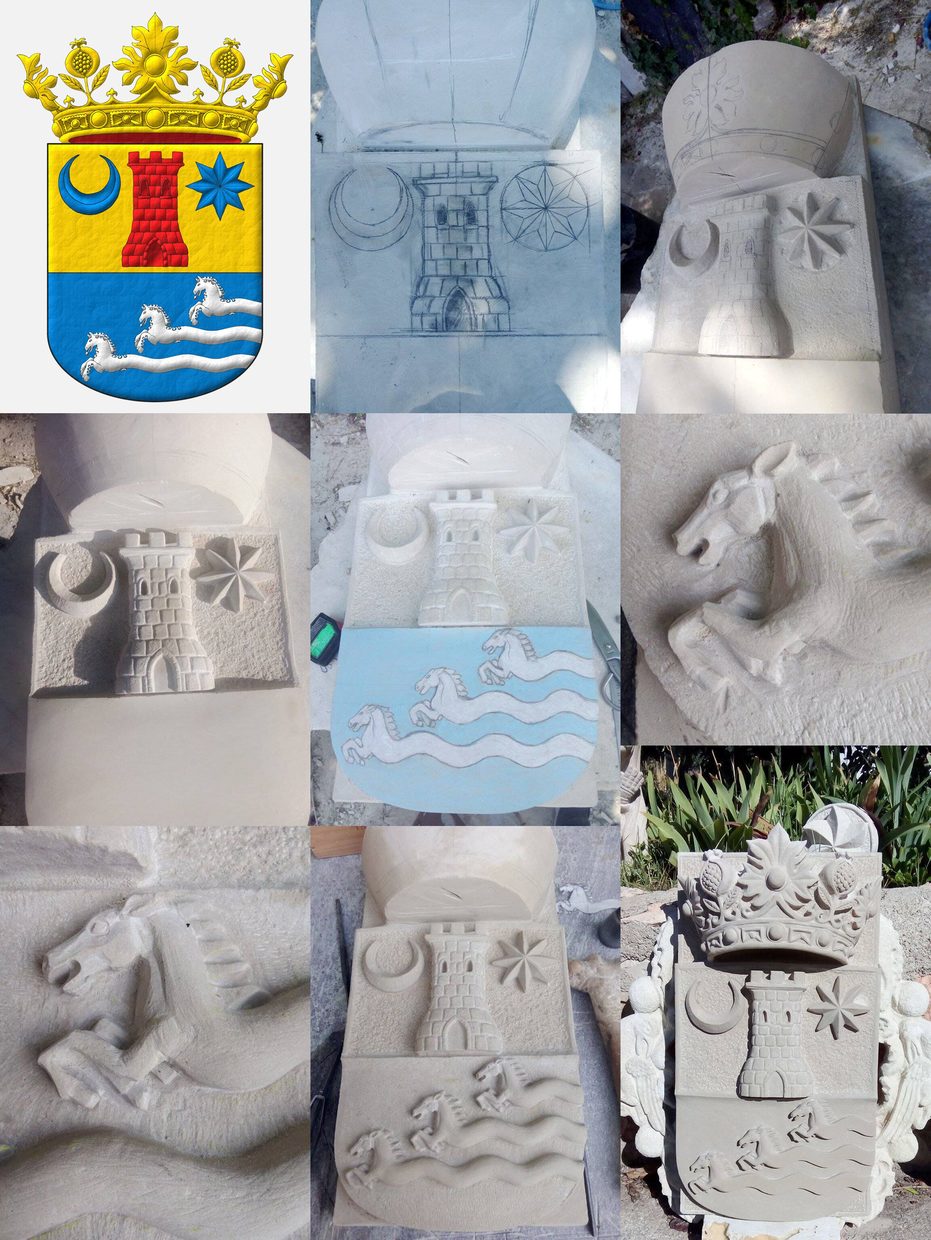
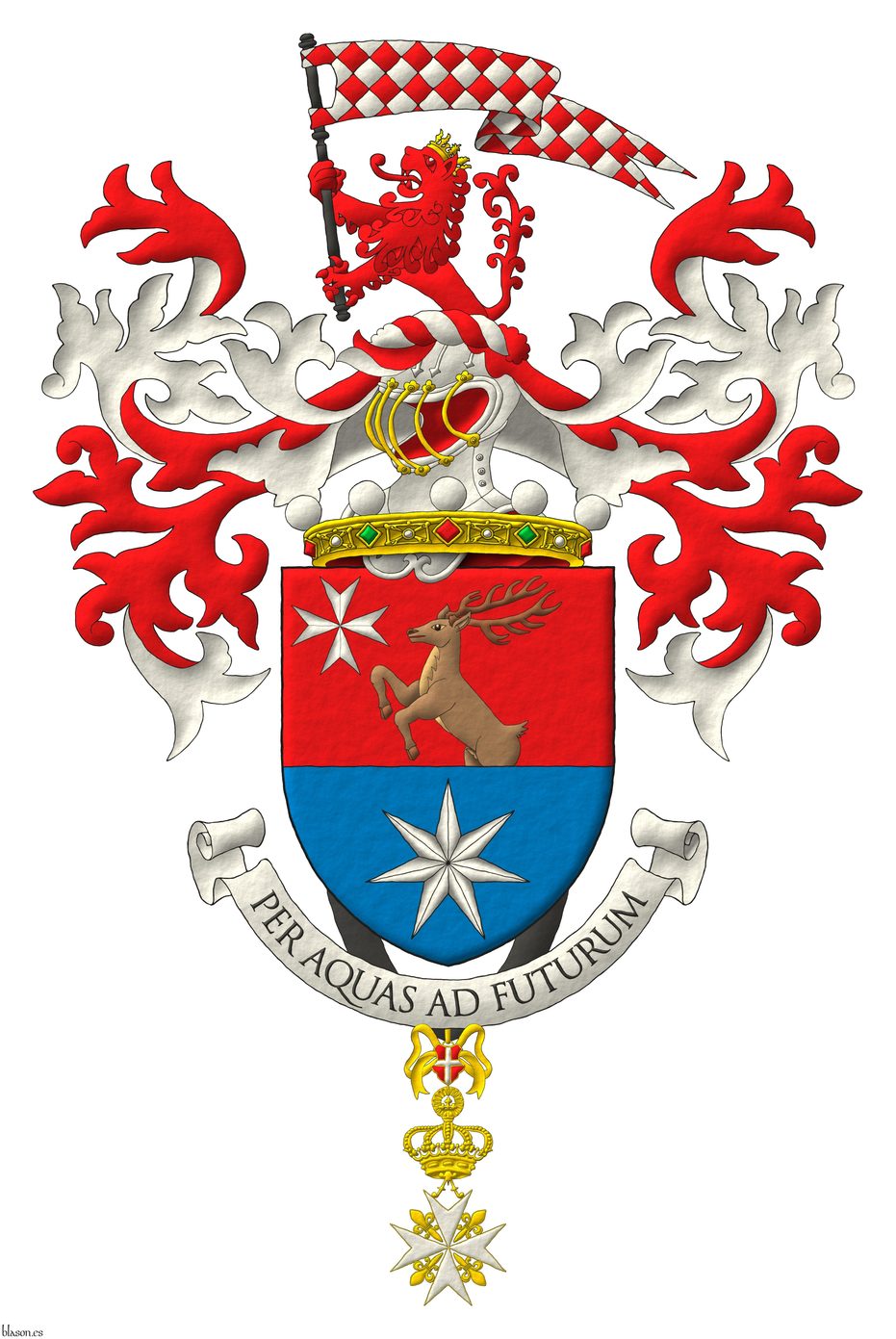
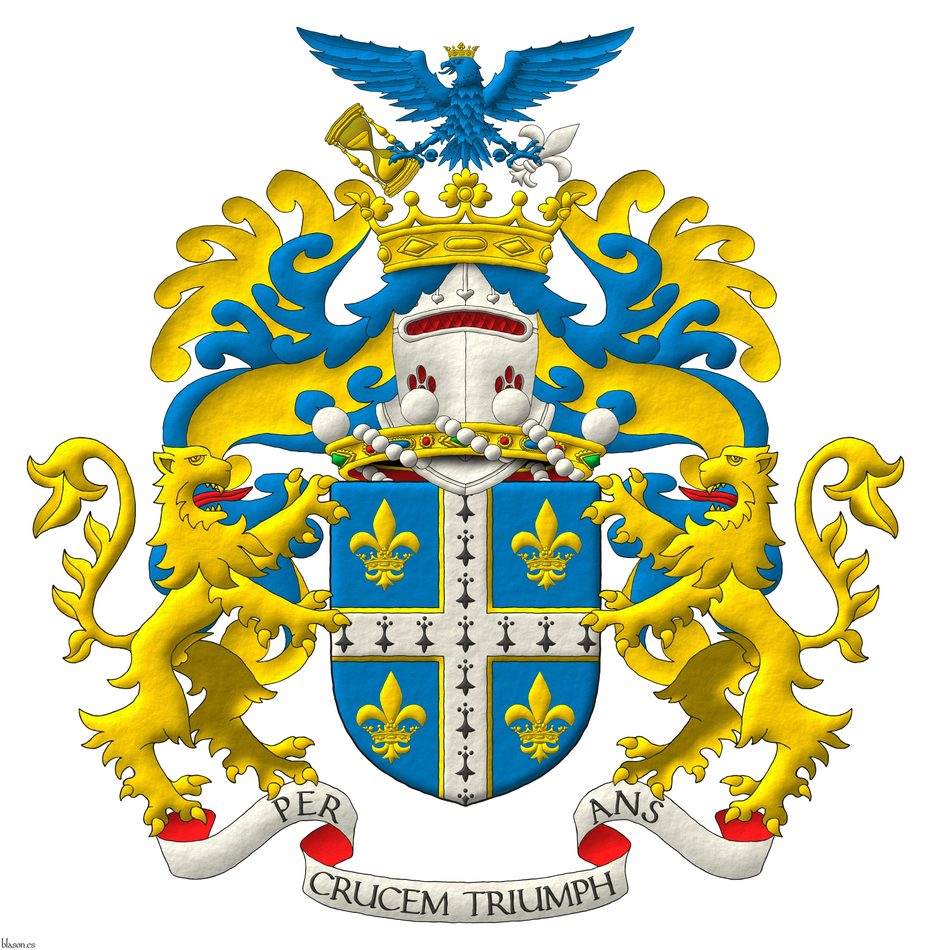

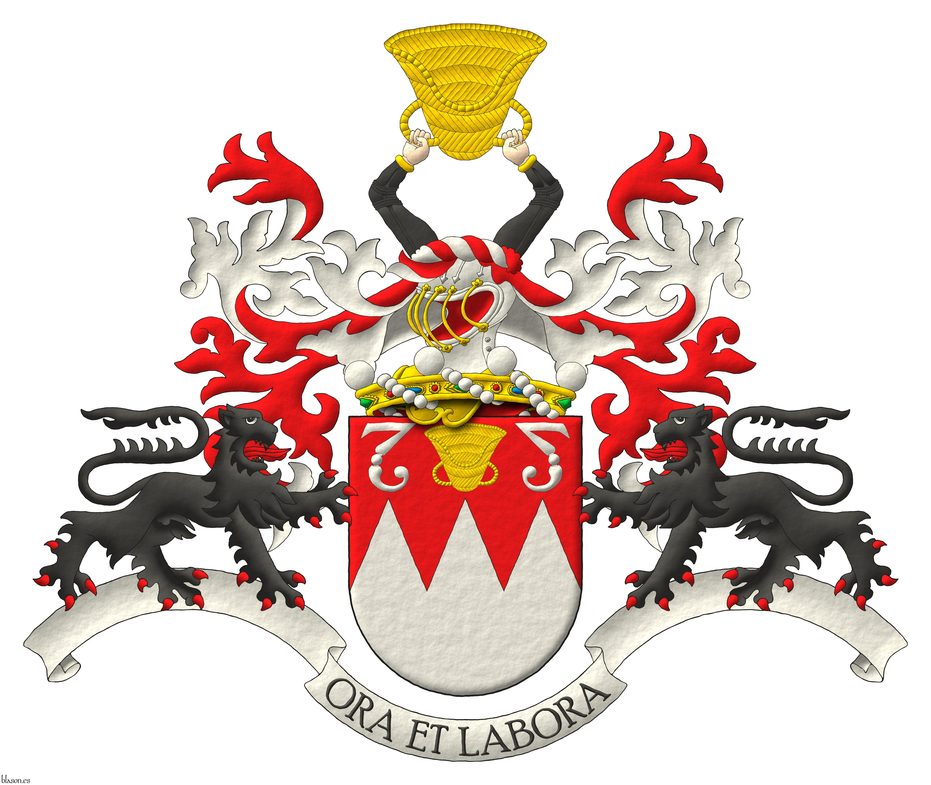
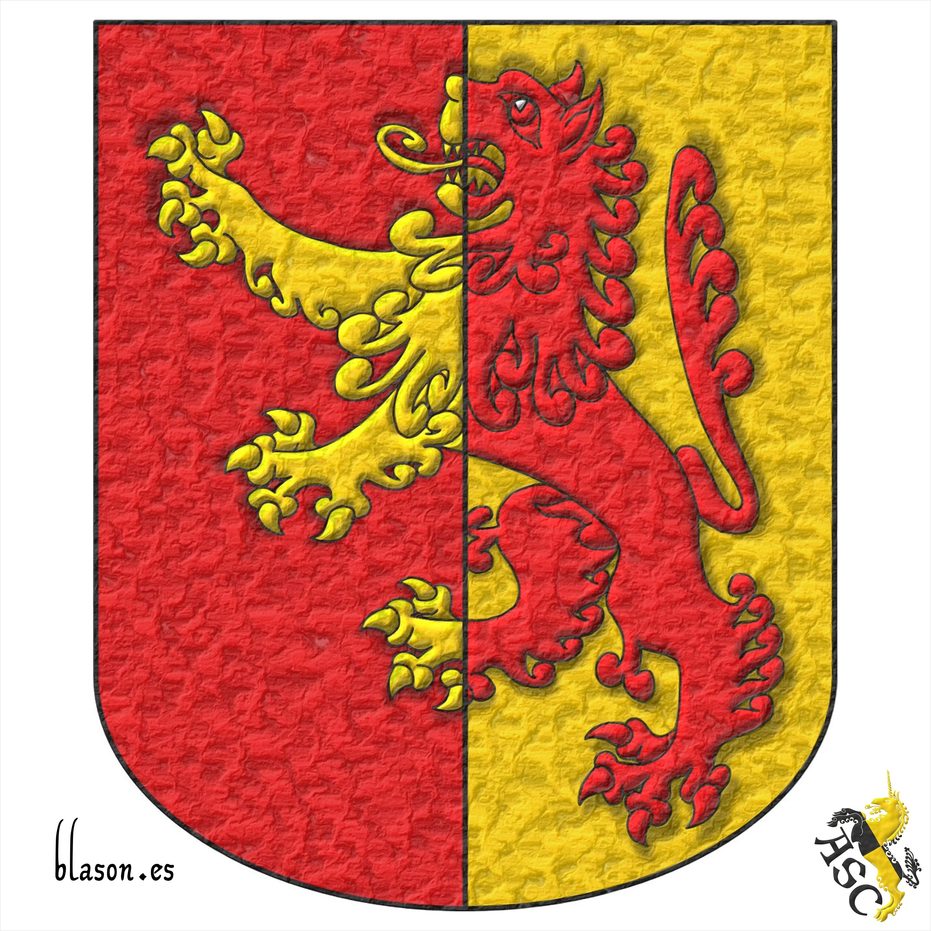
![Heidi Garcia-Bosch-de Morales-de Sola née Adriaensen Party per pale: 1 Gules, a bend sinister debruised by an inescutcheon Or charged with a bend Azure charged with five fusils palewise Argent, in base on a triangle Argent the Sacred Heart of Jesus proper [for Adriaensen]; 2 Azure, a fleur de lis Argent above a doe sejeant proper surrounded by twelve mullets in orle Or [granted by Bourbon-Parma]. Crest: A crown of Noble. Motto: «Biche délicate».](../escudo_armas/G0084.22.FullAchievement.FreeHand.jpg)
![Her Excellency Myriam Spiteri Debono, Xirka Gieh ir-Repubblika Tierced per pale: 1 Or, upon a fess Azure a lion passant Gules holding a sword point upwards Argent [for Spiteri]; 2 Azure, upon a base Vert a tree eradicated proper, supported at sinister by a man proper wearing a loincloth Argent and holding in his sinister a spear point upwards Or and in chief three mullets of six points in fess Or [for Debono], 3 Gules, two hands clasped throughout proper, vested Argent, holding a dagger point upwards Argent, hilted Or, in chief three mullets of six points in fess Or and in base a sprig of olive fesswise proper [for Zammit]. The shield is surrounded by the Xirka Gieh ir-Repubblika, as Head of Orden.](../escudo_armas/G0134.23.Xirka.Leather.jpg)
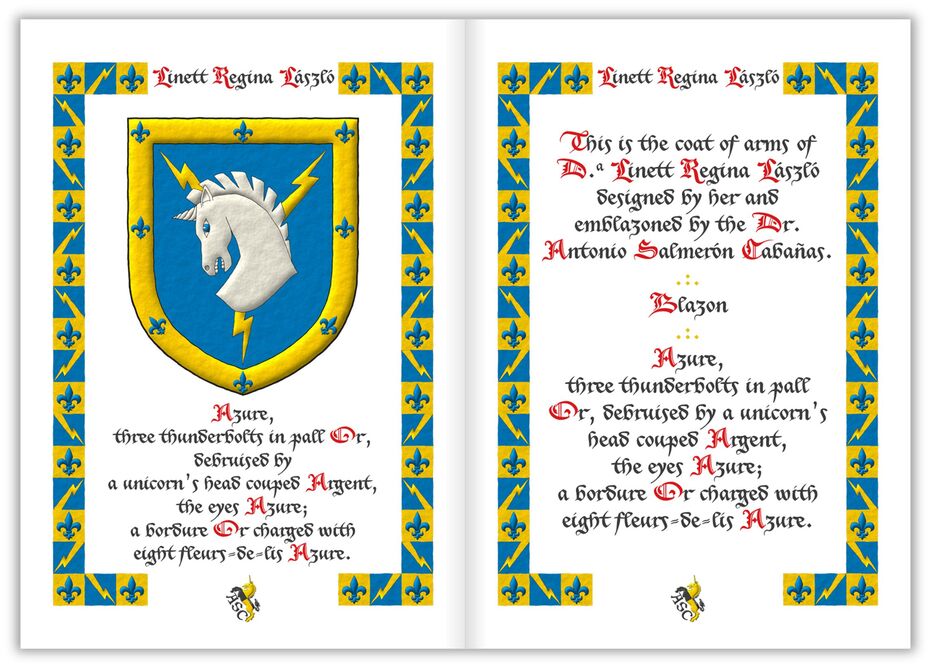

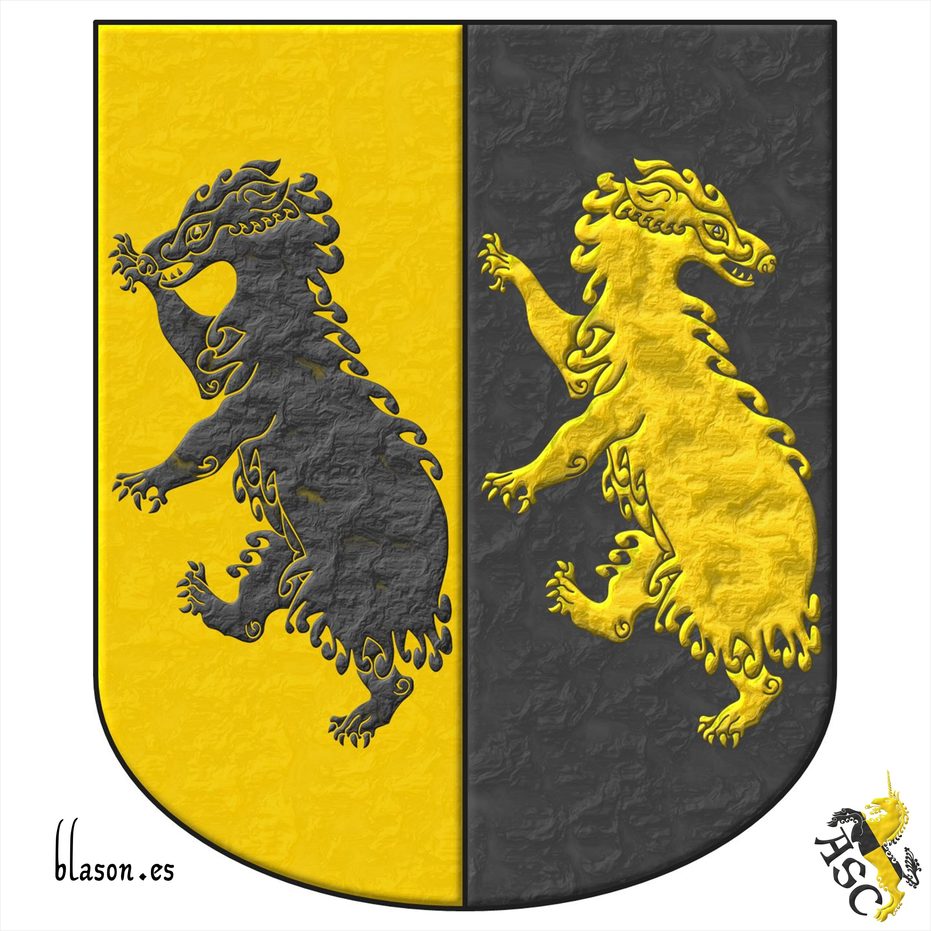
![Ignasi Pujol, comparation [ Azure, a mount issuant from the base, in chief a fleur the lis Argent ] and [ Party per chevron Azure and Or, in chief a fleur de lis Argent, in base four pallets Gules ].](../escudo_armas/PujolIgnasi.20.PujolLineage.Ogee.Compare.jpg)
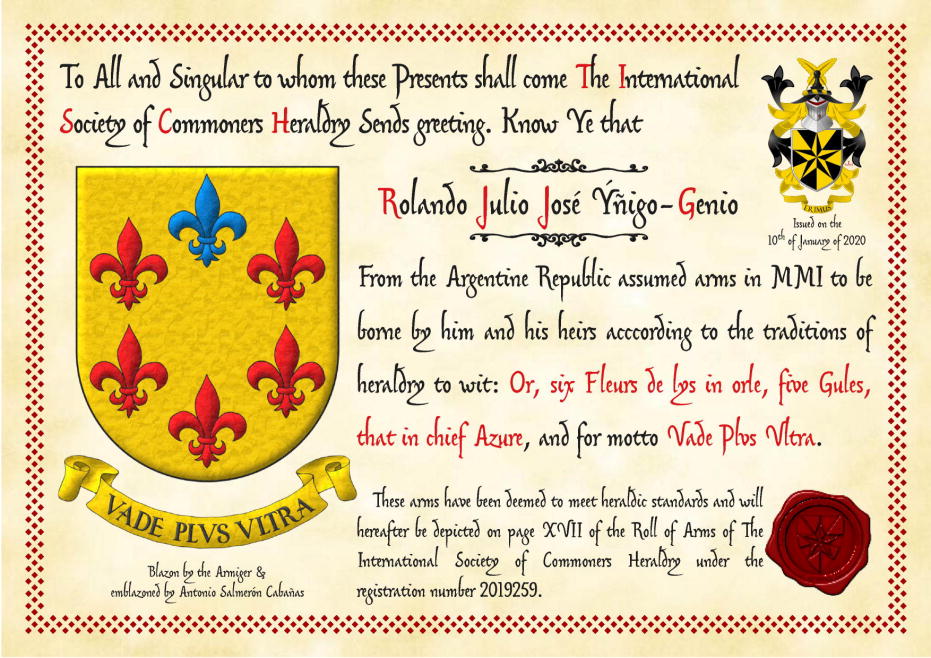

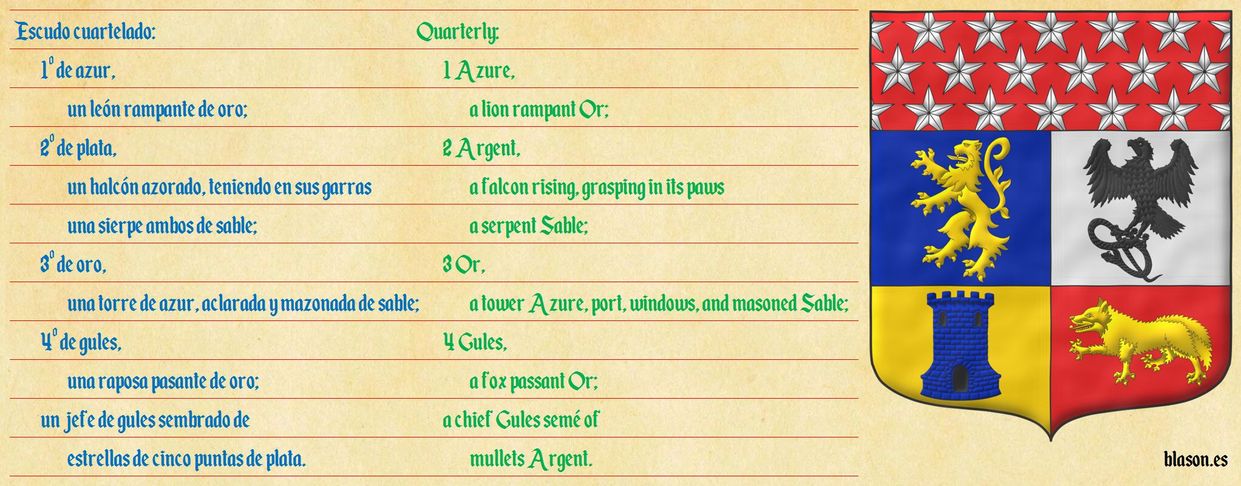

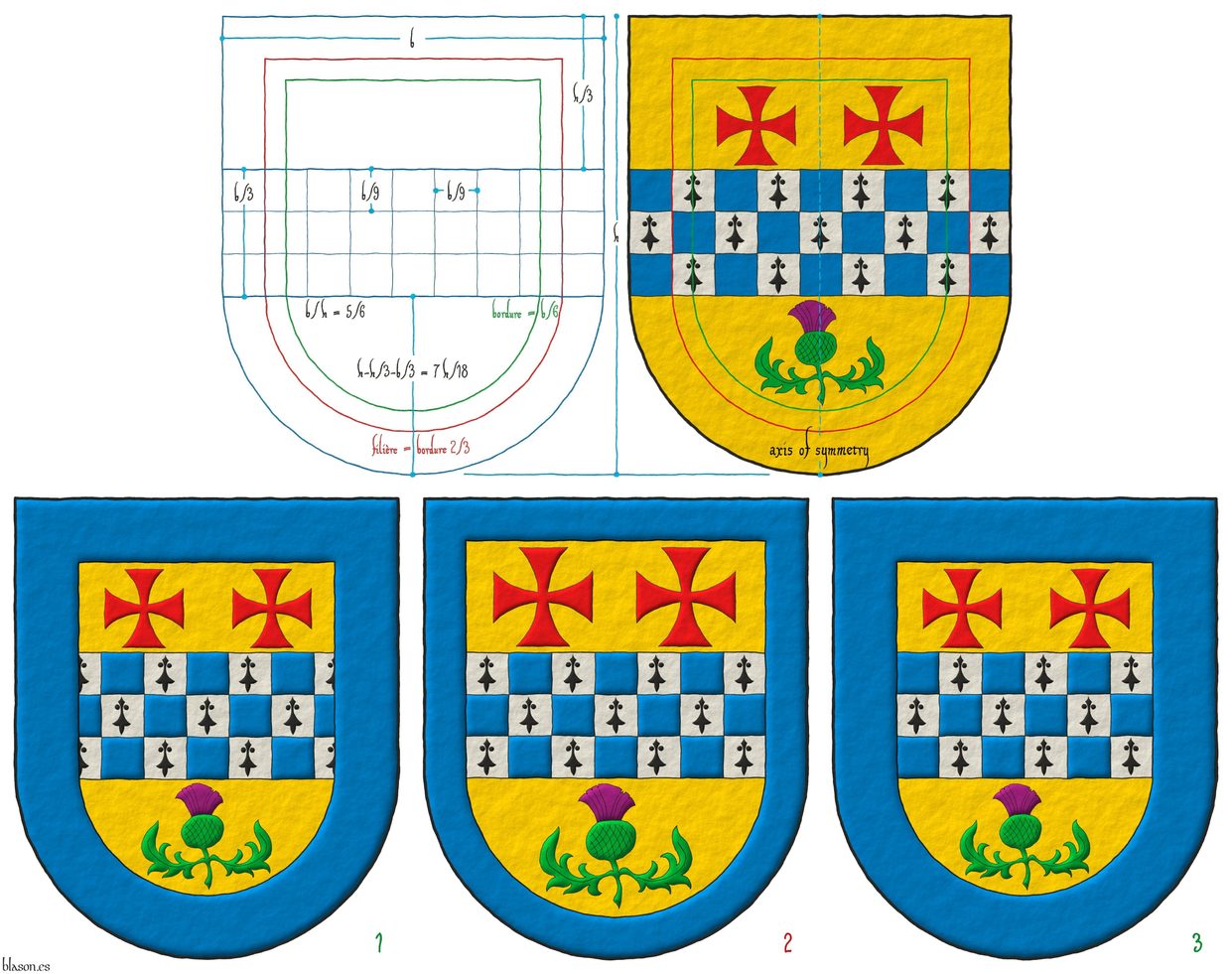
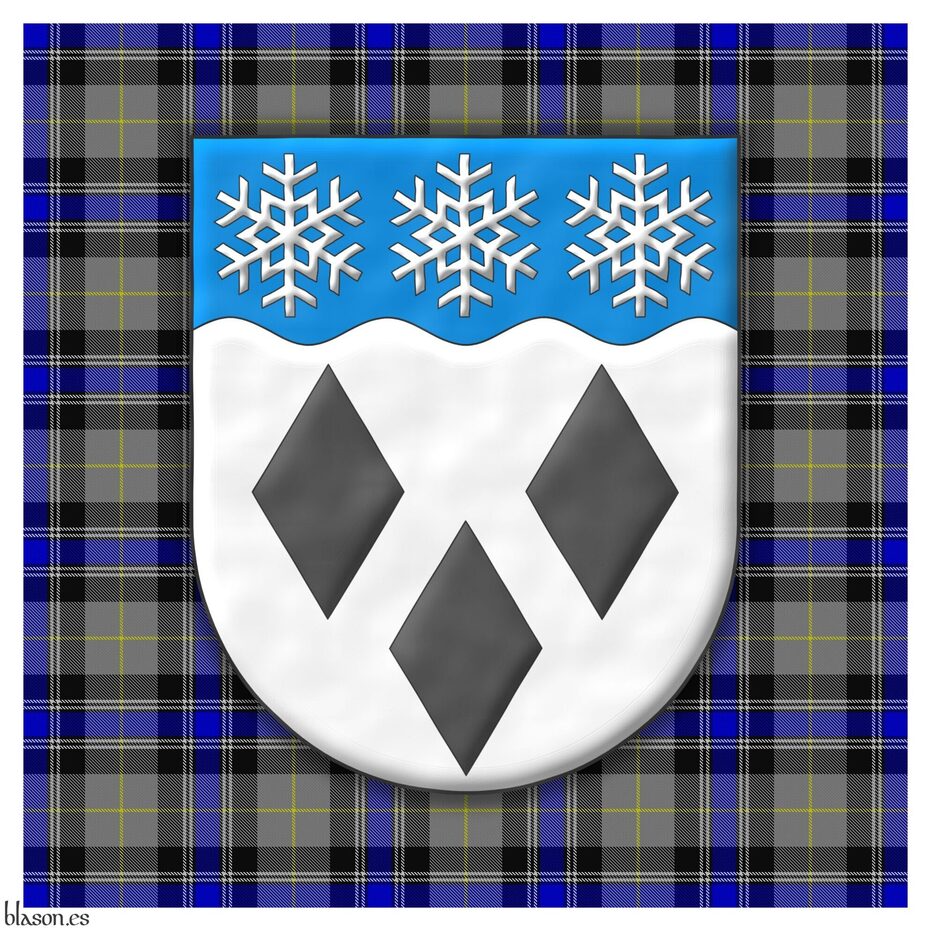
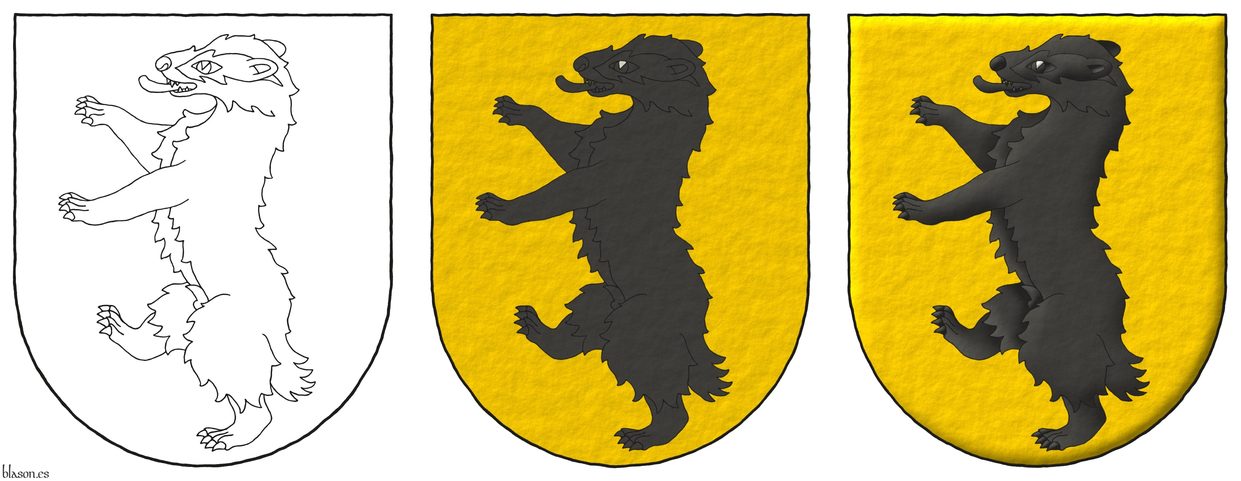
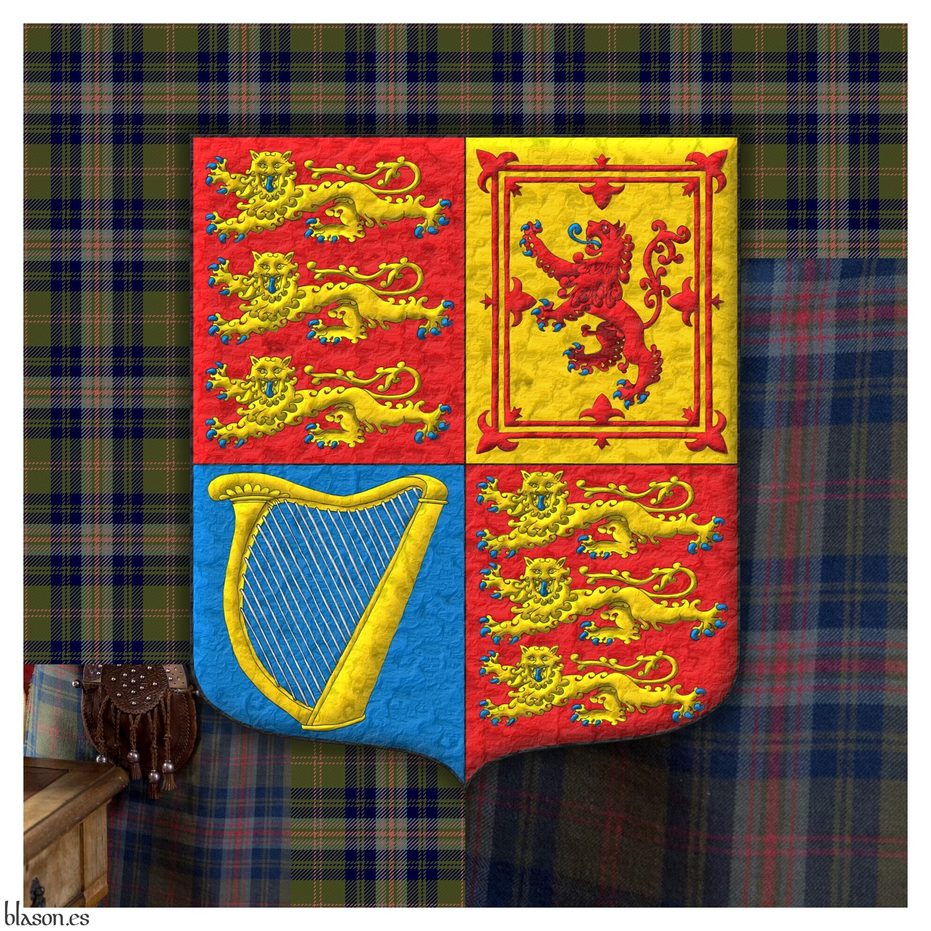


![Leonor de Aquitania y Enrique de Inglaterra [ Gules, a lion rampant Or, ] accolé with [ Gules, a lion passant, guardant Or ].](../escudo_armas/LeonorA.22.EnriqueII.jpg)
![Leonor Plantagenet and Alfonso VIII [ Gules, a castle triple towered Or, port and windows Azure, masoned Sable ] accolé with [ Gules, three lions, passant, guardant, in pale Or, armed and langued Azure ].](../escudo_armas/LeonorP.23.Matrimonio.jpg)
![Lineage Mark of Germany, collage [ Or, a fess chequey Gules and Argent ] · [ Or, a fess chequey Azure and Argent ] · [ Gules, a fess chequey Azure and Argent ] · [ Gules, a fess chequey Azure and Argent ] · [ Azure, a fess chequey Gules and Argent ].](../escudo_armas/MarkAlemania.19.Collage.English.Irisado.Avr20.jpg)

